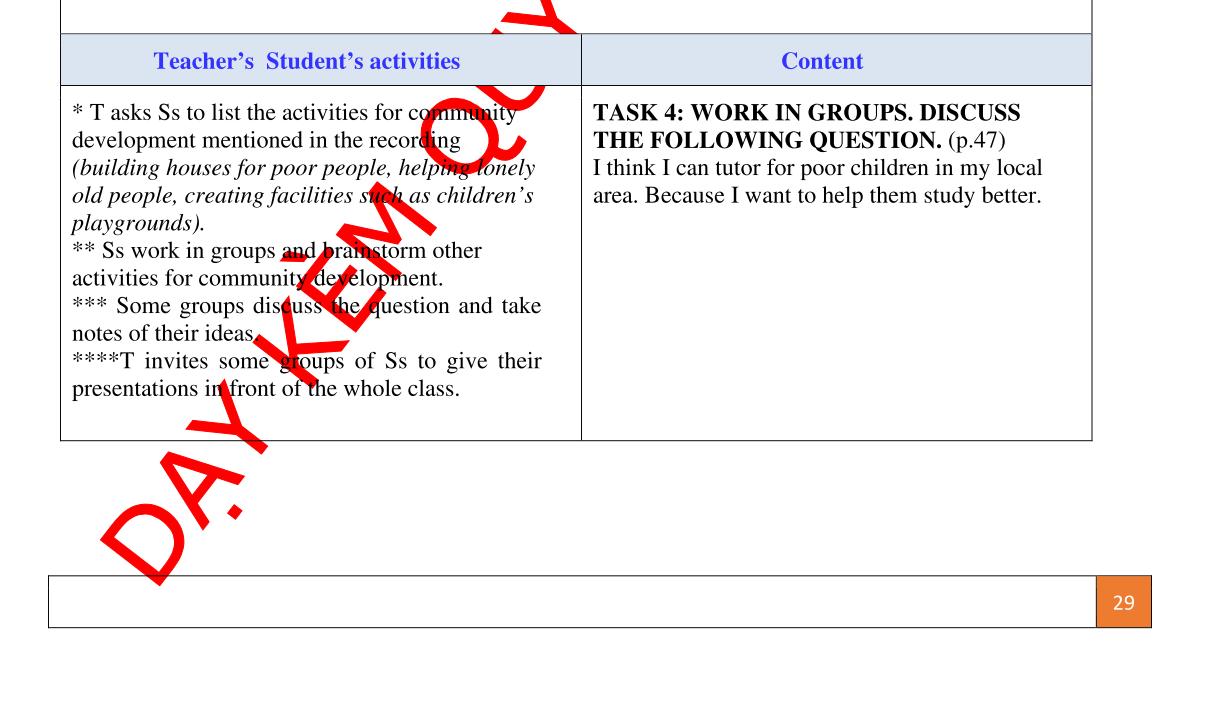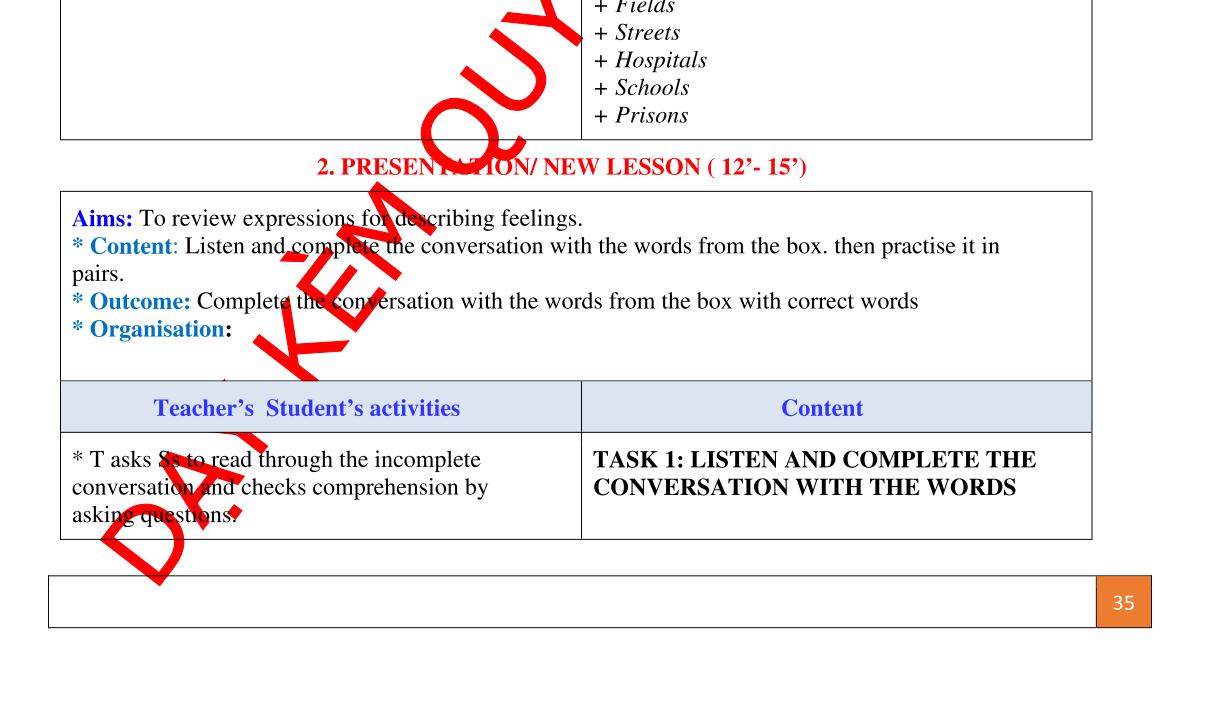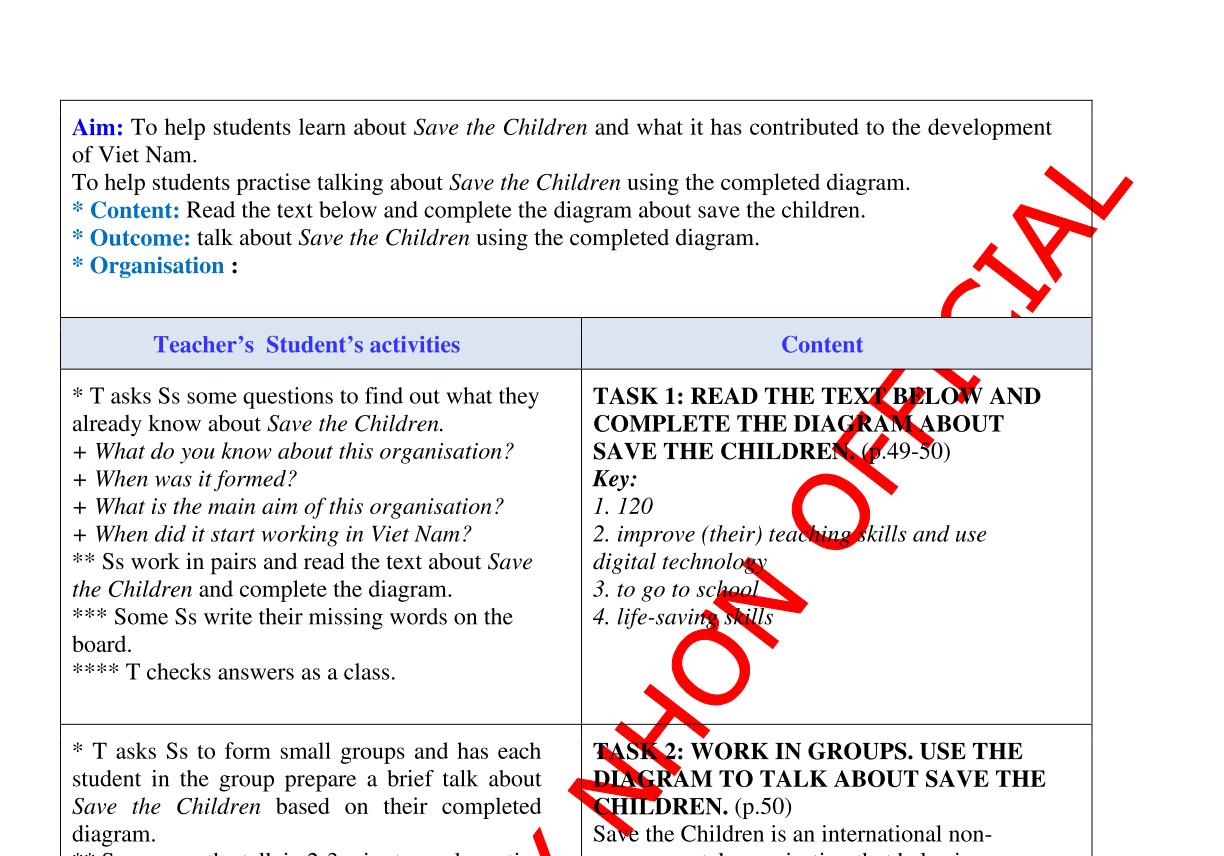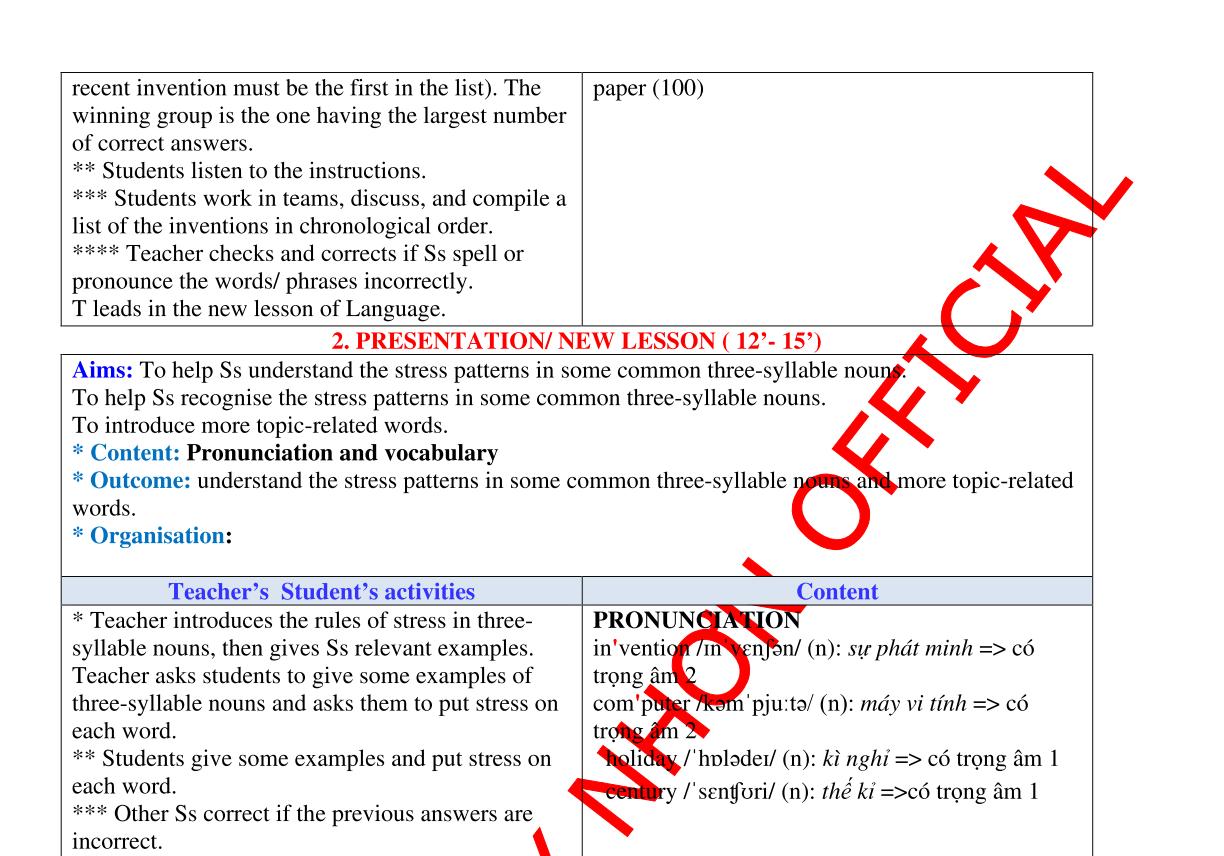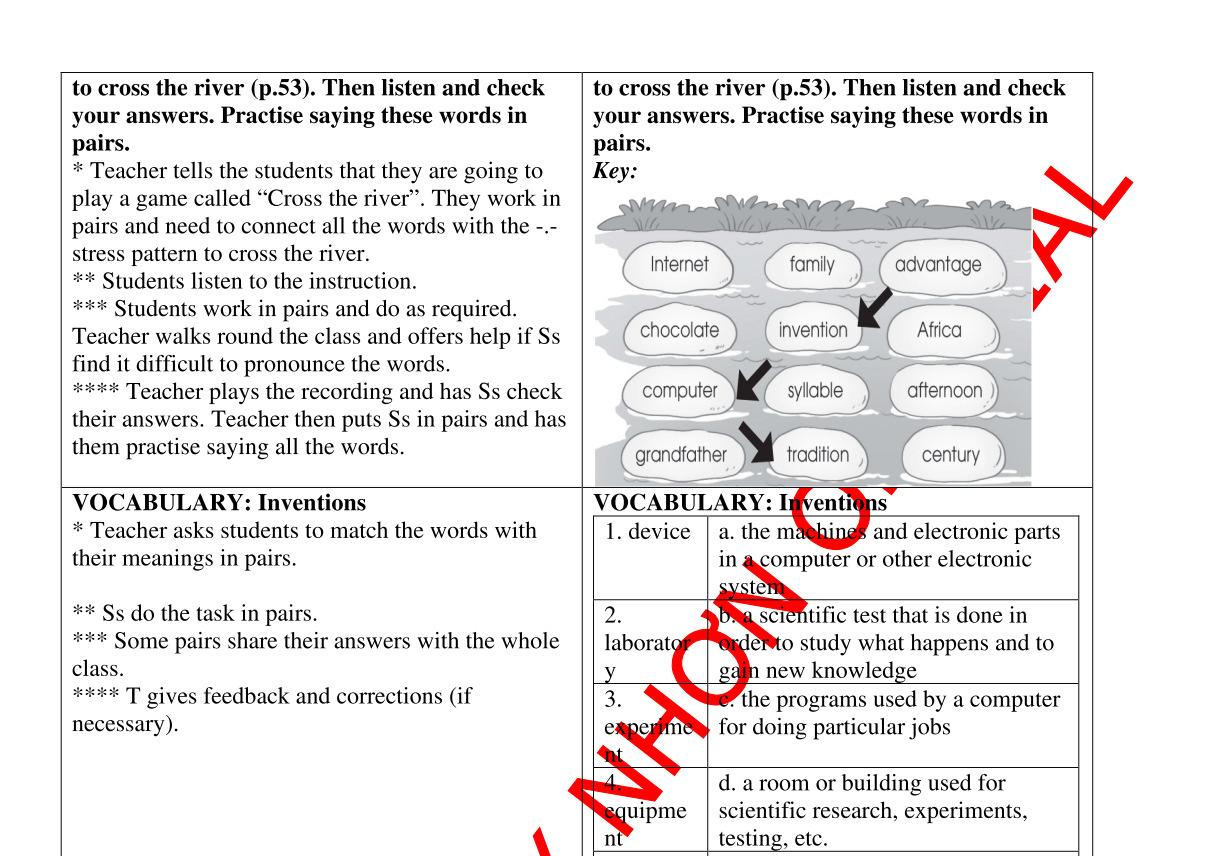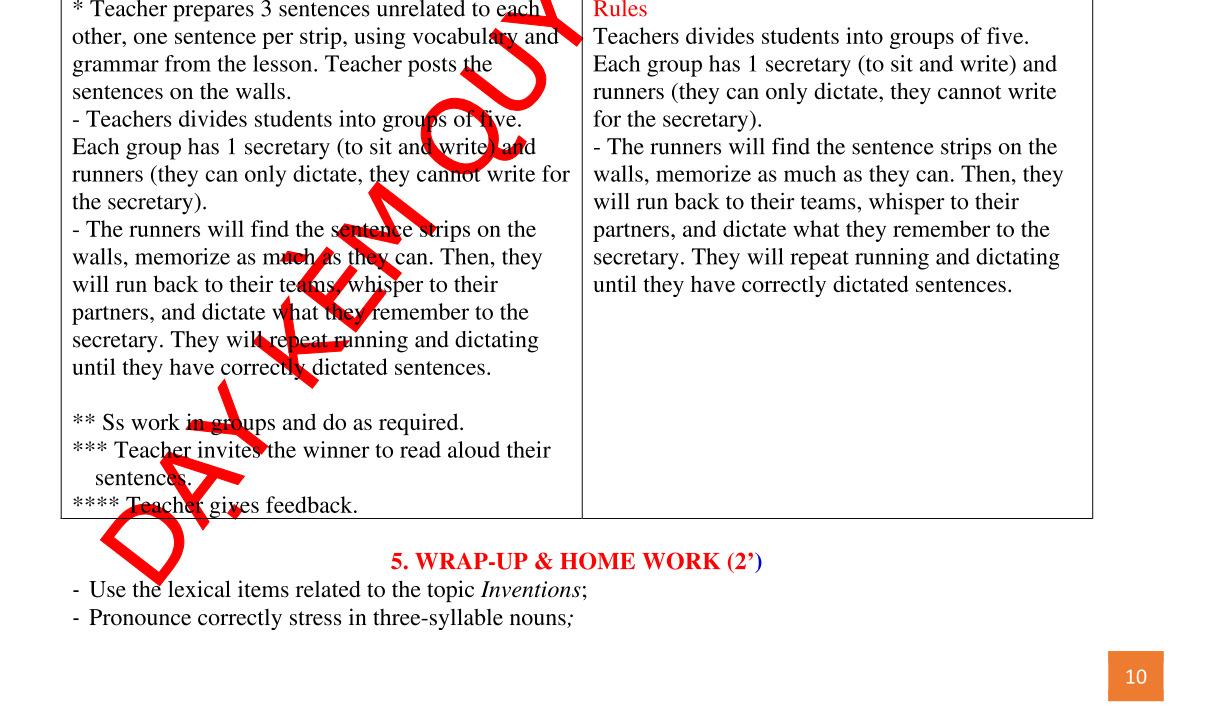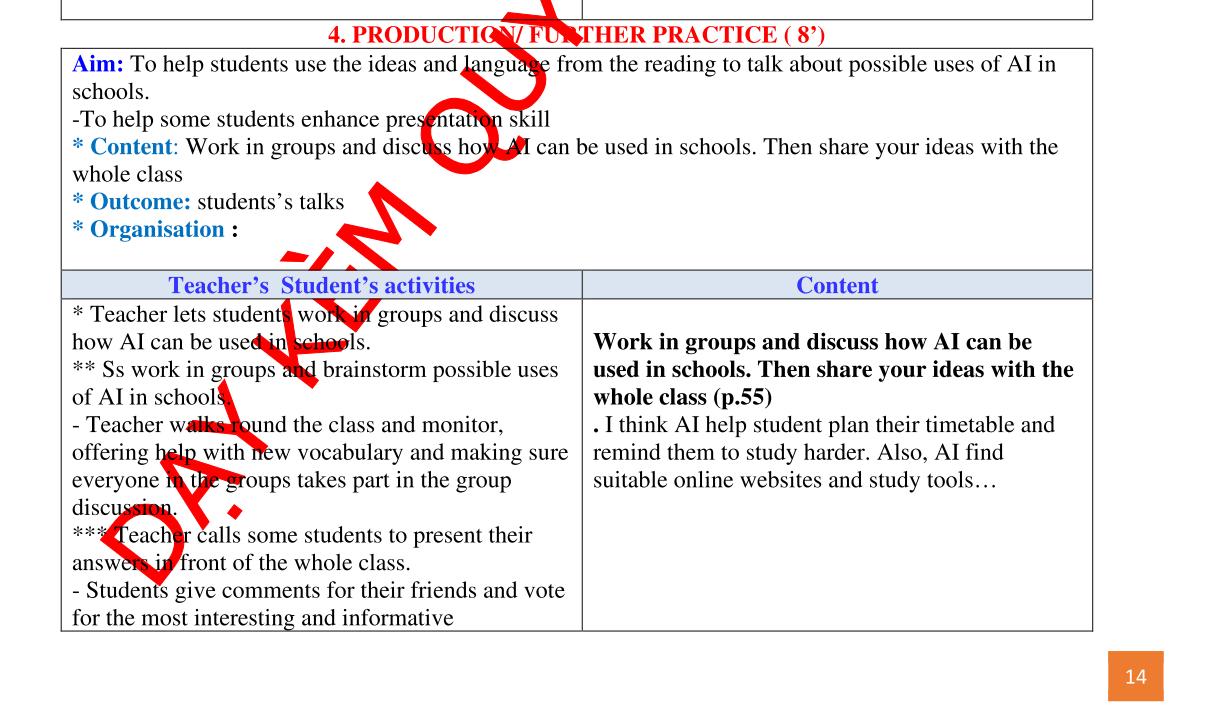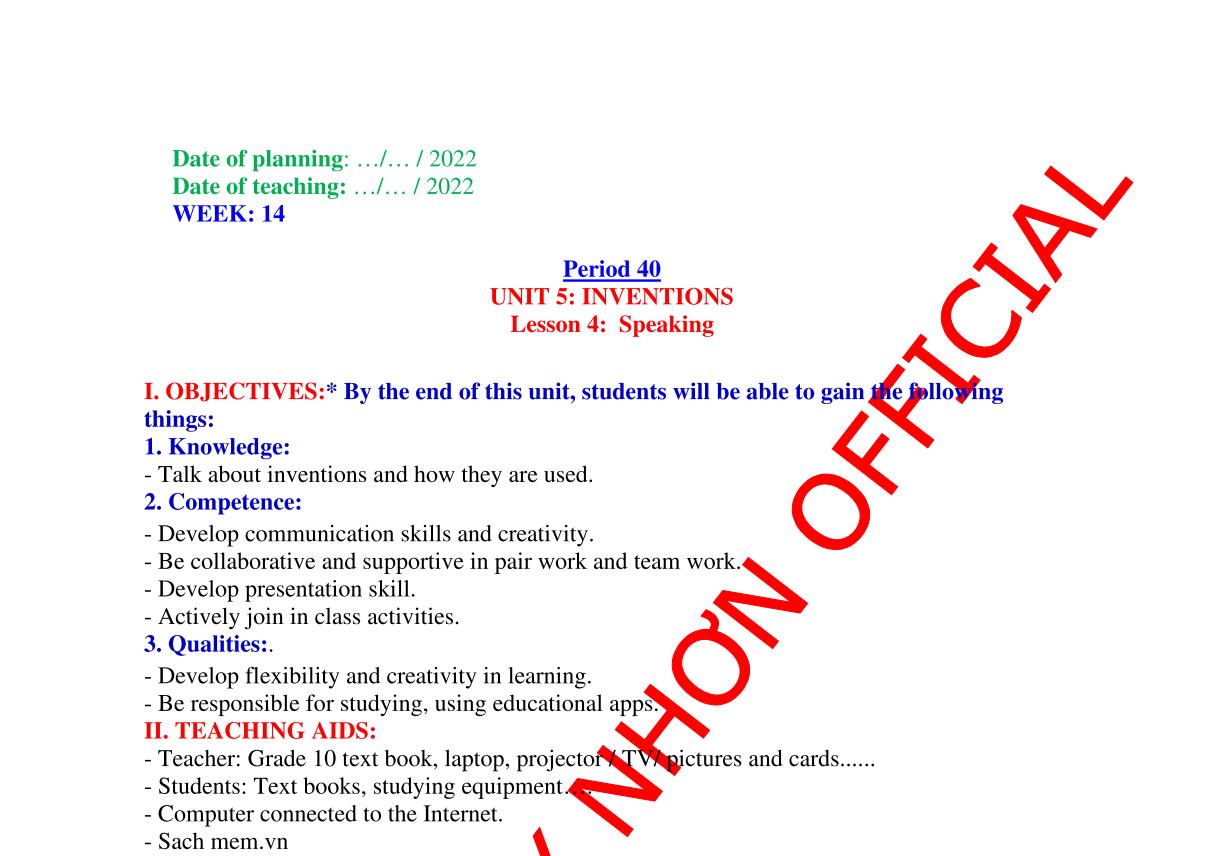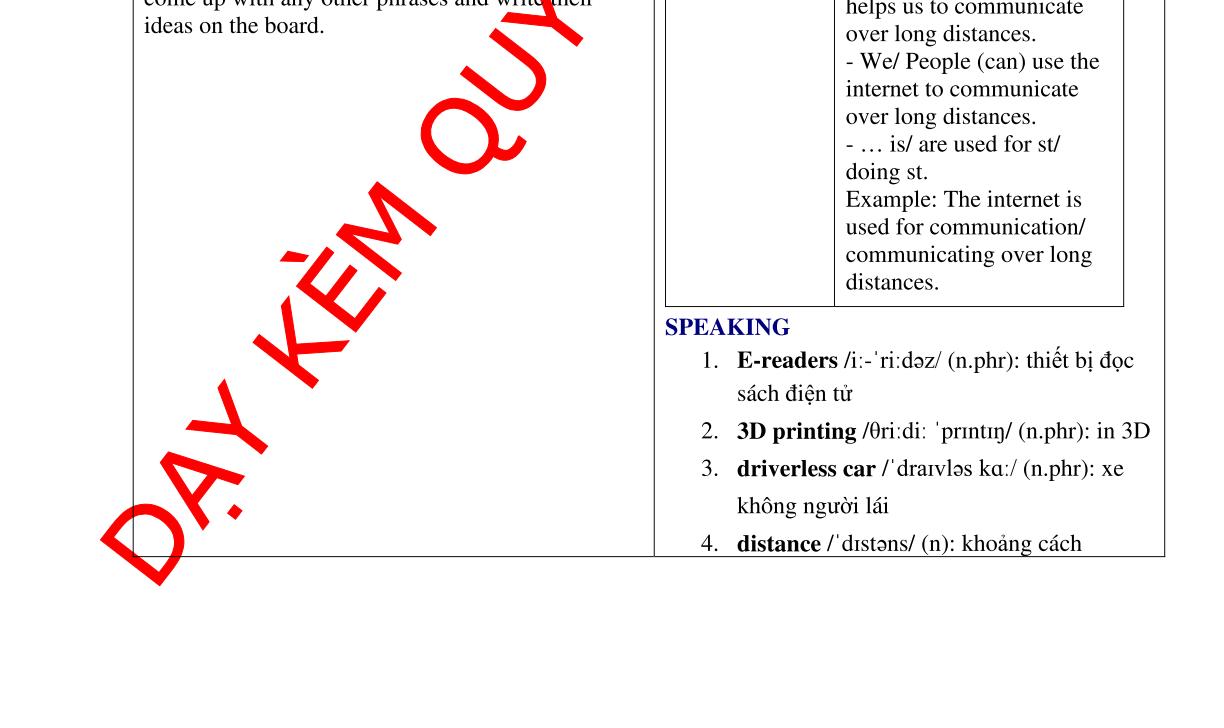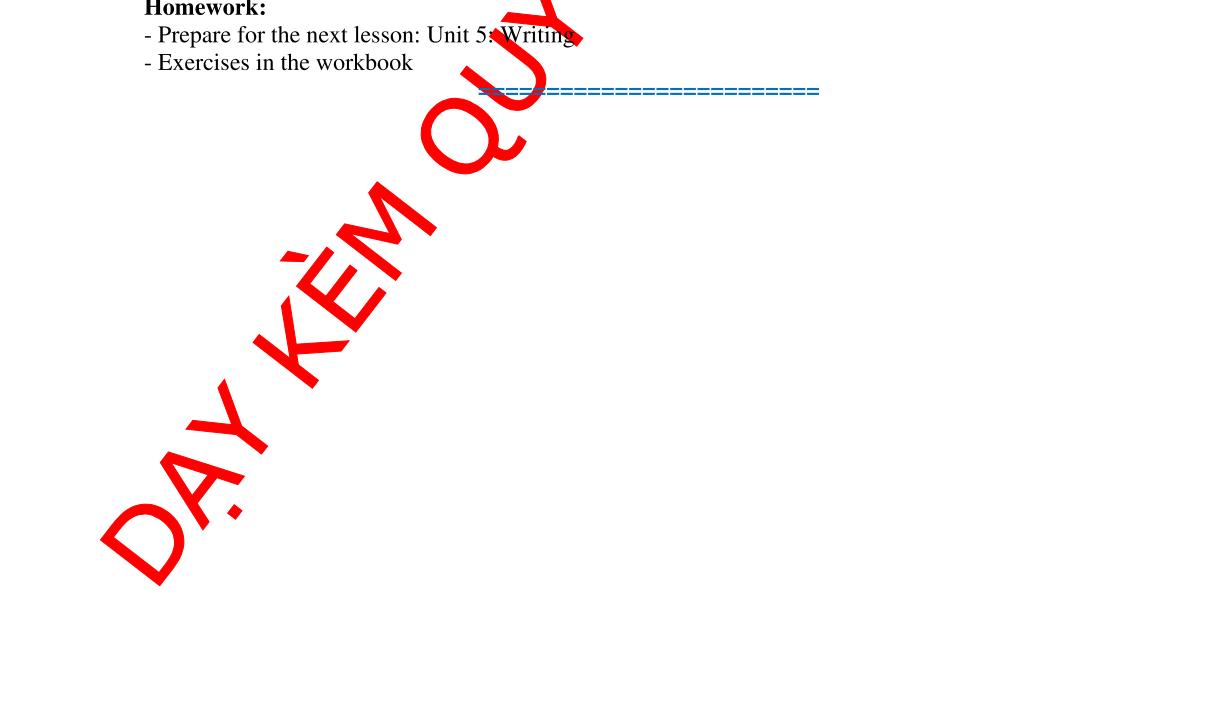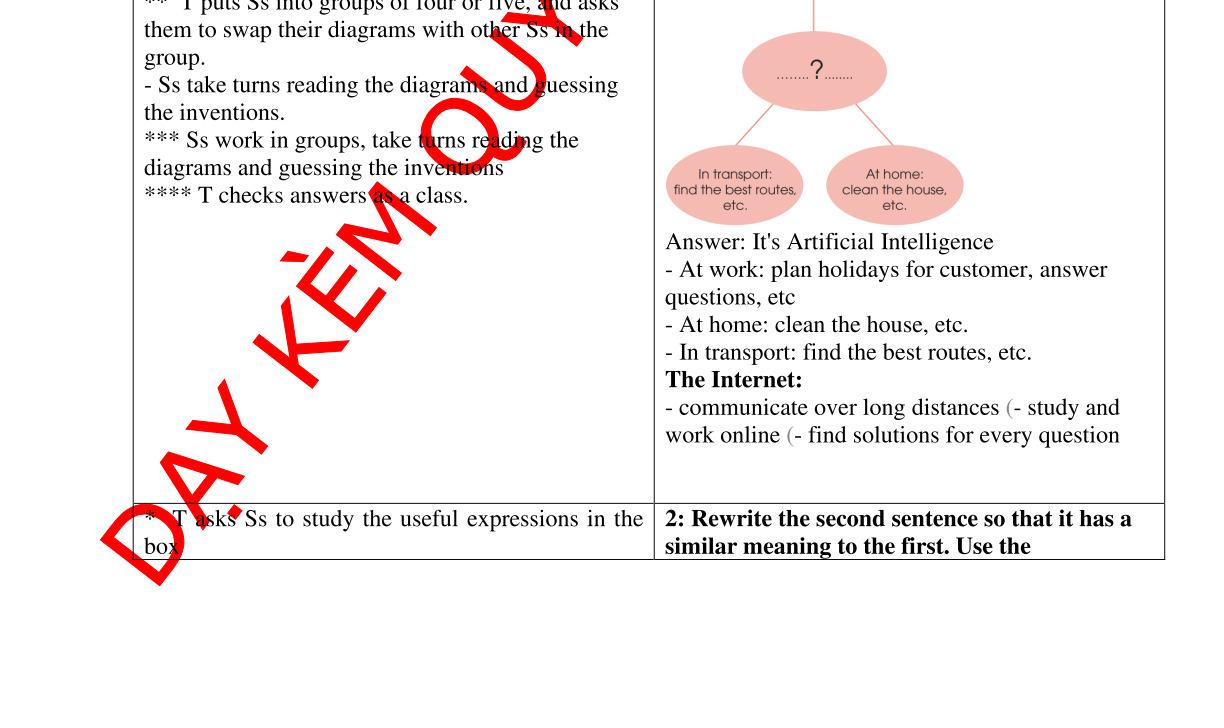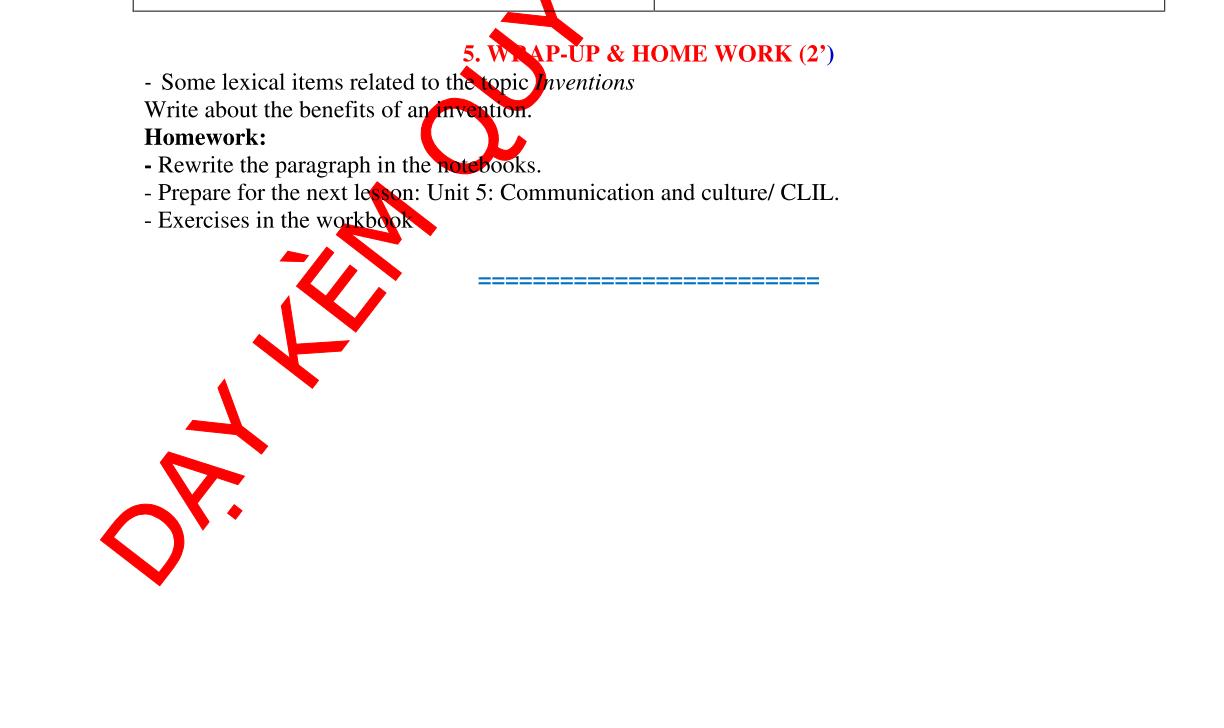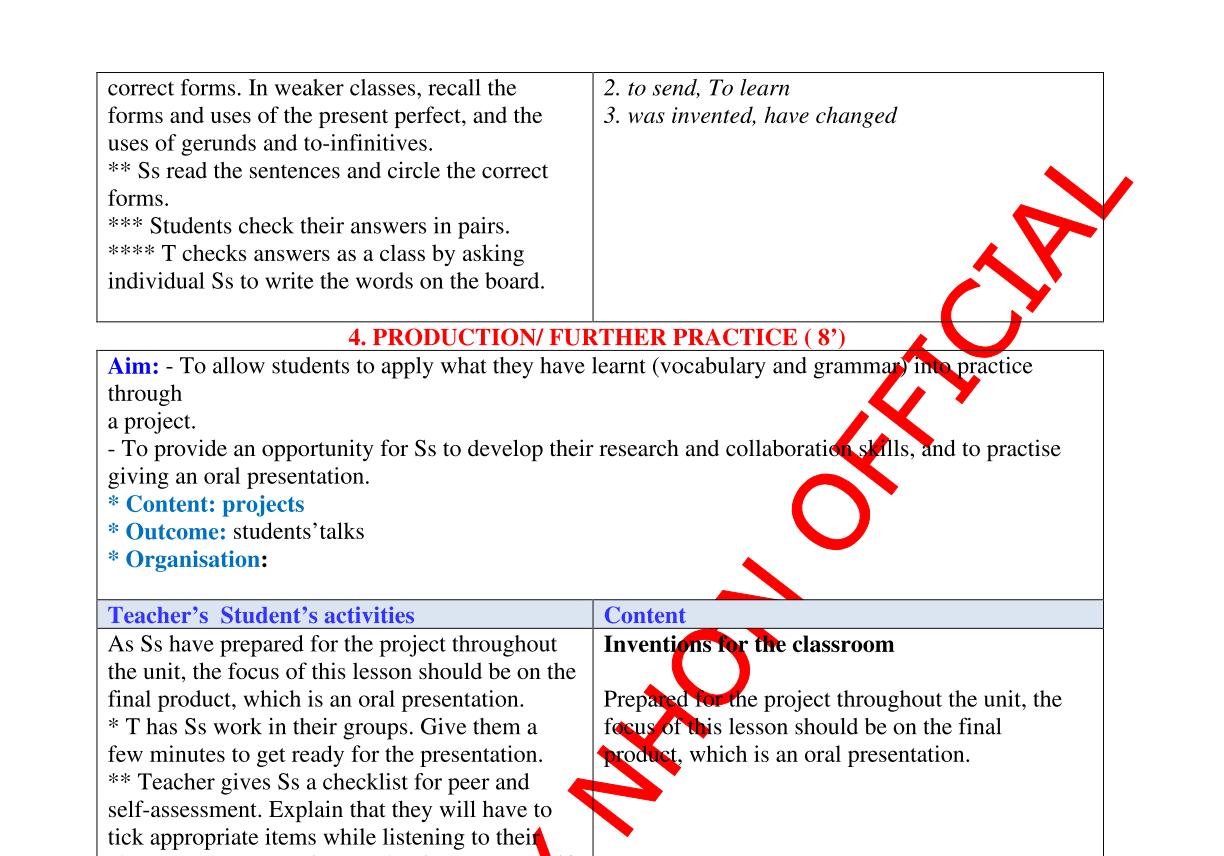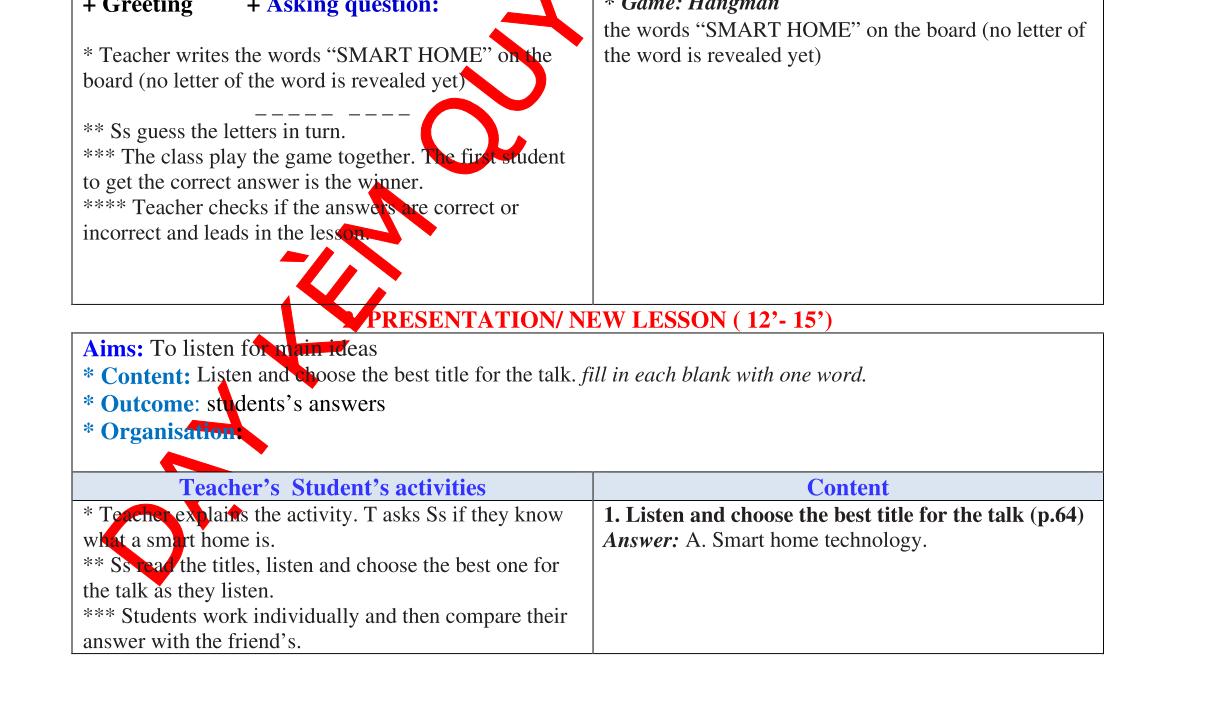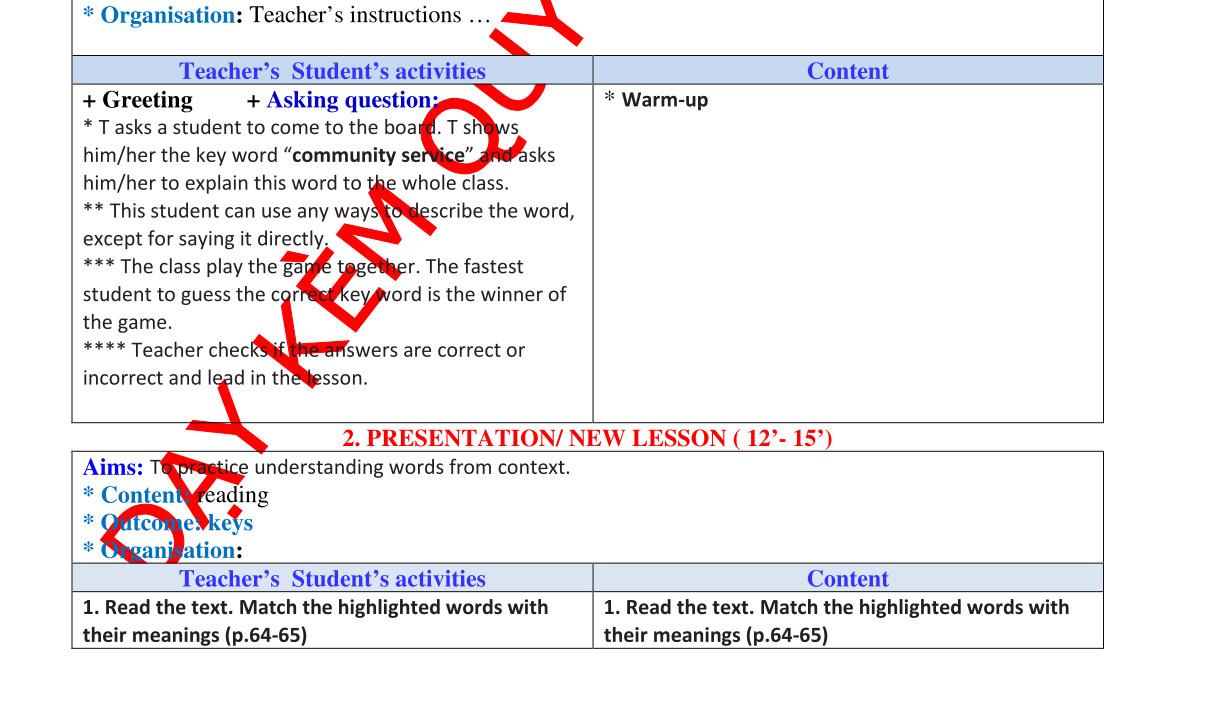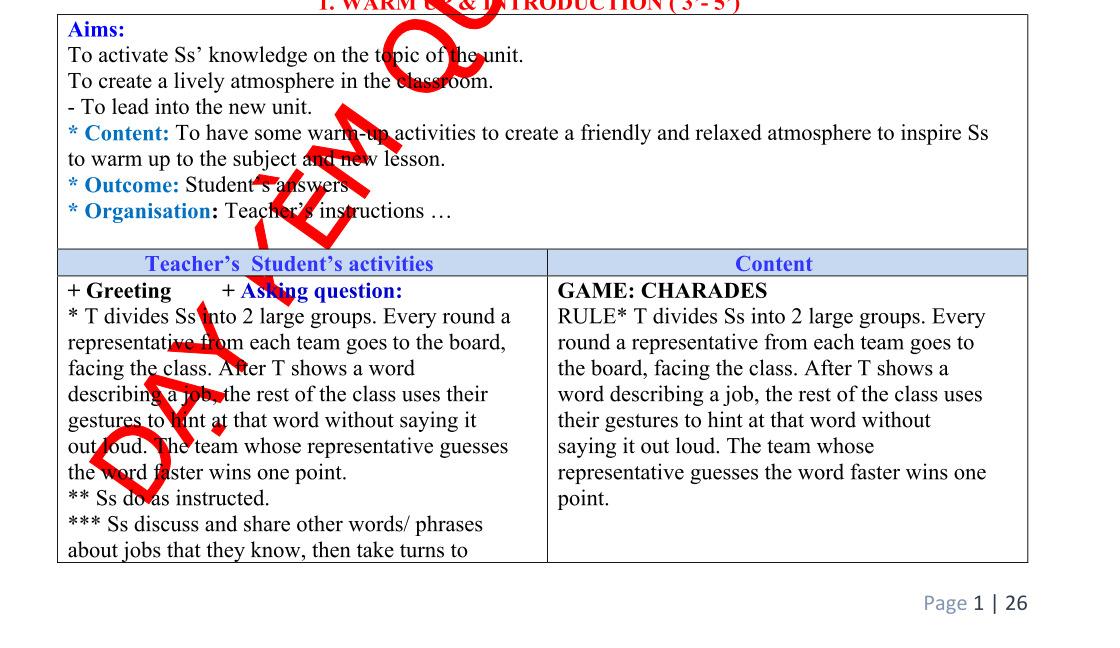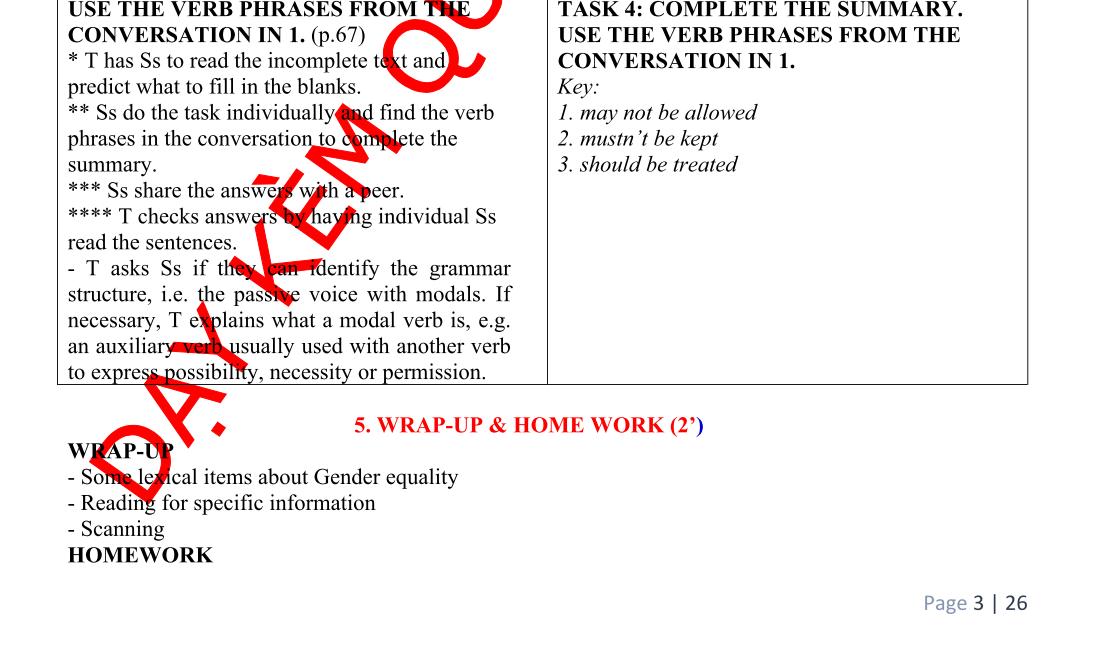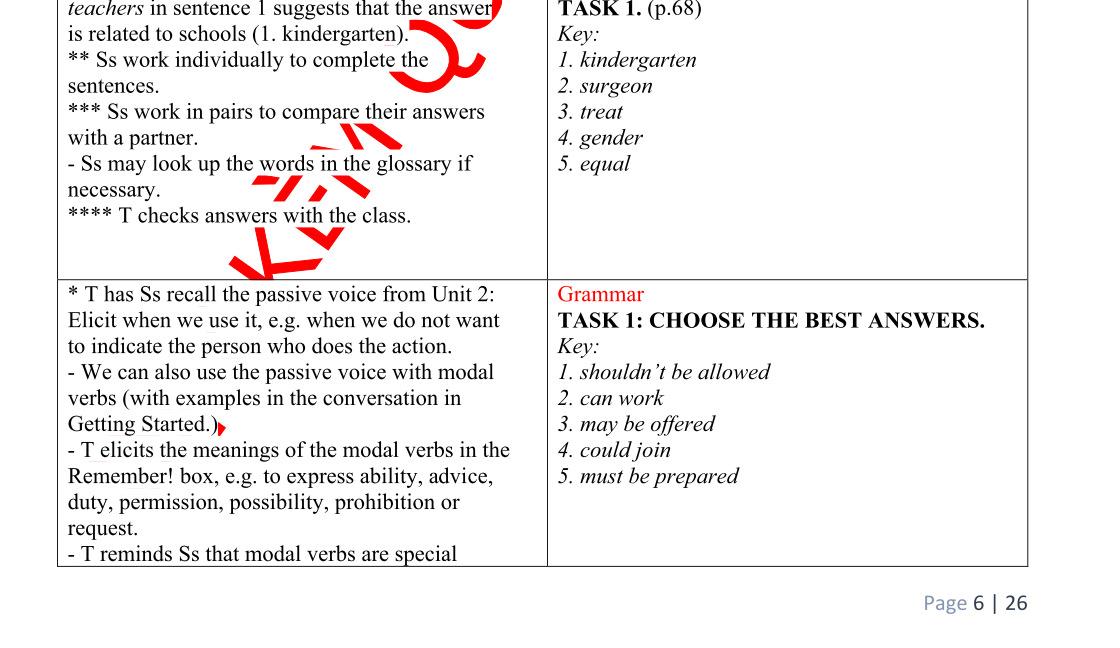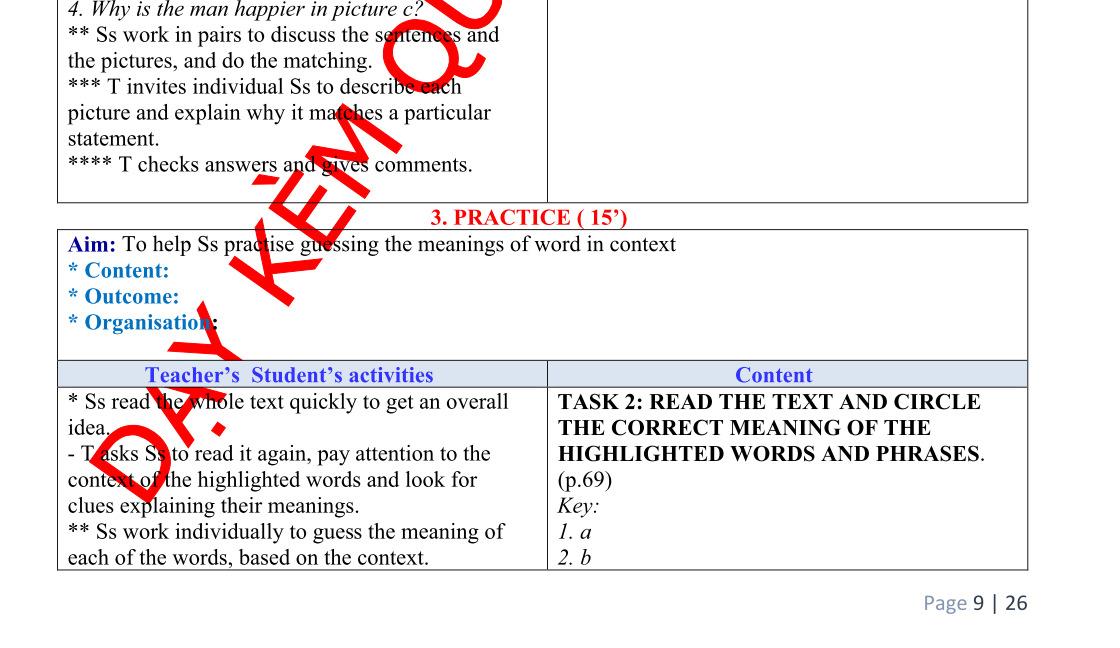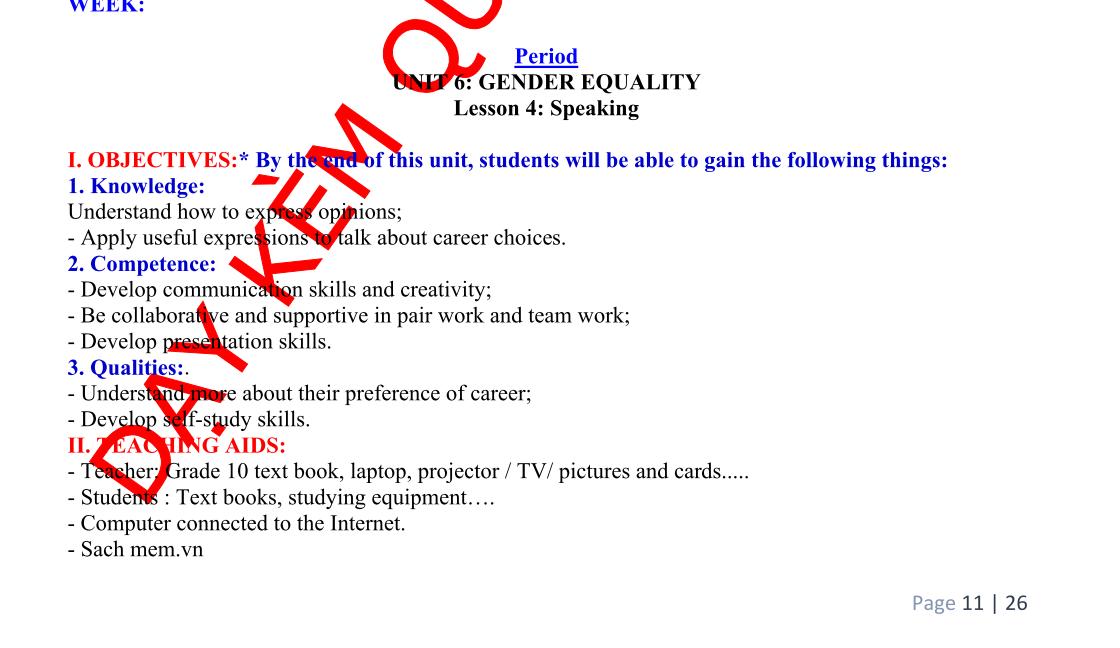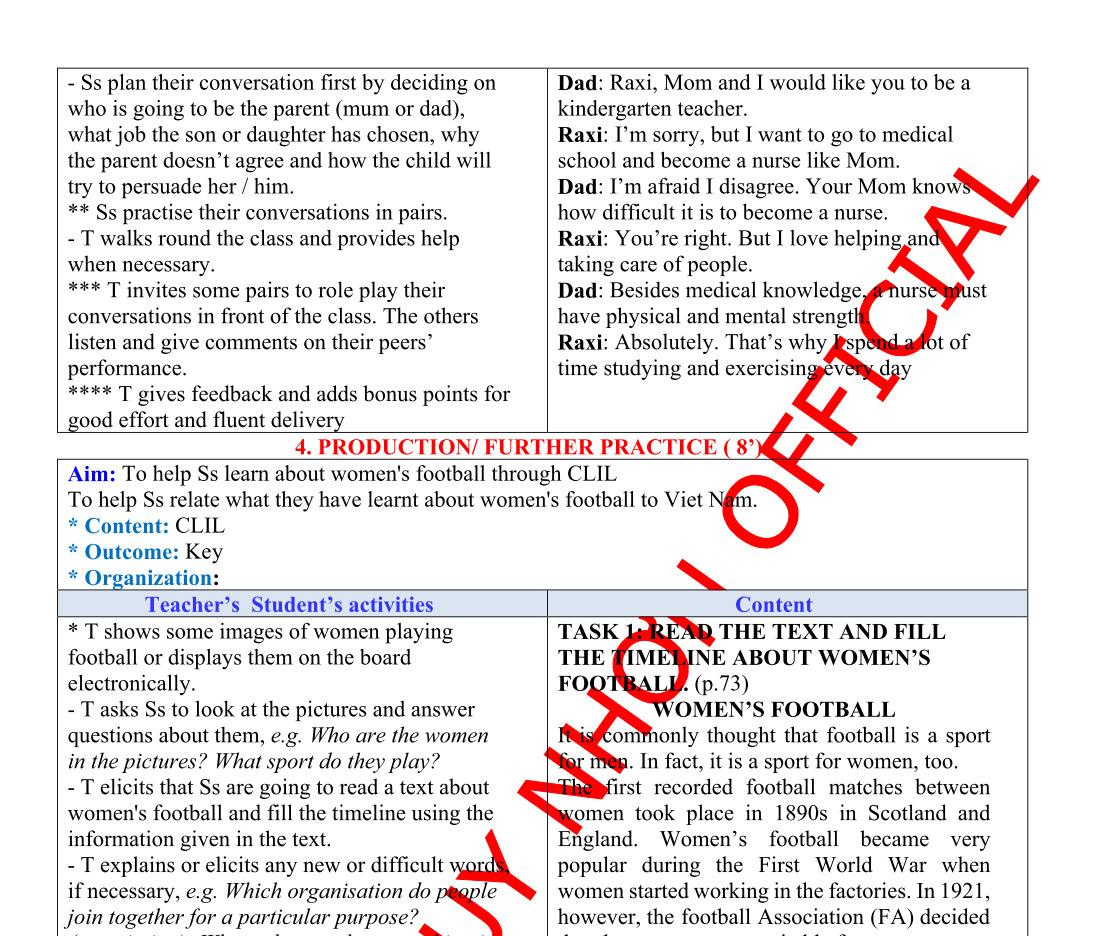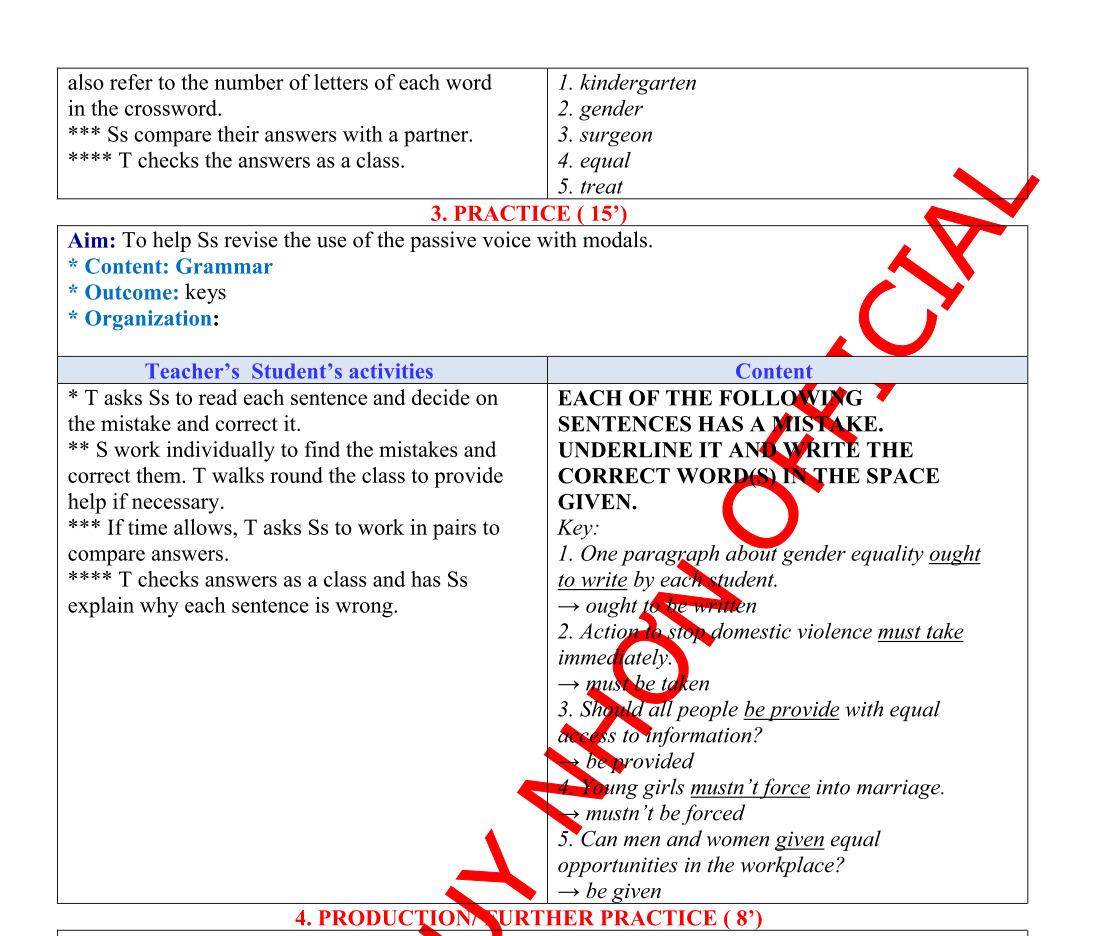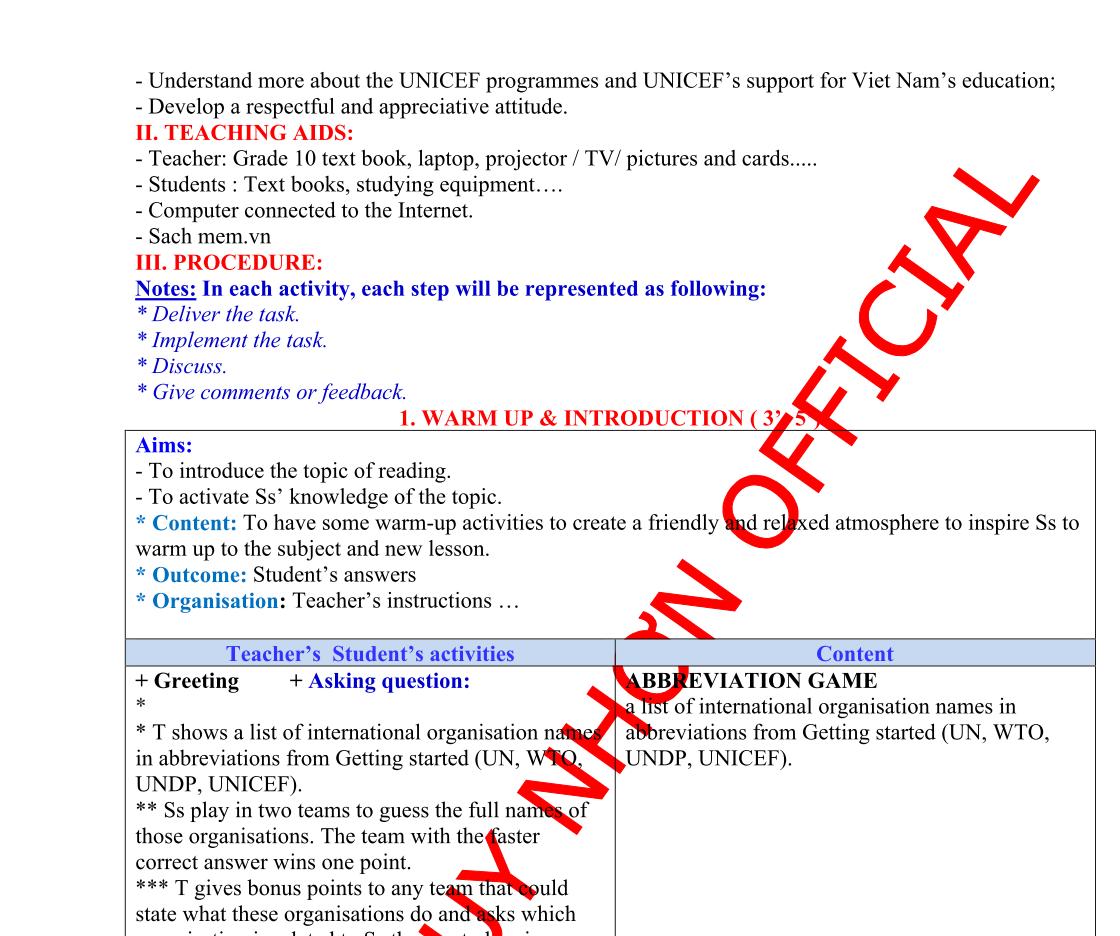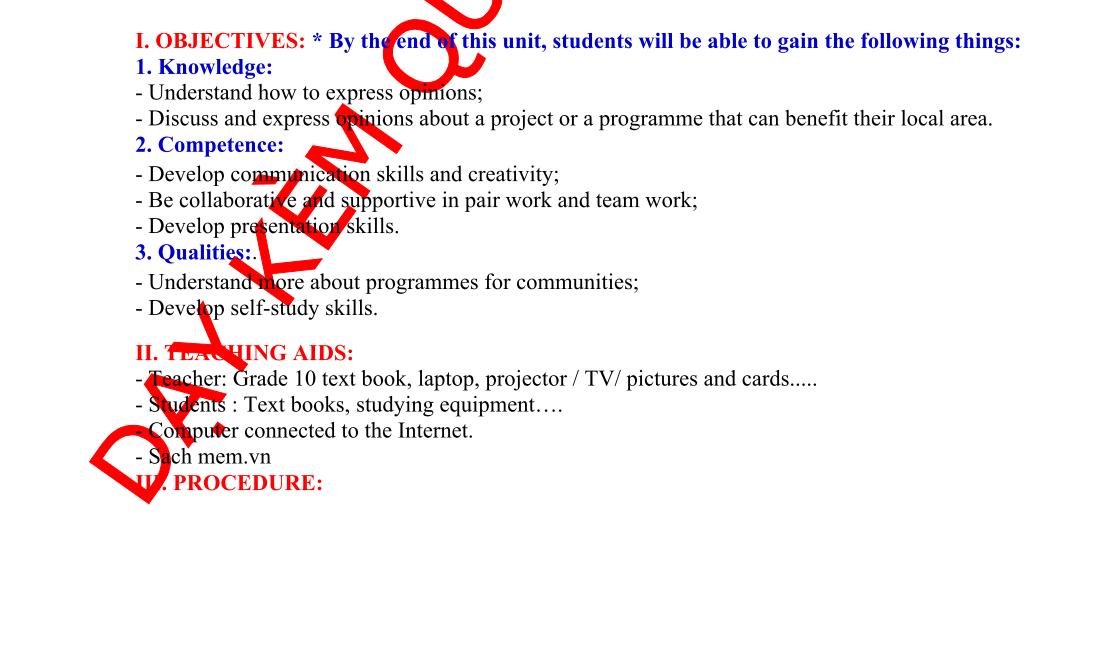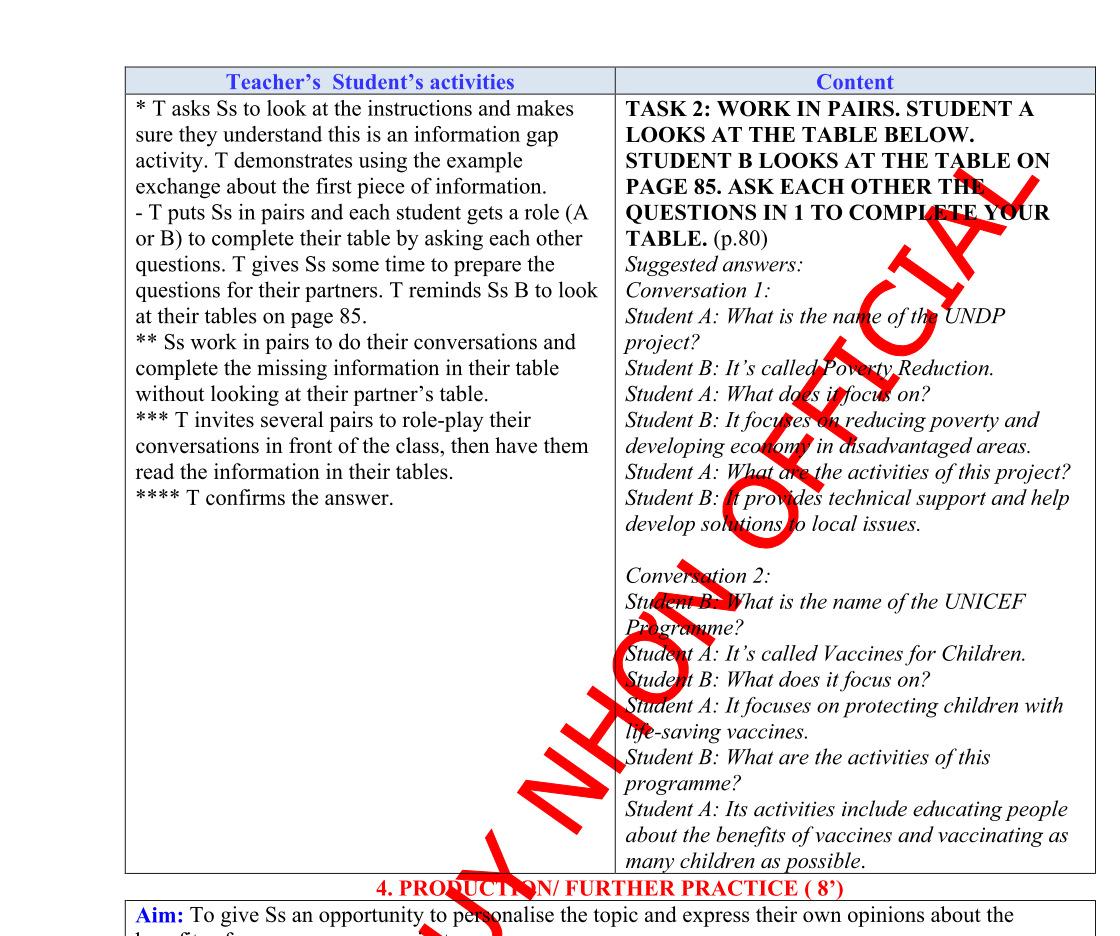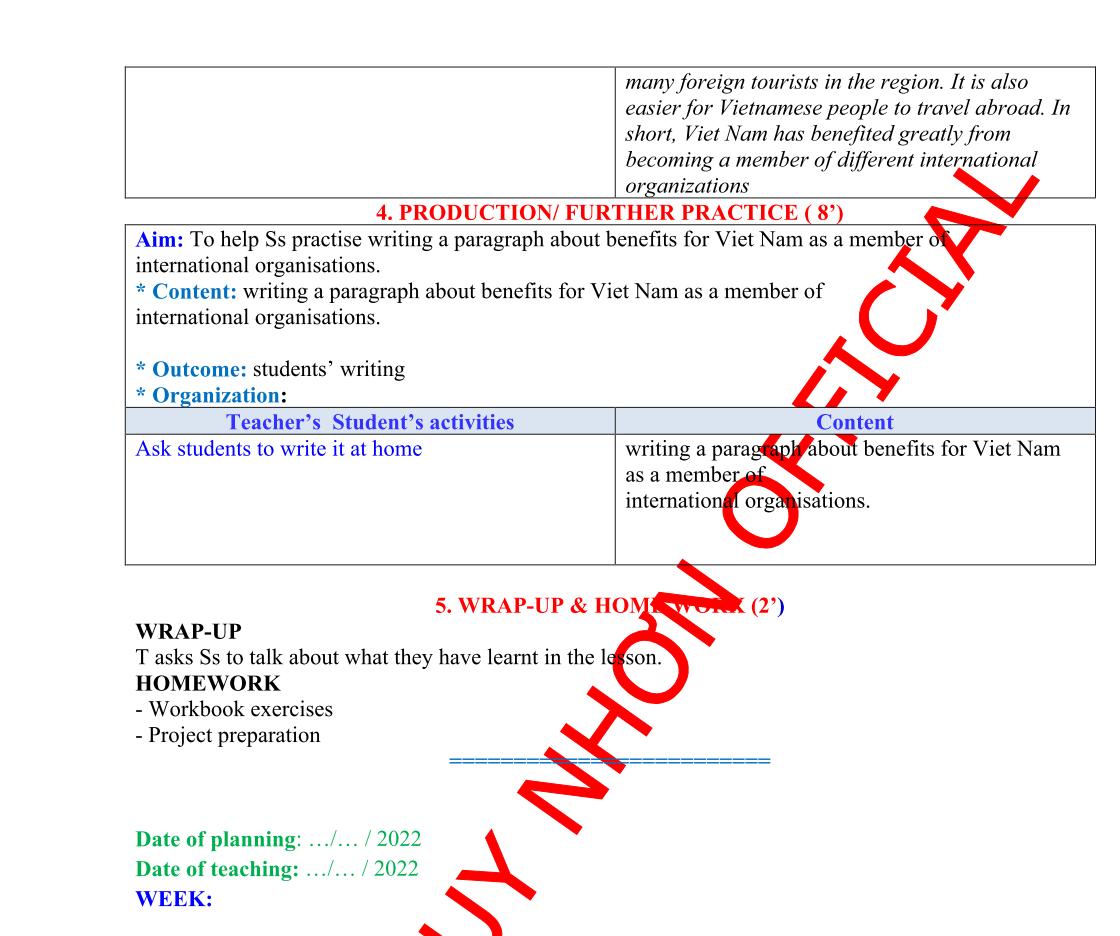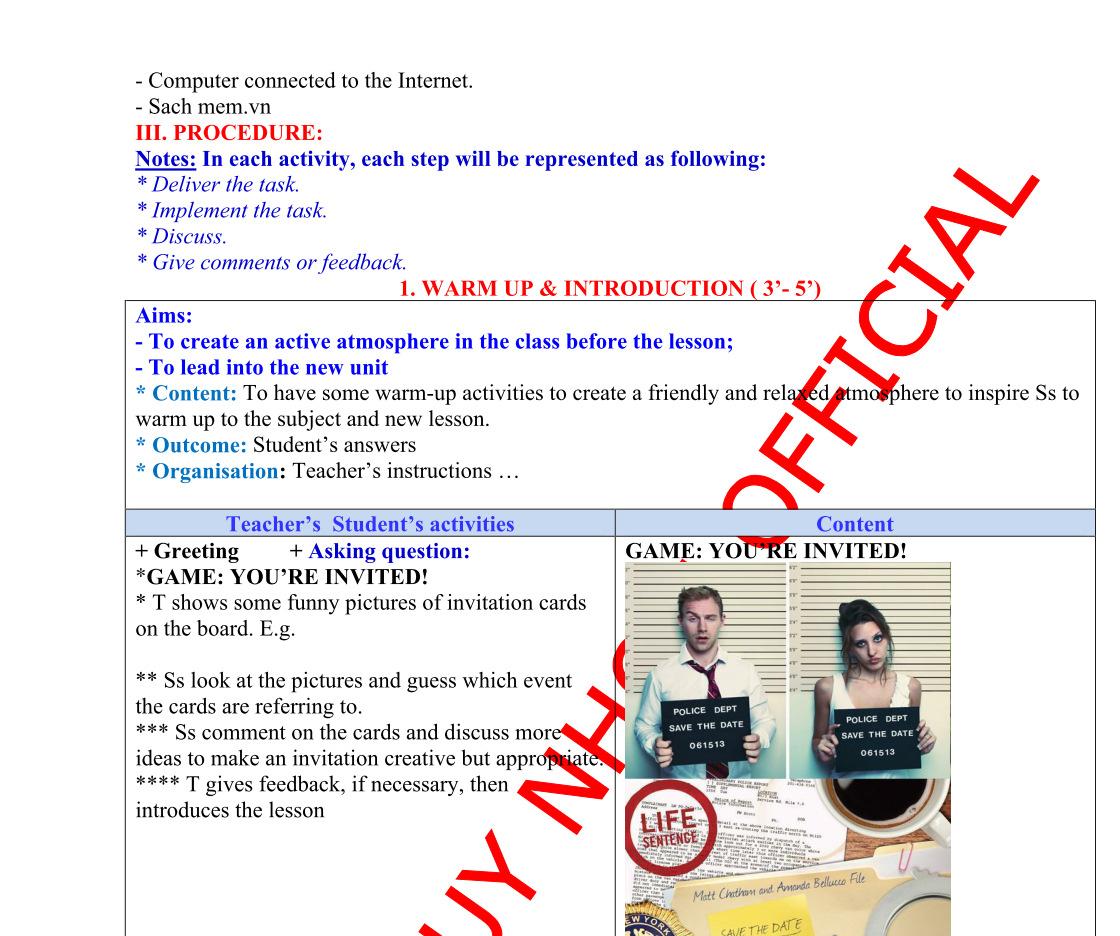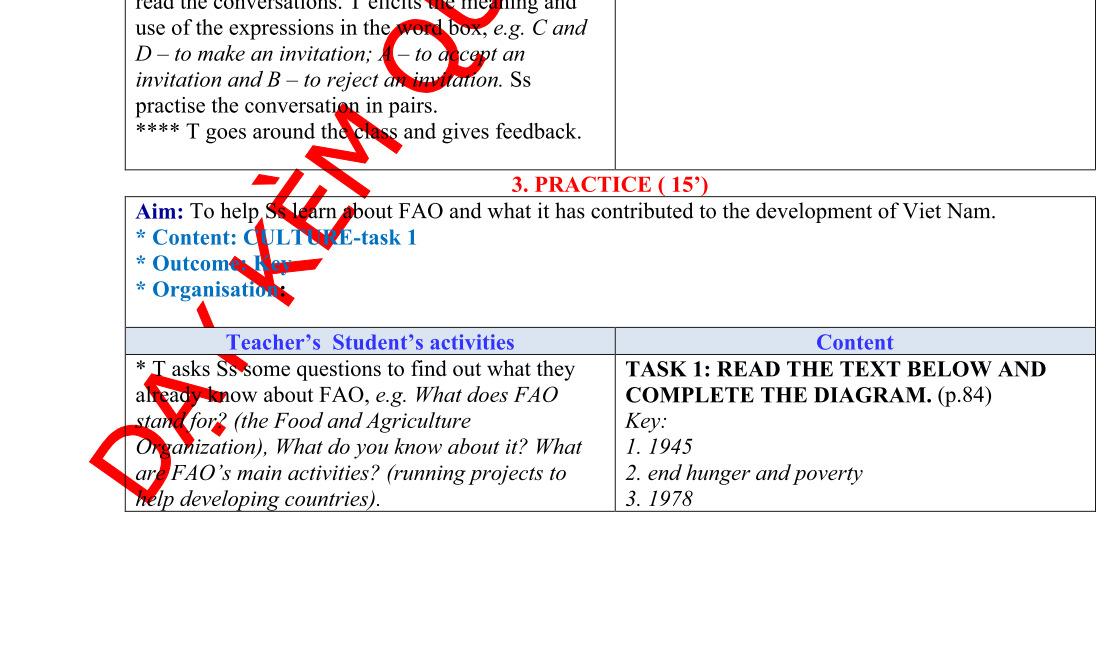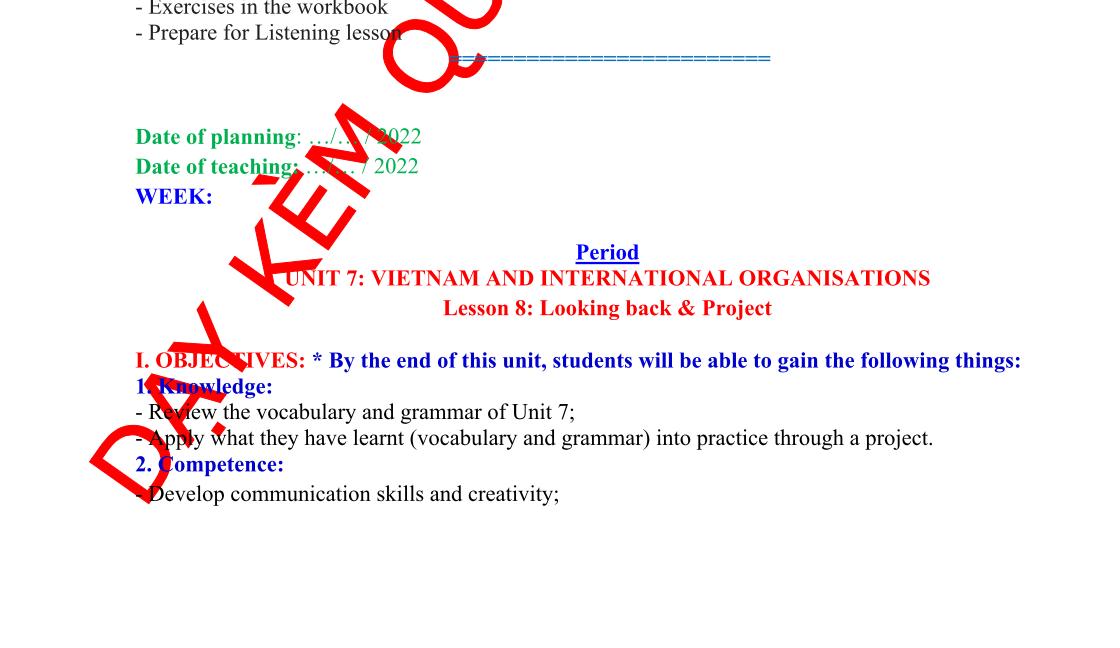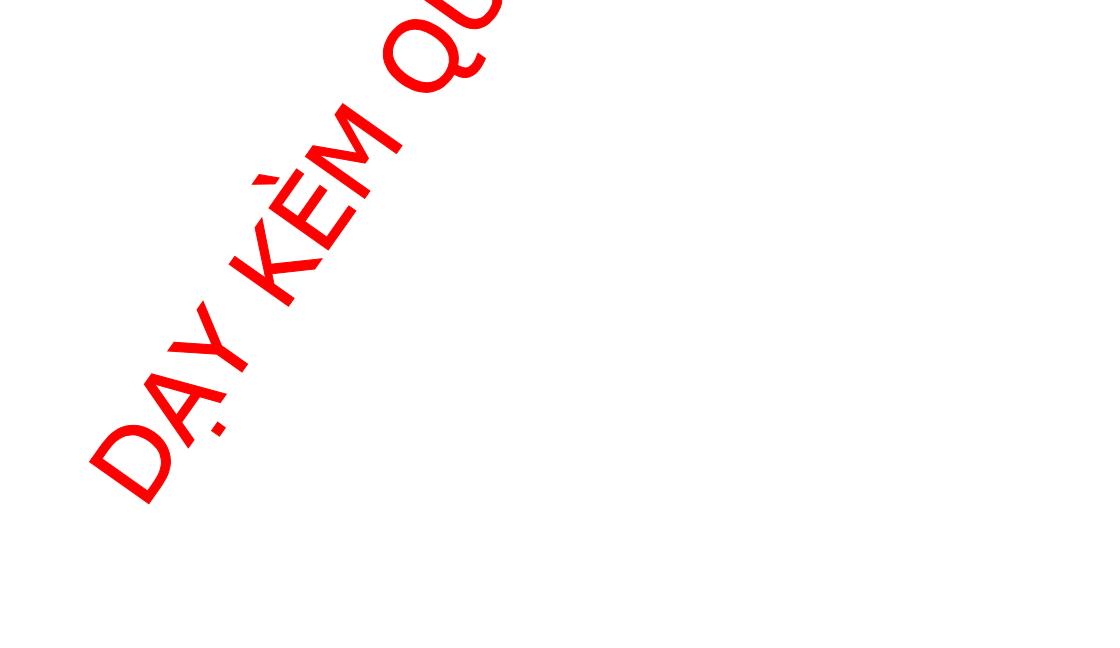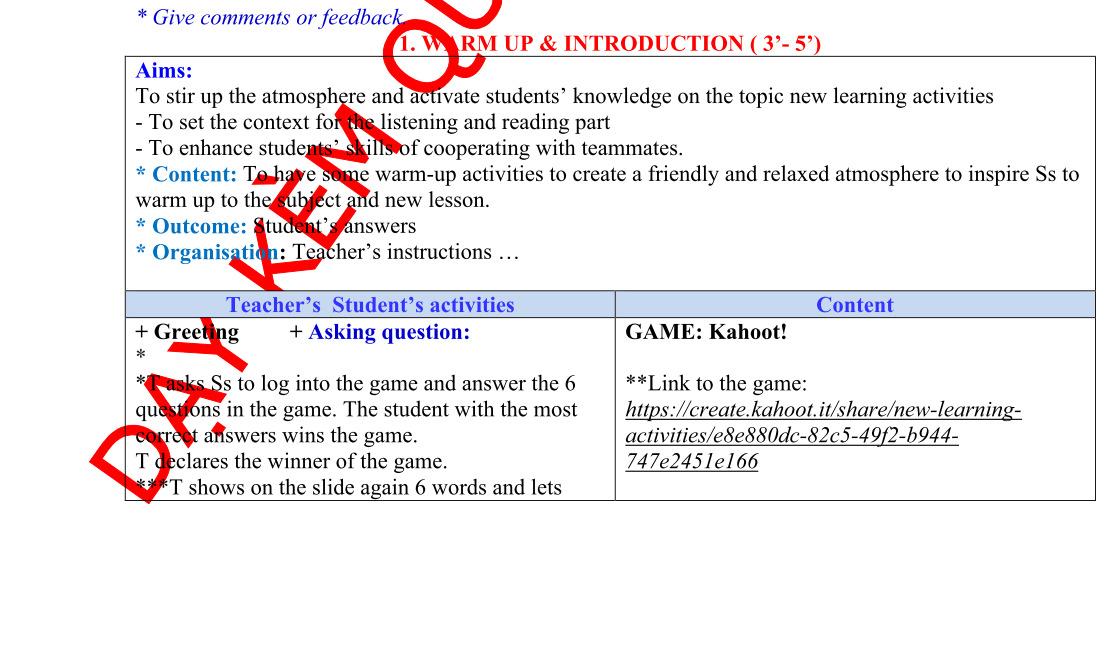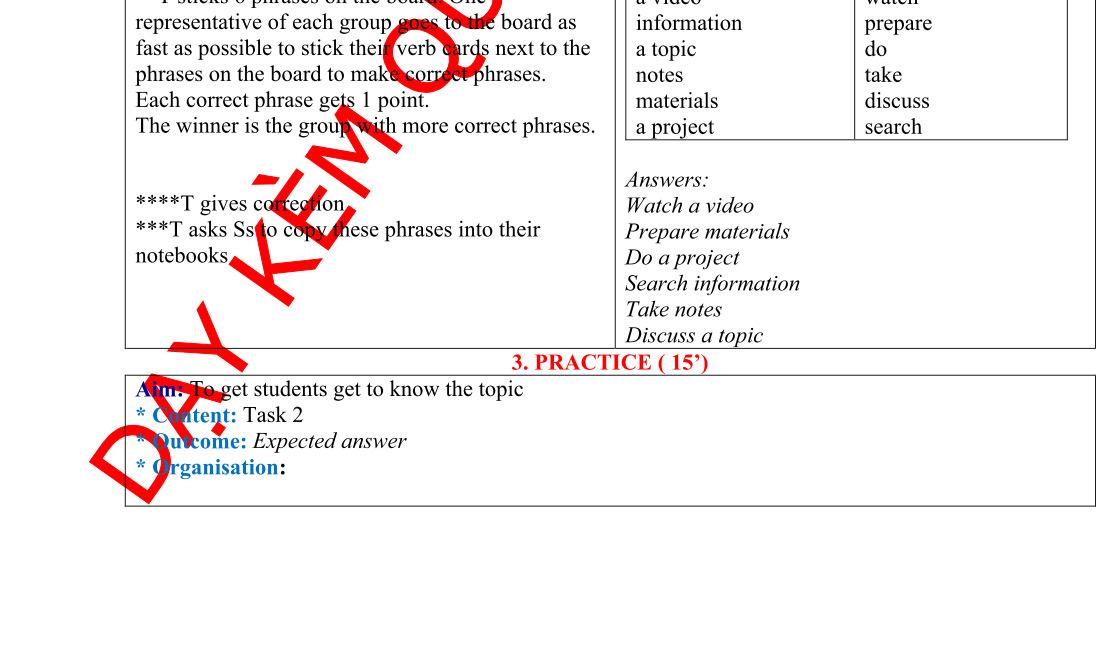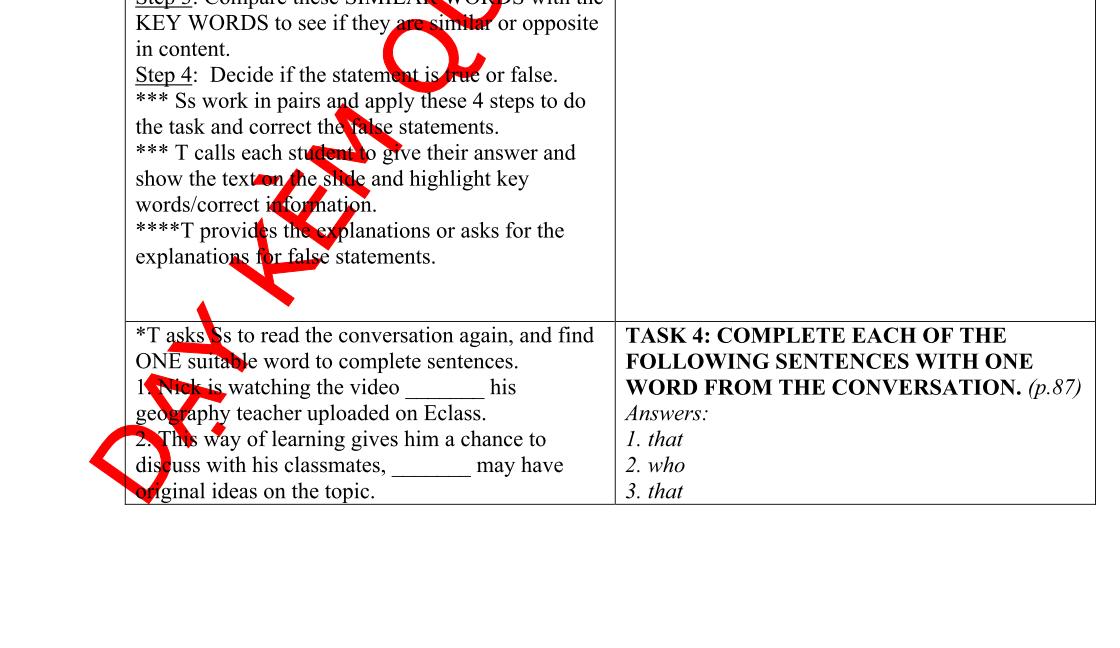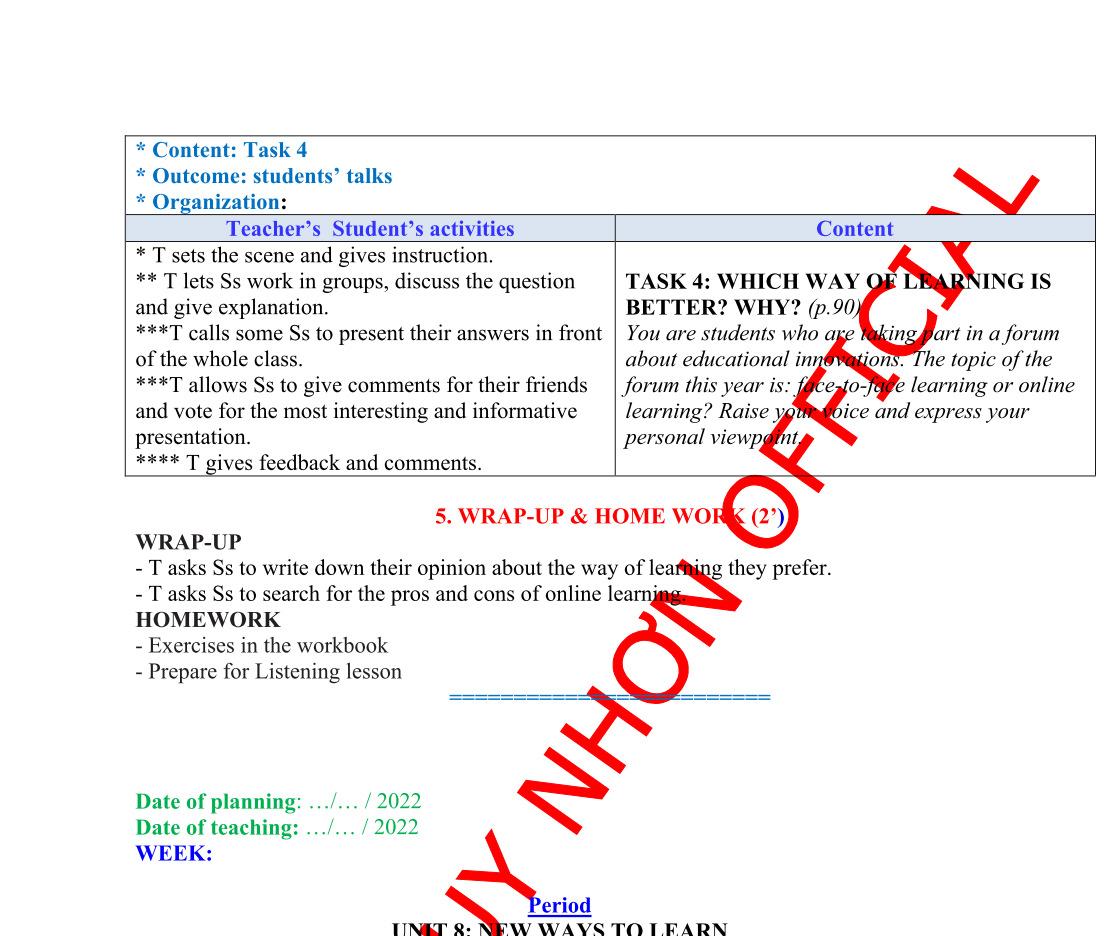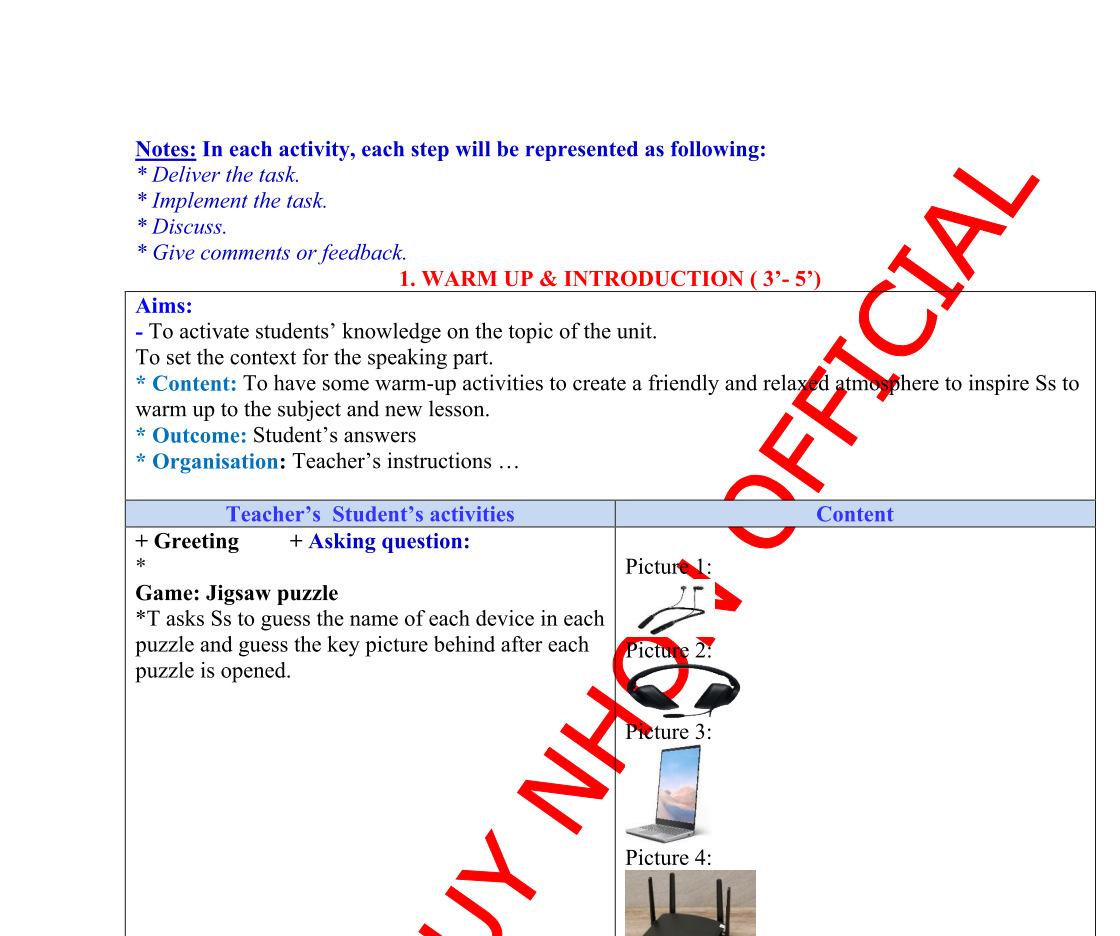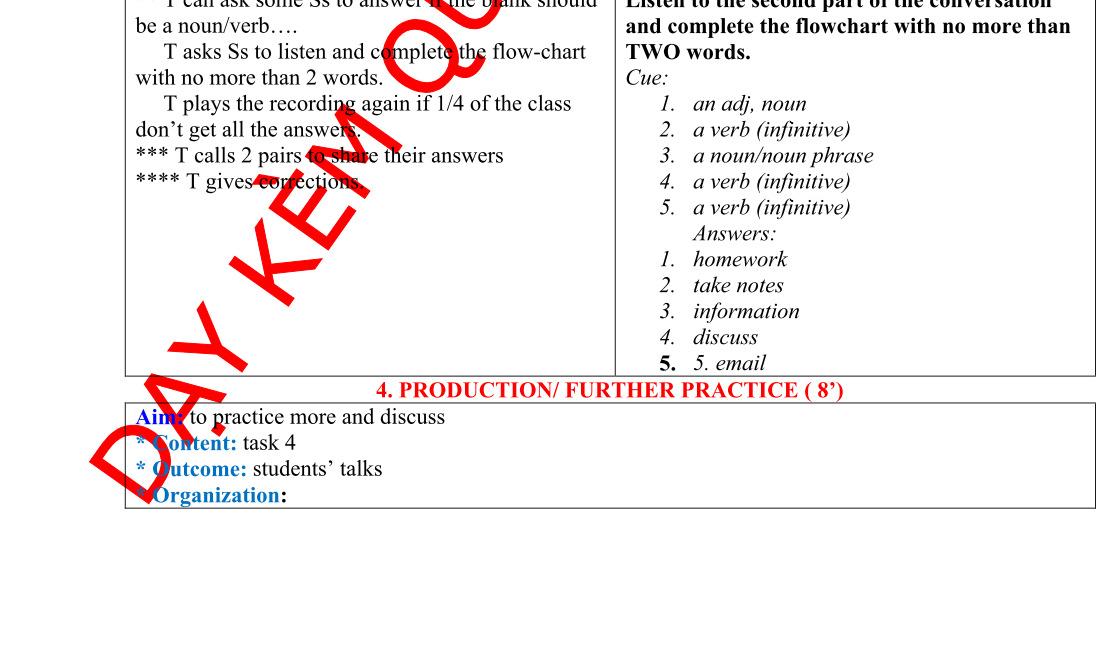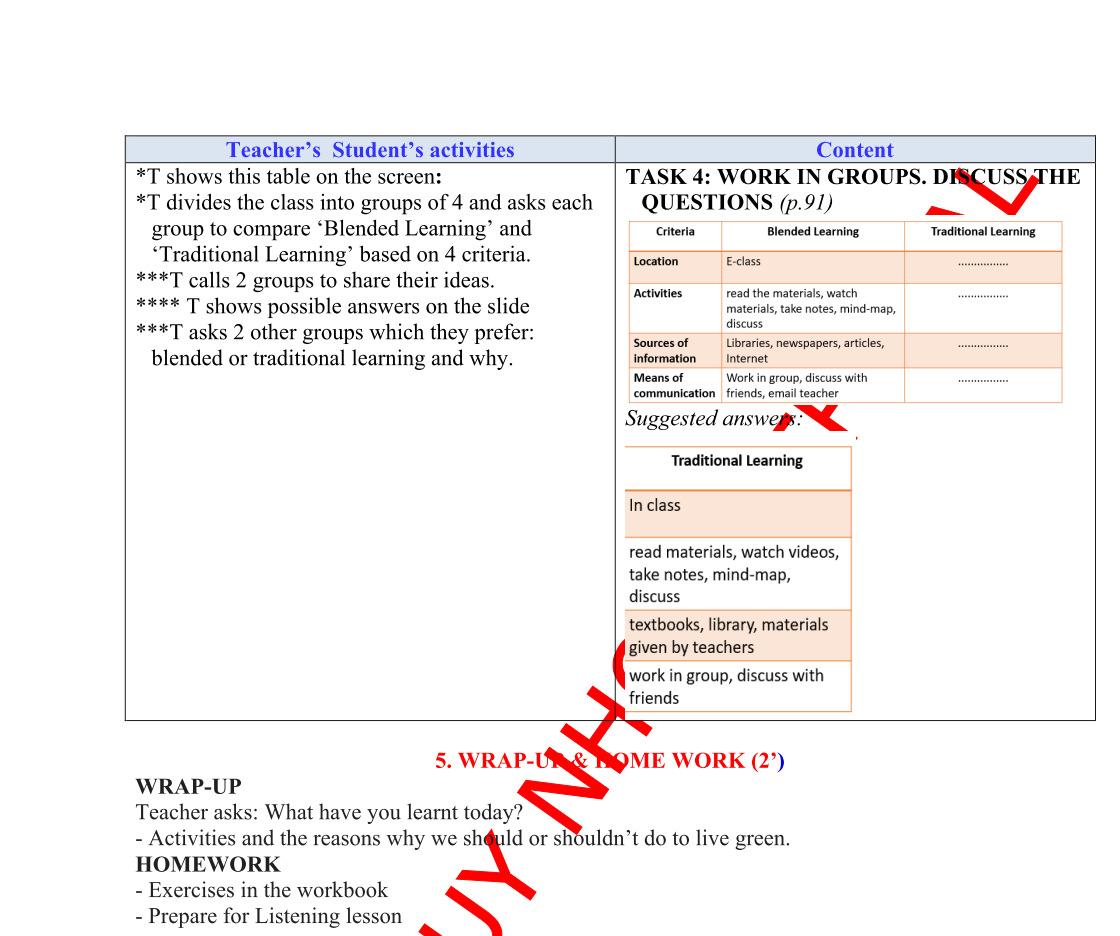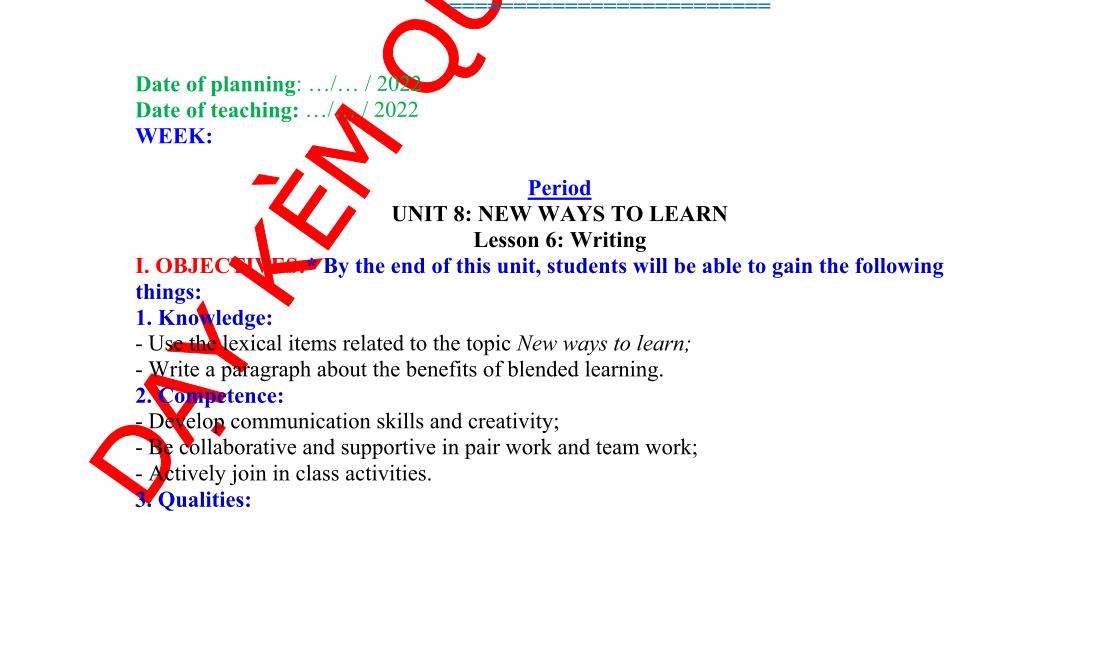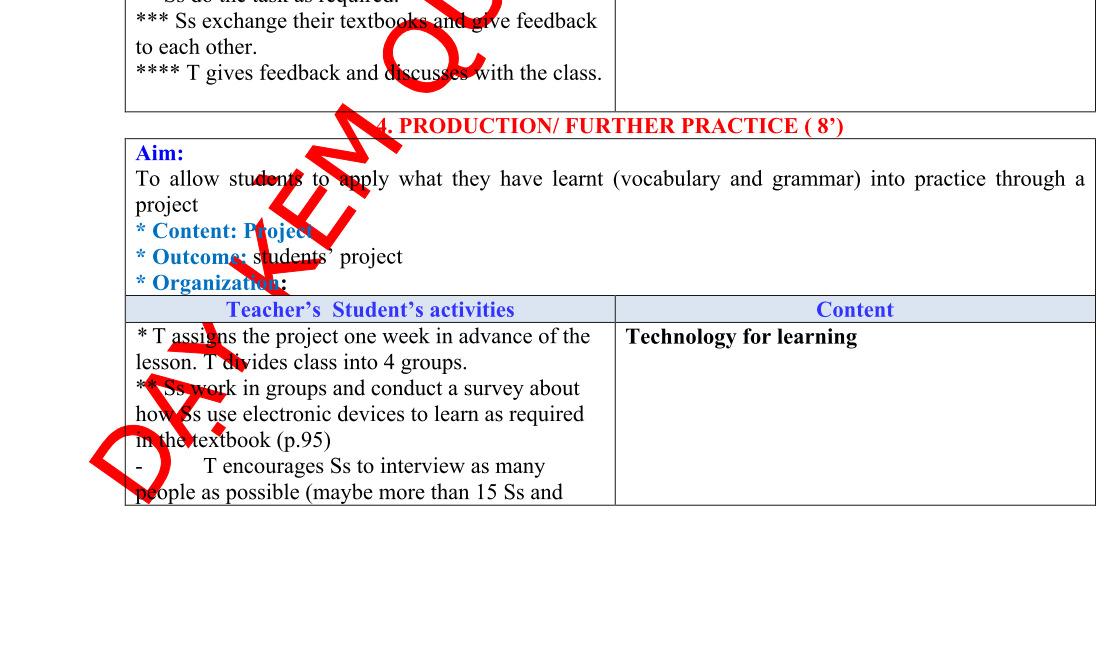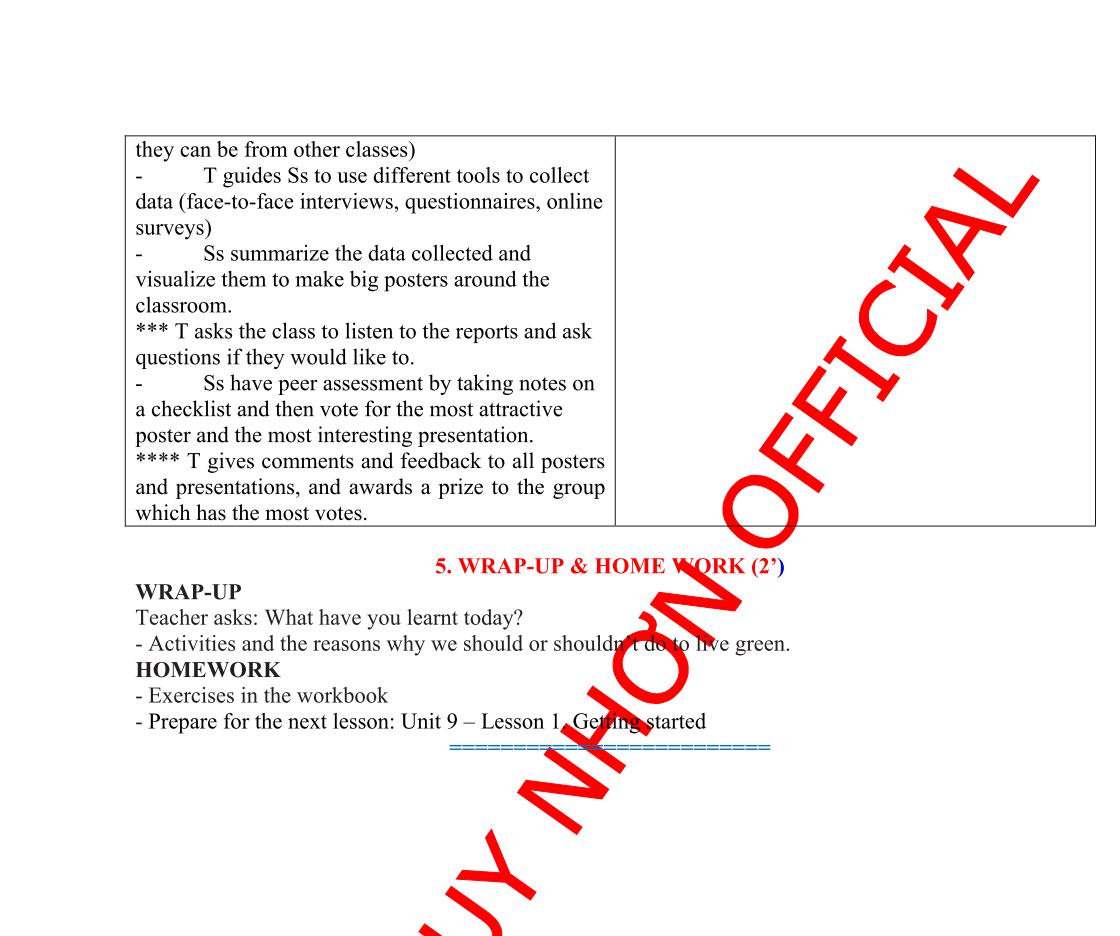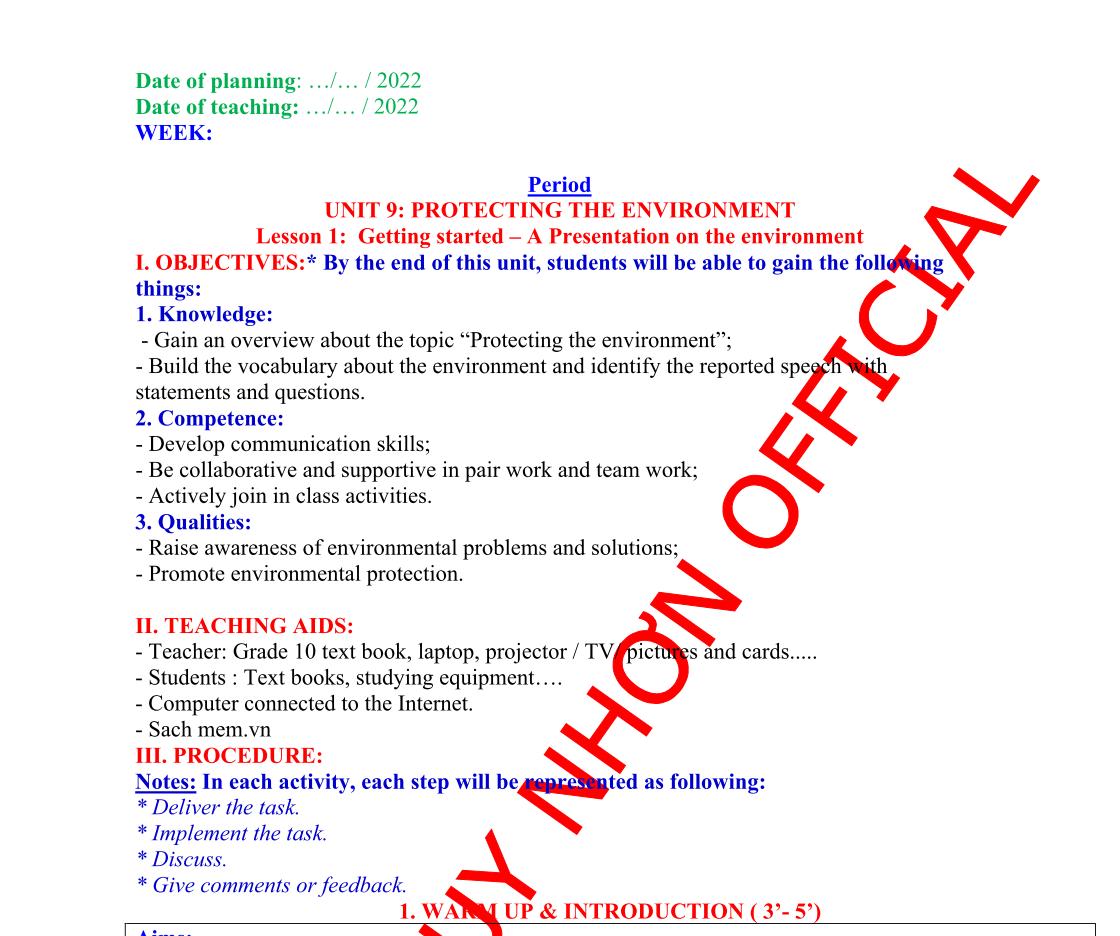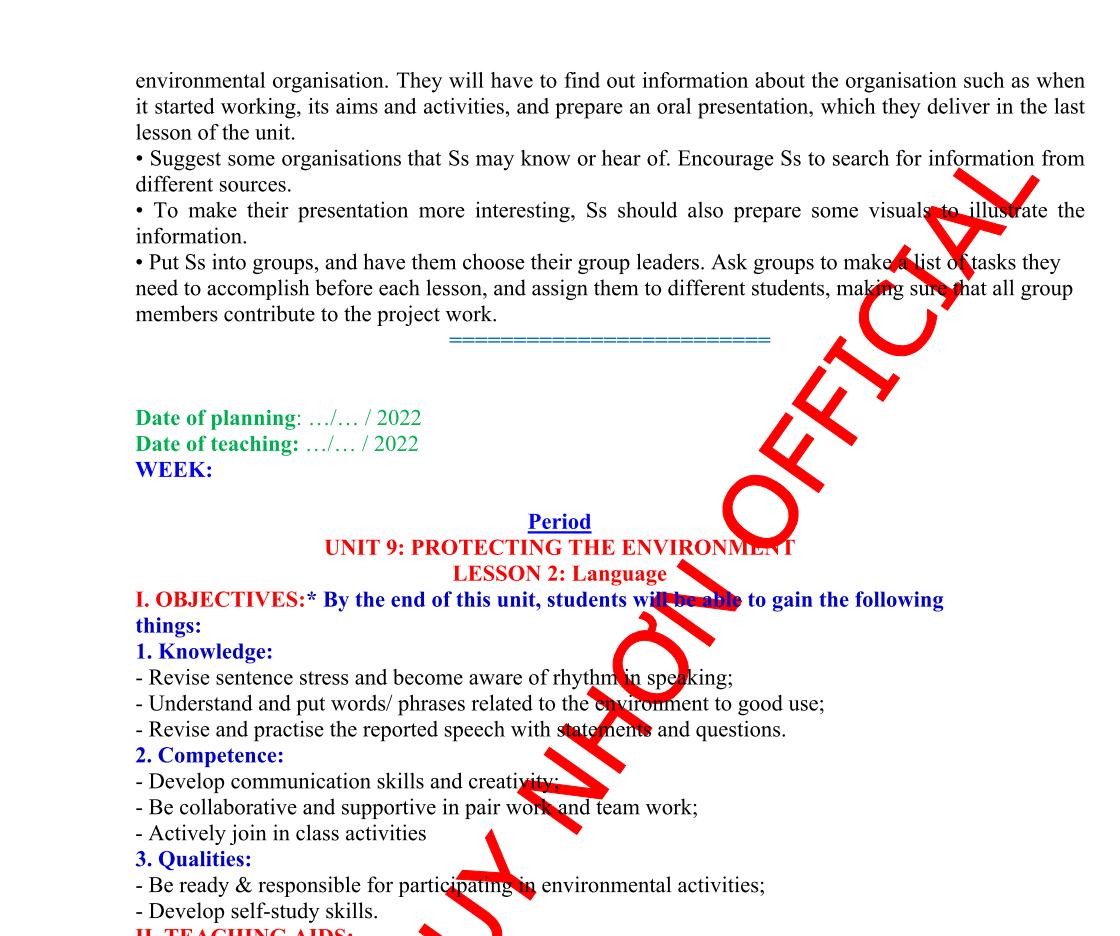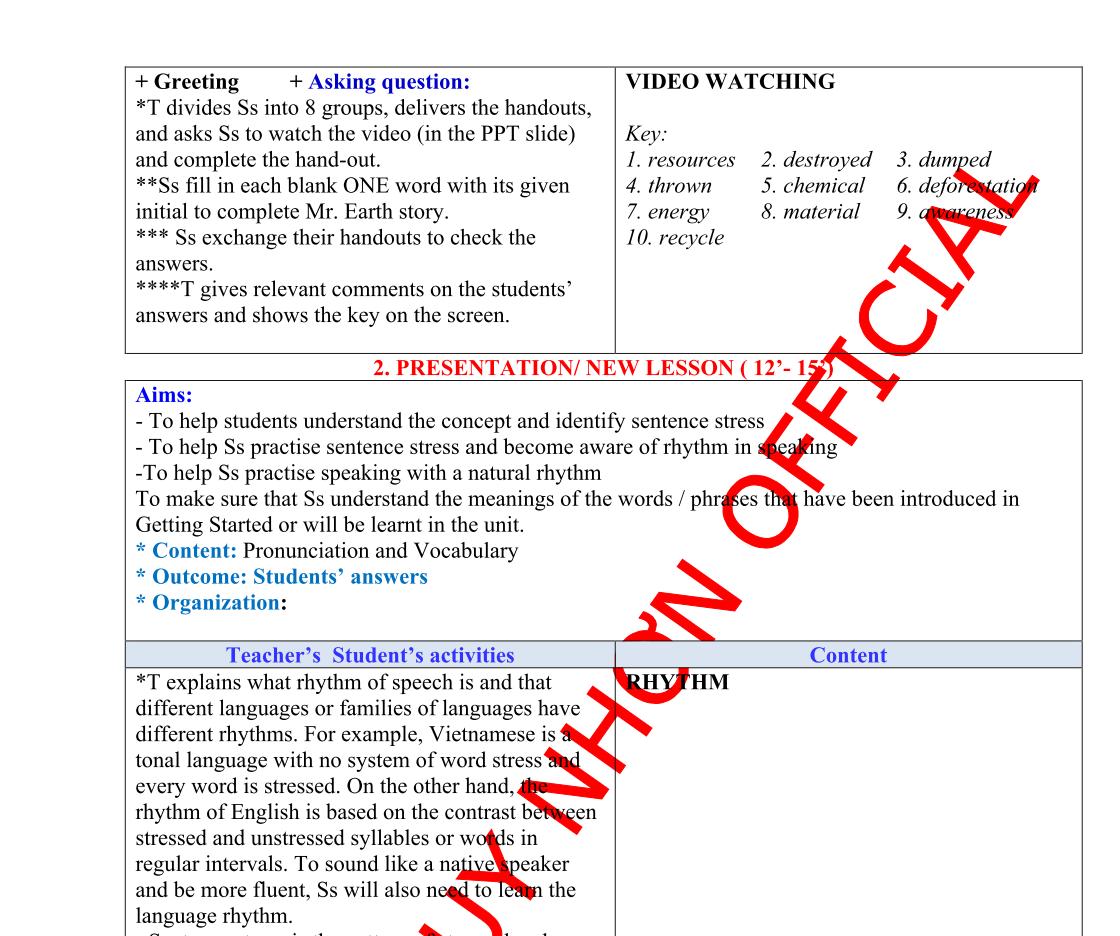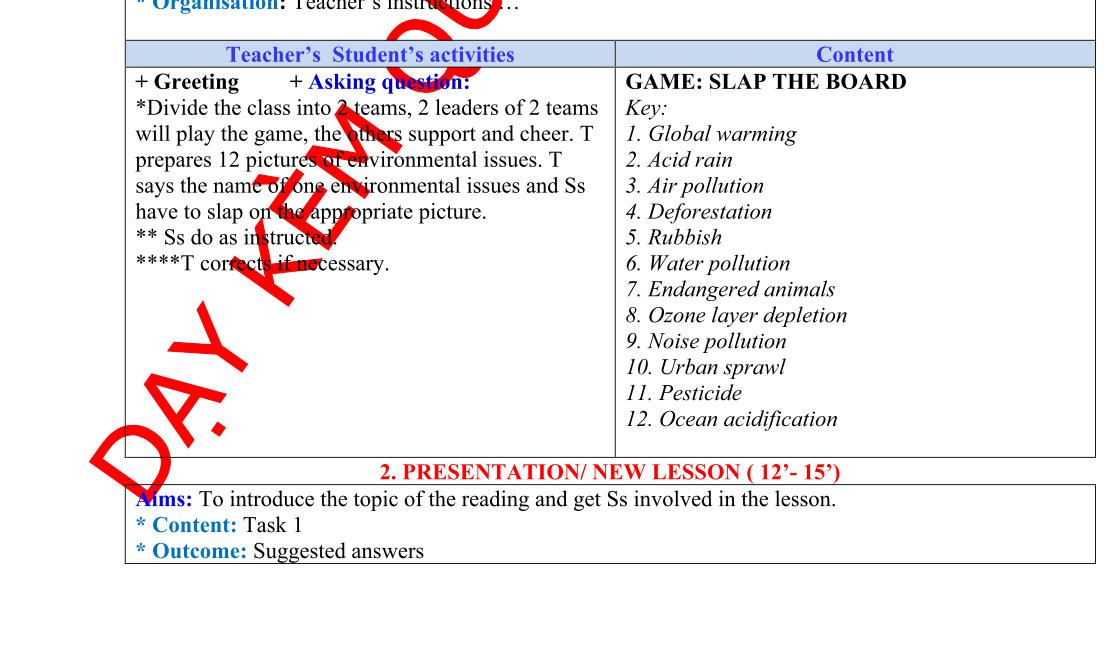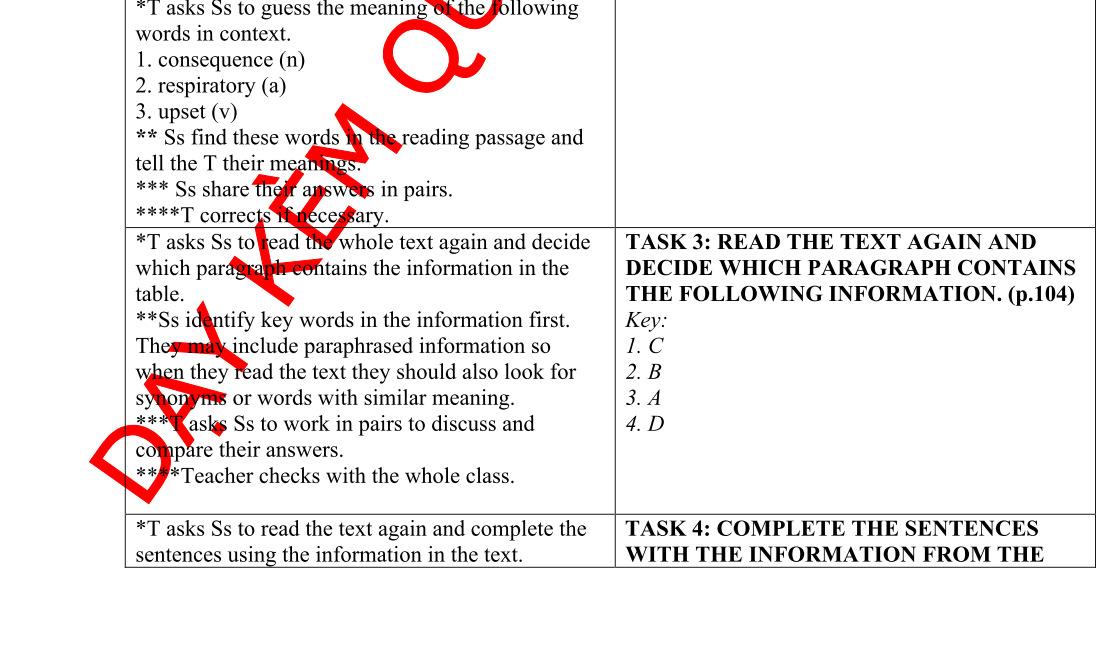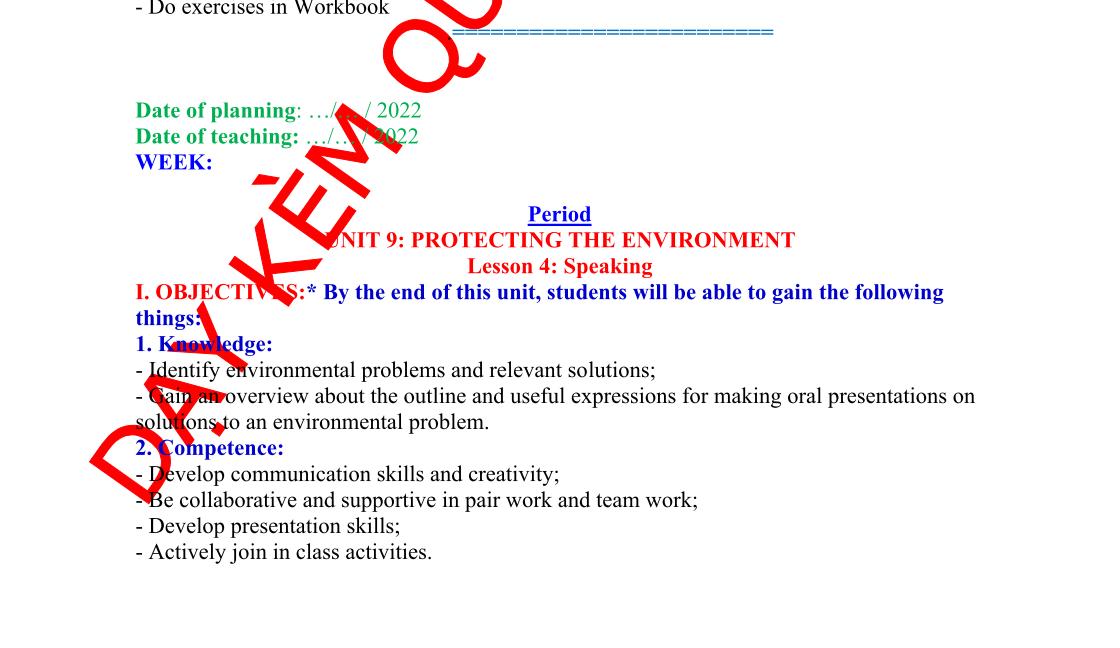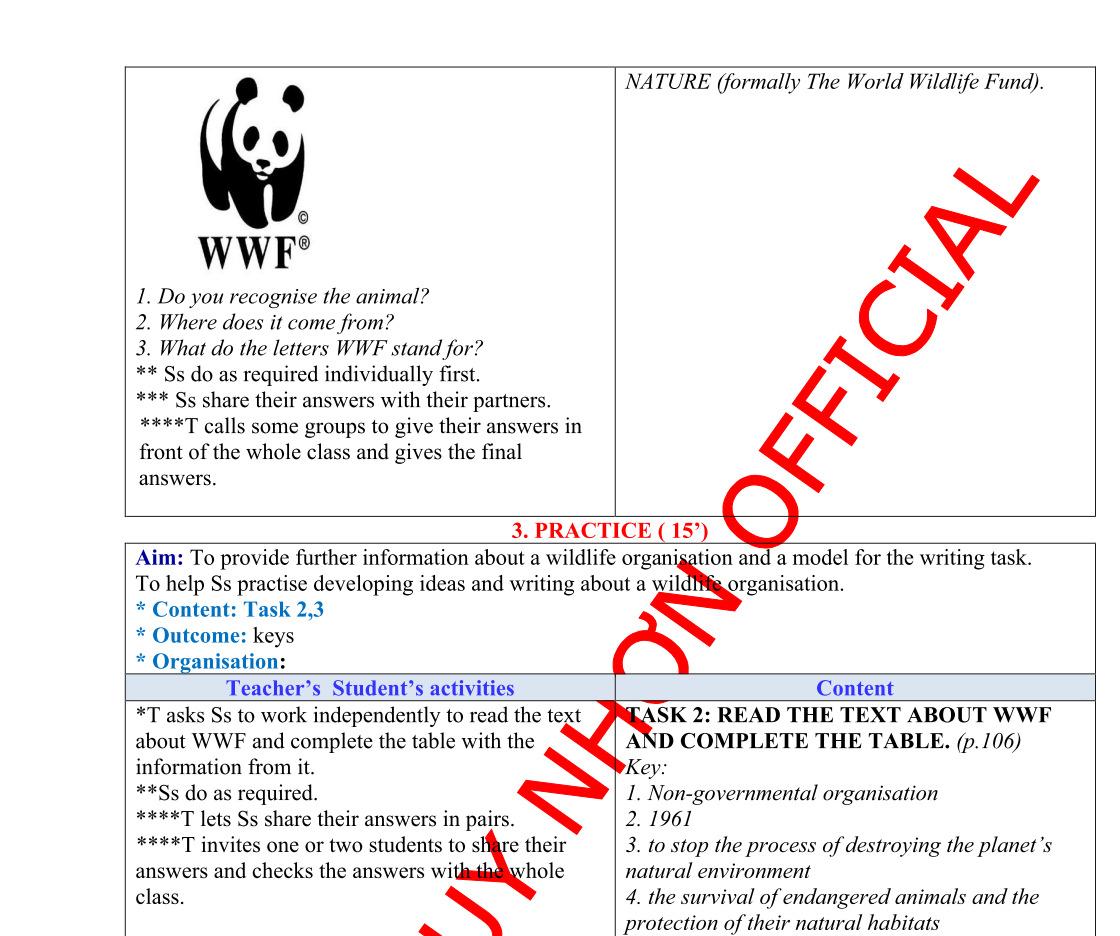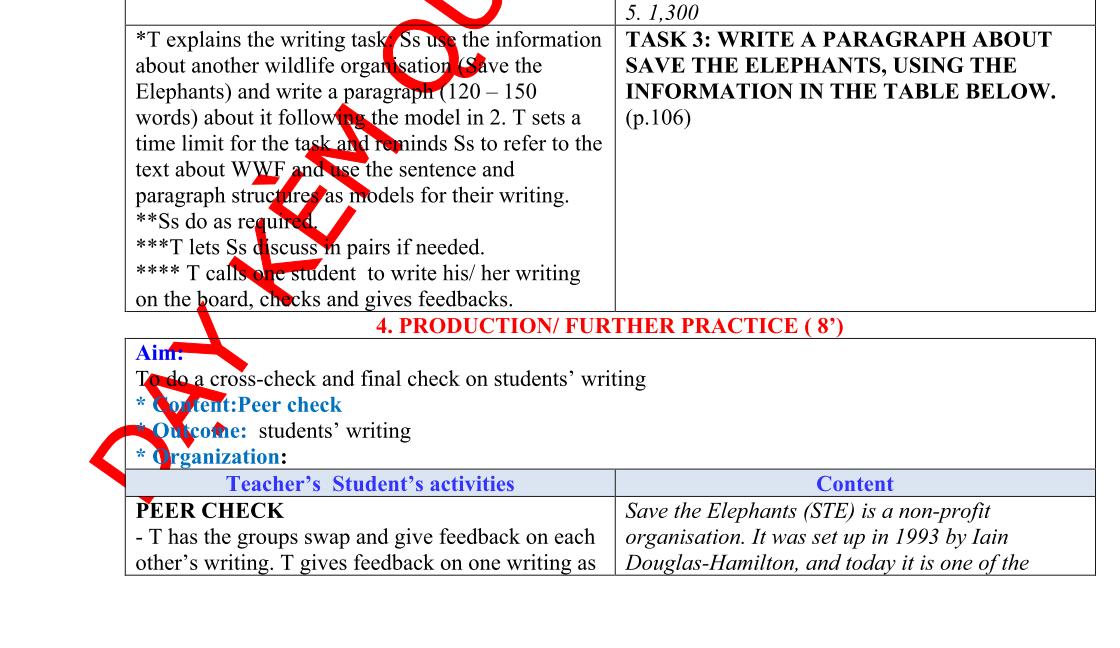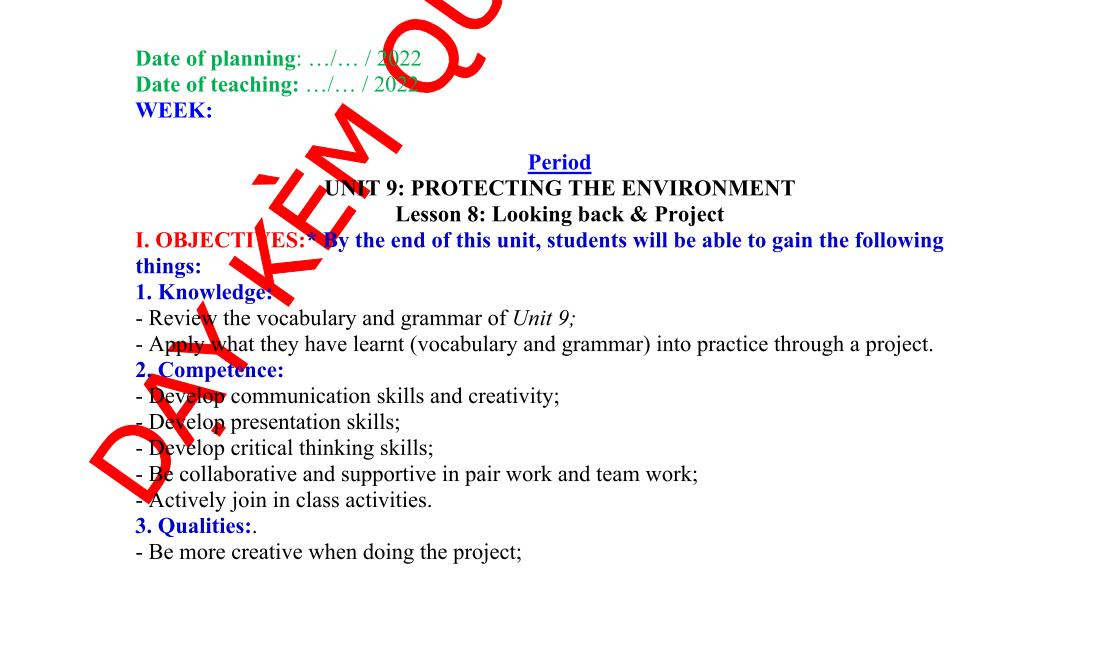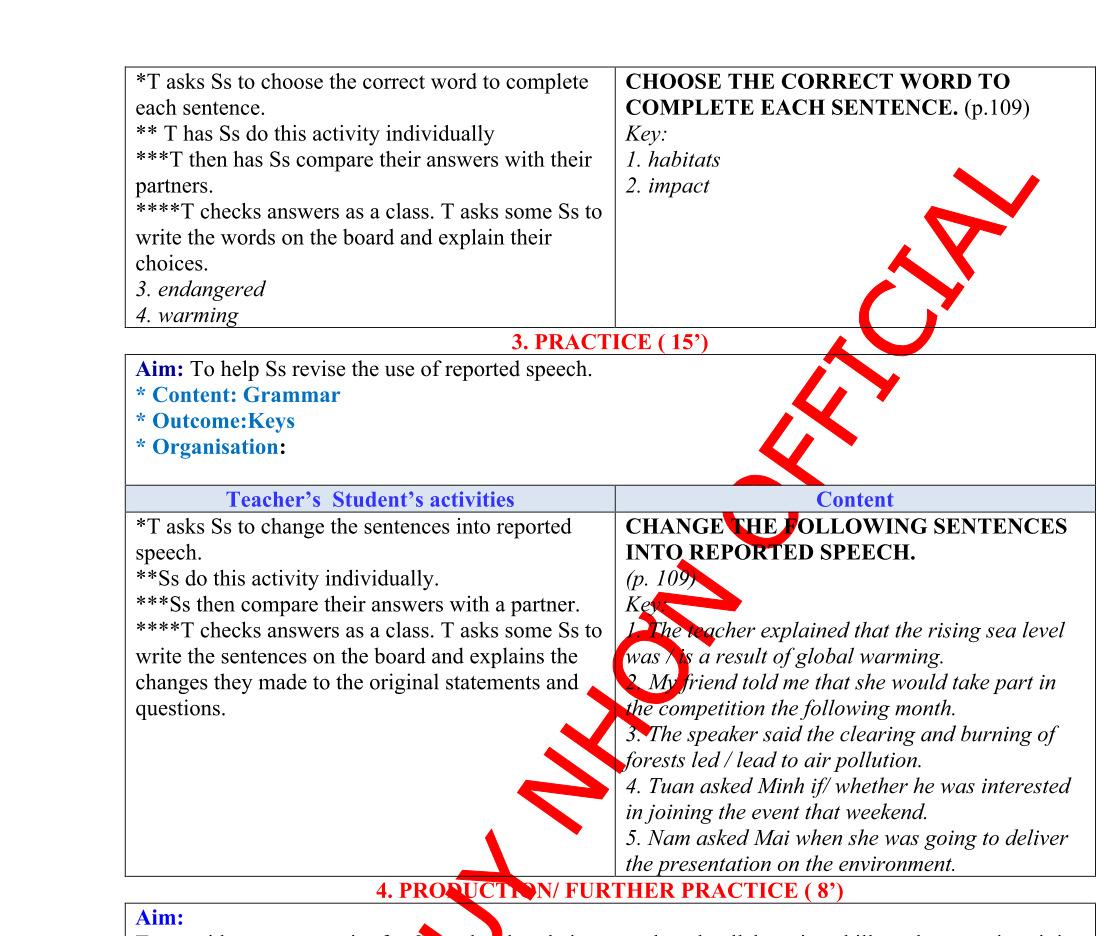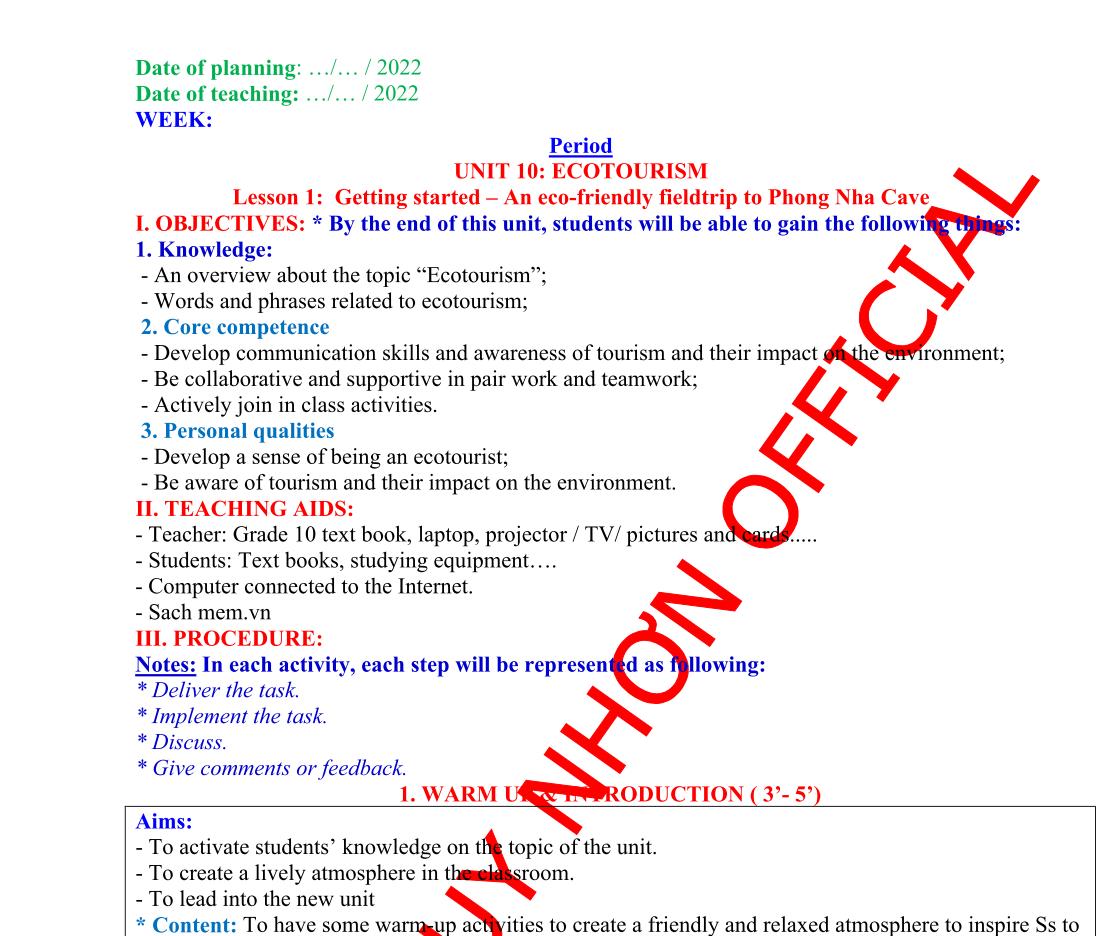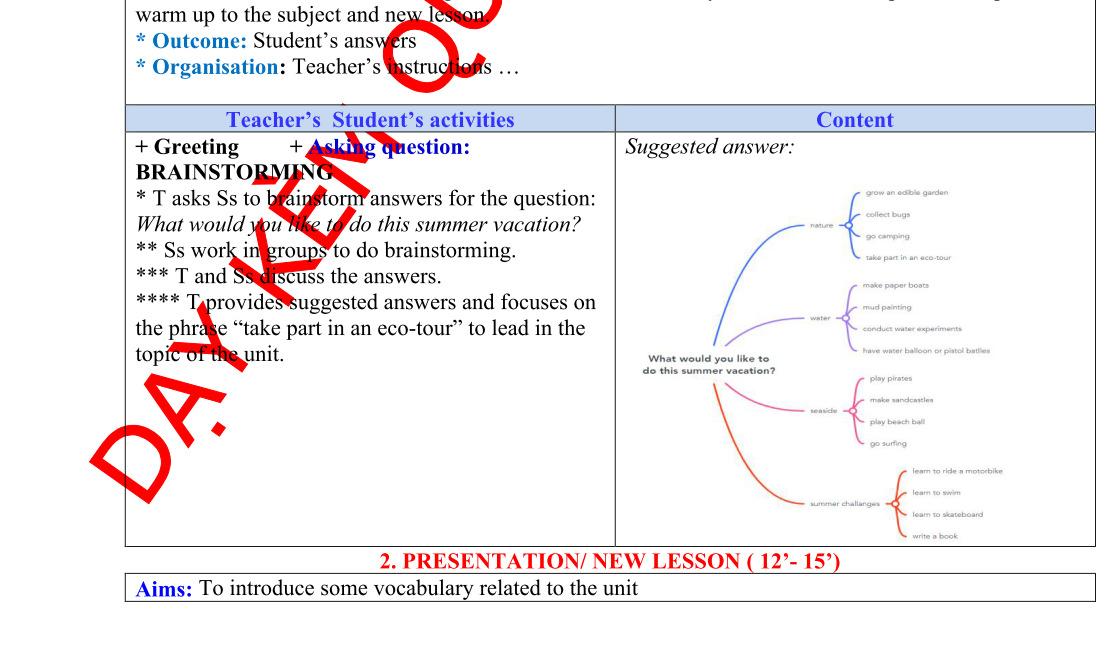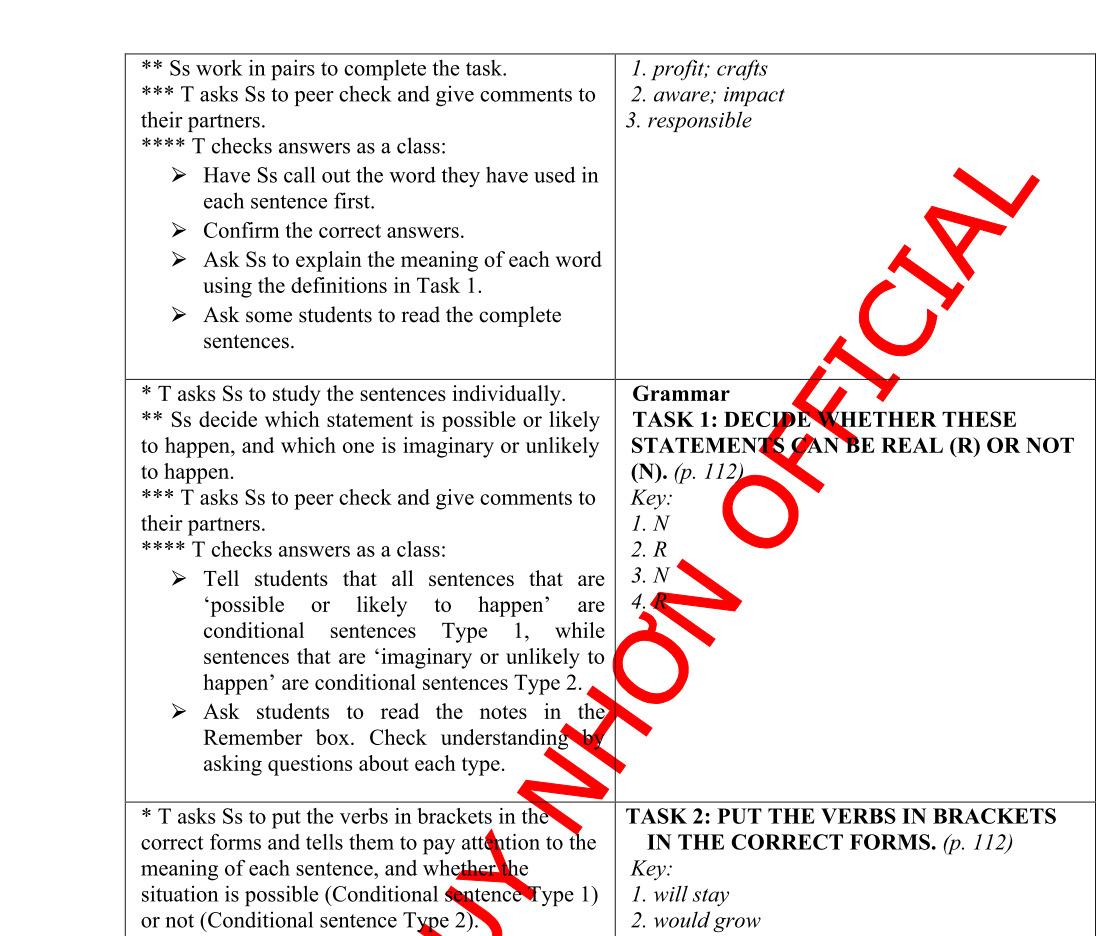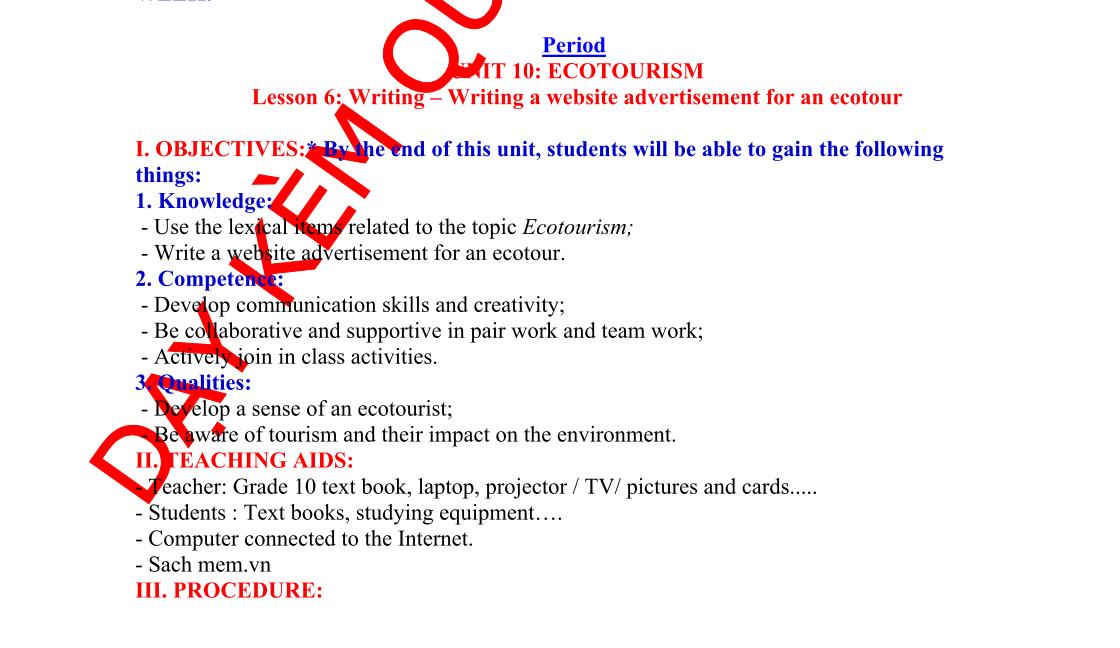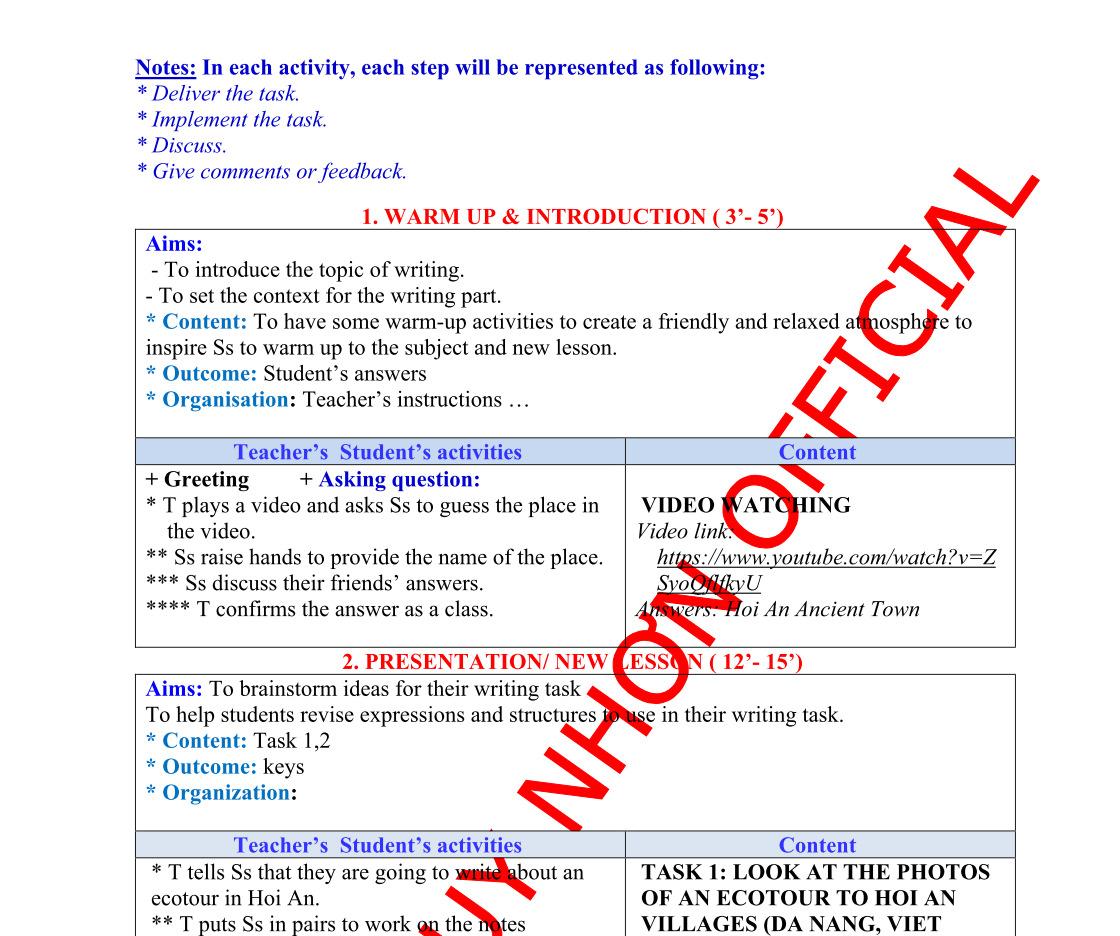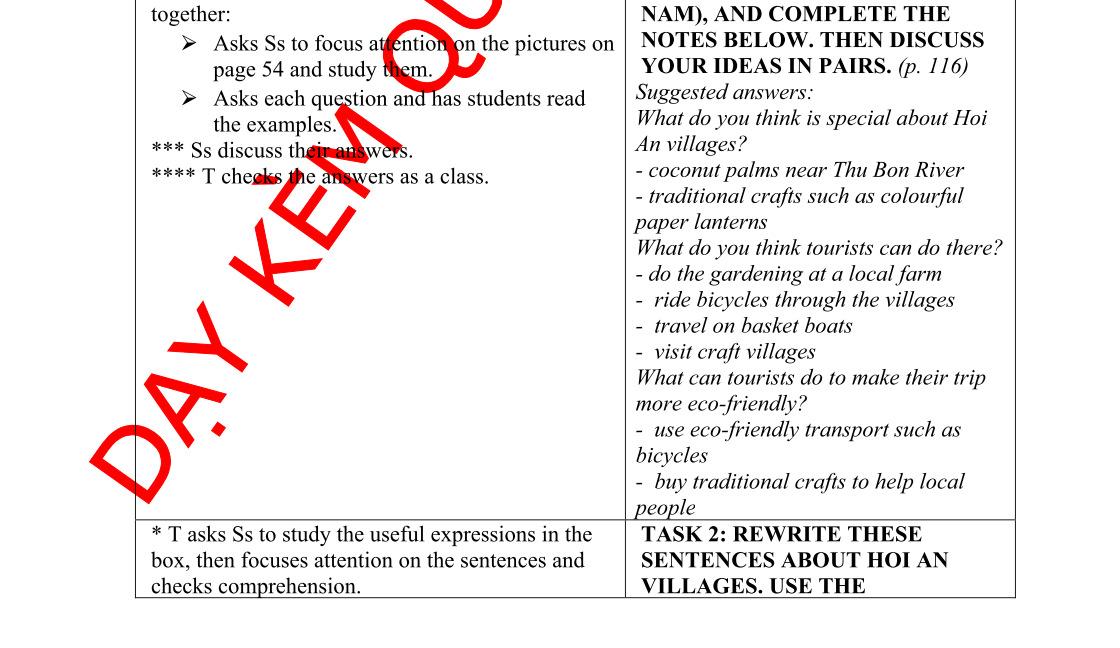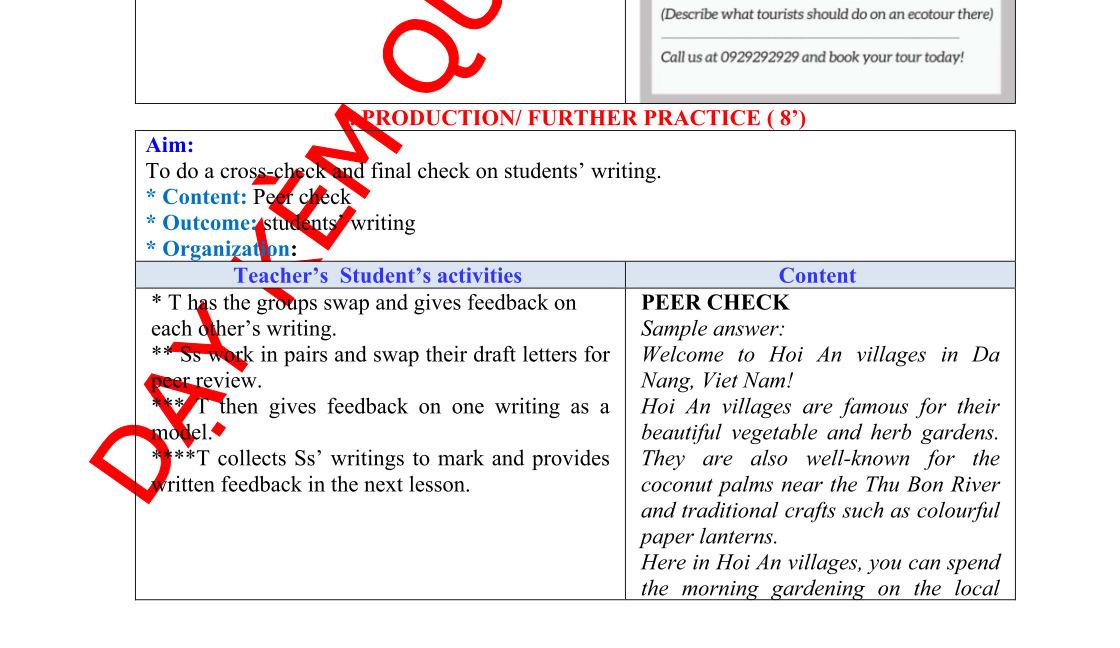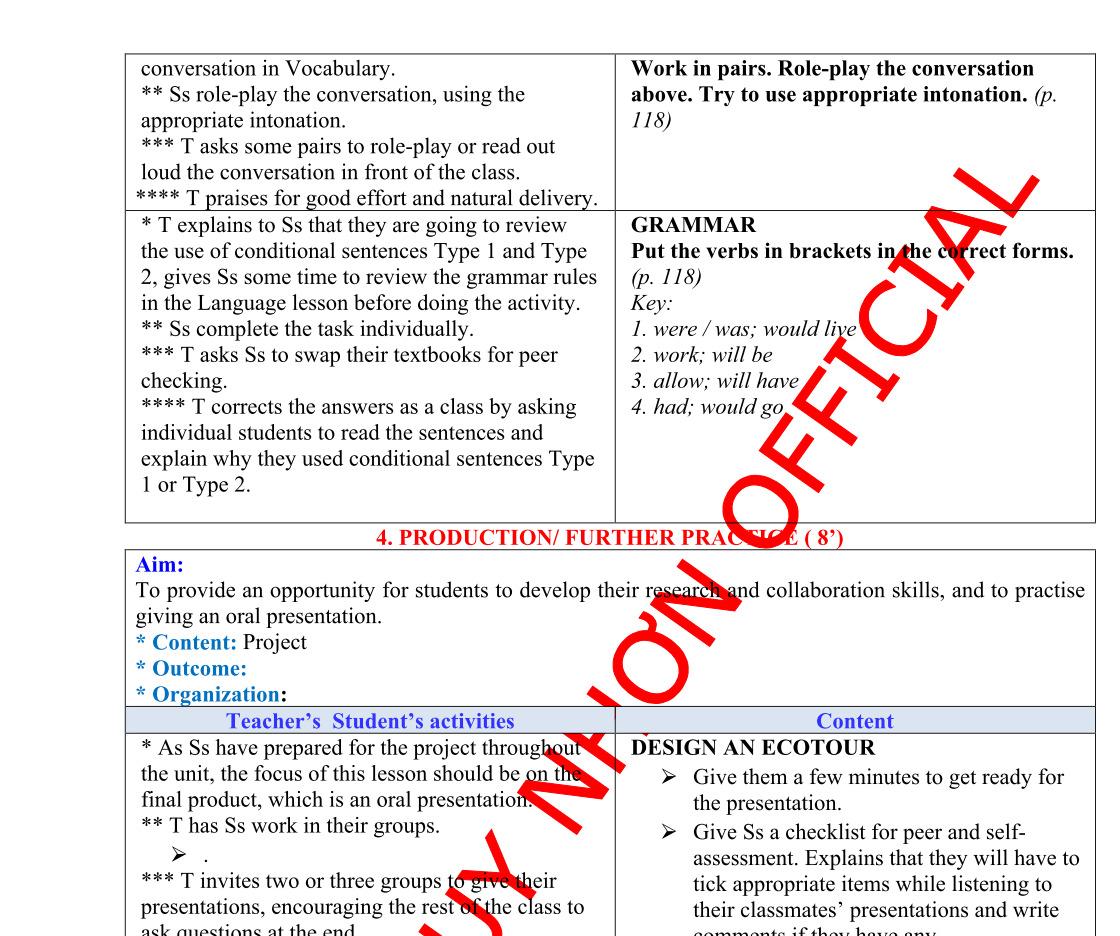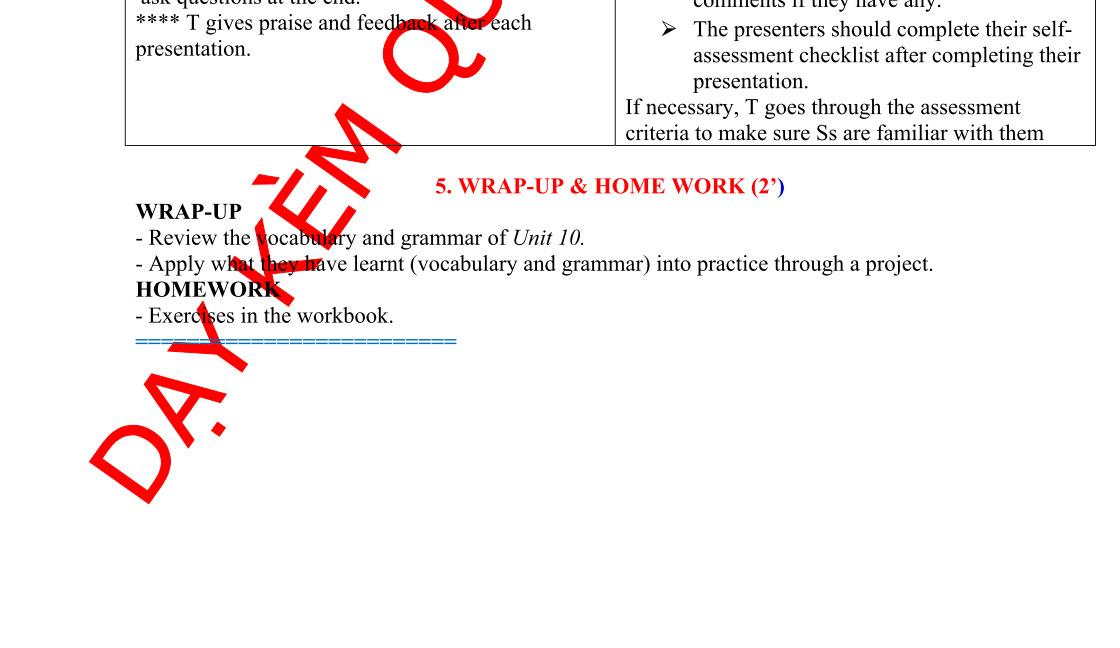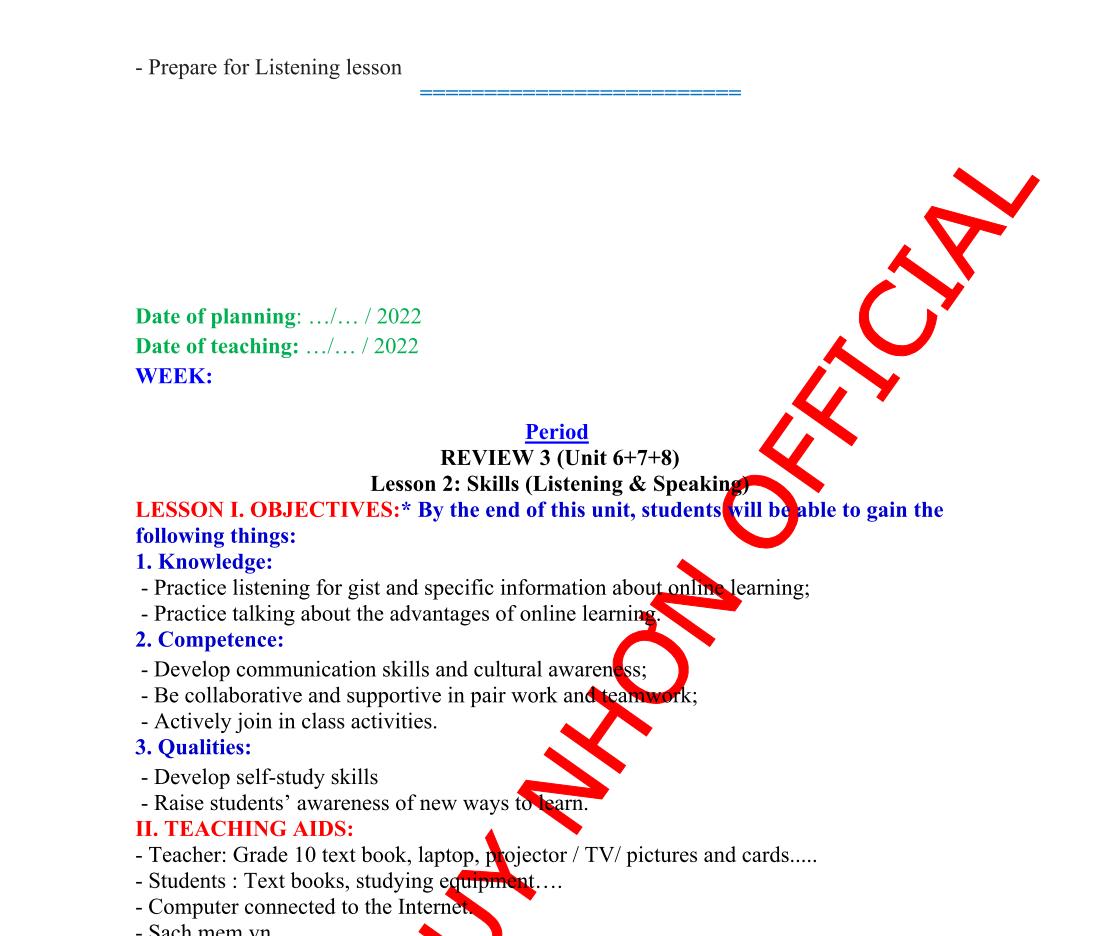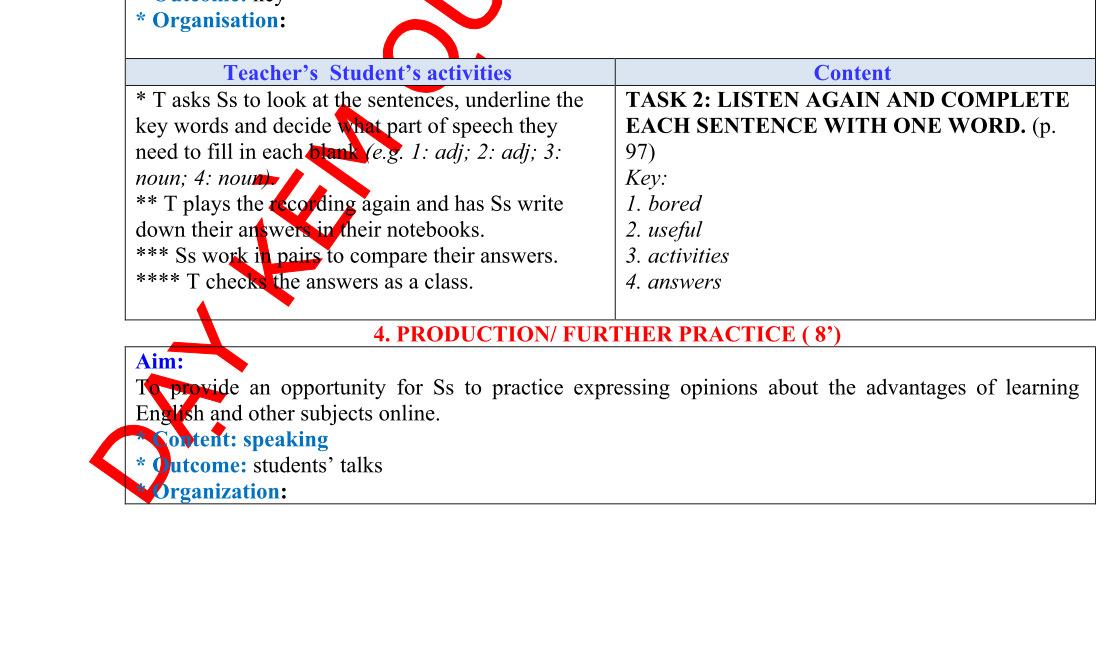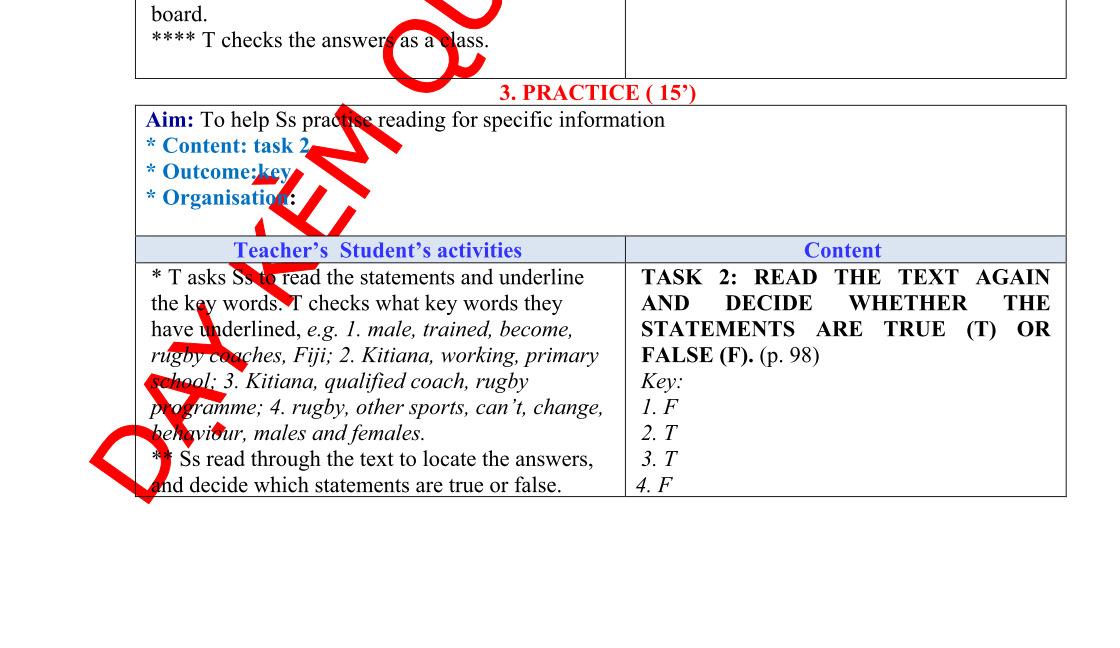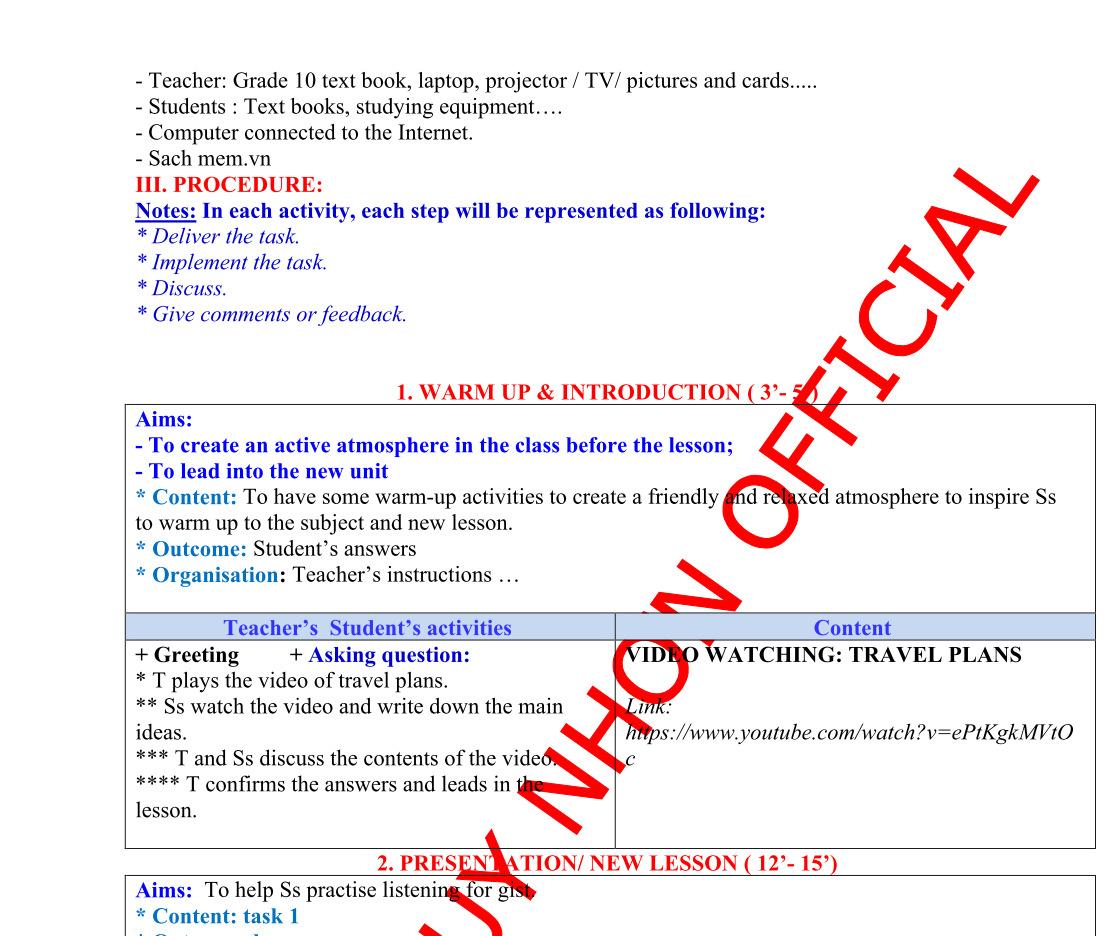

GIÁO ÁN MÔN TIẾNG ANH LỚP 10 GLOBAL SUCCESS (CẢ NĂM) THEO CÔNG VĂN
(2 CỘT) NĂM HỌC 2022-2023
VERSION | 2023 EDITION ORDER NOW / CHUYỂN GIAO QUA EMAIL TAILIEUCHUANTHAMKHAO@GMAIL COM GIÁO ÁN TIẾNG ANH GLOBAL SUCCESS Ths Nguyễn Thanh Tú eBook Collection Hỗ trợ trực tuyến Fb www.facebook.com/DayKemQuyNhon Mobi/Zalo 0905779594 vectorstock com/7952556 Tài liệu chuẩn tham khảo Phát triển kênh bởi Ths Nguyễn Thanh Tú Đơn vị tài trợ / phát hành / chia sẻ học thuật : Nguyen Thanh Tu Group
5512
WORD
Date of planning: …/… / 2022
ENGLISH 10
Date of teaching: …/… / 2022
WEEK : 1
Period 1: INTRODUCTION
INSTRUCTIONS FOR USING TEXTBOOKS, STUDYING MATERIALS
I. OBJECTIVES: By the end of the lesson students will be able to gain the following things:
1. Knowledge:
- To introduce new Tieng Anh 10 textbooks. Student’s book and Workbook
- Tell students something about Great Britain; England and English. Students learn how to study English well and know the way to learn English.

*Vocabulary: Use lexical items related to text book, and the way to learn English in class; at home... some classroom languages.
* Grammar : to be; present simple tense; present continuous…
2. Competence: Students will be able to know how to study English effectively and how to use new Tieng Anh 7 textbooks and know the methods to study new Tieng Anh 10 textbooks.
- Be collaborative and supportive in pair work and teamwork.
- Actively join in class activities
3.Qualities: To teach Ss the love of English; The awareness about importance of learning English. Developing self-study skills.
II. TEACHING AIDS:
- Teacher: Grade 10 textbook, laptop, projector / TV/ pictures and cards.....
- Students : Text books, studying equipment….
- Computer connected to the Internet.
- Sach mem.vn
III. PROCEDURE:
Aims:
1. WARM UP & INTRODUCTION ( 3’- 5’)
- To create a friendly and atmosphere in the class before the lesson;
- To give T and Ss a chance to introduce themselves;
- To lead into the unit
* Content: Have some warm-up activities to create a friendly and relaxed atmosphere to inspire Ss to warm up to the new class.
* Outcome: Having a chance to speak English and focus on the topic of the lesson..
* Organisation: Teacher’s instructions…
Teacher’s & Student’s activities Content
+ Greeting
+ Chatting
- Teacher (T) introduces himself/ herself
- T may introduce some warm-up activities to creat a friendly and relaxed atmosphere to inspire Ss to warm up to the new class…
- Have Ss to introduce themselves.
+ Greeting + Chatting. T_Ss
- Students (Ss) listen and learn how to introduce themselves.
DẠYKÈMQUYNHƠNOFFICIAL
- Introduce themselves (name; age; address; likes; dislikes ….friends… )
Page 1 | 17
- T encourages Ss to talk in English as much as possible
+ Students (Ss) listen and learn how to do the tasks.
- Answer the teacher’s questions
+ Lead to the first unit of the new school year.
- Write the unit title on the board and ask Ss guest what they are going to learn this unit …
- Ask Ss to open their book and introduce what they are going to study….
- Open their book and write .
2. NEW LESSON (12’-15’)
Aims: - To set the context for the introductory;
- To introduce the topic of the unit, the vocabulary, and the grammar points to be learned. * Content: Some brief notes; Something about England, English. Introduce New ENGLISH 10 * Outcome: Ss learn something about England, English; Learn how to use New ENGLISH 10 * Organisation: Teacher’s instructions….
Teacher’s & Student’s activities Content
1. T. asks sts some questions about England.
- What do you know about England?
- T. gives sts something about England and English.
- It located in North-west coast of Europe with very mild weather not too hot but not too cold.
- It consists of four parts: England, Wales, Scotland and Ireland.
- It’s official name is the UK
- Each part has its own flag of UK.
2. English:
- How many people speak English as their mother tongue?
- How many people speak English as their first language?
- How many people speak English as their second language or first foreign language?
- Why do you learn English?
- Is it important? Difficult? Useful? Interesting?
=> It’s very important, useful, interesting. It is the means of communication to one another.
3/ New English 10 text book:
- How many units are there in English 7 text book?
- What are they about?
There are 10 main units in the Student's Book. Each unit has 8 sections and provides language input for seven classroom lessons of 45 minutes each...At the beginning of each unit, there are explicit learning objectives that clearly state the main language points and skills to be taught in the unit.
- Section 1 : GETTING STARTED.
It begins with a conversation followed by activities which introduce the topic of the unit. It then presents the vocabulary and the grammar items to be learned and practised through the skills and activities of the unit.
- Section 2: LANGUAGE FOCUS .
- T_Ss
- Listen carefully and read aloud.
- Fulfill teacher’s requirements
- Give the answers
- Ss answer if possible
- Listen carefully and read aloud.
- Find out the words related to the topic.
- There are many interesting things of England and you’ll gradually know about them in the progress of learning English.
2/ Introduction: English is an international language. Hundreds of million people speak English in the world. 400 million people speak English as their first language, 600 million people speak English as their second language or first foreign language. 4/5 of the world’s computers use program in English. ¾ of all international correspondence is in English.
3/ English 10 has 10 Units.
- T_Ss
- Each unit has 8 lessons.
- SECTION 5: LISTENING
The listening activity follows the oral practice in the Speaking section. It provides students with an opportunity to listen to the language that they have practised orally, and trains them to listen for general and specific information
This section aims to provide further practice to support students in their spoken English....
- SECTION 6: WRITING.
Writing
DẠYKÈMQUYNHƠNOFFICIAL
This section focuses on developing students'writing skills. It normally involves one of the text types required for students' skill development.
Page 2 | 17
This section deals with the main grammar point(s) of the unit. The new language point(s) taught in this section is / are already introduced in Getting Started. The exercises are well illustrated to help students remember and use the grammar items effectively. The Remember! boxes appear wherever necessary to give the rules or explanations and help students avoid common errors.
SECTION 7: COMMUNICATION AND CULTURE
It also gives students opportunities to learn and apply the cultural aspects of the language learnt to their lives and provides cultural information about Viet Nam and other countries.
This section presents and practises the grammar, vocabulary and pronunciation of the unit. The active vocabulary of the unit is given in an interesting and illustrated way so that it is easy for students to memorise. Two sounds, which appear frequently in the unit, are given and practised in isolation and in context. Stress pattern of two-syllable words, threesyllable words, and rising and falling intonation for questions are also dealt with in the last units of the book. There are different exercises focusing on intensive practice of vocabulary and pronunciation.
- SECTION 3:
READING.
This section is designed to help students inprove reading skill, use vocabulary in the situations, Reading and this section aims to develop students' reading abilities. The reading text is often based on the vocabulary and structures that students have previously acquired to make the activity achievable.
Speaking
- SECTION 4:
SPEAKING
This section is designed to help students use functional language in real life contexts and consolidate what they have learnt in the previous sections.
Everyday English in this section gives students the skills to communicate effectively in various everyday situations...
- SECTION 8: LOOKING BACK
Looking Back recycles the language from the previous sections and links it with the unit topic. Its activities and exercises are designed to help students consolidate and apply what they have learnt in the unit. Teachers can use this section to evaluate their students' performance and provide further practice if necessary.
The Project activity helps students improve their ability to work independently and in a team. It extends their imagination in a field related to the unit topic.
* English is not too difficult but it requires you hard working.
- Ss need learn by heart all vocabulary and their usage.
- Review the lesson everyday.
- Learn English everyday.
3. PRACTICE (15’)
Aims: To help Ss understand the lesson. Class room language
* Content: Some brief notes; Something about England, English. Classroom language…
* Outcome: Ss learn something about England, English; Classroom languages…
* Organisation: Teacher’s instructions….
Teacher’s & Student’s activities Content
3. How to learn English best?
- Tell us how you learn best?
- Tell us how you can learn English best?
* Some useful classroom languages:
- Who is the monitor?
- Who is absent today?
- Who is on duty today?
- May I go out?
- May I come in?.......
- How to improve your English:
- Listen to the teacher carefully, learn E. from many sources, always enrich your vocabulary, do exercises
- T_Ss
- Listen carefully
- Practice saying classroom languages.
- Work in groups; in pairs; present the projects….
DẠYKÈMQUYNHƠNOFFICIAL
Page 3 | 17
carefully, practice speaking, listening, writing, reading everyday. …
- Ss should work hard everyday to improve their English.
“ Hard work is the key to success”
4. PRODUCTION/ FURTHER PRACTICE (8’)
Aims: To revise / teach classroom languages.
* Content: Some brief notes; Something about England, English . Classroom languages…
* Outcome: Ss know something about England, English; Classroom languages…
* Organisation: Teacher’s instructions….. Teacher’s & Student’s activities
- T_Ss
- T gives some questions to introduce the class expressions.
- Have Ss listen and repeat.
- Teacher says “ go out, please” Go out
- Teacher says “No” Don’t go out
- Call on some pairs to practice in front of the class.
Content
- The greetings : - Goodmorning
- Good afternoon
- Good morning
- Good bye ….
- We can say “May I go out”
- You can say “Stand up, please.
- Listen, please
- Read after me
- Repeat please…..
5. WRAP-UP & HOME WORK (2’)
* Instruct/ guide students to do their homework.
- Prepare textbook, workbook, exercise book,
* HOME WORK
- Learn classroom languages.
- Prepare new lesson Unit one FAMILY
DẠYKÈMQUYNHƠNOFFICIAL
Page 4 | 17
==============================
Date of planning: …/… / 2022
Date of teaching: …/… / 2022
ENGLISH 10
WEEK : 1
Period 2
UNIT 1: MY FAMILY LESSON 1. GETTING STARTED
I. OBJECTIVES: * By the end of this unit, students will be able to gain the following things:
1. Knowledge:
- an overview about the topic Family life;
- vocabulary to talk about household chores.
2. Competence:
- develop communication skills;
- be collaborative and supportive in pair work and teamwork;

- actively join in class activities.
3. Qualities:
- be aware of responsibilities towards family,love family, help parents…
II. TEACHING AIDS:
- Teacher: Grade 10 text book, laptop, projector / TV/ pictures and cards....
- Students: Text books, studying equipment….
- Computer connected to the Internet.
- Sach mem.vn
III. PROCEDURE:
Notes: In each activity, each step will be represented as following:
* Deliver the task.
* Implement the task.
* Discuss.
* Give comments or feedback.
Aims:
1. WARM UP & INTRODUCTION ( 3’- 5’)
- To create an active atmosphere in the class before the lesson;
- To lead into the new unit
* Content: To have some warm-up activities to create a friendly and relaxed atmosphere to inspire Ss to warm up to the subject and new lesson.
* Outcome: Introducing themselves to make more new friends.
* Organisation : Teacher’s instructions … Teacher’s Student’s activities Content
+ Greeting + Asking question:
* T divides Ss into 4 groups and gives instructions: Watch the video clip and try to remember all the household chores Mr. Bean did in the video. One person from each group then goes to the board and writes the names of the chores.

** Ss do as instructed.
*** Ss work in pairs to discuss the answer after watching the clip, then one representative from each group writes the answer on the board.
**** T confirms the correct answers.
GAME: LET’S RACE!
DẠYKÈMQUYNHƠNOFFICIAL
Page 5 | 17
Suggested answer:
1. Mop the floor
2. Clean the toilet
3. Wash the clothes / Do the laundry
4. Clean the house
5. Vacuum the carpet
2. PRESENTATION/ NEW LESSON ( 12’- 15’)
Aims: - To help students use key language more appropriately before they read and listen.
* Content: Learn some new words in context. Read the conversation and find out new words.
* Outcome: Practice reading the conversation. Knowing more new words. Understanding the conversation; topic of the lesson, grammar points…
* Organisation:
Teacher’s Student’s activities Content
* T asks Ss to look at the photos to guess the meaning of new words.
** Ss say the Vietnamese meaning of the word.
*** Other Ss correct if the previous answers are incorrect.
**** T shows the Vietnamese meaning, says the words aloud and asks Ss to repeat them.
VOCABULARY GETTING STARTED
1. sports fiel /ˈ spɔːts fiːld/ (n/p): sân chơi thể thao
2. prepare /prɪˈpeə(r)/ (v): chuẩn bị
3. help with something /help wɪð ˈ sʌmθɪŋ/ (v.phr): giúp
làm việc gì đó
4. divide /dɪˈvaɪd/ (v): phân chia
5. household chores /ˌhaʊshəʊld tʃɔː(r)z/ (n.phr): công
việc nhà
6. homemaker /ˈhəʊmmeɪkə(r)/ (n): nội trợ
7. breadwinner /ˈbredwɪnə(r)/ (n): trụ cột gia đình
8. earn money /ɜːn ˈ mʌni/ (v.phr): kiếm tiền
9. equally /ˈiːkwəli/ (adv): một cách công bằng, bình
đẳng
10. shop for groceries /ʃɒp fɔː(r) ˈɡrəʊsəri/ (v.phr): mua thực phẩm
11. do the laundry /duː ðə ˈlɔːndri/ (v.phr): làm công việc giặt giũ
12. do the washing-up /duː ðə ˌ wɒʃɪŋ ˈʌp/ (v.phr): rửa chén / bát
13. put out the rubbish /pʊt aʊt ðə ˈ rʌbɪʃ/ (v.phr): vứt rác
3. PRACTICE ( 15’)
Aim: - To get students interested in the topic.
- To get students to learn some vocabulary in the unit.
* Content: Listen and read the conversation. True/ False activity.
* Outcome: Know more new words. Understanding the conversation; topic of the lesson, vocab.
* Organisation : Teacher’s Student’s activities Content
* T asks Ss to look at the picture (p.8 - 9) and answer the questions:
TASK 1. LISTEN AND READ (p.8)
DẠYKÈMQUYNHƠNOFFICIAL
Who are they?
Where are they?
Page 6 | 17
** Ss do the task individually
*** Ss share their answers with a partner.
What are they doing?
**** T checks their answers with the whole class.
* T has the Ss read the conversation in pairs.
** Ss read the conversation
*** One pair reads aloud.
**** T collects common mistakes and gives comments.
Suggested answers: Nam and Minh are two friends. They are at Nam’s home. Nam is cooking.

Aim: To practise reading for specific information
- To practise scanning
- To develop students' knowledge of vocabulary for household chores
* Content: Name the picture, then listen, check and repeat.
* Outcome: Ss understand more the use some vocabulary related to hobbies.
* Organisation :
* T asks Ss to work individually to read the statements and underline the key words, then share their ideas with a partner who sits next to them.
** Ss do Task 2 individually first.
*** Ss share and discuss with their partners about the key words
* T asks Ss to scan the conversation, locate the key words to find the answer for each the question with the partner who sits behind them
** Ss do the task in pairs.
**** T has Ss share their answers with the class. T confirms the correct answers and have Ss correct the false statement. T writes the correct sentence on the board.
TASK 2: TRUE OR FALSE
Read the conversation again and decide whether the following statements are true (T) or false (F). (p.9)
1. Nam’s mother is cooking now.
2. Everybody in Nam’s family does some of the housework.
3. The children in Minh’s family don’t have to do any housework.
DẠYKÈMQUYNHƠNOFFICIAL
Page 7 | 17
****
Key: 1. F → Nam is cooking
2. T 3. T :
now.
Aim: To help students identify present simple and present continuous and how they are used in sentences
* Content: To work in pairs..
* Outcome: Ss know how to write the verbs/verb phrases that are used with the words or phrases in the conversation in 1
* Organisation :
* T has Ss locate the verbs or phrasal verbs in the conversation, find the nouns or noun phrases after each verb/ phrasal verb to do the matching.
** Ss work individually
*** Ss share their answers with a partner
**** T checks and gives the correct answers with the whole class, and has them say the meaning of each collocation.
* T has Ss read each sentences, try to think of a verb or an auxiliary verb that will complete the gap.
** Ss do the task individually
*** Ss share the answers with a peer.
**** T asks the whole class to call out the verb forms first, then calls on individual students to read the complete sentences.
TASK 3: FILL IN THE TABLE
Write the verbs/verb phrases that are used with the words or phrases in the conversation in 1. (p.9)
Answers:
1. put out the rubbish
2. do the laundry
3. shop for groceries
4. do the heavy lifting
5. do the washing-up
TASK 4: COMPLETE THE SENTENCES.
Complete the sentences from the conversation with the correct forms of the verbs in brackets. (p.9)
Answers:
1.‘m preparing
2.does – ‘s working
4. PRODUCTION/ FURTHER PRACTICE ( 8’)
Aim: To help students practise talking about activities which raise students’ awareness of their responsibilities.
- To practise teamworking.
- To give students authentic practice in using target language.
* Content: Play game.
* Outcome: talk about activities which raise students’ awareness of their responsibilities.
* Organisation :
Teacher’s Student’s activities Content
* T gives Ss clear instructions in order to make sure Ss can do effectively.
- Divide Ss into 4 main groups .
- Ask Ss to work in groups to discuss and make a poster of activities to raise Ss' awareness of their responsibilities towards their family.
- Observer Ss while they are discussing, note their language errors
** Ss do as instructed
**** T gives Ss feedback.
- Choose some useful or excellent words/ phrases/ expressions/ word choices Ss have used to give suggestions to other students.
- Choose some typical errors and correct as a whole class without nominating the Ss’ names.
TASK 5: MAKE A POSTER!
Think about activities which you can do to raise other students' awareness of their responsibilities towards their family.
DẠYKÈMQUYNHƠNOFFICIAL
Page 8 | 17
5. WRAP-UP & HOME WORK (2’)
To help students memorise the target language and skills that they have learned To inform students what the final product of the project should be and how students can prepare for it
WRAP-UP
* T asks Ss: What have you learnt today?
- Some lexical items about household chores
- Reading for specific information
- Scanning
HOMEWORK
1. Exercises in the workbook
2. Project preparation
- Have Ss look at the last page of Unit 1, the Project lesson and ask them what topic of the project is.
- Tell them the project requirements: Do research on Family Day in Viet Nam or other countries in the world + suggest activities, provide the reasons and expected results of the activities; + present their plans in the last lesson of the unit.
- Remind Ss that besides brainstorming activities, they: + can search for ideas on the Internet, in the newspaper, etc. for reference. + should use photos/pictures to illustrate their ideas.
- Put Ss into groups and have them choose their group leader. Ask them to assign tasks for each member, making sure that all group members contribute to the project work.
- Help Ss set deadlines for each task.
DẠYKÈMQUYNHƠNOFFICIAL
Page 9 | 17
=========================
Date of planning: …/… / 2022
Date of teaching: …/… / 2022
ENGLISH 10
WEEK : 1
Period 3
UNIT 1: MY FAMILY LESSON 2. LANGUAGE
KHUNG
I. OBJECTIVES: * By the end of this unit, students will be able to gain the following things:
1. Knowledge: By the end of this lesson, Ss will be able to:
1. Knowledge
- Pronounce the consonant blends /br/, /kr/, and /tr/ correctly in individual words and in sentences;
- Understand and use some lexical items about family life;
- Distinguish and use present simple and present continuous.
2. Core competence
3. Personal qualities
2. Competence:
- Be collaborative and supportive in pair work and team work
- Access and consolidate information from a variety of sources

- Actively join in class activities
3.Qualities:
- Be aware of responsibilities towards family
II. TEACHING AIDS:
- Teacher: Grade 10 text book, laptop, projector / TV/ pictures and cards.....
- Students : Text books, studying equipment….
- Computer connected to the Internet.
- Sach mem.vn
III. PROCEDURE:
Notes: In each activity, each step will be represented as following:
* Deliver the task.
* Implement the task.
* Discuss.
* Give comments or feedback.
Aims:
1. WARM UP & INTRODUCTION ( 3’- 5’)
- To create an active atmosphere in the class before the lesson;
- To lead into the new unit
* Content: To have some warm-up activities to create a friendly and relaxed atmosphere to inspire Ss to warm up to the subject and new lesson.
- * Outcome: arouse the classroom atmosphere to lead in the lesson
* Organisation : Teacher’s instructions …
Teacher’s Student’s activities Content
GAME: Guess the words
* T gives instructions:
DẠYKÈMQUYNHƠNOFFICIAL
• There are 8 pictures related to the topic “Family life”.
• Ss have 5 seconds to think, then guess the
Page 10 | 17
word corresponding to the picture.
**** T counts the points, decides the winner, asks some more questions and leads in the lesson.
+ Correct answer +1
+ Wrong answer -1
2. PRONUNCIATION/ NEW LESSON ( 10’)
Aims: - To help students recognise and practise the consonant blends /br/, /kr/, and /tr/ in words
* Content: Pronunciation
* Outcome: recognise and practise the consonant blends /br/, /kr/, and /tr/ in words
* Organisation:
Teacher’s Student’s activities Content
TASK 1. LISTEN AND REPEAT. Pay attention to the consonant blends /br/, /kr/, and /tr/ (p.9)
* Teacher:
- plays the recording and asks Ss to listen to the words and repeat; tell them to pay attention to the consonant blends. (T can play the recording as many times as necessary)
- makes sure Ss know the meaning of each word. ** Ss do as instructed.
**** Teacher checks whether Ss have improved their pronunciation by randomly calling on individual Ss to read the words aloud.
(Teacher can also play the pronunciation video lesson of this Unit for students to watch before they do the task
1. Listen and repeat. Pay attention to the consonant blends /br/, /kr/, and /tr/. /br/ /kr/ /tr/
breadwinner
breakfast brown
crash crane cream
track tree train
3. PRACTICE ( 10’)
Aim: To help students practise identifying the consonant blends /br/, /kr/, and /tr/ in sentences.
* Content: practise identifying the consonant blends /br/, /kr/, and /tr/ in sentences.
* Outcome: students can identify the consonant blends /br/, /kr/, and /tr/ in sentences.
* Organisation :
Teacher’s Student’s activities Content
TASK 2: LISTEN TO THE SENTENCES AND CIRCLE THE WORDS YOU HEAR. (p.9)
* Teacher:
- asks Ss to read all the words once, paying attention to the different consonant blends in the words in each group; checks that Ss understand what the words mean.
- plays the recording for Ss to listen and circle the words with the consonant blends they hear.
- has Ss work in pairs to compare their answers; checks answers by asking individual Ss to read out the words they have circled.
- plays the recording again, pausing after each sentence, for Ss to repeat.
** Ss do as instructed.
TASK 2: LISTEN TO THE SENTENCES AND CIRCLE THE WORDS YOU HEAR. (p.9)
DẠYKÈMQUYNHƠNOFFICIAL
Page 11 | 17
1. a. brush 2. a. brain 3. a. bread b.
b. crane b. create Key: 1. b 2. c 3. a
crash
*** Ss practise reading the sentences in pairs
**** T goes round to offer help and collect common mistakes to correct as a class.
: Vocabulary: Family life
Aim: To make sure that students understand the meaning of some lexical items about household chores.
* Content: Vocabulary related to Family life
* Outcome: Ss understand more the use some vocabulary related to and students understand the meaning of some lexical items about household chores.
* Organisation :
* T gives clear instructions
** Ss work in pairs to discuss and do the matching
*** Ss share the answers with the whole class.
**** T confirms the correct answer
TASK 1: MATCH THE WORDS WITH THEIR MEANINGS. (p.10)
1. Match the words with their meanings. (Nối các từ với nghĩa của chúng.)
1. breadw inner
2. housew ork
3. groceri es
4. homem aker
5. heavy lifting
a. a person who manages a home and often raises children instead of earning money
b. someone who earns the money to support their family
c. picking up and carrying heavy objects
d. work around the house such as cooking, cleaning or washing clothes
e. food and other goods sold at a shop or a supermarket
Key giải thích
1 - b 2 - d 3 - e
1 – b: breadwinner = someone who earns the money to support their family
(trụ cột gia đình = người kiếm tiền nuôi gia đình)
2 – d: housework = work around the house such as cooking, cleaning or washing clothes
(công việc nhà = công việc xung quanh nhà như nấu ăn, dọn dẹp hoặc giặt quần áo)
3 – e: groceries = food and other goods sold at a shop or a supermarket
(tạp hóa = thực phẩm và các hàng hóa khác được bán tại cửa hàng hoặc siêu thị)
4 – a: homemaker = a person who manages a home and often raises children instead of earning money
DẠYKÈMQUYNHƠNOFFICIAL
(nội trợ = người quản lý nhà cửa và thường nuôi dạy con cái thay vì kiếm tiền)
Page 12 | 17
5 – c: heavy lifting = picking up and carrying heavy objects
(công việc mang vác nặng nhọc = nhặt và mang vật nặng)
Aim: To give students practice in using the words/phrases in meaningful contexts
* Content: Complete the the sentences using the words in task 1
* Outcome: read the sentences carefully and decides which word in task 1 can be used to complete each of the sentences.
* Organisation:
* Teacher:
- has Ss work in pairs; tells them to read the sentences carefully and decides which word in task 1 can be used to complete each of the sentences. T explains that they should use the context clues to decide on the word / phrase, e.g. ‘my mother’ in sentence 1 refers to a person.
- checks answers as a class, then has Ss call out the word they have used in each sentence first.
- confirms the correct answers. T asks Ss to give reasons why they have chosen the word for each sentence, e.g. what context clues they have used.
- asks some Ss to read the complete sentences.
** Ss work in pairs to discuss and find the answers
*** Ss share the answers with the whole class
**** T confirms the correct answers and asks Ss to give the reasons why they have chosen the word/phrase for each sentence.
TASK 2: COMPLETE THE SENTENCES USING THE WORDS IN TASK 1. (p.10)
1. My mother is a _________. She doesn't go to work but stays at home to look after the family.
2. When I lived in this city, I used to shop for _________ at this supermarket.
3. My eldest son is strong enough to do the _________ for the family.
4. Hanna hates doing _________ except cooking.
5. Mr Lewis is the _________ of the family, but he still helps his wife with the housework whenever he has time.
Key:
1. homemaker
2. groceries
3. heavy lifting
4. housework
5. breadwinner
Key giải thích
1. My mother is a homemaker. She doesn't go to work but stays at home to look after the family.
(Mẹ tôi là nội trợ. Mẹ không đi làm mà ở nhà chăm sóc gia đình.)
2. When I lived in this city, I used to shop for groceries at this supermarket.
(Khi tôi sống ở thành phố này, tôi đã từng mua hàng tạp hóa ở siêu thị này.)
3. My eldest son is strong enough to do the heavy lifting for the family.
(Con trai lớn của tôi đủ khỏe để làm những công việc nặng nhọc cho gia đình.)
4. Hanna hates doing housework except cooking.
(Hanna ghét làm việc nhà ngoại trừ nấu ăn.)
DẠYKÈMQUYNHƠNOFFICIAL
Page 13 | 17
5. Mr Lewis is the breadwinner of the family, but he still helps his wife with the housework whenever he has time.
(Ông Lewis là trụ cột của gia đình, nhưng ông vẫn giúp vợ việc nhà mỗi khi có thời gian.)
4. PRODUCTION/ FURTHER PRACTICE ( 12’)
Aim: To give students an opportunity to revise the use of present simple and present continuous
* Content: grammar points
* Outcome: answers key
* Organisation:
Teacher’s Student’s activities Content
TASK 1: CHOOSE THE CORRECT FORM OF THE VERB IN EACH SENTENCE. (p.10)
* Teacher:
- tells Ss to read the sentences in 4 in Getting Started. T asks them what tense(s) is / are used in each of them.
For example, What does Nam say? Why is he using that tense? (Nam says, ‘I’m preparing dinner’. He uses the present continuous tense because he is talking about what he is doing at the moment of speaking.)
- in weaker classes, has Ss read through the Remember! box and checks understanding of the grammar points. T asks some questions to elicit more examples from Ss, e.g. What are you doing now? (I’m sitting at my desk. I’m learning about … I’m taking notes.) What do you do every day? (I watch TV. I play computer games. I have breakfast, lunch, and dinner.) - in stronger classes, ask Ss when we use each tense and elicit answers without having Ss read the Remember! box. Then T puts them into groups to go through the explanations and checks if their answers are correct.
- asks Ss to work in pairs or individually to choose the correct form of the verb in each sentence. T explains that they can use some clues in the sentence to decide on the correct tense form such as adverbs of frequency or phrases of time, e.g. 1: usually; 2: now; 3: every day; 4: today; 5: twice a week.
- checks answers and asks Ss to explain their choices (using the clues above).
** Ss do as instructed
*** Ss share their answers with a partner
**** Teacher check Ss’ answers and asks them to explain their choices (using the clues above).
Grammar: Present simple vs. present continuous (Ngữ pháp: Thì hiện tại đơn và hiện tại tiếp diễn)
1. Choose the correct form of the verb in each sentence.
(Chọn dạng đúng của động từ trong mỗi câu.)
1. Mrs Lan usually does / is doing the cooking in her family.
2. I'm afraid he can't answer the phone now. He puts out / is putting out the rubbish.
3. He cleans / is cleaning the house every day.
4. My sister can't do any housework today. She studies / is studying for her exams.
5. My mother does / is doing the laundry twice a week.
Phương pháp giải:
- Chúng ta sử dụng thì hiện tại đơn để nói về thói quen hoặc những việc chúng ta làm thường xuyên.
Ví dụ: My mother cooks every day.
(Mẹ tôi nấu ăn mỗi ngày.)
- Chúng ta sử dụng thì hiện tại tiếp diễn để nói về sự việc đang xảy tại thời điểm nói.
Ví dụ: My mother isn't cooking now. She's working in her office.
(Mẹ của tôi đang không nấu ăn. Mẹ đang làm việc ở văn phòng.)
- Chú ý: Chúng ta không sử dụng thì hiện tại tiếp diễn với những động từ tình thái như like, love, need, want know, agree, etc.
Key
1. does
2. is putting out
3. cleans
4. is studying
5. does
DẠYKÈMQUYNHƠNOFFICIAL
1. Mrs Lan usually does the cooking in her family.
(Bà Lan thường nấu ăn trong gia đình.)
Page 14 | 17
Giải thích:Trong câu có “usually” (thường xuyên) nên động từ ở dạng thì hiện tại đơn. Chủ ngữ “Mrs Lan” số ít nên động từ “put” thêm “-s” => puts 2. I'm afraid he can't answer the phone now. He is putting out the rubbish.
(Tôi e rằng anh ấy không thể trả lời điện thoại lúc này. Anh ấy đang đổ rác.)
Giải thích: Trong câu trước có “now” (bây giờ) nên câu sau động từ cũng chia thì hiện tại tiếp diễn. Chủ ngữ “he” số ít nên dùng cấu trúc: He is + Ving => He is putting
3. He cleans the house every day.
(Anh ấy dọn dẹp nhà cửa mỗi ngày.)
Giải thích:Trong câu có “every day” (mỗi ngày) nên động từ chia thì hiện tại đơn. Chủ ngữ “he” số ít nên động từ thêm “-s” => He cleans
4. My sister can't do any housework today. She is studying for her exams.
(Hôm nay em gái tôi không thể làm bất kỳ việc nhà nào. Em ấy đang học cho các kỳ thi của mình.)
Giải thích: Trong câu có “today” (hôm nay) nên
động từ ở câu sau cũng chia thì hiện tại tiếp diễn.
Chủ ngữ “she” số ít nên ta dùng cấu trúc: She is + V-ing => She is studying 5. My mother does the laundry twice a week.
(Mẹ tôi giặt quần áo hai lần một tuần.)
Giải thích:Trong câu có “twice a week” (hai lần
một tuần) nên động từ chia thì hiện tại đơn. Chủ ngữ “my mother” (mẹ của tôi) số ít
TASK 2: COMPLETE THE PARAGRAPH.
Read the text and put the verbs in brackets in the present simple or present continuous.
* Teacher:
- T asks Ss to look at Remember! box again to master the differences between Present simple and Present continuous.
- T asks Ss to work individually.
** Ss do as instructed.
*** Ss share their answers with a partner.
**** T check Ss’ answers and asks them to explain their choices (using the clues above).
Read the text and put the verbs in brackets in the present simple or present continuous. Mrs Lam is a housewife. Every day, she (1. do) _______ most of the house work. She cooks, washes the clothes, and cleans the house. But today is Mother's Day. So Mrs Lam (2. not do) _______ any housework. At the moment, she (3. watch) _______ her favourite TV programme. Her children (4. do) _______ the cooking and her husband (5. tidy up) _______ the house. Everybody (6. try) _______ hard to make it a special day for Mrs Lam.
Key:
1. does 2. is not/isn’t doing
3. is watching 4. are doing
5. is tidying up 6. is trying
Phương pháp giải:
DẠYKÈMQUYNHƠNOFFICIAL
- Chúng ta sử dụng thì hiện tại đơn để nói về thói quen hoặc những việc chúng ta làm thường xuyên.
Page 15 | 17
Cấu trúc: S + V(s/es)
- Chúng ta sử dụng thì hiện tại tiếp diễn để nói về sự việc đang xảy tại thời điểm nói.
Cấu trúc: S + am / is / are + V-ing
Key chi tiết
Mrs Lam is a housewife. Every day, she (1) does most of the house work. She cooks, washes the clothes, and cleans the house. But today is Mother's Day. So Mrs Lam (2) isn’t doing any housework. At the moment, she (3) is watching her favourite TV programme. Her children (4) are doing the cooking and her husband (5) is tidying up the house. Everybody (6) is trying hard to make it a special day for Mrs Lam.
Tạm dịch:
Bà Lâm là một nội trợ. Mỗi ngày, bà ấy làm hầu hết các công việc nhà. Bà ấy nấu ăn, giặt quần áo và dọn dẹp nhà cửa. Nhưng hôm nay là Ngày của Mẹ. Vì vậy bà Lâm không làm việc nhà. Hiện tại, bà ấy đang xem chương trình TV yêu thích của mình. Các con của bà ấy đang nấu ăn và chồng bà ấy đang thu dọn nhà cửa. Mọi người đều đang cố gắng để biến ngày này trở thành một ngày đặc biệt đối với bà Lâm.
Giải thích:
(1) Every day, she (1) does most of the house work. (Mỗi ngày, bà ấy làm hầu hết các công việc nhà.)
Trong câu có “every day” (mỗi ngày) nên động từ chia thì hiện tại đơn. Chủ ngữ “she” số ít nên động từ thêm “-es” => she does
(2) But today is Mother's Day. So Mrs Lam (2) isn’t doing any housework.
(Nhưng hôm nay là Ngày của Mẹ. Vì vậy bà Lâm không làm việc nhà.)
Câu trước có “today” nên câu sau cũng chia thì hiện tại tiếp diễn. Chủ ngữ “Mrs Lam” số ít nên dùng cấu trúc: S + is (n’t) + V-ing => Mrs Lam isn’t doing
(3) At the moment, she (3) is watching her favourite TV programme.
(Hiện tại, bà ấy đang xem chương trình TV yêu thích của mình.)
Trong câu có “at the moment” (hiện tại) nên động từ chia thì hiện tại tiếp diễn. Chủ ngữ “she” số ít nên ta dùng cấu trúc: she is + V-ing => she is watching
(4) Her children (4) are doing the cooking … (Các con của bà ấy đang nấu ăn …)
DẠYKÈMQUYNHƠNOFFICIAL
Câu này có cùng ngữ cảnh với câu trước đó nên cũng dùng thì hiện tại tiếp diễn. Chủ ngữ “children”
Page 16 | 17
số nhiều nên dùng cấu trúc: S + are + V-ing => her children are doing
(5) … and her husband (5) is tidying up the house.
(… và chồng bà ấy đang thu dọn nhà cửa.)
Vế này liên kế với vế phía trước bằng liên từ “and” nên cũng chia thì hiện tại tiếp diễn. Chủ ngữ “he” số ít nên ta dùng cấu trúc: he is + V-ing => he is tidying up
(6) Everybody (6) is trying hard to make it a special day for Mrs Lam.
(Mọi người đều đang cố gắng để biến ngày này trở thành một ngày đặc biệt đối với bà Lâm.)
Câu này liên kết với các câu trước nên có cùng ngữ cảnh và động từ chia thì hiện tại tiếp diễn. Chủ ngữ “everybody” số ít nên ta dùng cấu trúc: S + is + Ving => everybody is trying
5. WRAP-UP & HOME WORK (2’)
To help students memorise the target language and skills that they have learnt WRAP-UP
* T asks: What have you learnt today?
- consonant blends /br/, /kr/, and /tr/
- some lexical items about household chores;
- present simple vs. present continuous HOMEWORK
- Exercises in the workbook
- Prepare for lesson 3 Unit 1.
DẠYKÈMQUYNHƠNOFFICIAL
Page 17 | 17
=========================
Date of planning: …/… / 2022
ENGLISH 10
Date of teaching: …/… / 2022
WEEK : 2
Period 4
UNIT 1: MY FAMILY LESSON 3. READING
I. OBJECTIVES: * By the end of this unit, students will be able to gain the following things:
1. Knowledge:
- Read for specific information in a text about the benefits of doing housework for children;
- Understand the topic-related words introduced in previous lessons;
- Use the topic-related words in meaningful contexts
2. Competence:
- Be collaborative and supportive in pair work and team work;
- Access and consolidate information from a variety of sources;

- Develop presentation skill;
- Actively join in class activities.
3. Qualities:
- Recognise the benefits of doing housework for children
- Sharing housework with their families
II. TEACHING AIDS:
- Teacher: Grade 10 text book, laptop, projector / TV/ pictures and cards....
- Students: Text books, studying equipment….
- Computer connected to the Internet.
III. PROCEDURE:
Notes: In each activity, each step will be represented as following:
* Deliver the task.
* Implement the task.
* Discuss.
* Give comments or feedback.
Aims:
1. WARM UP & INTRODUCTION ( 3’- 5’)
- To create an active atmosphere in the class before the lesson;
- To lead into the new unit
* Content: To have some warm-up activities to create a friendly and relaxed atmosphere to inspire Ss to warm up to the subject and new lesson.
* Outcome: create a friendly and relaxed atmosphere to inspire Ss to warm up to the subject and new lesson
* Organisation: Teacher’s instructions …
Teacher’s Student’s activities
* T divides the class into groups of four, has Ss discuss in groups and list down (as much as possible) the housework that they think mom, dad and kids usually do in 3 minutes. T explains that
Content
GAME: Who’s in charge?
DẠYKÈMQUYNHƠNOFFICIAL
Suggested answers:
1
after Ss finish their discussion, one representative from each group comes and writes their lists on the board. T reminds Ss that the 1st group to finish will say “STOP THE BUS” and the others have to stop writing.
Mom: cook, do laundry, wash dishes, clean the house, …
Dad: do heavy lifting, fix the roof, cook, wash dishes, …
** Ss discuss in their teams and list down the housework. One representative from each group comes and writes on the board.
**** T confirms, checks the answers on the board, decides the winner and leads in the lesson.
Kids: take out trash, tidy their room, fold the clothes,
2. PRESENTATION/ NEW LESSON ( 12’- 15’)
Aims: - To introduce the topic of the reading and get students involved in the lesson, To help students practise guessing the meanings of words in context, To help students understand the lexical items in the text
* Content: Learn some new words in context. Read the conversation and find out new words.
* Outcome: Practice reading the conversation Knowing more new words. Understanding the conversation; topic of the lesson, grammar points…
* Organisation :
Teacher’s Student’s activities Content
* T sets the context for the reading tasks, asks some questions about the picture and has Ss call out the answers as a class.
T asks Ss to work in pairs, look at the picture and answer the questions.
T tells Ss that there are no right or wrong answers and they should feel free to make any guesses.
** Ss answer the questions.
**** Teacher confirms, shows the answers on the screen.
Task 1. LOOK AT THE PICTURE AND ANSWER THE QUESTIONS. (p.11)
Suggested questions: Is this a family? Who do you think they are? Where do you think they are?
* Teacher:
- asks Ss to read the whole text once to get an overall idea; asks Ss to go through the two options for each word and check understanding; has Ss read the text again; tells them to pay attention to the context of each highlighted word, and look for context clues conveying the meaning of the word.
Suggested answers:
1. The mother is cooking; the father is laying the table; the son is (vacuuming) cleaning the floor; the daughter is washing vegetables.

2. The people are happy because they are doing housework together, and all the family members are sharing the household chores.
TASK 2: READ THE TEXT AND TICK () THE APPROPRIATE MEANINGS OF THE HIGHLIGHTED WORDS. (p.11)
Key:
DẠYKÈMQUYNHƠNOFFICIAL
2
1. a 2. b 3. a 4. a 5. B
- asks Ss to work in groups to discuss the clues for each correct option and compare their answers.
** Ss discuss in groups to find out the answers and raise their hands to give the answers.
*** T confirms, shows the answers on the screen and asks Ss to make corrections if they choose the wrong answers.
VOCABULARY
* T has Ss read the text again, and pay attention to the highlighted words. T asks Ss to define the word based on the context and give the Vietnamese meaning of each word.
** Ss read the text again and try to define the highlighted words. (Ss can do this activity in pairs)
** Ss explain the words in front of the class. T asks other Ss to give comments.
*** T confirms, shows the items and their meanings on the screen; asks Ss to note down the vocabulary.
VOCABULARY READING
1. responsibility /rɪˌspɒnsəˈbɪləti/ (n): trách nhiệm
2. husband /ˈhʌzbənd/ (n): chồng
3. wife /waɪf/ (n): vợ
4. life skill /laɪf skɪl/ (n.phr): kỹ năng sống
5. gratitude /ˈɡrætɪtjuːd/ (n): lòng biết ơn
6. appreciate /əˈpriːʃieɪt/ (v): đánh giá cao, đề cao
7. strengthen /ˈstreŋkθn/ (v): tăng cường
8. bond /bɒnd/ (n): sự gắn kết
9. benefit /ˈbenɪfɪt/ (n): lợi ích
10. character /ˈkærəktə(r)/ (n): tính cách
11. encourage /ɪn ˈkʌrɪdʒ/ (v): khuyến khích
12. share /ʃeə(r)/ (v): chia sẻ
3. PRACTICE ( 15’)
Aim: To help students practise reading for specific information
* Content: Read the text again and answer the questions
* Outcome: give their answers and provide reason for their opinions
* Organisation:
Teacher’s Student’s activities Content
* T asks Ss to read the questions and underline the key words in each of them.
** Ss underline the key words in each question. T checks which words Ss have underlined.
* T tells Ss to go through the text to find the answers and has Ss work in pairs to compare their answers.
** Ss discuss in pairs to find out the answer. T checks answers by asking pairs or groups to give their answers and provide reason for their opinions
*** T confirms, shows the answers on the screen and asks Ss to make corrections if they are wrong.
TASK 3: READ THE TEXT AGAIN AND ANSWER THE QUESTIONS. (p.11)
Key:
1. Most people think that housework is boring and is the responsibility of wives and mothers only.
2. They want to give their children more time to play or study.
3. These are doing the laundry, cleaning the house, and taking care of others.
4. They learn that they have to try to finish their tasks even though they do not enjoy doing them.
5. Because children learn to appreciate all the hard work their parents do around the house for them.
They also start treating doing household chores as special moments shared with their parents.
4. PRODUCTION/ FURTHER PRACTICE ( 8’)
DẠYKÈMQUYNHƠNOFFICIAL
3
Aim: To help Ss practice using the vocabulary items related to hobbies.
* Content: Play game. Ask their classmates which hobbies they like.
* Outcome: Ss can ask and answer the hobbies they like
* Organisation :
Teacher’s Student’s activities Content
* Teacher:
- asks Ss to read the text again and underline the benefits of doing housework.
- has Ss work in pairs to make a mind map of the benefits and use it to talk about which of the benefits of doing housework they can get.
** Ss discuss in pairs and prepare for their presentation. T invites Ss from different pairs to present a summary of their discussion to the whole class.
**** T gives feedback
5. WRAP-UP & HOME WORK (2’)
TASK 4: WORK IN PAIRS. DISCUSS THE QUESTION. (p.12)
What benefits do you think you can get from sharing housework?
4. Work in pairs. Discuss the question. What benefits do you think you can get from sharing housework?
Suggested answer
I think the benefits we can get from sharing housework are that:
- sharing housework can connect family members.
- sharing housework makes us feel less tired and equal.
- doing housework brings knowledge organization of things, especially children.
- we will feel responsible for our family.
- To consolidate what students have learnt in the lesson
- To prepare for the next lesson WRAP-UP
T asks: What have you learnt today?
- The benefits of doing housework for children
- Review the vocabulary by asking their meanings
HOMEWORK
- Do the reading exercises in the Workbook
- Prepare for the Speaking lesson =========================
Date of planning: …/… / 2022
Date of teaching: …/… / 2022
WEEK : 2 Period 5
UNIT 1: MY FAMILY LESSON 4. SPEAKING
I. OBJECTIVES:* By the end of this unit, students will be able to gain the following things: 1. Knowledge:
DẠYKÈMQUYNHƠNOFFICIAL
4
(Những lợi ích mà em nghĩ có thể nhận được từ việc chia sẻ việc nhà?)
- Explain why children should or shouldn’t do housework;
- Discuss and express their opinions about why children should or shouldn’t do the housework.
2. Competence:
- Be collaborative and supportive in pair work and team work;
- Develop presentation skills;
- Actively join in class activities;
- Be critical thinking
3. Qualities:
- Recognise the benefits of doing housework for children;
- Understand why children should or shouldn’t do housework;

- Sharing housework with their families.
II. TEACHING AIDS:
- Teacher: Grade 10 text book, laptop, projector / TV/ pictures and cards.....
- Students : Text books, studying equipment….
- Computer connected to the Internet.
- Sach mem.vn
III. PROCEDURE:
Notes: In each activity, each step will be represented as following:
* Deliver the task.
* Implement the task.
* Discuss.
* Give comments or feedback.
Aims:
- To create an active atmosphere in the class before the lesson;
- To lead into the new unit
* Content: To have some warm-up activities to create a friendly and relaxed atmosphere to inspire Ss to warm up to the subject and new lesson.
* Outcome: lead in the lesson
* Organisation : Teacher’s instructions …
Teacher’s Student’s activities Content
* T divides the class into groups of four. There are ten pictures of household chores on the slides. T asks Ss to match the pictures with the corresponding names of chores. T throws the ball to the team which raise hands the fastest. If the answers are correct, the round ends. If not, the round continues until there is a winner.
** Ss discuss in their teams and match the pictures with the name of chores. Ss raise their hands when they finish.
**** Teacher:
- confirms, checks the answers from the fastest team.
- recaps the vocabulary and leads in the lesson.
WARM-UP: Matching time
Key: 1 e. cook
DẠYKÈMQUYNHƠNOFFICIAL
5
1. WARM UP & INTRODUCTION ( 3’- 5’)
2. PRESENTATION/ NEW LESSON ( 12’- 15’)
Aims: To help students recall reasons from the reading text why people think children should or shouldn’t do housework and provide them with some more ideas.
* Content: TASK 1: BELOW ARE REASONS WHY CHILDREN SHOULD OR SHOULDN'T DO HOUSEWORK. PUT THEM IN THE CORRECT COLUMN. ADD SOME MORE IF YOU CAN. (p.12)
* Outcome: recalls lexical items from previous lessons by asking Ss to call out the meaning of some words
* Organisation : Teacher’s Student’s activities Content
*Teacher:
- recalls lexical items from previous lessons by asking Ss to call out the meaning of some words
- has Ss work in pairs / groups
- asks Ss if they can think of any reasons why children shouldn’t do housework.
** Ss brainstorm in group and raise their ideas
* T asks Ss to read the task carefully and discuss in which column each sentence from task 1 should go.
** Ss do the task in groups and then write their answers on the board. Others Ss check their friends’ answer
*** Teacher:
- check Ss’ answers with the whole class
- encourages Ss to add their own reasons
TASK 1: BELOW ARE REASONS WHY CHILDREN SHOULD OR SHOULDN'T DO HOUSEWORK. PUT THEM IN THE CORRECT COLUMN. ADD SOME MORE IF YOU CAN. (p.12)
Key: SHOULD SHOULDN’T
1. Doing housework helps them develop life skills.
2. Doing housework teaches them to take responsibility.
5. Doing housework helps strengthen family bonds.
* T has Ss read the text again, and pay attention to the highlighted words. T asks Ss to define the word based on the context and give the Vietnamese meaning of each word.
** Ss read the text again and try to define the highlighted words. (Ss can do this activity in pairs)
** Ss explain the words in front of the class. T asks other Ss to give comments.
3. Kids should be given plenty of playtime when they are young.
4. They may break or damage things when doing housework.
6. They need more time to study and do homework.
Vocabulary in LISTENING part
1. routine /ruːˈtiːn/ (n): sinh hoạt thường ngày
2. cheer someone up /tʃɪə(r) ˈ sʌmwʌn ʌp / (v.phr): cổ vũ
3. trust /trʌst/ (n): niềm tin
4. carry on (phr.v): tiếp tục
DẠYKÈMQUYNHƠNOFFICIAL
6
*** T confirms, shows the items and their meanings on the screen; asks Ss to note down the vocabulary.
5. achieve success /əˈtʃiːv səkˈses/ (v.phr):
thành
3. PRACTICE ( 15’)
Aim: To provide students with an example conversation in which people express their opinions about whether children should or shouldn't do housework.
.
* Content: Listen and read the conversation. True/ False activity.
* Outcome: Know more new words. Understanding the conversation; topic of the lesson, vocab.
* Organisation :
Teacher’s Student’s activities Content
TASK 2: LISTEN AND COMPLETE THE CONVERSATION. (p.12)
*Teacher:
- has Ss read through the conversation once to get some general ideas about it
Suggested questions:
How many people are talking?
What are they talking about?
- divides Ss into pairs; has Ss read the conversation again, this time more carefully and think of a suitable phrase / sentence to fill in each gap in the conversation.
** Ss do the task in pairs and discuss the answers together.
* T plays the recording for Ss to listen
*** T plays the recording again and checks Ss’ answers; confirms the correct answers.
* T asks Ss to read the conversation in groups of three, each taking turns to be Anna, Nam, and Minh.
** Ss practise the conversation in groups and present in front of the class.
TASK 2: LISTEN AND COMPLETE THE CONVERSATION. (p.12)
Key:
1. Doing housework helps them develop life skills.
2. They should be given plenty of playtime when they are young.
Audio script – Track 5:
Anna: Nam, why do you think children should do housework?
Nam: Because doing housework helps them develop life skills.
Anna: It’s true. Life skills such as cooking, cleaning or taking care of others are really necessary for kids when they grow up.
Nam: Yes, we should all have these basic life skills to be adults.
Anna: Now Minh, why do you think children shouldn’t do housework?
Minh: I think kids are kids. They should be given plenty of playtime when they are young.
Nam: I don’t agree with you. I’m afraid too much playtime is not good for children.
Anna: Well, thank you both for sharing your ideas. They are very useful for my project.
4. PRODUCTION/ FURTHER PRACTICE ( 8’)
Aim: To help students practise having conversations in which they can express their opinions about why children should or shouldn’t do housework.
* Content: students practise having conversations in which they can express their opinions about why children should or shouldn’t do housework.
* Outcome they can express their opinions about why children should or shouldn’t do housework.
DẠYKÈMQUYNHƠNOFFICIAL
* Organisation:
7
đạt
tựu
Teacher’s Student’s activities Content
* Teacher:
- has students work in groups of three.
- reminds Ss to swap roles and role-play their conversations two more times to make sure each student has the opportunity to play the three roles.
- asks some groups to act them out in front of the class after 6-7 minutes of preparation
*** Ss practise making their own conversation in groups of three.
T goes round the class to offer help when necessary while noting down Ss’ participation in the activity and any difficulties they may have. Some groups act out their conversation in front of the whole class.
**** T asks other Ss to give comments and then give feedback to Ss’ performance.
TASK 3: HAVE CONVERSATIONS SIMILAR TO THE ONE IN TASK 2. (p.12)
Suggested answer
Anna: Nam, why do you think children should do housework?
Nam: Because doing housework teaches them to take responsibilities.
Anna: It’s true. Being responsible for the things we do is really necessary when we grow up.
Nam: Yes, we should all take responsibilities for everything from the smallest one.
Anna: Now Minh, why do you think children shouldn’t do housework?
Minh: I think kids are careless. They may break or damage things when doing housework.
Nam: I don’t agree with you. Some of the kids are even more careful than adults, for example my three-year-old nephew.
Anna: Well, thank you both for sharing your ideas. They are very useful for my project.
WRAP-UP & HOME WORK (2’)
To consolidate what students have learnt in the lesson.
- To prepare for the next lesson.
WRAP-UP
Teacher asks: What have you learnt today?
- How to explain why children should or shouldn’t do housework
HOMEWORK
- Practice discussing the topic with your friends
- Prepare for the Listening lesson
DẠYKÈMQUYNHƠNOFFICIAL
8
5.
=========================
Date of planning: …/… / 2022
Date of teaching: …/… / 2022
WEEK : 2
Period 5
UNIT 1: MY FAMILY LESSON LISTENING
I. OBJECTIVES:* By the end of this unit, students will be able to gain the following things:
1. Knowledge:
By the end of this lesson, Ss will be able to:
- Listen for details and specific information in a talk show about family life;
- Apply the language they have learnt in the listening in a speaking task about their own experiences.
2.Competence: Be collaborative and supportive in pair work and team work;
- Access and consolidate information from a variety of sources;
- Actively join in class activities.
3. Qualities:
- Recognise how our families have helped us achieve success in our lives;
- Show gratitude towards our families.
II. TEACHING AIDS:
- Teacher: Grade 10 text book, laptop, projector / TV/ pictures and cards.....
- Students : Text books, studying equipment….
- Computer connected to the Internet.
- Sach mem.vn
III. PROCEDURE:
Notes: In each activity, each step will be represented as following:
* Deliver the task.
* Implement the task.
* Discuss.
* Give comments or feedback.
Aims:
1. WARM UP & INTRODUCTION ( 3’- 5’)
- To create an active atmosphere in the class before the lesson;
- To lead into the new unit
* Content: To have some warm-up activities to create a friendly and relaxed atmosphere to inspire Ss to warm up to the subject and new lesson.
* Outcome: - Arouse the classroom atmosphere and lead in the lesson
* Organisation : Teacher’s instructions …
Teacher’s Student’s activities Content
* T divides the class into groups of four, has Ss discuss in groups and match the housework with the roles of women or men. The fastest group will raise their hands and write the answer on the board
** Ss discuss in their teams and list down the housework. One representative from each group comes and writes on board.
**** T confirms, checks the answers on the board,
GAME: Web completion
Suggested answers:
DẠYKÈMQUYNHƠNOFFICIAL
9
decides the winner and leads in the lesson.
2. PRESENTATION/ NEW LESSON ( 12’- 15’)
Aims: To introduce the topic of the listening extract and activate students’ prior knowledge.
* Content:
* Outcome:
* Organisation : Teacher’s Student’s activities Content
TASK 1: LOOK AT THE PICTURE AND ANSWER THE QUESTIONS.
(p. 13)
* Teacher:
- has Ss look at the picture and describe it.

- asks Ss to work in pairs, look at the picture and answer the questions.
- tells Ss that there are no right or wrong answers and they should feel free to make any guesses.
** Ss answer the questions.
*** T confirms, shows the answers on the screen.
TASK 1: LOOK AT THE PICTURE AND ANSWER THE QUESTIONS
VOCABULARY
*** T confirms, shows the items and their meanings on the screen; asks Ss to note down the vocabulary.
T helps students to pronounce the words
Suggested questions:
Who are the people?
Where are they?
What is in the background?
What are they doing?
What’s the boy wearing around his neck?
Key:
A student and the host of a talk show
In a studio
Name of the show: Family Life

Talking; The host is interviewing the student. A gold medal
VOCABULARY IN LISTENING PART

1. routine /ruːˈtiːn/ (n): sinh hoạt thường ngày
2. cheer someone up /tʃɪə(r) ˈ sʌmwʌn ʌp / (v.phr): cổ vũ
DẠYKÈMQUYNHƠNOFFICIAL
10
Students listen and repeat
3. trust /trʌst/ (n): niềm tin
4. carry on (phr.v): tiếp tục
5. achieve success /əˈtʃiːv səkˈses/ (v.phr):
đạt thành tựu
3. PRACTICE ( 15’)
Aim: To help students practise listening for specific information in an extract of a talk show and comparing their predictions with what they hear To help students practise listening for details. To help students practise listening for keywords.
* Content: task 2,3,4
* Outcome: answers key
* Organisation:
Teacher’s Student’s activities Content
* Teachers:
- tells Ss that they are going to listen to part of the talk show and decide whether their guesses are correct.
** T plays the recording. Ss listen and check their answer.
*** T confirms, shows the answers on the screen and asks Ss to make correction if they made a wrong answer.
TASK 2: LISTEN TO THE INTRODUCTION TO THE TALK SHOW AND CHECK WHETHER YOUR ANSWER TO QUESTION
2 ABOVE IS CORRECT OR NOT. (p.13)
Key:
He’s talking about his family life and how his family have helped him achieve success in his studies.
Audio script – Track 6: Welcome to our talk show. Tonight, our topic is Family Life and our guest speaker is Le Minh Hieu. Hieu is a twelfth-grader. He’s just won a gold medal at the International Physics Olympiad. He’ll tell us about his family life and how his family have helped him achieve success in his studies.
* Teacher
- asks Ss to read through the statements once and underline the key words in them.
- checks Ss’ understanding.
- asks Ss to listen and then compare their answers in pairs before listen to the recording the second time.
- asks Ss to correct the false statements.
** T plays the recording twice. Ss do the task and correct the false statements.
*** T checks answers.
* Teacher
- explains the task and asks Ss to read the sentences before they listen to the recording again.
- checks comprehension of words / phrases that may be new to them
TASK 3: TRUE OR FALSE. (p.13)

Key: 1. F 2. F 3. T 4. T
TASK 4: LISTEN AND COMPLETE THE SENTENCES. (p.13)
Key: 1. difficulties 2. love 3. sad
Audio script – Tracks 7:
DẠYKÈMQUYNHƠNOFFICIAL
11
- tells Ss to underline the key words while they read the sentences
** T plays the recording twice.
Hieu: Good evening. Well, I live with my parents and my brother. And I must say that all my achievements are the result of their support.
Ss do the task. Ss can compare their answers in pairs before listening to the recording the second time.
*** T checks answers as a class.
Host: Do your parents help you with your studies?
Hieu: My parents are farmers. They know little about physics. But they believe in me. They always listen to me and cheer me up whenever I have difficulties.
Host: So they encourage you to try harder?
Hieu: That’s right. Their love and trust give me strength to carry on.
Host: How about your brother?
Hieu: My brother is my best friend. He shares his happy and sad moments with me, and is always there for me when I need help.
Host: You’re so lucky to have a supportive family. Do you spend a lot of time together?
Hieu: Yes. My parents have created some family routines so that every week we can spend some time together although we’re all very busy.
Host: Family routines? Can you tell us more about that?
Hieu: Well, family routines are ...
4. PRODUCTION/ FURTHER PRACTICE ( 8’) ACTIVITY
5:
Aim: To help students apply the language they have learnt in the listening in a speaking task about their own experiences.
* Content: discussion
* Outcome: students apply the language they have learnt in the listening in a speaking task about their own experiences.
* Organisation : Teacher’s Student’s activities Content
“How can parents help their children achieve success in their studies?”
* Teacher:
- has Ss work in groups of three and tells them to think about their own family to answer the question.
** Ss prepare their presentation in groups. Each group chooses a representative to share the group’s ideas with the class.
*** T gives feedback
TASK 5: DISCUSSION (p.13)
Work in groups. Discuss the following question.
“How can parents help their children achieve success in their studies?” Sample
Anna: Hey Ben, how can parents help their children achieve success in their studies in your opinion?
Ben: Well, I think that parents should help their children’s homework. While their child does homework, be available to interpret assignment instructions, offer guidance, answer questions, and review the completed work.
DẠYKÈMQUYNHƠNOFFICIAL
12
Anna: That’s right. Supporting the children in their homework is an effective way that parents can do to help their children achieve success in their studies. What do you think, Cody?
Cody: I totally agree with Ben’s opinion. Besides, parents should teach their children organizational skills to help them become successful in their studies.
Anna: That’s what I just thought. When kids are organized, they can stay focused instead of spending time hunting things down and getting sidetracked. Therefore, their study’s outcome will be surely good.
5. WRAP-UP & HOME WORK (2’)
- To consolidate what students have learnt in the lesson
- To prepare for the next lessons
WRAP-UP
Teacher asks: What have you learnt today?
- How can parents help their children achieve success in their studies
HOMEWORK
- Do the Listening exercises in the Workbook
- Prepare for the Writing lesson
DẠYKÈMQUYNHƠNOFFICIAL
13
=========================
Date of planning: …/… / 2022
Date of teaching: …/… / 2022
WEEK: 3
Period 7
UNIT 1: MY FAMILY LESSON 6: Writing
I. OBJECTIVES:* By the end of this unit, students will be able to gain the following things:
1. Knowledge:
- Use lexical items related to the topic “Family life”;
- Write about family routines.
2. Competence:
- Be collaborative and supportive in pair work and team work;
- Actively join in class activities;
- Develop presentation skills.
3. Qualities:
- Be able and willing to sharing housework in the family.
II. TEACHING AIDS:
- Teacher: Grade 10 text book, laptop, projector / TV/ pictures and cards.....
- Students : Text books, studying equipment….
- Computer connected to the Internet.
- Sach mem.vn
III. PROCEDURE:
Notes: In each activity, each step will be represented as following:
* Deliver the task.
* Implement the task.
* Discuss.
* Give comments or feedback.
Aims:
1. WARM UP & INTRODUCTION ( 3’- 5’)
- To create an active atmosphere in the class before the lesson;
- To lead into the new unit
* Content: To have some warm-up activities to create a friendly and relaxed atmosphere to inspire Ss to warm up to the subject and new lesson.
* Outcome: To get students be actively involved in the lesson
- To introduce the concept of family routines and activities that can become part of them.
* Organisation : Teacher’s instructions …
* Teacher:
Teacher’s Student’s activities Content
- Takes the 6 pictures in Task 1, prints them out and puts each picture on different tables.
- Asks Ss to stand around the table with the activity they do most with their family.
Ss go to the table with the activity they do most
TASK 1: WHICH OF THE FOLLOWING ACTIVITIES IN THE PICTURES DO YOU THINK CAN BE FAMILY ROUTINES? The six pictures with six activities: (p.14)
DẠYKÈMQUYNHƠNOFFICIAL
1
with their family.
** Ss do as instructed.
*** Ss in each group share with the group how often they do that activity
**** T asks randomly some Ss to share with the class how often they do the activity and leads in the lesson of “Family routines”: Each of the activities can become a family routine if a family decides to do together and regularly.
2. PRESENTATION/ NEW LESSON ( 12’- 15’)
Aims: To provide an example email about family routines, which students’ can use as a model for their writing



* Content: Task 2: read joey’s email about his family routines and complete the table with the information from it
* Outcome: Complete the table with the information from it
* Organisation:
* Teacher:
Teacher’s Student’s activities Content
- Asks Ss to read the table headings to find out what information they need to focus on when they read the email. (routines, when / how often things to do to strengthen family bonds).
- Ask Ss to read the email and underline the relevant information.
TASK 2: READ JOEY’S EMAIL ABOUT HIS FAMILY ROUTINES AND COMPLETE THE TABLE WITH THE INFORMATION FROM IT. (p.14) KEY
DẠYKÈMQUYNHƠNOFFICIAL
2
- Has Ss compare their answers with a partner before they complete the table.
** Ss do as instructed.
**** T asks individual Ss to call out their answers and confirms the correct ones.
Key:
VOCABULARY
*** T confirms, shows the items and their meanings on the screen; asks Ss to note down the vocabulary.
T helps students to pronounce the words Students listen and repeat
Aim:
WRITING
1. have a picnic /hæv ə ˈ pɪknɪk/ (v.phr): đi dã ngoại
2. celebrate /ˈselɪbreɪt/ (v): tổ chức, kỉ niệm
3. experience /ɪkˈ spɪəriəns/ (n): trải nghiệm
4. spotlessly /ˈ spɒtləsli/ (adv): không tì vết
5. exchange opinions /ɪksˈtʃeɪndʒ
əˈpɪnjən/ (v.phr): trao đổi ý kiến
3. PRACTICE ( 15’)
* Content: To help students practise writing part of an email about family routines using given ideas.

- To help students practise developing ideas and writing a paragraph
* Outcome: write part of an email about family routines using given ideas
* Organisation:
Teacher’s Student’s activities Content
* Teacher:
- Tells Ss that they are going to write a paragraph about family routines. They don’t have to write a whole email, and the opening and ending have been provided.
- Gives Ss some basic information about the structure of a paragraph:
+ A paragraph is a group of sentences that develop ONE main idea.
+ A paragraph usually consists of three parts: a topic sentence, supporting sentences and a concluding sentence.
+ Two important qualities of a good paragraph are unity (i.e. one main idea is developed) and coherence (i.e. all the sentences and ideas flows
TASK 3: COMPLETE THE EMAIL ABOUT DONG’S FAMILY ROUTINES USING THE INFORMATION IN THE BOX. (p.15)
Gives Ss some basic information about the structure of a paragraph:
+ A paragraph is a group of sentences that develop ONE main idea.
+ A paragraph usually consists of three parts: a topic sentence, supporting sentences and a concluding sentence.
+ Two important qualities of a good paragraph are unity (i.e. one main idea is developed) and coherence (i.e. all the sentences and ideas flows smoothly to make clear and logical points about the topic)
DẠYKÈMQUYNHƠNOFFICIAL
3
smoothly to make clear and logical points about the topic)
Asks Ss read the information in the table and check comprehension.
- Asks Ss to write the middle paragraph of the email individually, sets a limited time for this task and walks round the class to give further support if needed.
- Before they write, reminds them to use some connectors to link the ideas:
+ To list ideas: First, Second, In addition, Additionally, Moreover, Furthermore, Another idea worth noting is that, Finally,
+ To give an example: For example/ For instance, To illustrate.
+ To conclude: In conclusion, In brief, In short.
** Ss do as instructed.
*** Ss share their answers with their group members.
**** T walks round the class to monitor, makes a note of some common mistakes.
4. PRODUCTION/ FURTHER PRACTICE ( 8’)
Aim: To give students an opportunity to recognise the common mistakes so that they can avoid in writing
* Content: Peer correction

* Outcome: correct writing
* Organisation: Teacher’s Student’s activities
* Teacher:
- Explains the marking symbols in the following table.
- Asks two Ss sitting next to each other to exchange their writing, read their partner’s writing and write the symbols next to their partner’s mistakes like the ones in the table above.

- Asks Ss to return their partner’s writing and lets them correct themselves.
- Reminds them that they can ask for their partner’s help.
** Ss do as instructed.
*** Ss share their ideas with a partner.
**** T goes round to offer help.
CLASS CORRECTION
* Teacher:
To: joey@webmail.com
Subject: My family routines
DẠYKÈMQUYNHƠNOFFICIAL
4
Content
PEER CORRECTION
- Writes Ss’ common mistakes on the board, asks Ss to check whether they make the same mistakes in their writing.
- Calls on some Ss to correct those mistakes as a class.
** Ss do as instructed.
**** Teacher:
- Further explains the paragraph structure if Ss are not able to develop the three elements in their writing.
- Collects Ss’ writing and provides written feedback in the next lesson. In weaker classes, T provides some suggested answers if necessary.
Hi Joey,
How are you? We’re all doing fine here. You asked me about my family routines. Well, we have a number of routines to help us learn life skills as well as build family bonds. Here are three main ones.
First, my family always have breakfast together. We often eat bread or noodles and share our plan for the day while eating. Second, we watch our favourite film on TV together every Saturday evening. We watch a film and share snacks. Then, we exchange opinions after the film. Third, on the second Sunday of the month, we visit our grandparents. When coming to our grandparents’ house, we usually do some housework for them and have lunch with them. They look really happy when talking and eating with us. What do you think about my family routines? Please, write back soon and let me know.
Best wishes, Dong
5. WRAP-UP & HOME WORK (2’)
WRAP-UP
T asks: What have you learnt today?
- We have practised writing a paragraph about family routines. HOMEWORK
- Exercises in the workbook
- Prepare for Communication and Culture lesson =========================
DẠYKÈMQUYNHƠNOFFICIAL
5
Date of planning: …/… / 2022
Date of teaching: …/… / 2022
WEEK: 3
Period 8
UNIT 1: MY FAMILY
Lesson 7: Communication and Culture / CLIL
I. OBJECTIVES:* By the end of this unit, students will be able to gain the following things:
1. Knowledge:
- express their opinions in a conversation about whether family members should spend time together;
- understand British family values.
2. Competence:
- be collaborative and supportive in pair work and team work;
- access and consolidate information from a variety of sources;
- actively join in class activities.
3. Qualities:
- be more respectful of Vietnamese and British family values;
- be able and willing to embrace those family values.
II. TEACHING AIDS:
- Teacher: Grade 10 text book, laptop, projector / TV/ pictures and cards.....
- Students : Text books, studying equipment….
- Computer connected to the Internet.
- Sach mem.vn
III. PROCEDURE:
Notes: In each activity, each step will be represented as following:
* Deliver the task.
* Implement the task.
* Discuss.
* Give comments or feedback.
Aims:
1. WARM UP & INTRODUCTION ( 3’- 5’)
- To create an active atmosphere in the class before the lesson;
- To lead into the new unit
* Content: To have some warm-up activities to create a friendly and relaxed atmosphere to inspire Ss to warm up to the subject and new lesson.
* Outcome:Students revise words/ phrases related to the topic
* Organisation : Teacher’s instructions …
Teacher’s Student’s activities Content + Greeting + Asking question:
DẠYKÈMQUYNHƠNOFFICIAL
6
* T divides the class into two teams, has Ss in each team take turns to run to the board and write a word/ phrase about the advantages or disadvantages of sharing housework.
** Ss do as instructed.
**** T confirms the correct word/ phrase and decides the winner (the team with most correct words/ phrases).
The class into two teams, has Ss in each team take turns to run to the board and write a word/ phrase about the advantages or disadvantages of sharing housework.
2. PRESENTATION/ NEW LESSON ( 12’- 15’)
Aims: To provide students with an example conversation in which people exchange opinions about teenagers doing housework.
To help Ss practise expressing their opinions in a conversation about whether family members should spend time together
* Content: task 1,2
* Outcome: Complete the gaps based on the clues in the conversation. Brainstorm some advantages and disadvantages of spending time together as a family.
* Organisation:
Teacher’s Student’s activities Content
* Teacher:
- Asks Ss to read through the expressions in the box and the incomplete conversation, checks comprehension and encourages them to complete the gaps based on the clues in the conversation.
- Plays the recording once or twice.
** Ss do as instructed.
**** Teacher:
- Checks the answers by asking individual Ss to read out the complete conversation.
- Asks Ss to practise the conversation in groups of three.
- In stronger classes, writes some prompts on the board and asks Ss to role-play the conversation based on the prompts only.
TASK 1: LISTEN AND COMPLETE THE CONVERSATION. (p.15)
Key:
1.A
2. C
3. B
* Teacher:
- Asks Ss to brainstorm some advantages and disadvantages of spending time together as a family. Give some suggestions, if necessary.
(e.g. Advantages: It strengthens family bonds; It makes children happy, develops their selfconfidence; Children can learn life skills and
TASK 2: HAVE SIMILAR CONVERSATIONS EXCHANGING OPINIONS ABOUT WHETHER FAMILY MEMBERS SHOULD SPEND TIME TOGETHER. (p.15)
Give some suggestions, if necessary.
(e.g. Advantages: It strengthens family bonds; It makes children happy, develops their selfconfidence; Children can learn life skills and how to behave from their parents.
DẠYKÈMQUYNHƠNOFFICIAL
7
how to behave from their parents.
Disadvantages: Children may become too dependent on their parents, do not have enough time for friends or other relationships, etc.)
- Revises common expressions used to express opinions.

- Has Ss work in groups of three exchanging their opinions using the conversation in Task 1 as a model. Go round to monitor and offer help when necessary.
** Ss work in groups of 3 to practise their conversations.
*** Some groups act out their conversations to the class.
**** T praises Ss for good effort, clean pronunciation, fluent delivery and interesting ideas.
VOCABULARY
* Teacher:
- Shows the words one by one and has Ss repeat the sound of the words
- Has Ss guess the meaning of the words based on pictures, explanations and examples.
Disadvantages: Children may become too dependent on their parents, do not have enough time for friends or other relationships, etc.)
COMMUNICATION & CULTURE
1. get into top university /ɡet ˈɪntuː tɒp
ˌjuːnɪˈvɜːsəti/ (v.phr) đỗ vào trường đại học hàng đầu
2. family value /ˈfæməli ˈvæljuː/ (n.phr): giá trị gia đình
3. pass on /pɑːs ɒn/ (phr.v): lưu truyền
4. traditional /trəˈdɪʃənl/ (adv): truyền thống
5. respect /rɪˈspekt/ (n, v): sự tôn trọng / tôn trọng
6. wealth of something /welθ/ (n) sự giàu có / nhiều
7. table manners /ˈteɪbl mænəz/ (n.phr): quy tắc ứng xử trên bàn ăn
8. respectively /rɪˈspektɪvli/ (adv): lần lượt là
3. PRACTICE ( 15’)
Culture
Aim: To help students learn about British family values and practise reading for specific information
* Content: Read the text and list the five family values of British people in the 21st century in the table below
* Outcome: Read for specific information
* Organisation: Teacher’s Student’s activities Content
* Teacher:
- Asks Ss read the text about British family values and complete the table.
- Walks round the class to offer help, explaining unfamiliar words and answering questions.
** Ss do as instructed.
*** Ss share their answers with a partner.
TASK 1: READ THE TEXT AND COMPLETE THE TABLE. (p.16)
Read the text and list the five family values of British people in the 21st century in the table below.
DẠYKÈMQUYNHƠNOFFICIAL
8
GIÁ TRỊ GIA ĐÌNH NGƯỜI ANH Giá trị gia đình là những ý tưởng về cách mọi người muốn sống cuộc sống gia đình của họ và được truyền từ cha mẹ sang con cái. Các giá trị gia đình vững chắc
**** T checks the answers as a class by calling on pairs to write their missing words on the board.
có thể chuẩn bị cho trẻ em một cuộc sống hạnh phúc.
Kết quả của một cuộc khảo sát gần đây ở Anh cho thấy mặc dù cuộc sống gia đình hiện đại đã có nhiều thay đổi, nhưng một số giá trị gia đình truyền thống vẫn còn quan trọng ở Anh hiện nay.
Đứng đầu danh sách là các giá trị của việc trung thực và ngay thật, và tôn trọng người lớn tuổi. Trẻ em được dạy để nói sự thật ngay từ khi còn nhỏ. Các em học cách bày tỏ sự tôn trọng với những người lớn tuổi hơn, những người có nhiều trải nghiệm sống. Có cách cư xử tốt trên bàn ăn là giá trị gia đình quan trọng thứ ba. Đứng ở vị trí thứ tư và thứ năm trong danh sách theo thứ tự là các giá trị của việc nhớ nói làm ơn, cảm ơn và giúp đỡ công việc gia đình.
Rõ ràng là trong thế kỷ 21, người Anh vẫn tuân theo một số giá trị gia đình truyền thống.
Key
Traditional British family values (Những giá trị của gia đình người Anh truyền thống)
1. Being truthful and honest (trung thực và thành thật)
2. Respecting older people (tôn trọng người lớn tuổi)
3. Having good table manners (có cách cư xử tốt trên bàn ăn)
4. Remembering to say please and thank you (nhớ nói làm ơn, cảm ơn)
5. Helping with family chores (giúp đỡ công việc gia đình)
4. PRODUCTION/ FURTHER PRACTICE ( 8’)
Aim: To help students relate what they have learnt in the reading text to their own culture.
* Content: Discussion
* Outcome:Students’s talks
* Organisation :
Teacher’s Student’s activities
DẠYKÈMQUYNHƠNOFFICIAL
9
Content
* Teacher:
- Has Ss draw the completed table in 1 in the notebooks and add one more column to the right which is Traditional Vietnamese family values.
TASK 2: DISCUSSION (p.16) Sample
Vietnamese families also have some similar values to British’s. Being honest and respecting older people are values that on top of the list. Children have been taught not to tell lies since they were small. They learn to show respect to older people as well. Having good table manners is also an important family value in Vietnam.
- Ask Ss to work in pairs to discuss each of the British family values in the table and decide whether Vietnamese people follow those values too.

- Tells Ss to write YES in the Vietnamese column if the value is also followed in Viet Nam, NO if it is not, NOT SURE if Ss are not sure whether it is YES or NO.
- Asks Ss to think of more family values observed in Viet Nam (e.g. family unity and harmony, respect for the elders, etc.)
** Ss work in pairs to discuss and take notes. **** T calls on some Ss to report back their answers to the class.
5. WRAP-UP & HOME WORK (2’)
WRAP-UP
T asks: What have you learnt today?
- The ways to express opinions
- British and Vietnamese family values
HOMEWORK
- Do exercises in the part Looking back
- Exercises in the workbook
- Prepare for Looking back and Project lesson
=========================
Date of planning: …/… / 2022
Date of teaching: …/… / 2022
WEEK: 3
Period 9
DẠYKÈMQUYNHƠNOFFICIAL
10
UNIT 1: MY FAMILY Lesson 8: Looking back & Project
I. OBJECTIVES:* By the end of this unit, students will be able to gain the following things:
1. Knowledge:
- review pronouncing consonant blends /br/, /kr/, /tr/
- review the vocabulary and grammar of Unit 1
- do research on Family Day in Viet Nam or other countries in the world and give a group presentation about it.
2. Competence:
- develop communication skills and creativity;
- develop presentation skills;
- develop critical thinking skills;
- be collaborative and supportive in pair work and team work;
- actively join in class activities.
3. Qualities:.
- be more creative when doing the project;
- develop self-study skills.
II. TEACHING AIDS:
- Teacher: Grade 10 text book, laptop, projector / TV/ pictures and cards.....
- Students : Text books, studying equipment….
- Computer connected to the Internet.
- Sach mem.vn
III. PROCEDURE:
Notes: In each activity, each step will be represented as following:
* Deliver the task.
* Implement the task.
* Discuss.
* Give comments or feedback.
Aims:
1. WARM UP & INTRODUCTION ( 3’- 5’)
- To create an active atmosphere in the class before the lesson;
- To lead into the new unit
* Content: To have some warm-up activities to create a friendly and relaxed atmosphere to inspire Ss to warm up to the subject and new lesson.
* Outcome:
* Organisation : Teacher’s instructions …
Teacher’s Student’s activities Content
+ Greeting + Asking question:
* Teacher:
- Divides Ss into 4 groups.
- Asks each group to write down as many words as they can think of about the topic “Household chores”.
** Ss do as instructed.
Divides Ss into 4 groups. Each group to write down as many words as they can think of about the topic “Household chores”.
DẠYKÈMQUYNHƠNOFFICIAL
11
**** T praises the Ss with the most words and the most interesting words/ phrases.
2. PRESENTATION/ NEW LESSON ( 12’- 15’)
Aims: To help students revise the consonant blends /br/, /kr/, and /tr/.
To help students revise words and phrases related to the topic of household chores, which they have learnt in the unit.
* Content: Pronunciation and vocabulary
* Outcome: Revise words and phrases related to the topic of household chores, which they have learnt in the unit. pronounce the consonant blends /br/, /kr/, and /tr/ correctly
* Organisation:
* Teacher:
Teacher’s Student’s activities Content
- Asks Ss to listen to the recording and underline the words that have the consonant blends /br/, /kr/, and /tr/.
- Asks individual Ss to write the words with the consonant blends on the board and has them read those words several times.
- Plays the recording again, pausing after each sentence for Ss to repeat.
- Puts Ss in pairs and has them practise reading the sentences together.
** Ss do as instructed.
**** T goes round to offer help and collect common mistakes if Ss have to correct as a class.
VOCABULARY: COMPLETE THE TEXT. (p.16)
Complete the text. Use the correct form of the word and phrases in the box.
* T asks Ss to complete the text by using the correct form of the word and phrases in the box individually.
** Ss do as instructed.
*** Ss compare their answers with a partner.
**** T checks the answers by asking individual Ss to write the missing words/ phrases on the board
PRONUNCIATION: LISTEN AND WRITE /BR/, /KR/ OR /TR/. (p.16)
Listen and write /br/, /kr/, or /tr/ above the word that has the corresponding consonant blends. Then practise reading the sentences.
Key: /kr/ /br/ /br/
1. I like ice cream, but my brother likes bread pudding.
/tr/ /kr/ /tr/ /br/
2. Tracy crashed her car into a tree and broke her leg.
/kr/ /br/
3. They often have crab soup for breakfast.
VOCABULARY: COMPLETE THE TEXT. (p.16)
Complete the text. Use the correct forms of the word and phrases in the box. do the washing-up do the heavy lifting do the cooking clean the house
laundry In Thanh's family, everybody shares the housework. His mother (1) ______. Thanh really enjoys the food she cooks. Thanh's father is a strong man, so he (2) ______. Thanh helps with the (3) ______. He feels proud that he knows how to run a washing machine. Thanh's sister helps with (4) ______. She does it regularly, so their house is never dirty. She also (5) ______ after each meal. do the washing-up: rửa bát do the heavy lifting: bê đồ nặng
DẠYKÈMQUYNHƠNOFFICIAL
12
VOCABULARY
* Teacher:
- Shows the words one by one and has Ss repeat the sound of the words
- Has Ss guess the meaning of the words based on pictures, explanations and examples.
do the cooking: nấu ăn clean the house: dọn dẹp nhà laundry (n): sự giặt giũ S (singular) + V-s/es S (plural) + V-infinitive help with something/doing sth: giúp đỡ làm gì Key
In Thanh's family, everybody shares the housework. His mother (1) does the cooking.
Thanh really enjoys the food she cooks. Thanh's father is a strong man, so he (2) does the heavy lifting. Thanh helps with the (3) laundry. He feels proud that he knows how to run a washing machine. Thanh's sister helps with (4) cleaning the house. She does it regularly, so their house is never dirty. She also (5) does the washingup after each meal.
LOOKING BACK
1. run a washing machine /rʌn ə ˈ wɒʃɪŋ
məʃiːn/ (v.phr) vận hành máy giặt
2. regularly /ˈ reɡjələli/ (adv): một cách
thường xuyên
3. be away on business /bi əˈweɪ
ɒn ˈbɪznəs/ (phrase): đi công tác xa
3. PRACTICE ( 15’) :
Aim: To help students revise the Present simple and Present continuous.
* Content: grammar points
* Outcome:understand and use grammar points correctly
* Organisation: Teacher’s Student’s activities Content
GRAMMAR: THERE IS A MISTAKE IN EACH SENTENCE BELOW. FIND THE MISTAKE AND CORRECT IT. (p.16)
* T asks Ss to find the mistake in each sentence and correct it individually.
** Ss do as instructed.
*** Ss compare their answers with a partner.
**** T checks the answers by asking individual Ss to write the answers on the board and has them explain why.
There is a mistake in each sentence below. Find the mistake and correct it.
1. I'm writing to you to tell you how much I'm wanting to see you.
2. Jack is away on business, so now I look after his dog.
3. Nam's often looking untidy.
4. She can't answer the phone now. She cooks dinner.
5. Excuse me, do you read the newspaper? Could I borrow it?
DẠYKÈMQUYNHƠNOFFICIAL
13
Project
6. What are your family doing in the evenings?
Explain
- Chúng ta sử dụng thì hiện tại đơn để nói về thói quen hoặc những việc chúng ta làm thường xuyên. Ví dụ: My mother cooks every day.
Chú ý: Chúng ta không sử dụng thì hiện tại tiếp diễn với những động từ tình thái như like, love, need, want know, agree, etc.
Key
1. I'm wanting => I want
I'm writing to you to tell you how much I want to see you.
(
2. look => am looking Jack is away on business, so now I am looking after his dog.
3. Nam's often looking => Nam often looks Nam often looks untidy.
4. cooks => is cooking
She can't answer the phone now. She is cooking dinner.
5. do you read => are you reading Excuse me, are you reading the newspaper? Could I borrow it?
6. are your family doing => do your family do What do your family do in the evenings?
4. PRODUCTION/ FURTHER PRACTICE ( 8’)
Aim: To provide an opportunity for students to develop their research and collaboration skills and to practise giving an oral presentation.
* Content:
* Outcome: Develop their research and collaboration skills and to practise giving an oral presentation.
* Organisation :
* Teacher:
Teacher’s
Student’s activities Content
- Gives Ss a checklist for peer and self-assessment and explains that they will have to tick the appropriate items while listening to their classmates’ presentations and write comments if they have any. (The presenters should complete their self-assessment checklist after completing their presentation).
Happy Family Day!
Work in groups. Do a research on Family Day in Viet Nam or other countries in the world. Present your findings to the class. Your presentation should include:
DẠYKÈMQUYNHƠNOFFICIAL
14
- Goes through the criteria for assessing their talk to make sure Ss are familiar with them.
- Invites two or three groups to give their presentations and encourages the rest of the class to ask questions at the end.
** Ss do as instructed.
*** Ss make questions after each presentation.
**** Teacher:
- Gives praise and feedback after each presentation and gives marks for their presentation as part of their continuous assessment.
- Asks Ss to complete the self-assessment table, identifies any difficulties and weak areas and suggests further practice for individual Ss.
1. where it is celebrated
2. when it is celebrated
3. when it was first celebrated
4. why it is celebrated sample
what people often do to celebrate the We’re going to present some findings of our research on Family Day in Canada. Family Day is celebrated on the 3rd Monday of February and in this year 2022, Family Day is February 21st. First held in Alberta in 1990, Family Day was proposed by the province's former premier, Don Getty, after his son was arrested for dealing drugs. As we all know, family is not an important thing; it’s everything. Therefore, Family Day is supposed to reflect the values of family and home that were important to the pioneers who founded Alberta, and to give workers the opportunity to spend more time with their families. On Family Day, many people plan and take part in activities aimed at the whole family. These include visiting art exhibitions, watching movies, skating on outdoor ice rinks, playing board games, and taking part in craft activities. Some communities plan special public events, and art galleries and museums may have reduced price or free entry. These are all of our findings.

5. WRAP-UP & HOME WORK (2’)
WRAP-UP
T asks: What have you learnt today?
- Revise the consonant blends /br/, /kr/, and /tr/.
- Revise words/ phrases related to the topic Household chores.
- Revise Present simple and Present continuous.
HOMEWORK
- Exercises in the workbook
DẠYKÈMQUYNHƠNOFFICIAL
15
DẠYKÈMQUYNHƠNOFFICIAL
- Prepare for Unit 2 lesson 1
16
=========================
Date of planning: …/… / 2022
Date of teaching: …/… / 2022
WEEK: 4
Period 10
UNIT 2: HUMANS AND THE ENVIRONMENT
Lesson 1: Getting started – Go Green Club
I. OBJECTIVES:* By the end of this unit, students will be able to gain the following things:
1. Knowledge:
- An overview about the topic Human and the Environment;
- Vocabulary to talk about activities to adopt a greener lifestyle.
2. Competence:
- Develop communication skills and environmental awareness;
- Be collaborative and supportive in pair work and teamwork;
- Actively join in class activities.
3. Qualities:
- Develop a greener lifestyle and awareness of environmental issues;
- Be responsible to the environment.
II. TEACHING AIDS:
- Teacher: Grade 10 text book, laptop, projector / TV/ pictures and cards.....
- Students : Text books, studying equipment….
- Computer connected to the Internet.
- Sach mem.vn
III. PROCEDURE:
Notes: In each activity, each step will be represented as following:
* Deliver the task.
* Implement the task.
* Discuss.
* Give comments or feedback.
Aims:
1. WARM UP & INTRODUCTION ( 3’- 5’)
- To create an active atmosphere in the class before the lesson;
- To lead into the new unit
* Content: To have some warm-up activities to create a friendly and relaxed atmosphere to inspire Ss to warm up to the subject and new lesson.
- * Outcome: Get knowledge on the topic of the unit. and create a lively atmosphere in the
* Organisation: Teacher’s instructions …
Teacher’s Student’s activities Content + Greeting + Asking question:
* T gives instructions: Watch the clip and take notes what the man has done.
** Ss do as instructed.
*** Ss work in 4 groups, share their words/ phrases they have noted down with the others, then take turns to write the words/ phrases on the board.
**** Teacher:
- checks and corrects if there are any spelling
CLIP WATCHING
Video link:
https://www.youtube.com/watch?v=WfGMYdalCl
DẠYKÈMQUYNHƠNOFFICIAL
1
U
mistakes
- confirms the winner.
Leads in the lesson: Our environment is being seriously destroyed, at your age you can take some simple actions to help save the environment. One of them is taking part in Go Green clubs.
2. PRESENTATION/ NEW LESSON ( 12’- 15’)
Aims: To help students use key language more appropriately before they read and listen
* Content: Vcabulary
* Outcome: students are interested in the topic. students to learn some vocabulary to be learnt in the unit use key language more appropriately before they read and listen
* Organisation:
Teacher’s Student’s activities
* T asks Ss to look at the explanation and the photos to guess the meaning of new words.
** Ss say the Vietnamese meanings of the words.
1. adopt (v) /əˈdɒpt/: start to use a particular method
2. awareness (of) (n) /əˈweənəs/: interest in and concern about a particular situation or area of interest
3. carbon footprint (n) /ˌ kɑːbən ˈfʊtprɪnt/: a measure of the amount of carbon dioxide that is produced by the activities of a person or company
*** Other Ss correct if the previous answers are incorrect.
**** T shows the meanings, says the words aloud and asks Ss to repeat them.
Content
Vocabulary GETTING STARTED
1. green living /griːn ˈlɪvɪŋ/ (n.phr): sống
xanh
2. improve /ɪm ˈ pruːv/ (v): cải thiện
3. attend /əˈtend/ (v): tham dự
4. set up /set ʌp/ (phr.v): thành lập
5. encourage /ɪn ˈkʌrɪdʒ/ (v): khuyến khích
6. clean up / kli:n ʌp / (phr.v): dọn dẹp
7. planned event / plænd ɪˈvɛnt / (n.phr): sự
kiện đã được lên kế hoạch
8. organise /ˈɔːgənaɪz/ (v): tổ chức
9. carbon footprint /ˌkɑːbən
ˈfʊtprɪnt/ (n.phr): khí thải carbon
10. be able to do something / biː ˈ eɪbl tuː duː
ˈ sʌmθɪŋ/ (v.phr): có thể làm
11. text /tekst/ (v): nhắn tin
12. achieve /əˈtʃiːv/(v) (v): đạt được
13. raise /reɪz/ (v): nâng cao
14. adopt /əˈdɒpt/ (v): áp dụng
3. PRACTICE ( 15’)
:
Aim: - To get students interested in the topic.
- To get students to use some vocabulary to be learnt in the unit.
- To practise reading for specific information.
- To practise scanning.
DẠYKÈMQUYNHƠNOFFICIAL
- To develop students' knowledge of vocabulary for humans and the environment.
2
- To help students revive some collocations for the environment so that they can use them in the following lessons.
- To help students practise scanning.
To help students identify some future structures with will and be going to, the passive voice and how they are used in sentences.
* Content: Task 1 Listen and Read
* Outcome: students to use some vocabulary to be learnt in the unit.
* Organisation :
Teacher’s Student’s activities Content
* T asks Ss to look at the picture (p.18) and answer the following questions:
* T plays the recording twice, has Ss listen to the conversation, read along and underline the activities in the conversation which are good for the environment.
** Ss do the task individually.
*** Ss share their answers with a partner.
**** T checks their answers with the whole class.
* T has the Ss read the conversation in pairs.
** Ss read the conversation.
*** One pair reads aloud.
**** T collects common mistakes and gives comments
TASK 2: READ AND ANSWER THE QUESTIONS. (p.19)
Read the conversation again and answer the following questions.
* T asks Ss to work individually to read the questions and underline the key words, then share their ideas with a partner who sits next to them.
** Ss do Task 2 individually first.
*** Ss share and discuss with their partners about the key words.
**** T corrects their answers as a class.
* T asks Ss to scan the conversation, locate the key words to find the answer for each the question with the partner who sits behind them.
** Ss do the task in pairs.
**** T divides the class into two big teams, and has Ss in each team take turns to choose a number in the game Lucky number to check the answers.
TASK 1. LISTEN AND READ (p.18)
+ What are the students doing?
+ Is cleaning up the school/ the street/ public places a way to adopt a green lifestyle?

+ What are you going to listen to?
Suggested answers: adopting a greener lifestyle, raising local people’s awareness of environmental issues, reducing my carbon footprint
TASK 2: READ AND ANSWER THE QUESTIONS. (p.19)
Read the conversation again and answer the following questions.
Key:
1. Who set up the Go Green Club?
2. What does the club want to achieve?
3. What does Nam think the club will do in the future?
4. What is the first activity of the club?
5. What is Mike keen to do?
6. What do they decide at the end of the conversation?
Key:
1. The Youth Union in Nam’s school set it up.
2. The club wants to improve the environment and encourage people to adopt a greener lifestyle.
3. He thinks the club will organize more activities to raise people’s awareness of environmental issues.
4. It is cleaning up the school right after the ceremony
DẠYKÈMQUYNHƠNOFFICIAL
5. He is keen to reduce his carbon footprint. Nam will tell Mike the time and the place of the
3
* T has Ss locate the verbs or phrasal verbs in the conversation, find the nouns or noun phrases after each verb/ phrasal verb to do the matching.
club meeting.
TASK 3: MATCH THE VERBS OR PHRASAL VERBS IN A WITH SUITABLE NOUNS OR NOUN PHRASES IN B. (p.19)
** Ss work individually.
*** Ss share their answers with a partner.
**** T checks and gives the correct answers with the whole class, and has them say the meaning of each collocation.
Answers:
1 - c: raise awareness: nâng cao nhận thức
2 - d: reduce your carbon footprint: giảm lượng
khí thải cacbon của bạn
3 - e: clean up the school: vệ sinh trường học
4 - b: adopt a greener lifestyle: áp dụng lối sống
xanh hơn
5 - a. set up a club: thành lập câu lạc bộ
* T has Ss read each sentences, try to think of a verb or an auxiliary verb that will complete the gap.
** Ss do the task individually.
*** Ss share the answers with a peer.
**** T asks the whole class to call out the verb forms first, then calls on individual Ss to read the complete sentences.
TASK 4: COMPLETE THE FOLLOWING SENTENCES BASED ON THE CONVERSATION IN TASK 1. (p.19)
Key:
1. was set up
2. are / ‘re going to
3. will / ‘ll
4. PRODUCTION/ FURTHER PRACTICE ( 8’)
Aim: - To help students practising talking about activities which help protect the environment.
- To practise team working.
- To give students authentic practice in using target language
* Content: TASK 5: INTERVIEW
* Outcome: talk about activities which help protect the environment.
* Organisation :
Teacher’s Student’s activities Content
* Teacher:
- Gives Ss clear instructions in order to make sure Ss can role-play effectively.
- Divides Ss into 2 main groups consisting of Candidates and Club Chairmen.
+ Club chairmen think of, discuss and list as many questions to ask the candidates (e.g: the reasons why the candidates want to become a club member, experiences in the past to protect the environment and the intentions in the future).
+ Candidates think of the reasons why they want to become club members and activities they did in the past and are going to do in the future to help protect the environment.
- Pairs the chairmen with the candidates and asks them to role play.
- Observes Ss while they are role playing, notes their language errors.
** Ss do as instructed.
**** T gives Ss feedback.
- T chooses some useful or excellent words/
TASK 5: INTERVIEW
To become a member of our school, Go Green Club, you must participate in an interview with the club chairman. Think about activities which you can do at school and in your community to help protect the environment.
DẠYKÈMQUYNHƠNOFFICIAL
4
phrases/ expressions/ word choices Ss have used to give suggestions to other students.
- T chooses some typical errors and correct as a whole class without nominating the students’ names.
5. WRAP-UP & HOME WORK (2’) WRAP-UP
* T asks Ss: What have you learnt today?
- Some lexical items about humans and the environment
- Reading for specific information
- Scanning
HOMEWORK
1. Exercises in the workbook
2. Project preparation
* Teacher:
- Has Ss look at the last page of Unit 2, the Project lesson and asks them what topic of the project is.
- Tells them the project requirements: Ss will have to make a plan for a Go Green Weekend in which they will:
+ suggest activities for the event, provide the reasons and expected results of the activities;
+ include information as stated in the table on page 27 in the Student’s Book.
+ present their plans in the last lesson of the unit.
- Reminds Ss that beside brainstorming Go Green Weekend activities, they:
+ can search for ideas on the Internet, in the newspapers, etc. for reference.
+ should use photos/pictures to illustrate their ideas.
- Puts Ss into groups and has them choose their group leader; Asks them to assign tasks for each member, making sure that all group members contribute to the project work.
Date of planning: …/… / 2022
Date of teaching: …/… / 2022
WEEK: 4
Period 11
UNIT 2: HUMANS AND THE ENVIRONMENT
Lesson 2: Language
I. OBJECTIVES:* By the end of this unit, students will be able to gain the following things:
1. Knowledge:
- Pronounce the consonant blends /kl/, /pl/, /gr/, and /pr/ correctly in isolation and in sentences;
- Understand and use some lexical items about humans and the environment;
- Distinguish and use will and be going to to talk about the future;
- Use the passive voice correctly.
2. Competence:
- Be collaborative and supportive in pair work and team work;
- Access and consolidate information from a variety of sources;
- Actively join in class activities.
3. Qualities:
- Adopt greener lifestyle and awareness of environmental issues;
DẠYKÈMQUYNHƠNOFFICIAL
- Be responsible for environment protection.
5
=========================
II. TEACHING AIDS:
- Teacher: Grade 10 text book, laptop, projector / TV/ pictures and cards.....
- Students : Text books, studying equipment….
- Computer connected to the Internet.
- Sach mem.vn
III. PROCEDURE:
Notes: In each activity, each step will be represented as following:
* Deliver the task.
* Implement the task.
* Discuss.
* Give comments or feedback.
Aims:
1. WARM UP & INTRODUCTION ( 3’- 5’)
- To create an active atmosphere in the class before the lesson;
- To lead into the new unit
* Content: To have some warm-up activities to create a friendly and relaxed atmosphere to inspire Ss to warm up to the subject and new lesson.
* Outcome: Arouse the classroom atmosphere. and lead in the lesson.
* Organisation: Teacher’s instructions …
Teacher’s Student’s activities Content
+ Greeting + Asking question:
* T gives instructions, draws lines or shapes one by one and has Ss guess what T is going to draw after drawing one line or one shape.
** Ss in two big teams take turns to guess what the T is going to do by answering: You are going to draw a/an …
**** T gives comments, decides the winner, asks some more questions to leads in the lesson.
GUESSING GAME: WHAT AM I GOING TO DRAW?
+ Is using these vehicles good for the environment?
+ Why is using them not good for the environment?
2. PRESENTATION/ NEW LESSON ( 12’- 15’)
Aims: To help students recognize and practise the consonant blends /kl/, /pl/, /gr/, and /pr/ in individual words.
To help students recognise the consonant blends /kl/, /pl/, /gr/, and /pr/ in sentences and pronounce them correctly.
To make sure that students understand the meaning of some lexical items about humans and the environment.
To give students practice in using the words/phrases in meaningful contexts. To help students memorize the words/phrases they have learnt.
* Content: Pronunciation and vocabulary part
* Outcome: students recognize and practise the consonant blends /kl/, /pl/, /gr/, and /pr/ in individual words.
students understand the meaning of some lexical items about humans and the environment.
* Organisation:
Teacher’s Student’s activities
DẠYKÈMQUYNHƠNOFFICIAL
6
PRONUNCATION PRONUNCATION
Content
* T shows the following pictures, and asks Ss to describe each picture with a word.


- T has Ss work in pairs to categorize those pictures.

TASK 1: LISTEN AND REPEAT. Pay attention to the consonant blends /kl/, /pl/, /gr/, and /pr/. (p.19)
** Ss do as instructed.
*** Ss share their ideas with a partner.
**** T confirms the correct answers and leads in the task.
* Teacher:
- plays the recording and asks Ss to listen to the words and repeat; tells them to pay attention to the consonant blends. (Teacher can play the recording as many times as necessary)


- makes sure Ss know the meaning of each word.
** Ss do as instructed.
**** T checks whether Ss have improved their pronunciation by randomly calling on individual Ss to read the words aloud.
* Teacher:
- checks Ss’ comprehension of the sentences.
- plays the recording, has Ss focus on the words containing the consonant blends and asks them to circle these words.
- plays the recording again, pausing after each sentence, for Ss to repeat.
** Ss do as instructed.
TASK 2: LISTEN AND PRACTISE SAYING THE FOLLOWING SENTENCES. (p.19)
1. The club members will clean up all the classrooms.

2. We are pleased that we created an interesting plot for the school play.
DẠYKÈMQUYNHƠNOFFICIAL
3. Our group will make the playground green again.
7
class ground play gift green clean place protect
*** Ss practise reading the sentences in pairs. **** T goes round to offer help and collects common mistakes to correct as a class.
4. The students are practicing their presentation on environmental protection.
VOCABULARY
* T gives clear instructions.
** Ss work in pairs to discuss and do the matching.
*** Ss share the answers with the whole class.
**** T confirms the correct answer.
TASK 1: MATCH THE WORDS AND PHRASES TO THEIR MEANINGS. (p.20)
* Teacher:
- has Ss read the sentences carefully to decide which word/phrase in 1 can be used to complete each of the sentences.
- explains that they should use the context clues to decide on the word/ phrase, e.g. in the first sentence, the gapped word is an adjective (ecofriendly)
** Ss work in pairs to discuss and find the answers.
*** Ss share the answers with the whole class.
**** T confirms the correct answers and asks Ss to give the reasons why they have chosen the word/phrase for each sentence.
* T divides the class into teams, asks Ss to write as many sentences as they can in 2 minutes, using the words/phrases in 1. T reminds them to make at least one sentence with each word/ phrase.
** Ss works in small teams and do as instructed.
*** The teams with the most sentences take turns to read aloud their sentences.
**** T gives comments, collects common mistakes to correct.
1. household appliances 2. energy

3. carbon footprint
4. litter 5. eco-friendly
Key: 1. d - 2. e - 3. a - 4. b - 5. c
TASK 2: COMPLETE THE SENTENCES USING THE WORDS OR PHRASES IN 1. (p.20)
Key:
1. Eco-friendly

2. household appliances
3. carbon footprint


4. energy
5. litter
TASK 3: MAKE SENTENCES, USING THE WORDS/PHRASES IN TASK 1.

DẠYKÈMQUYNHƠNOFFICIAL
8
Aim:
- To give students an opportunity to revise the use of will and be going to to talk about future actions.
- To give students an opportunity to revise the passive voice.
* Content: revise the use of will and be going to to talk about future actions
* Outcome: students can talk about future actions and use passive voice form correctly.
* Organisation: Teacher’s Student’s activities Content
* Teacher:
- tells Ss to read the explanations in the Remember! box on page 20 and asks Ss questions to elicit the differences between will and be going to, for example:
+ Do both structures talk about the future?
+ Which auxiliary do we use to talk about plans made at the moment of speaking / before the moment of speaking?
+ Can we use both structures for predictions?
- in weaker classes, T gives more examples to make sure Ss understand the use of will and be going to; in stronger classes, has Ss come up with their own example sentences.
- asks Ss to work in pairs or individually to choose will or the correct form of be going to to complete each sentence.
- reminds them to use some clues in the sentence to decide on the correct tense form. e.g. 1: I don’t think; 2: have already made the decision; 3: I’m sure; 4: Look at; 5: I forgot to phone Dad.
** Ss do as instructed.
*** Ss share their answers with a partner.
**** T check Ss’ answers and asks them to explain their choices (using the clues above).
PASSIVE VOICE
Rewrite the following sentences using the passive voice. Begin each sentence as shown.
* Teacher:
- asks Ss to read the explanation in the Remember! box on page 21 and asks Ss questions to check their understanding of the grammar point, for example:
+ When do we use the passive voice?
+ What do we focus on?
+ How do we form the passive voice? (the verb be and the past participle of the main verb).
- in weaker classes, gives more examples to make sure Ss understand the use and forms of the passive voice in different tenses; in stronger classes, has Ss come up with their own example
THE FUTURE WITH WILL AND BE GOING TO
Complete the following sentences with will or the correct forms of be going to. (p.20)
+ Do both structures talk about the future?
+ Which auxiliary do we use to talk about plans made at the moment of speaking / before the moment of speaking?
+ Can we use both structures for predictions?
Chúng ta dùng will để nói về:
- kế hoạch được xây dựng ở thời điểm nói.
- dự đoán dựa trên những gì chúng ta nghĩ hoặc chúng ta tin về tương lai.
Cấu trúc: S + will + V-nguyên thể
Chúng ta dùng be going to để nói về:
- kế hoạch đã được xây dựng trước thời điểm nói.
- dự đoán dựa trên những gì chúng ta nhìn thấy hoặc dựa vào hiểu biết.
Cấu trúc:
S (singular) + am/is + going to + V-nguyên thể S (plural) + are + going to + V-nguyên thể
Lời giải chi tiết:
1. I don’t think she will come tonight. She has to revise for her exam tomorrow.
Giải thích: Nói về suy đoán của một người ta dùng cấu trúc “S1 + think + S2 + will V”.
2. We have already made the decision. We are going to buy a new house next month.
(Chúng tôi đã đưa ra quyết định rồi. Chúng tôi sẽ mua một ngôi nhà mới vào tháng tới.)
Giải thích: Nói về kế hoạch đã được quyết định trước dùng “be going to”.
3. I’m sure she will pass the final exam.
(Tôi chắc chắn cô ấy sẽ vượt qua kỳ thi cuối kỳ.)
Giải thích: Nói về suy nghĩ của một người ta dùng cấu trúc “S1 + be sure + S2 + will V”.
4. Look at the sun. It is going to be a beautiful day.
(Nhìn mặt trời kìa. Nó sẽ là một ngày đẹp trời.)
DẠYKÈMQUYNHƠNOFFICIAL
Giải thích: Nói về một suy đoán có cơ sở “Look at the sun.”
9
PRACTICE ( 15’)
3.
sentences in both passive and active structures.
- asks Ss to work independently and rewrite the sentences using the passive voice.
5. I forgot to phone Dad. I will do it right after lunch.
- reminds Ss of the correct verb forms in different tenses; of the use of the preposition by to mention the doer of the action.
- elicits that if the subject in the active voice is they or we, Ss don’t need to indicate the doer in the passive voice.
** Ss do as instructed.
*** Ss work in pairs to compare their answers.
**** T checks the answers as a class by having individual Ss read out the sentences or write them on the board.
(Tôi quên gọi điện cho bố rồi. Tôi sẽ gọi ngay sau bữa trưa.)
Giải thích: Nói về một quyết định hành động tức thời không có dự định trước dùng “will”.
Key:
1. will
2. are going to
3. will
4. is going to
5. will
PASSIVE VOICE
Rewrite the following sentences using the passive voice. Begin each sentence as shown.
+ When do we use the passive voice?
+ What do we focus on?
+ How do we form the passive voice? (the verb be and the past participle of the main verb).
Passive voice (Câu bị động)
Rewrite the following sentences using the passive voice. Begin each sentence as shown.
Cấu trúc câu bị động:
- Thì hiện tại đơn: S + am/is/are + V-pp
- Thì quá khứ đơn: S + were/was + V-pp
- Thì tương lai đơn: S + will be + V-pp
- Thì tương lai gần: S + am/is/are + going to be +
V-pp
Vị trí trạng từ: trạng từ chỉ nơi chốn + by O +
trạng từ chỉ thời gian
Lời giải
1. A green lifestyle is adopted by more and more people.
(Lối sống xanh ngày càng được nhiều người lựa chọn sống theo.)
Giải thích: Cấu trúc câu bị động thì hiện tại đơn: S + am/is/are + V-pp + by O
2. The rubbish wasn’t put in the bins by the students after the party yesterday.
(Rác không được học sinh bỏ vào thùng rác sau
bữa tiệc ngày hôm qua.)
Giải thích: Cấu trúc câu bị động thì quá khứ đơn: S + were/was + V-pp + by O + trạng từ thời gian
3. More trees will be planted in the neighbourhood.
(Nhiều cây xanh hơn sẽ được trồng trong khu xóm.)
DẠYKÈMQUYNHƠNOFFICIAL
Giải thích: Cấu trúc câu bị động thì tương lai
đơn: S + will be + V-pp (+ by O)
10
4. A lot of clean-up activities are going to be organised by our club this weekend.
(Rất nhiều hoạt động dọn dẹp sẽ được tổ chức bởi câu lạc bộ của chúng tôi vào cuối tuần này.)
Giải thích: Cấu trúc câu bị động thì tương lai gần: S + am/is/are + going to be + V-pp + by O + trạng từ thời gian
5. Important environmental issues were discussed at the meeting.
(Các vấn đề môi trường quan trọng đã được thảo luận tại cuộc họp.)
4. PRODUCTION/ FURTHER PRACTICE ( 8’)
Aim: To help students further practise the future tense forms
* Content: Game: chain memory
* Outcome: students can talk about future actions and use passive voice form correctly
* Organisation :
Teacher’s Student’s activities Content
* T explains the rules of the game.
** Ss do as instructed.
**** T praises Ss for interesting ideas and having a good memory and decides the winner.
Rules:
- T has Ss sit in a circle and has one student say a sentence about what he/she is going to or will do, for example:
After this lesson, I’m going to play volleyball in the playground. The next student repeats it and adds another sentence, e.g. After this lesson, I’m going to play volleyball in the playground and I’m going to meet some friends.
- T explains to Ss that the sentences don’t have to be true. T continues until a student can’t remember the previous sentences. In bigger classes, T has Ss play the game in teams. The winner is the team that continues the chain for the longest time.
GAME: CHAIN MEMORY
Rules:
- T has Ss sit in a circle and has one student say a sentence about what he/she is going to or will do, for example: After this lesson, I’m going to play volleyball in the playground. The next student repeats it and adds another sentence, e.g. After this lesson, I’m going to play volleyball in the playground and I’m going to meet some friends.
5. WRAP-UP
&
HOME WORK (2’) WRAP-UP
* Teacher asks: What have you learnt today?
- Consonant blends /kl/, /pl/, /gr/, and /pr/
- Some lexical items about humans and the environment;
- Will and be going to to talk about the future;
- Passive voice.
HOMEWORK
- Exercises in the workbook.
- Prepare for Lesson 3, Unit 2.
DẠYKÈMQUYNHƠNOFFICIAL
11
Date of planning: …/… / 2022
Date of teaching: …/… / 2022
WEEK: 4
Period 12
UNIT 2: HUMANS AND THE ENVIRONMENT Lesson 3: Reading
I. OBJECTIVES:* By the end of this unit, students will be able to gain the following things:
1. Knowledge:
- Read for main ideas and specific information in a text about green living;
- Guess the meaning of words/phrases in context;
- Talk about ways to live green.
2. Competence:
- Be collaborative and supportive in pair work and team work;
- Access and consolidate information from a variety of sources;
- Develop presentation skills;
- Actively join in class activities.
3. Qualities:
- Recognise what activities are related to a green lifestyle and be ready to adopt them in their lives;
- Be responsible for environment protection.
II. TEACHING AIDS:
- Teacher: Grade 10 text book, laptop, projector / TV/ pictures and cards.....
- Students: Text books, studying equipment….
- Computer connected to the Internet.
- Sach mem.vn
III. PROCEDURE:
Notes: In each activity, each step will be represented as following:
* Deliver the task.
* Implement the task.
* Discuss.
* Give comments or feedback.
Aims:
1. WARM UP & INTRODUCTION ( 3’- 5’)
- To create an active atmosphere in the class before the lesson;
- To lead into the new unit
* Content: To have some warm-up activities to create a friendly and relaxed atmosphere to inspire Ss to warm up to the subject and new lesson.
* Outcome: Create a friendly and relaxed atmosphere to inspire Ss to warm up to the subject and new lesson.
* Organisation : Teacher’s instructions …
Teacher’s Student’s activities Content + Greeting + Asking question:
* Teacher: - divides the class into two teams, has Ss in each
CROSSWORD
Clues:
DẠYKÈMQUYNHƠNOFFICIAL
1. Rubbish lying in an open or public place
12 =========================
team take turns to choose a random number, and shows the clues on the screen for the Ss to guess the words.
2. Causing no harm to the environment
3. The amount of carbon dioxide produced by the activities of a person or an organisation
- also reminds Ss that they don’t need to answer all the across words to find the key word.
** Ss discuss in their teams and say the words out.
**** Teacher:
- confirms, shows the answers on the screen and decides the winner.
- leads in the lesson.
4. Power used for driving machines, providing heat and light, etc
5. All the people living together in a house or flat
6. Start to use a particular method
7. The time of life when a person is young, especially the time before a child becomes an adult
8. Put plants, seeds, etc. in the ground to grow
9. Interest in and concern about a particular situation or area of interest
Key:
Down word: LIFESTYLE
2. PRESENTATION/ NEW LESSON ( 12’- 15’)
Aims: To help students use key language more appropriately before they read To introduce the topic of the reading and get students involved in the lesson.
* Content: vocabulary
* Outcome: use key language more appropriately before they read
* Organisation: Teacher’s Student’s activities Content
VOCABULARY
* Teacher:
* T asks Ss to look at the explanation and the photos to guess the meanings of new words.
** Ss say the Vietnamese meanings of the words.
1. explosion (n): a violent burst, often with a loud noise
READING
1. lifestyle /ˈlaɪfstaɪl/ (n): lối sống
2. sustainable /səˈsteɪnəbl/ (adj): bền vững
3. prevent /prɪˈvent/ (v): ngăn ngừa
4. natural and organic /ˈ næʧrəl ænd
DẠYKÈMQUYNHƠNOFFICIAL
gænɪk/ (adj): tự nhiên và hữu cơ
13
L I T T E R E C O F R I E N D L Y C A R B O N F O O T P R I N T E N E R G Y H O U S E H O L D A D O P T Y O U T H P L A N T A W A R E N E S S
ɔːˈ
5. chemical /ˈkemɪkl/ (n): chất độc hại

6. cut down / kʌt daʊn / (phr.v): cắt giảm
7. break down /breɪk daʊn/ (phr.v): phân
hủy
8. refillable /ˌriːˈfɪləbl/ (adj): có thể đổ đầy
9. recycle / ˌ riːˈsaɪkl/ (v): tái chế
….
*** Other Ss correct if the previous answers are incorrect.
**** Teacher shows the Vietnamese meaning, says the words aloud and asks Ss to repeat them.
10. raw material /rɔː məˈtɪərɪəl/ (n.phr):
nguyên liệu thô
11. throw away /θrəʊ əˈweɪ/ (phr.v): vứt
12. compulsory /kəm ˈ pʌlsəri/ (adj): bắt buộc
13. electrical appliance /ɪˈlektrɪkl
əˈplaɪəns/ (n.phr): thiết bị điện
TASK 1: WORK IN GROUPS. LOOK AT THE PICTURES AND ANSWER THE QUESTIONS. (p.21)
* Teacher:
- has Ss work in groups of three or four to discuss the questions.
- encourage Ss to describe the pictures using their own language and focusing on how each object is related to a green lifestyle,
e.g. single-use plastic bags: plastic waste, pollution, difficult to recycle, can end up in the ocean; fresh vegetables: green lifestyle.
** Ss do as instructed.
*** Ss share the answers with the whole class.
**** T confirms and leads in.
Which pictures show a green lifestyle? Why?
Suggested answers:
DẠYKÈMQUYNHƠNOFFICIAL
- In Picture a, a man goes shopping with lots of plastic bags. It doesn’t show a green lifestyle. Plastic bags pollute the environment since they take time to decay.
14
a b c d
- In Picture b, we can see fresh food, which looks organic and is better for our health. It shows a green lifestyle.
- In Picture c, we can see a lot of litter on the ground. Dropping litter makes the streets very dirty and pollutes the air and water. It doesn’t show a green lifestyle.
- In Picture d, the sign advises people to turn off lights when they are not in use. This can save electricity and shows a green lifestyle.
3. PRACTICE ( 15’)
Aim: To help students practise skimming a text to choose the best title for it
To help students practise guessing the meanings of words/phrases in context
To help students practise reading for specific information
* Content: Task 2,3,4
* Outcome: Practise skimming a text to choose the best title for it, guessing the meanings of words/phrases in contextb, practise reading for specific information
* Organisation:
Teacher’s Student’s activities Content
* Teacher:
- draws Ss’ attention to the Tips box, has them read through the tips and checks their understanding.
- has Ss read the whole text once to get an overall idea.
** Ss do as instructed individually.
*** Ss work in groups to discuss the best option and compare answers.
**** Teacher confirms the correct one; in stronger class, asks Ss to explain why the other options cannot be used as titles for the text, e.g. (B) This only refers to environmental problems while the text mentions some solutions as well. (C) The text mentions a couple of green products such as organic food and refillable bottles, but they are not the focus here.
Key: A
TASK 3: CIRCLE THE CORRECT MEANINGS OF THE HIGHLIGHTED WORDS AND PHRASES IN THE TEXT. (p.22)
* Teacher has Ss read the text again, pay attention to the context of each highlighted word/phrase and look for clues explaining the meaning of it, e.g. 1. sustainable: greener, lifestyle, can do, ecofriendly.
** Ss work in groups to discuss the clues for each option and compare the answers.
*** Ss share the answers with the whole class.
**** Teacher confirms the answers by having
TASK 2: READ THE FOLLOWING TEXT AND CHOOSE THE BEST TITLE FOR IT.
(p.22)
e.g. (B) This only refers to environmental problems while the text mentions some solutions as well. (C) The text mentions a couple of green products such as organic food and refillable bottles, but they are not the focus here.
Key: A
TASK 3: CIRCLE THE CORRECT MEANINGS OF THE HIGHLIGHTED WORDS AND PHRASES IN THE TEXT.
(p.22)
Suggested answers:
DẠYKÈMQUYNHƠNOFFICIAL
15
1. a 2. b 3. a 4. a
individual Ss call out the correct options.
* T has Ss read the statements and underline the key words, read through the text to locate the answers, and then read again paying attention only to the parts of the text that contain the answers. T explains that the information in the statements is paraphrased and asks if they understand some difficult words such as compulsory, plastic waste and break down.
** Ss work in pairs to compare the information in each statement with information from the text.
*** Ss share the answers with the whole class.
**** Teacher confirms the correct answers and asks Ss to correct the false statements.
TASK 4: READ THE TEXT AGAIN AND DECIDE WHETHER THE FOLLOWING STATEMENTS ARE TRUE
(T) OR FALSE
(F). (p.22)
Suggested answers:
1. F (compulsory -> a choice)
2. T
3. T
4. F (not encouraged -> encouraged)
4. PRODUCTION/ FURTHER PRACTICE ( 8’)
Aim: To help students use the ideas and language in the reading to talk about ways to live green.
* Content: Discuss the following question.
* Outcome: Talk about ways to live green
* Organisation:
Teacher’s Student’s activities Content
In your opinion, which of the suggestions in the text is the easiest way to live green?
* Teacher:
- asks Ss to read the text again and note down the four ways to live green.
- encourages them to explain their answers using as many reasons as possible.
** Ss work in pairs and discuss which of the suggestions is the easiest to do.
*** Some pairs present a summary of their discussion with the whole class.
**** T gives comments, collects common mistakes to correct.
TASK 5: WORK IN PAIRS. DISCUSS THE FOLLOWING QUESTION.
(p.22)
Suggested answers: In my/ our opinion, turning off household appliances when they are not in use is the easiest way to live green because we can do this right at home. We don’t need any equipment or training for this.
5. WRAP-UP & HOME WORK (2’)
WRAP-UP
Teacher asks: What have you learnt today?
- The ways to live green
HOMEWORK
- Search for more ways to live green on the Internet, take note some and post them on the Facebook/Zalo of your class.
- Prepare for Speaking lesson.
DẠYKÈMQUYNHƠNOFFICIAL
16
=========================
Date of planning: …/… / 2022
Date of teaching: …/… / 2022
WEEK: 5
Period 13
UNIT 2: HUMANS AND THE ENVIRONMENT LESSON 4: SPEAKING
I. OBJECTIVES:* By the end of this unit, students will be able to gain the following things:
1. Knowledge:
- Talk about ways to live green.
2. Competence:
- Be collaborative and supportive in pair work and team work;
- Develop presentation skills;
- Actively join in class activities;
- Be critical thinking.
3. Qualities:.
- Recognise what activities teenagers should do to live green;
- Be aware of the importance of a green lifestyle.
II. TEACHING AIDS:
- Teacher: Grade 10 text book, laptop, projector / TV/ pictures and cards.....
- Students : Text books, studying equipment….
- Computer connected to the Internet.
- Sach mem.vn
III. PROCEDURE:
Notes: In each activity, each step will be represented as following:
* Deliver the task.
* Implement the task.
* Discuss.
* Give comments or feedback.
Aims:
1. WARM UP & INTRODUCTION ( 3’- 5’)
- To create an active atmosphere in the class before the lesson;
- To lead into the new unit
* Content: To have some warm-up activities to create a friendly and relaxed atmosphere to inspire Ss to warm up to the subject and new lesson.
* Outcome:
* Organisation: Teacher’s instructions …
Teacher’s Student’s activities Content + Greeting + Asking question:
* Teacher gives instructions of how to play the game, and gives an example.
** Ss discuss in their teams and write down the words.
*** Ss in each team take turns to write their words on the board.
**** Teacher confirms the correct words, decides the winner and leads in the lesson.
GAME: Board race (The topic word is green living)
Rules and an example of the ‘board race game’:
- The class is divided into teams.
- In one or two minutes (depending on the number of the letters in the topic words), Ss have to find the words which are related to the topic and have one letter in the topic word.
DẠYKÈMQUYNHƠNOFFICIAL
- If the word begins with a letter in the topic word, the team gets 1 point.
- If the letter of the topic word appears in the
1
middle position, the team gets 2 points.
- If the letter of the topic word is at the end of the word they have found, the team gets 3 points. For example, if the topic word is FILMS and with the words found in the table below, a team gets 9 points in total.
points)
points)
Total 9 points
2. PRESENTATION/ NEW LESSON ( 12’- 15’)
Aims: To pre-teach some vocabulary so that students can understand the meanings and use them correctly in main speaking tasks.
To introduce more ideas for the main speaking tasks and get students involved in the lesson
* Content: Vocabulary so that students can understand the meanings and use them correctly in main speaking tasks.
* Outcome: Understand the meanings and use them correctly in main speaking tasks. get students involved in the lesson
* Organisation:
Teacher’s Student’s activities Content
VOCABULARY
* Teacher:
- shows the words one by one, plays the recording and has Ss repeat the sounds of the words.
- has Ss guess the meanings of the words based on pictures, explanations or examples.
** Ss do as instructed.
**** T confirms the meanings, calls on some individual Ss to make sentences with each word.
VOCABULARY
1. leave st on (idioms): choose to keep something operational or switched to an "on" position.
Ex: Someone left the lights on the whole time we were gone. Our electricity bill is going to be enormous.
2. chemical (n): a substance obtained by or used in a chemical process
DẠYKÈMQUYNHƠNOFFICIAL
2
F A M O U S
O V I E
L O V E
C I N E M A (2
A C T R E S S (3
(1 point) M
(2 points)
(1 point)
TASK 1: which of the following activities do you think teenagers should or shouldn’t do to live green? put a tick in the appropriate column. (p.23)
* T has Ss work in pairs, read the activities, discuss their meanings and decide which activities they should/ shouldn’t do to go green by putting a tick in the appropriate column.
** Ss do as instructed.
*** Some individual Ss share their answers with the whole class.

**** T confirms the correct answers.
3. shade (n): slight darkness caused by something blocking the direct light from the sun
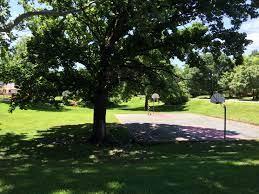
SPEAKING
1. teenager /ˈtiːneɪdʒə(r)/ (n): thanh thiếu niên
2. dirty /ˈdɜːti/ (adj): bẩn thỉu
3. waste /weɪst/ (v,n): gây, chất thải
4. shade /ʃeɪd/ (n): bóng râm
TASK 1: which of the following activities do you think teenagers should or shouldn’t do to live green? put a tick in the appropriate column. (p.23)
Activities Should Shouldn’
1. Leaving your appliances on when not in use
2. Recycling your used items ✔
3. Using plastic bags when shopping
4. Buying organic food ✔
✔
DẠYKÈMQUYNHƠNOFFICIAL
3
t
✔
TASK 2: the table below presents the reasons why teenagers should or shouldn’t do the activities in 1. Work in pairs and match them with the activities. (p.23)
* Teacher:
- has Ss read the reasons, and discuss with a peer to do the matching.
- reminds them that besides using because, they can use since/ as/ due to the fact that/ on the ground that to express reasons and encourages them to give more reasons and make small exchanges after doing the matching, e.g.
Student A: Why shouldn’t you leave your appliances on when not in use?
Student B: Because this wastes electricity and creates dangerous situations. Why should you recycle your used items?
Student A: Since this protects natural resources. ** Ss do as instructed.
*** Ss share the answers with the whole class. **** Teacher confirms the correct answers and calls on some pairs to make small exchanges like the one above.
TASK 2: the table below presents the reasons why teenagers should or shouldn’t do the activities in 1. work in pairs and match them with the activities. (p.23)
Student A: Why shouldn’t you leave your appliances on when not in use?
Student B: Because this wastes electricity and creates dangerous situations. Why should you recycle your used items?
Student A: Since this protects natural resources. Suggested answers:
3. PRACTICE ( 15’)
Aim: To give students an opportunity to discuss ideas in groups and share with the rest of the class.
* Content: Discuss and present your ideas about what you should or shouldn't do to live green
* Outcome: students’talks
* Organisation:
Teacher’s Student’s activities
TASK 3: work in groups. Discuss and present your ideas about what you should or shouldn't do to live green. (p.23)
* T has Ss work in groups, discussing what they should or shouldn’t do to live green. In weaker classes, T reminds them to use the ideas given in 1 and 2 in their discussion. In stronger classes, T encourages them to think of other activities and reasons.
** Ss do as instructed.
*** Ss share their ideas with the rest of the class by playing the game: PASSING THE BALL. Rules: A song is played while Ss are passing a ball
Content
TASK 3: work in groups. Discuss and present your ideas about what you should or shouldn't do to live green. (p.23)
Example: There are many things that we should or shouldn’t do to live green. We should recycle our used items so that we can protect natural resources. We shouldn’t drop litter in the street because this will make the street dirty and pollute the environment.
DẠYKÈMQUYNHƠNOFFICIAL
4
✔
5. Dropping litter in the street
6. Planting trees ✔
a - 5; b - 1; c - 3; d - 4; e - 2; f - 6
one by one. When the music stops, the student who keeps the ball will make a presentation.
**** Teacher praises Ss for interesting and imaginative ideas, and for providing wellformulated reasons.
4. PRODUCTION/ FURTHER PRACTICE ( 8’)
Aim: To give students an opportunity to discuss ideas in groups and share with the rest of the class.
* Content: Talk about living green
* Outcome: students’talks
* Organisation:
Teacher’s Student’s activities Content
T encourages them to talk freely about how to live green
*** Ss share their ideas with the rest of the class
Talk freely about how to live green
5. WRAP-UP & HOME WORK (2’) WRAP-UP
Teacher asks: What have you learnt today?
- Activities and the reasons why we should or shouldn’t do to live green. HOMEWORK
- Exercises in the workbook
- Prepare for Listening lesson
Date of planning: …/… / 2022
Date of teaching: …/… / 2022
WEEK: 5
Period 14
UNIT 2: HUMANS AND THE ENVIRONMENT
Lesson 5: Listening
I. OBJECTIVES:* By the end of this unit, students will be able to gain the following things:
1. Knowledge:
- Listen for specific information in a text about green living;
- Talk about a plan to organise a green event in their area.
2. Competence:
- Be collaborative and supportive in pair work and team work;
- Actively join in class activities;
- Develop presentation skills.
3. Qualities:
- Be more responsible for the environment and be able to propose plans to solve environmental issues in their residential areas;
- Be ready to make a plan to organize a green event in their area.
II. TEACHING AIDS:
- Teacher: Grade 10 text book, laptop, projector / TV/ pictures and cards.....
DẠYKÈMQUYNHƠNOFFICIAL
- Students : Text books, studying equipment….
5
=========================
- Computer connected to the Internet.
- Sach mem.vn
III. PROCEDURE:
Notes: In each activity, each step will be represented as following:
* Deliver the task.
* Implement the task.
* Discuss.
* Give comments or feedback.
Aims:
1. WARM UP & INTRODUCTION ( 3’- 5’)
- To create an active atmosphere in the class before the lesson;
- To lead into the new unit
* Content: To have some warm-up activities to create a friendly and relaxed atmosphere to inspire Ss to warm up to the subject and new lesson.
* Outcome:
* Organisation : Teacher’s instructions …
Teacher’s Student’s activities
+ Greeting + Asking question:
* Teacher:
- divides the class into 2 teams, lets each team choose 5 representatives.
- prepares in advance 2 sets of words (maybe written on a sheet of paper), and gives them to the representatives.
- asks the representatives to try to get their teammates to guess words using verbal clues or actions without using the words in their sets and without using their mother tongue in two minutes.
** Ss do as instructed.
*** Ss in each team take turns to describe and guess the words.
**** Teacher confirms the correct words, decides the winner. The winners are the ones whose team can guess the most words.
GAME: TABOO
Suggested words:
Content
Set 1: adopt, carbon footprint, litter, method, ecofriendly
Set 2: sort, awareness, organic, household appliances, cut down on
2. PRESENTATION/ NEW LESSON ( 12’- 15’)
Aims: To pre-teach the pronunciation and the meaning of some vocabulary so that students can understand the content of the listening.
To introduce the topic of the listening and activate Ss’ prior knowledge
* Content: The pronunciation and the meaning of some vocabulary
* Outcome: know the topic of the listening and activate Ss’ prior knowledge
* Organisation:
Teacher’s Student’s activities
VOCABULARY
* Teacher:
- shows the words one by one, plays the recording and has Ss repeat the sound of the words.
- has Ss guess the meanings of the words based on
VOCABULARY
Content
1. schedule (n): a plan that lists all the work that you have to do and when you must do each thing.
E.g. They have a very flexible work schedule.
DẠYKÈMQUYNHƠNOFFICIAL
6
pictures, explanations and examples.
** Ss do as instructed.
**** Teacher confirms the meanings, calls on some individual Ss to make sentences with each word.
2. specific (adj): connected with one particular thing only.
E.g. The money was collected for a specific purpose.
3. donation (n): money or goods that are given to help a person or organization, or the act of giving them.

Teacher:
- has Ss work in pairs, look at the picture and tell their partner what they see in the picture.
- encourages them to use the vocabulary they have learnt to describe the picture, e.g. The students are picking up rubbish, bottles and plastic bags; They are watering plants and trees.
** Ss do as instructed.
*** Some pairs share their answers with the class.
**** Teacher praises the pairs with interesting ideas and asks the class some more questions to elicit the topic of the listening:
4. delivery (n): the act of taking goods, letters, parcels, etc. to people's houses or places of work.

SPEAKING
1. teenager /ˈtiːneɪdʒə(r)/ (n): thanh thiếu niên
2. dirty /ˈdɜːti/ (adj): bẩn thỉu
3. waste /weɪst/ (v,n): gây, chất thải
4. shade /ʃeɪd/ (n): bóng râm
TASK 1: WORK IN PAIRS. LOOK AT THE PICTURE AND ANSWER THE QUESTIONS. (p.24)
WHAT ARE THEY DOING? WHY?
Go Green Weekend event such as:
+ Are the students wearing school uniforms?
+ Are they at school?
+ What day of the week do you think it is?
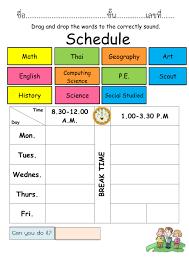
+ Do you think this is an organised event?
+ What kind of event is it?
DẠYKÈMQUYNHƠNOFFICIAL
7
3.
PRACTICE
( 15’)
Aim: To help Ss practise listening for specific information, to help students practise listening for specific information
* Content: Listen to an Announcement About A Go Green Weekend Event And Decide Whether The Following Statements Are True (T) Or False (F). Complete Each Gap In The Table With One Word From The Recording
* Outcome:
* Organisation: Teacher’s Student’s activities Content
Task 2: listen to an announcement about a go green weekend event and decide whether the following statements are true (t) or false (f). (p. 24)
* Teacher:
- tells Ss that they are going to listen to an announcement about a Go Green Weekend event. - has them read the statements, underline the key words.
- checks the key words with the whole class.
- plays the recording and has Ss do the activity, paying attention to the key words to catch the ideas.

** Ss do as instructed.
*** Ss share their answers with a peer.
**** Teacher:
- checks the answers as a class, asks SS to explain why they are true or false.
- plays the recording again if many Ss have incorrect answers, pausing at the places where they can get the correct information.
Task 3: Listen Again And Complete Each Gap
In The Table With One Word From The Recording. (p.24)
* Teacher:
- has Ss read the instruction and focus their attention on the word ‘ONE’
- has them read the incomplete text and try to have a guess at what part of speech might fit each gap, e.g. 1. noun; 2. adjective
Task 2: Listen To An Announcement About A Go Green Weekend Event And Decide
Whether The Following Statements Are True (T) Or False (F). (p. 24)
Key:
1. T ; 2. F (central market -> central park); 3. T; 4. T
Task 3: Listen Again And Complete Each Gap In The Table With One Word From The Recording. (p.24)
Key: 1. park 2. plastic 3. Sort
DẠYKÈMQUYNHƠNOFFICIAL
4. Post
8
-plays the recording once for Ss to complete the table.
5. suggestions
** Ss do as instructed.
*** Ss share their answers with a peer.
**** Teacher:
- checks the answers by calling on some Ss to write their answers on the board or read them aloud.
- plays the recording again if many Ss have incorrect answers, pausing at the places where they can get the correct information.
4. PRODUCTION/ FURTHER PRACTICE ( 8’)
Aim: To give students an opportunity to personalise the language and ideas from the listening in a speaking task
* Content: Discussion
* Outcome:
* Organisation : Teacher’s Student’s activities Content
Task 4: work in groups. Discuss the following question. (p.24)
* Teacher:
- asks some lead-in questions to see whether Ss have taken part in any environmental activities or events, and how much experience they have, e.g.
+ Have you ever taken part in an environmental activity or event?
+ How many times have you participated in such activities or events?
+ What did you do there?
+ How did you feel?
- put Ss in groups in which there are both not or less experienced Ss and Ss who have taken part in such eco-friendly events.
- eeminds them that they can use the ideas from the listening and in stronger classes, T encourages them to come up with their own green activities.
** Ss do as instructed.
*** Ss share their ideas with the rest of the class
**** T invites some groups to present their ideas to the whole class, and praises the groups for interesting and imaginative ideas.
5. WRAP-UP & HOME WORK (2’)
WRAP-UP
Teacher asks: What have you learnt today?
Task 4: work in groups. Discuss the following question. (p.24)
+ Have you ever taken part in an environmental activity or event?
+ How many times have you participated in such activities or events?
+ What did you do there?
+ How did you feel?
- We have listened to a plan to organize a green event and talked about our future plans to hold such events.
HOMEWORK
- Exercises in the workbook.
DẠYKÈMQUYNHƠNOFFICIAL
- Prepare for writing lesson.
9
Date of planning: …/… / 2022
Date of teaching: …/… / 2022
WEEK: 5
Period 15
UNIT 2: HUMANS AND THE ENVIRONMENT
Lesson 6: Listening
I. OBJECTIVES:* By the end of this unit, students will be able to gain the following things:
1. Knowledge:
- Use lexical items related to the topic “Humans and the environment”;
- Write about ways to improve the environment.
2. Competence:
- Be collaborative and supportive in pair work and team work;
- Actively join in class activities;
- Develop presentation skills.
3. Qualities:
- Be more responsible for protecting the surrounding;
- Be able and willing to persuade other people to take actions to make a nice and clean environment.
II. TEACHING AIDS:
- Teacher: Grade 10 text book, laptop, projector / TV/ pictures and cards.....
- Students: Text books, studying equipment….
- Computer connected to the Internet.
- Sach mem.vn
III. PROCEDURE:
Notes: In each activity, each step will be represented as following:
* Deliver the task.
* Implement the task.
* Discuss.
* Give comments or feedback.
Aims:
1. WARM UP & INTRODUCTION ( 3’- 5’)
- To create an active atmosphere in the class before the lesson;
- To lead into the new unit
* Content: To have some warm-up activities to create a friendly and relaxed atmosphere to inspire Ss to warm up to the subject and new lesson.
* Outcome: Lead to the subject and new lesson.
* Organisation : Teacher’s instructions …
Teacher’s Student’s activities Content
+ Greeting + Asking question:
* T divides the class into two teams, and explains the game rules:
- Ss in each team read the clues, take turns to spin the wheel, guess the individual letters until they can guess the whole word.
- It is not necessary for the Ss to guess all the individual letters. They can guess the whole word at any time.
GAME: THE WHEEL OF FORTUNE
Suggested words
Round 1:
+ Clue: the conditions in which a person, animal or plant lives or operates or in which an activity takes place
DẠYKÈMQUYNHƠNOFFICIAL
+ Key: ENVIRONMENT
Round 2:
10 =========================
** Ss do as instructed.
*** Ss in each team discuss and guess the words.
+ Clue: make something or somebody better than before
**** T confirms the correct words, decides the winner and leads in the lesson.
+ Key: IMPROVE
Round 3:
+ Clue: an idea or a plan that you mention for somebody else to think about
+ Key: SUGGESTION
2. PRESENTATION/ NEW LESSON ( 12’- 15’)
Aims: To help students recall some suggestions for improving the environment
* Content:
* Outcome:
* Organisation:
Teacher’s Student’s activities Content
* Teacher:
- asks Ss some questions to elicit the topic of the writing as well as some suggestions. e.g.
+ Do you have any ideas about how to improve the environment in our school?
+ What are they?
- has them work in pairs and asks them to do the matching. In weaker classes, go through the suggestions and expected results to check comprehension.
** Ss do as instructed.
**** Teacher asks individual Ss to call out their answers and confirms the correct ones.
TASK 1: WORK IN PAIRS. MATCH THE SUGGESTIONS FOR IMPROVING THE ENVIRONMENT WITH THEIR EXPECTED RESULTS. (p.25) some suggestions. e.g.
+ Do you have any ideas about how to improve the environment in our school?
+ What are they?
Key:
3. PRACTICE ( 15’)
:
Aim: To provide students with a model of a well-structured paragraph and practice in using connectors to link sentences. To help students practise developing ideas and writing a paragraph
* Content: Read the incomplete paragraph about ways to improve the environment. fill in the blanks with the words and phrases
* Outcome: correct answers
* Organisation: Teacher’s Student’s activities Content
* Teacher:
- tells Ss that they are going to write a paragraph about ways to improve the environment in their school. First, they will be provided with an incomplete example as a model for their writing. - recall the information about the structure of a paragraph:
+ A paragraph is a group of sentences that develop ONE main idea.
+ A paragraph usually consists of three parts: a
Task 2: read the incomplete paragraph about ways to improve the environment. fill in the blanks with the words and phrases from the box. (p.25)
DẠYKÈMQUYNHƠNOFFICIAL
11
1.c 2.a 3.b
topic sentence, supporting sentences and a concluding sentence.
+ Two important qualities of a good paragraph are unity (i.e. one main idea is developed) and coherence (i.e. all the sentences and ideas flow smoothly to make clear and logical points about the topic)
- asks Ss to read the incomplete paragraph and fill in each numbered blank with a word/ phrase in the box.
** Ss do as instructed.
*** Ss discuss and share their answers with a peer.
**** Teacher checks the answers by calling on some Ss to read their answers to the class.
Key:
1. First
2. For example
3. In conclusion
TASK 3: ADD TWO MORE SUGGESTIONS TO IMPROVE THE ENVIRONMENT IN YOUR SCHOOL TO THE PARAGRAPH IN 2. USE THE IDEAS IN 1 TO HELP YOU. (p.25)
* Teacher:
- explains the writing task.
- has Ss brainstorm more suggestions in groups.
- walks round the class to offer help and encourages Ss to take notes of their ideas.
- asks some groups to call out their ideas and write them on the board for other Ss’ reference.
- asks Ss to write their suggestions to complete the paragraph individually, sets a limited time for this task and walks round the class to give further support if needed.
- reminds them to use some connectors to link the ideas before they write:
+ To list ideas: First, Second, In addition, Additionally, Moreover, Furthermore, Another idea worth noting is that, Finally, …
+ To give an example: For example / For instance, To illustrate, …
+ To conclude: In conclusion, In brief, In short, To sum up, …
** Ss do as instructed.
*** Ss share their answers with their group members.
**** T walks round the class to monitor and make a note of some common mistakes.
TASK 3: ADD TWO MORE SUGGESTIONS TO IMPROVE THE ENVIRONMENT IN YOUR SCHOOL TO THE PARAGRAPH IN
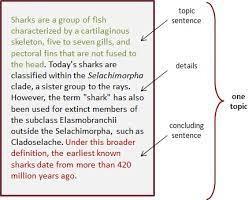
2. USE THE IDEAS IN 1 TO HELP YOU
Use some connectors to link the ideas before they write:
+ To list ideas: First, Second, In addition, Additionally, Moreover, Furthermore, Another idea worth noting is that, Finally, …
+ To give an example: For example / For instance, To illustrate, …
+ To conclude: In conclusion, In brief, In short, To sum up, …
Sample
DẠYKÈMQUYNHƠNOFFICIAL
There are three things we can do to improve the environment in our school. First, we should clean up all areas regularly. For example, we can organise clean-up activities at weekends. By doing this, we can keep our environment clean, beautiful, and safe for everyone. Second, we ought to set up more rubbish bins. For instance, we can put more rubbish bins in the school gate, in front of each building, or in the playground. Thereby, we can make the waste collection easier. In addition, we should plant more trees. To give an example, we can encourage students to plant trees or flowers in
12
our school because this reduces CO2 and makes the air clean. In conclusion, we can improve the environment in our school in many ways and even small actions can make a big difference.
4. PRODUCTION/ FURTHER PRACTICE ( 8’)
Aim: To give students an opportunity to recognise the common mistakes so that they can avoid in writing
* Content: Recognise the common mistakes so that they can avoid in writing
* Outcome: Students’ writing
* Organisation:
Teacher’s Student’s activities Content
* Teacher:
- explains the marking symbols in the following table.
- asks two Ss sitting next to each other to exchange their writing, read their partner’s writing and write the symbols next to mistakes that they can find like the ones in the table above.

- asks Ss to return their partner’s writing and lets them correct themselves.
- reminds them that they can ask for their partner’s help.
** Ss do as instructed.
*** Ss share their ideas with a partner.
**** Teacher goes around to offer help.
CLASS CORRECTION
* Teacher:
- writes Ss’ common mistakes on the board, asks Ss to check whether they make the same mistakes in their writing.
- calls on some Ss to correct those mistakes as a class.
** Ss do as instructed.
**** Teacher:
- further explains the paragraph structure if Ss are not able to develop the three elements in their writing.
- collects Ss’ writing and provides written feedback in the next lesson.
- in weaker classes, provides some suggested answers if necessary.
PEER CORRECTION
Sample answer:
Another way would be to plant more trees. For example, we can plant more green trees around the school and in the schoolyard. It reduces CO2 and makes the air we breathe in cleaner. Finally, we can set up more rubbish bins. For instance, we can put more bins in public places such as parks or bus stations. This makes the waste collection easier
5. WRAP-UP & HOME WORK (2’)
* WRAP-UP
Teacher asks: What have you learnt today?
DẠYKÈMQUYNHƠNOFFICIAL
- We have practised writing a paragraph about suggestions to improve the environment. HOMEWORK
13
- Exercises in the workbook - Prepare for Communication and Culture lesson =========================
DẠYKÈMQUYNHƠNOFFICIAL
14
Date of planning: …/… / 2022
Date of teaching: …/… / 2022
WEEK: 6
Period 16
UNIT 2: HUMANS AND THE ENVIRONMENT
Lesson 7: Communication and Culture/ CLIL
I. OBJECTIVES:* By the end of this unit, students will be able to gain the following things:
1. Knowledge:
- Ask for and give advice;
- Understand what a carbon footprint is.
2. Competence:
- Be collaborative and supportive in pair work and team work;
- Access and consolidate information from a variety of sources;
- Actively join in class activities.
3. Qualities:
- Be willing to take practical actions to help reduce their own carbon footprint and their family’s as well;
- Be responsible for environment protection.
II. TEACHING AIDS:
- Teacher: Grade 10 text book, laptop, projector / TV/ pictures and cards.....
- Students: Text books, studying equipment….
- Computer connected to the Internet.
- Sach mem.vn
III. PROCEDURE:
Notes: In each activity, each step will be represented as following:
* Deliver the task.
* Implement the task.
* Discuss.
* Give comments or feedback.
1. WARM UP & INTRODUCTION ( 3’- 5’)
Aims:
- To create an active atmosphere in the class before the lesson;
- To lead into the new unit
* Content: To have some warm-up activities to create a friendly and relaxed atmosphere to inspire Ss to warm up to the subject and new lesson.
* Outcome: Lead to the subject and new lesson.
* Organisation : Teacher’s instructions …
Teacher’s Student’s activities Content
+ Greeting + Asking question:
* Teacher divides the class into two teams, has Ss in each team take turns to run to the board and write a word/ phrase related to the topic
Humans and the Environment on the board in two minutes.
** Ss do as instructed.
**** Teacher confirms the correct word/ phrase and decides the winner (the team with most
GAME: RUNNING MAN
Suggested answers:
- Green lifestyle
- Eco-friendly
- Plastic bags
- Zero waste
DẠYKÈMQUYNHƠNOFFICIAL
- Carbon footprint
1
correct words/ phrases)
2. PRESENTATION/ NEW LESSON ( 12’- 15’)
Aims: To provide Ss with an example conversation in which people ask for and give advice about ways to find information for the presentation.
* Content: : Listen and complete the conversation with the expressions in the box. then practise it in pairs
* Outcome: ways to find information for the presentation.
* Organisation:
Teacher’s Student’s activities
* Teacher:
- elicits expressions Ss already know related to asking for and giving advice by saying some situations and has Ss give advice, e.g. Teacher: I don’t know anything about organic food.
Ss 1: You should search on the Internet. Ss 2: I advise you to go to a shop selling organic food.
- asks Ss to read through the expressions in the box and the incomplete conversation, checks comprehension and encourages them to complete the gaps based on the clues in the conversation.
- plays the recording once (in stronger classes) or twice (in weaker classes)
** Ss do as instructed.
**** Teacher:
- checks the answers by asking individual Ss to read out the complete conversation.
- asks Ss to practise the conversation in pairs then read aloud.
- in stronger classes, writes some prompts on the board and asks Ss to role-play the conversation based on the prompts only.
VOCABULARY
* Teacher:
- Shows the words one by one and has Ss repeat the sound of the words
- Has Ss guess the meaning of the words based on pictures, explanations and examples.
Content
TASK 1: LISTEN AND COMPLETE THE CONVERSATION WITH THE EXPRESSIONS IN THE BOX. THEN PRACTISE IT IN PAIRS. (p.25)
Teacher: I don’t know anything about organic food.
Ss 1: You should search on the Internet. Ss 2: I advise you to go to a shop selling organic food.
Key:
1. B
2. A
3. D
4. C
COMMUNICATION AND CULTURE
1. advise /ədˈ vaɪz/ (v): khuyên
2. climate change /ˈklaɪmət
tʃeɪndʒ/ (n.phr): biến đổi khí hậu
3. collect information /kəˈlɛkt
ˌɪnfəˈmeɪʃən/ (v.phr): thu thập thông tin
4. emissions /ɪˈmɪʃənz/ (n): phát thải
5. calculate /ˈkælkjuleɪt/ (v): tính toán
6. global temperatures /ˈgləʊbəl
ˈtɛmprɪʧəz/ (n.phr): nhiệt độ toàn cầu
7. heat /hiːt/ (v): làm nóng
DẠYKÈMQUYNHƠNOFFICIAL
2
8. public transport /ˈ pʌblɪk
ˈtrænspɔːt/ (n.phr): phương tiện công cộng
9. impact /ˈɪmpækt/ (n): sự tác động
10. take shower /teɪk ˈʃaʊə/ (v.phr): tắm
11. destroy /di'strɔi/ (v): hủy hoại
3. PRACTICE ( 15’)
Aim: To help Ss practise ways of asking for and giving advice about green living
To help students learn about carbon footprint and ways to reduce it (through CLIL)
* Content: Work in pairs. make a similar conversation asking for and giving advice about green living. use the expressions below to help you.
* Outcome: asking for and giving advice about green living
* Organisation: Teacher’s Student’s activities Content
* Teacher:
- brainstorms green living ideas and writes them on the board for Ss’ reference.
- revises common expressions used to ask for and give advice or asks Ss to read through the expressions in the table and checks their understanding if they are weaker students.
- puts Ss into pairs, gives them some minutes to think about specific green issues that they want to include in their conversation.
- in weaker classes, walks around the class and suggests situations to Ss, e.g. advice about reducing plastic waste, keeping the environment clean, or making homes or schools eco-friendly.
** Ss work in pairs to practise their conversations.
*** Some pairs act out their conversations to the class.
**** Teacher praises Ss for good effort, clean pronunciation, fluent delivery and interesting ideas.
TASK 2: WORK IN PAIRS. MAKE A SIMILAR CONVERSATION ASKING FOR AND GIVING ADVICE ABOUT GREEN LIVING. USE THE EXPRESSIONS BELOW TO HELP YOU. (p.25)
Lan: I was asked to give a presentation on Carbon Footprint next week. Do you have any suggestions for me, Mai?
Mai: How about searching for information about the topic on the internet?
Lan: Sounds good. Should I also read books in the library?
Mai: Great idea. If I were you, I would collect information from different sources. Then I could
4. PRODUCTION/ FURTHER PRACTICE ( 8’)
Aim: To give students an opportunity to personalise the CLIL topic (ways to reduce their carbon footprint)
* Content: Discuss things you can do to reduce your carbon footprint.
* Outcome: students’s talks.
* Organisation :
Teacher’s Student’s activities Content
TASK 2: WORK IN PAIRS. DISCUSS THINGS YOU CAN DO TO REDUCE YOUR CARBON FOOTPRINT. (p.26)
* Teacher:
- has Ss work in pairs to discuss things they can do to reduce their carbon footprint.
TASK 2: WORK IN PAIRS. DISCUSS THINGS YOU CAN DO TO REDUCE YOUR CARBON FOOTPRINT. (p.26)
Lan thinks that her carbon footprint is not very big, but she’ll try to reduce it to further help
DẠYKÈMQUYNHƠNOFFICIAL
3
- in weaker classes, has Ss underline the ideas in the text so that they can use them in their discussion; and in stronger classes, encourages Ss to come up with their own ideas to reduce their carbon footprint.
the environment. First, she’ll start cycling to school instead of asking her dad to drive her. Second, she’ll stop using plastic bags for groceries. Finally, she'll start drinking filtered tap water instead of buying bottled water
- reminds them to take notes of their partner’s ways to reduce his/ her carbon footprint
** Ss work in pairs to discuss and take notes.
**** T calls on some Ss to report their partner’s ideas to the class.
5. WRAP-UP & HOME WORK (2’)
WRAP-UP
Teacher asks: What have you learnt today?
- The ways to ask for and give advice
- What carbon footprint is and the ways to reduce it in our lives.
HOMEWORK
- Do exercises in the part Looking back and answer the rest questions in Task 1
- Exercises in the workbook
- Prepare for Looking back and Project lesson
Date of planning: …/… / 2022
Date of teaching: …/… / 2022
WEEK: 6
UNIT
Period 17
2: HUMANS AND THE ENVIRONMENT
Lesson 8: Looking back and project
I. OBJECTIVES:* By the end of this unit, students will be able to gain the following things:
1. Knowledge:
- revise the consonant blends /kl/, /pl/, /gr/, /pr/ correctly;
- revise words and phrases related to humans and the environment learnt in the unit;
- revise how to use will and be going to, and passive voice correctly;
- Plan activities for a Go Green Weekend and give a group presentation about the event.
2. Competence:
- Develop communication skills and creativity;
- Develop presentation skills;
- Develop critical thinking skills;
- Be collaborative and supportive in pair work and team work;
- Actively join in class activities.
3. Qualities:
- Be more creative when doing the project;
- Develop self-study skills.
II. TEACHING AIDS:
- Teacher: Grade 10 text book, laptop, projector / TV/ pictures and cards.....
- Students : Text books, studying equipment….
- Computer connected to the Internet.
DẠYKÈMQUYNHƠNOFFICIAL
4
=========================
III. PROCEDURE:
Notes: In each activity, each step will be represented as following:
* Deliver the task.
* Implement the task.
* Discuss.
* Give comments or feedback.
1. WARM UP & INTRODUCTION ( 3’- 5’)
Aims:
- To create an active atmosphere in the class before the lesson;
- To lead into the new unit
* Content: To have some warm-up activities to create a friendly and relaxed atmosphere to inspire Ss to warm up to the subject and new lesson.
* Outcome:
* Organisation : Teacher’s instructions …
Teacher’s Student’s activities Content
+ Greeting + Asking question:
- T has 10 Ss form a circle and stands at a center with a ball.
- T speaks out a word related to the topic
Humans and the environment and pass the ball to one student. Let him/her toss it to another student as he/she names the word related to the theme.
- If Ss repeat a word or can’t say any more words, they need to sit down.
- The last student standing wins the game.
* Teacher:
- Invites 10 Ss to form a circle and stand at a center with a ball.
- Explains the game rules to Ss
** Ss do as instructed.
**** Teacher praises the Ss with the most words and the most interesting words/ phrases.
GAME: THE LAST MAN STANDING
Rules: T has 10 Ss form a circle and stands at a center with a ball.
- T speaks out a word related to the topic Humans and the environment and pass the ball to one student. Let him/her toss it to another student as he/she names the word related to the theme.
- If Ss repeat a word or can’t say any more words, they need to sit down.
- The last student standing wins the game.
2. PRESENTATION/ NEW LESSON ( 12’- 15’)
Aims: To help students revise /kl/, /pl/, /gr/ and /pr/
To help students revise words and phrases related to human activities and the environment, which they have learnt in the unit
* Content:Pronunciation, vocabulary
* Outcome: use words and phrases related to human activities and the environment, which they have learnt in the unit, students revise /kl/, /pl/, /gr/ and /pr/
* Organisation:
Teacher’s Student’s activities
* Teacher:
- asks Ss to listen to the recording and underline the words that have the consonant blends /kl/, /pl/, /gr/ or /pr/.
Content
PRONUNCIATION
Listen and underline the words with the consonant blends /kl/, /pl/, /gr/ or /pr/. Then practise reading the sentences. (p.26)
DẠYKÈMQUYNHƠNOFFICIAL
5
- Sach mem.vn
- aks individual Ss to write the words with the consonant blends on the board and has them read those words several times.
Key:
- plays the recording again, pausing after each sentence for Ss to repeat.
- puts Ss in pairs and has them practise reading the sentences together.
** Ss do as instructed.
**** Teacher goes round to offer help and collect common mistakes if Ss have to correct as a class.
VOCABULARY
Complete the sentences. Use the words and phrases in the box. (p.26)
* Teacher asks Ss to complete the sentences by using the words and phrases in the box individually.
** Ss do as instructed.
*** Ss compare their answers with a partner.
**** Teacher checks the answers by asking individual Ss to write the missing words/ phrases on the board.
1. The professor is proud of the results of our project.
2. Grass is growing on the ground.
3. Those toy planes are made of plastic.
4. Click the button to become a member of the club.
VOCABULARY
Complete the sentences. Use the words and phrases in the box. (p.26)
Key:
1. green lifestyle
2. carbon footprint
3. eco-friendly
4. appliances
3. PRACTICE ( 15’)
Aim: To help Ss revise will and be going to and the passive voice
* Content:
* Outcome:
* Organisation :
Teacher’s Student’s activities Content
* Teacher asks Ss to choose the answers that best complete the sentences individually.
** Ss do as instructed.
*** Ss compare their answers with a partner.
**** Teacher:
- checks the answers by asking individual Ss to write the sentences on the board
- has Ss explain what grammatical form they have used and why.
- has Ss read aloud the sentences.
GRAMMAR
Choose the best answers. (p.26)
Key:
1. is used
2. are planted
3. will pass
4. will
5. are going to travel
6. is going to rain
4. PRODUCTION/ FURTHER PRACTICE ( 8’)
Aim: To provide an opportunity for students to develop their research and collaboration skills, and to practise giving an oral presentation.
* Content: Project
* Outcome: students’ talks
DẠYKÈMQUYNHƠNOFFICIAL
6
Teacher’s Student’s activities
* Teacher:
- gives Ss a checklist for peer and selfassessment and explains that they will have to tick the appropriate items while listening to their classmates’ presentations and write comments if they have any. (The presenters should complete their self-assessment checklist after completing their presentation).
- goes through the criteria for assessing their talk to make sure Ss are familiar with them.
- invites two or three groups to give their presentations and encourages the rest of the class to ask questions at the end.
** Ss do as instructed.
*** Ss make questions after each presentation.
**** Teacher:
- gives praises and feedback after each presentation and gives marks for their presentation as part of their continuous assessment.
- asks Ss to complete the self-assessment table, identifies any difficulties and weak areas and suggests further practice for individual Ss.
Sample
Content
I’m going to present my plan for a Go Green Weekend event. There will be 4 activities in this event. The first activity is picking up litter in the city park. People will take part in this activity on Sunday morning. The park is dirty because many people drop litter on the paths. Therefore, picking up litter will make the park cleaner and more beautiful. The second activity is planting trees on Sunday morning. A lot of big trees in the city park died in the last storm, so there is a need for planting more trees. Besides, it will provide shade and make the air fresh. The third activity that is organised in this event is exchanging organic food in the city hall. On Sunday afternoon, all families that have extra organic food will bring them to the hall and exchange food with the others. This will avoid waste from food and help them save money. The last activity is opening a secondhand market on Sunday afternoon. The reason for organising this activity is that people need new clothes and their old ones are still good for others. This will reduce waste that is harmful to the environment. Those are all of my activities for the Go Green Weekend event.
WRAP-UP
Teacher asks: What have you learnt today?
- Revise the consonant blends /kl/, /pl/, /gr/ and /pr/.
- Revise words/ phrases related to the topic Humans and the environment.
- Revise will and be going to and passive voice.
Homework:
- Exercises in the workbook
- prepare for Unit 3 lesson 1
Date of planning: …/… / 2022
Date of teaching: …/… / 2022
WEEK: 6
DẠYKÈMQUYNHƠNOFFICIAL
7 * Organisation :
5. WRAP-UP & HOME WORK (2’)
=========================
Period 18
UNIT 3: MUSIC
Lesson 1: Getting started – A talented artist
I. OBJECTIVES: * By the end of this unit, students will be able to gain the following things:
1. Knowledge:
- gain an overview about the vocabulary related to the topic Music and main grammatical points taught in this unit;
- gain vocabulary to talk about their musical idols.
2. Competence:
- develop communication skills;
- be collaborative and supportive in pair work and teamwork;
- actively join in class activities.
3. Qualities:
- develop a positive attitude towards music;
- be aware of the important role of music in our life.
II. TEACHING AIDS:
- Teacher: Grade 10 text book, laptop, projector / TV/ pictures and cards.....
- Students : Text books, studying equipment….
- Computer connected to the Internet.
- Sach mem.vn
III. PROCEDURE:
Notes: In each activity, each step will be represented as following:
* Deliver the task.
* Implement the task.
* Discuss.
* Give comments or feedback.
1. WARM UP & INTRODUCTION ( 3’- 5’)
Aims:
- To create an active atmosphere in the class before the lesson;
- To lead into the new unit
* Content: To have some warm-up activities to create a friendly and relaxed atmosphere to inspire Ss to warm up to the subject and new lesson.
* Outcome: Listen to some pieces of music and guess the name of the songs.
* Organisation : Teacher’s instructions …
Teacher’s Student’s activities Content + Greeting + Asking question:
Listen to some pieces of music and guess the name of the songs.
* Teacher gives instructions, plays the recordings.
** Ss listen and guess the names of the songs.
*** Students may discuss with other members in their teams.
**** Teacher:
- confirms the correct answers
Song 1: Love yourself
Song 2: Sorry
Listen to some pieces of music and guess the name of the songs.
Song 1: Love yourself
Song 2: Sorry
Song 3: What do you mean?
Song 4: Where are you now?
Song 5: Stuck in the moment
DẠYKÈMQUYNHƠNOFFICIAL
8
Song 3: What do you mean?
Song 4: Where are you now?
Song 5: Stuck in the moment
- asks Ss some questions and leads in the lesson.
+ Whose songs are these? (They are Justin Bieber’s.)
+ Is he a talented singer? (Yes, he is considered the Prince of Pop.)
2. PRESENTATION/ NEW LESSON ( 12’- 15’)
Aims: To help students use key language more appropriately before they read and listen. To get students interested in the topic.
- To introduce vocabulary and grammar points to be learnt in the unit.
* Content:
* Outcome:
* Organisation:
Teacher’s Student’s activities Content
* Teacher asks Ss to look at the explanation and the photos to guess the meaning of new words.
** Ss say the Vietnamese meanings of the words.
*** Other Ss correct if the previous answers are incorrect.
**** Teacher shows the Vietnamese meaning, plays the recordings and asks Ss to repeat them.
Vocabulary
1. talented (adj) /ˈtæləntɪd/: having a natural ability to do something well
2. musical instrument (n) / ˌmjuːzɪkl

ˈɪnstrəmənt/: an object used for producing musical sounds, e.g. a piano or a drum
VOCABULARY
* Teacher:
- Shows the words one by one and has Ss repeat the sound of the words
- Has Ss guess the meaning of the words based on pictures, explanations and examples.

3. trumpet (n) /ˈtrʌmpɪt/: a brass musical instrument made of a curved metal tube that you blow into, with three valves for changing the note

DẠYKÈMQUYNHƠNOFFICIAL
9
4. perform (v) /pəˈfɔːm/: entertain an audience by playing a piece of music, acting in a play, etc.
GETTING STARTED
1. famous /ˈfeɪməs/ (adj): nổi tiếng
2. traditional music /trəˈdɪʃənl
ˈmjuːzɪk/ (n.phr): âm nhạc truyền thống
3. talented /ˈtæləntɪd/ (adj): tài năng
4. pop singer /pɒp ˈ sɪŋə/ (n.phr): ca sĩ

nhạc pop
5. fan /fæn/ (n): fan hâm mộ
6. award /əˈwɔːrd/ (n): giải thưởng
7. trumpet /ˈtrʌmpɪt/ (n): kèn
8. teenager /ˈtiːneɪdʒə(r)/ (n): thiếu niên
9. upload /ˌʌp ˈləʊd/ (v): đăng tải
10. reach /riːtʃ/ (v): đạt mốc
11. be good at something /biː gʊd æt
ˈ sʌmθɪŋ/ (v.phr): giỏi về việc gì đó
12. musical instrument / ˈmjuː.zɪ.kəl
ˈɪn.strə.mənt/ (n.phr): nhạc cụ
13. perform /pəˈfɔːm/ (v): biểu diễn
3. PRACTICE ( 15’)
Aim
- To practise reading for specific information
- To develop Ss' vocabulary of the topic Music
- To check Ss’ comprehension of the conversation
To revise words and phrases related to music
To help Ss identify compound sentences, to-infinitives and bare infinitives.
* Content: task 1,2,3,4
* Outcome:Students’answers
* Organisation:
Teacher’s Student’s activities Content
TASK 1. LISTEN AND READ. (Ex.1, p.28)
* Teacher: - sets the context for listening by having Ss look at the picture (p.28) and answer the questions
- focuses Ss’ attention on the conversation and
TASK 1. LISTEN AND READ. (Ex.1, p.28)
DẠYKÈMQUYNHƠNOFFICIAL
10
elicits the names of the two speakers. - explains that Mai and Ann are watching a music programme and this is their conversation when watching it.
- plays the recording twice and asks Ss to read along while listening to it.
- has Ss underline the words/ phrases that are related to music while they are listening and reading.
** Ss do as instructed.
*** Ss share their underlined words/ phrases with a peer.
**** Teacher checks as a class.
* Teacher has the Ss read the conversation in pairs.
** Ss read the conversation.
*** One pair reads aloud.
**** Teacher collects common mistakes and gives comments.
TASK 2. READ THE CONVERSATION AGAIN AND ANSWER THE QUESTIONS.
(Ex.2, p.29)
* Teacher asks Ss to work individually to read the questions and underline the key words, then share their ideas with a partner who sits next to them.
** Ss do Task 2 individually first.
*** Ss share and discuss with their partners about the key words.
**** Teacher corrects their answers as a class.
14. Who are Ann and Mai talking about?
15. What is he good at?
16. What made him popular?
* Teacher asks Ss to scan the conversation for keywords, locate the part that contains information for each question.
** Ss do the task in pairs.
**** Teacher calls out each question and has different pairs provide their answers.
Key:
1. They are talking about a young pop singer.
2. He is good at writing music and playing many musical instruments.
3. His cover song videos made him popular.
TASK 3. FIND WORDS OR PHRASES IN
+ Where are they? (at home/ in the living room)
+ Who is the boy? (a singer)
+ What are they doing? (The boy is singing on the stage. The girls are watching a live programme and cheering.)

TASK 2. READ THE CONVERSATION AGAIN AND ANSWER THE QUESTIONS.
(Ex.2, p.29)
1. Who are Ann and Mai talking about?
2. What is he good at?
3. What made him popular?
Key:
1. They are talking about a young pop singer.
2. He is good at writing music and playing many musical instruments.
3. His cover song videos made him popular.
DẠYKÈMQUYNHƠNOFFICIAL
11
THE CONVERSATION WHICH REFERS
TO... (Ex.3, p.29)
TASK 3. FIND WORDS OR PHRASES IN THE CONVERSATION WHICH REFERS
* Teacher:
- asks Ss to read the four categories and brainstorm words or phrases to check their prior knowledge, e.g. types of music: Rock and roll, Jazz, Pop, Classical.
- has Ss read the conversation quickly again, and find the words or phrases that refer to the categories.
** Ss do as instructed.
*** Ss share their answers with a partner.
**** Teacher checks the answers by calling out each category or writing it on the board, and asks individual Ss to write the relevant words / phrases.
TASK 4: MATCH THE TWO PARTS TO MAKE COMPLETE SENTENCES.
(Ex. 4, p. 29)
* Teacher has Ss read the two parts of each of the four sentences and checks comprehension.
** Ss do the matching individually. In weaker classes, they may refer back to the conversation.
*** Ss share the answers with a partner.
**** Teacher:
- checks the answers by calling on individual Ss to read the complete sentences and writes them on the board.
- goes through each sentence and elicits the target grammar point(s), e.g.
TO... (Ex.3, p.29)
Key:
1. pop
2. Grammy, Billboard Music and Teen Choice Awards
3. piano, drums, guitar, and trumpet
4. social media
TASK 4: MATCH THE TWO PARTS TO MAKE COMPLETE SENTENCES.
1. compound sentence, to-infinitive; 2. bare infinitive; 3. to-infinitive;
4. compound sentence.
Key: 1. d; 2. c; 3. b; 4. a
4. PRODUCTION/ FURTHER PRACTICE ( 8’)
Aim: To help Ss memorise the target language and skills that they have learned.
- To inform Ss what the final product of the Project should be like and how Ss can prepare for it.
* Content: Talk about your favourite singer or musical band.
* Outcome: Students’talks
* Organisation :
Teacher’s Student’s activities Content
TASK 5: TALK ABOUT YOUR FAVOURITE SINGER OR MUSICAL BAND.
You should mention who she/he is, what she/he is good at, what makes her/ him famous.
* Teacher gives Ss clear instructions in order to make sure they can understand what they have to do.
TASK 5: TALK ABOUT YOUR FAVOURITE SINGER OR MUSICAL BAND.
You should mention who she/he is, what she/he is good at, what makes her/ him famous.
DẠYKÈMQUYNHƠNOFFICIAL
12
** Ss prepares their talk in two minutes. **** Teacher instructs Ss to play a guessing game: Ss take turns to talk about their idols without mentioning the name of their idols. The others listen and guess who she/he is.
5. WRAP-UP & HOME WORK (2’) Wrap-up
* Teacher asks Ss: What have you learnt today?
- Some lexical items about Music
- Talking about musical idols.
Homework
1. Exercises in the workbook
2. Project preparation
- Ask Ss to open their books at the last page of Unit 3, the Project section, look at the pictures and say what the topic of the Project is (a form of traditional music).
- Tell Ss about the Project requirements:
Ss will have to:
+ do research on a form of traditional music in Viet Nam or another country + include information related to the points stated on the Project page or prepare a poster (drawing, pictures) presenting the research results.
+ give an oral presentation of the research results in the last lesson of the unit.
- Explain to Ss how they can get the information (search the Internet, read newspapers, go to the library, talk to experts, etc.).
- Encourage them to start with doing research on traditional music in Viet Nam.
- Put Ss into groups and have them choose their group leader. Ask them to assign tasks for each member, making sure that all group members contribute to the project work.
- Help Ss set deadlines for each task.
DẠYKÈMQUYNHƠNOFFICIAL
13
=========================
Date of planning: …/… / 2022
Date of teaching: …/… / 2022
WEEK: 7
Period 19
UNIT 3: MUSIC LESSON 2: LANGUAGE
I. OBJECTIVES:* By the end of this unit, students will be able to gain the following things:
1. Knowledge:
- pronounce two-syllable words with correct stress;
- understand and use words and phrases related to music;
- use conjunctions to make compound sentences;
- use to-infinitives and bare infinitives after some verbs.
2. Competence:
- be collaborative and supportive in pair work and team work
- access and consolidate information from a variety of sources
- actively join in class activities
3. Qualities:
- be willing to learn new language points
- be aware of the important role of music in life.
II. TEACHING AIDS:
- Teacher: Grade 10 text book, laptop, projector / TV/ pictures and cards.....
- Students : Text books, studying equipment….
- Computer connected to the Internet.
- Sach mem.vn
III. PROCEDURE:
Notes: In each activity, each step will be represented as following:
* Deliver the task.
* Implement the task.
* Discuss.
* Give comments or feedback.
Aims:
1. WARM UP & INTRODUCTION ( 3’- 5’)
- To create an active atmosphere in the class before the lesson;
- To lead into the new unit
* Content: To have some warm-up activities to create a friendly and relaxed atmosphere to inspire Ss to warm up to the subject and new lesson.
* Outcome:
* Organisation : Teacher’s instructions …
Teacher’s Student’s activities Content
+ Greeting + Asking question:
(The topic word is: MUSIC) Game: Board race
DẠYKÈMQUYNHƠNOFFICIAL
1
* Teacher gives instructions of how to play the game, and gives an example.
** Ss discuss in their teams and write down the words.
*** Ss in each team take turns to write their words on the board.
**** Teacher confirms the correct words, decides the winner and leads in the lesson.
Rules and an example of the game Board race: The class is divided into teams. In one or two minutes (depending on the number of the letters in the topic words), Ss have to find the words which are related to the topic and have one letter in the topic word. If the word begins with a letter in the topic word, the team gets one point, if the letter of the topic word appears in the middle position, the team gets two points and if the letter of the topic word is at the end of the word they have found, the team gets three points. For example, if the topic word is FILMS and with the words found in the table below, a team gets 9 points in total.
2. PRESENTATION/ NEW LESSON ( 12’- 15’)
Aims: To give Ss practice in identifying the stressed syllables in two-syllable words and pronouncing these words.
To help Ss identify stressed syllables in two-syllable words in sentences and pronounce these words correctly
DẠYKÈMQUYNHƠNOFFICIAL
2
F A M O U S (1 point ) M O V I E (2 point s) L O V E (1 point ) C I N E M A (2 point s) A C T R E S S (3 point s) 9 point s
To make sure that sts understand the meaning of some lexical items about humans and the environment
To give Ss practice in using the words in meaningful contexts.
To help Ss memorise the rules to mark stress on the two-syllable words
* Content: Pronunciation, vocaburay and grammar
* Outcome: identifying the stressed syllables in two-syllable words and pronouncing these words. Use vocabulary, and some points of grammar
* Organisation:
Teacher’s Student’s activities
TASK 1: LISTEN AND REPEAT. PAY ATTENTION TO THE STRESSED SYLLABLE IN EACH WORD. (Ex.1, p.29)
* Teacher:
- has Ss read the words individually and check comprehension.
- plays the recording and ask Ss to listen to the words and repeat and pay attention to the stressed syllables.
** Ss do as instructed.
*** Teacher:
- checks whether Ss can say the words using the correct stress patterns by calling some Ss to read them aloud.
- has Ss find out the rule of marking stress on the two-syllable words, and elicits other examples of nouns, verbs, and adjectives.
* Teacher:
- asks Ss to read the sentences individually and pay attention to the bold words and checks their comprehension.
- plays the recording for Ss to listen and mark the stressed syllables in the words in bold.
** Ss do as instructed.
*** Ss work in pairs to compare their answers.
**** Teacher:
- confirms the correct answers.
- plays the recording again, pausing after each sentence, for Ss to repeat
TASK 3: WRITE DOWN WORDS WITH THE SAME STRESS PATTERN.
* Teacher:
- divides Ss into two teams or more teams in big classes.
- writes two two-syllable words on the board, one with stress on the first syllable, the other with the
Pronunciation
Content
TASK 1: LISTEN AND REPEAT. PAY ATTENTION TO THE STRESSED SYLLABLE IN EACH WORD. (Ex.1, p.29)
Stress on the first syllable
Stress on the second syllable singer programme common careful
relax perform attract decide
TASK 2: LISTEN AND MARK THE STRESSED SYLLABLES IN THE WORDS IN BOLD. (Ex.2, p.29)
1. She is a famous artist
2. I enjoy his song about friendship.
3. Their latest show received a lot of good comments.
TASK 3: WRITE DOWN WORDS WITH THE SAME STRESS PAT
- writes two two-syllable words on the board, one with stress on the first syllable, the other with the stress on the second syllable and has each team write as many words with the same stress pattern as they can on a piece of paper in two minutes.
DẠYKÈMQUYNHƠNOFFICIAL
3
stress on the second syllable and has each team write as many words with the same stress pattern as they can on a piece of paper in two minutes.

** Ss do as instructed.
*** Ss put down their pens and read their words out when the time is up.
**** Teacher writes the correct ones on the board and decides the winners.
Vocabulary
* Teacher gives clear instructions, reads the words on the left and makes sure Ss understand the abbreviation in brackets (v, n, adj)
** Ss work in pairs to discuss and do the matching.

*** Ss share the answers with the whole class: one student reads aloud the word and another reads its definition.

**** Teacher confirms the correct answer.
TASK 1: MATCH THE WORDS WITH THEIR MEANINGS.
* Teacher: TASK 2: COMPLETE THE SENTENCES
DẠYKÈMQUYNHƠNOFFICIAL


4
audience
single
1. c 2. d 3. e 4. a 5. b
(Ex.1, p.30) perform
judge
talented
Key:
- has Ss read the sentences carefully to decide which word in 1 can be used to complete each of the sentences.
- reminds them to use context clues to decide on the word.
** Ss discuss with a partner.
**** Teacher:
- checks answers as a class by having individual Ss call out the word they have used for each sentence first and explain why they have chosen that word (the clues in the context),
:
USING THE WORDS IN 1. (Ex.2, p.30)
e.g. The first sentence needs an adjective and the only one on the list is ‘talented’. The second sentence needs a noun, and the words ‘TV show’ and ‘attract’ suggest that ‘audience’ is the best choice.
- confirms the correct answers.
- asks individual Ss to read the complete sentences.
Key: 1. talented 2. audience 3. single 4. judge 5. perform
3. PRACTICE ( 15’)
Aim: - To give Ss the opportunity to revise how to form compound sentences. To give Ss the opportunity to revise to-infinitives and bare infinitives
* Content: COMPOUND SENTENCES
Make compound sentences using the correct conjunctions
* Outcome:use correctly conjunctions, infinitives
* Organisation :
Teacher’s Student’s activities Content
GRAMMAR: COMPOUND SENTENCES
Make compound sentences using the correct conjunctions in brackets.
* Teacher:
- tells Ss to look at the compound sentences in 4 in Getting Started and asks questions to check whether Ss understand their structure, e.g. What do they consist of? Can you split them into independent sentences? What are the clauses joined by?
- give more explanation and examples for Ss to understand what a simple sentence is and what a compound sentence is.
+ A simple sentence consists of one independent clause.
Ex: The cat chased the mouse.
+ A compound sentence consists of two or more independent clauses joined by a coordinating conjunction (e.g. for, and, nor, but, or, and yet, so). (Hint: The conjunctions spell FANBOYS.)
Ex: The cat chased the mouse, and the mouse ran into the hole.
** Ss work in pairs or individually to choose the
GRAMMAR: COMPOUND SENTENCES
Make compound sentences using the correct conjunctions in brackets.
Key:
I am a jazz fan, and my favourite style is from the late 1960s.
Jackson wants to go to the music festival on Saturday, but he has a maths exam on that day.
You can book the tickets online, or you can buy them at the stadium ticket office. The concert didn’t happen, so we stayed at home
DẠYKÈMQUYNHƠNOFFICIAL
5
appropriate conjunctions to combine the sentences.
*** Individual Ss write their sentences on the board.
**** Teacher checks answers as a class.
TO-INFINITIVES AND BARE INFINITIVES
Complete the following sentences, using the toinfinitive or bare infinitive of the verbs in brackets.
* Teacher:
- writes the following sentences on the board and elicits the words to-infinitive and bare infinitive. E.g. - When he was 12, his mother started to upload his cover song videos on social media.
- His beautiful songs have helped bring more love into people’s lives.
- has Ss read the explanation in the Remember! box, checks understanding and provides some examples of the verbs used in sentences, e.g. I decided to watch my favourite TV show. My mum let me watch the TV show.
- asks Ss to read the sentences and identify the main verbs of the sentences. This will help them decide whether they need to fill in a to-infinitive or bare infinitive after that main verb.
** Ss do the exercise individually.
*** Ss compare answers in pairs.
**** Teacher checks answers with the whole class.
TO-INFINITIVES AND BARE INFINITIVES
Complete the following sentences, using the toinfinitive or bare infinitive of the verbs in brackets.
Key: 1. to send 2. fall 3. to delay 4. watch
4. PRODUCTION/ FURTHER PRACTICE ( 8’)
Aim: To help Ss further practise the to-infinitive, bare infinitive, compound sentences and vocabulary related to the topic music.
* Content: Make compound sentences in which there is a to-infinitive or bare infinitive.
* Outcome: students’answers
* Organisation :
Teacher’s Student’s activities Content
Make compound sentences in which there is a to-infinitive or bare infinitive.
* Teacher:
- explains the rules of the task (Make compound sentences. One correct sentence gets one point. If
Make compound sentences in which there is a to-infinitive or bare infinitive.
The rules of the task (Make compound sentences. One correct sentence gets one point. If you can use to-infinitive or bare infinitive and a word in
DẠYKÈMQUYNHƠNOFFICIAL
6
you can use to-infinitive or bare infinitive and a word in the Vocabulary part, your points will triple.)
- gives an example: + The cat chases, and the mouse runs (1 point)
+ The singer started to sing, but many audiences were still talking. (3 points)
** Ss do the task in groups of 3 or 4 in two minutes.
*** The groups with the most sentences write their answers on the board.
**** Teacher praises Ss for interesting ideas and decides the winner.
Wrap-up
the Vocabulary part, your points will triple.)
- gives an example: + The cat chases, and the mouse runs (1 point)
The singer started to sing, but many audiences were still talking. (3 points
5. WRAP-UP & HOME WORK (2’)
* Teacher asks: What have you learnt today?
- stress in two-syllable words;
- words and phrases related to music;
- conjunctions to make compound sentences;
- to-infinitives and bare infinitives after some verbs.
Homework:
- Exercises in the workbook
- Prepare for lesson 3 Unit 3.
Date of planning: …/… / 2022
Date of teaching: …/… / 2022
WEEK: 7
Period 20
UNIT 3: MUSIC
LESSON 3: READING
I. OBJECTIVES:* By the end of this unit, students will be able to gain the following things:
1. Knowledge:
- read for specific information in a text about a famous TV music show;
- guess the meaning of words/phrases in context;
- talk about reasons why they want or don’t want to participate in a music competition.
2. Competence:
- be collaborative and supportive in pair work and team work;
- access and consolidate information from a variety of sources;
- develop presentation skill;
- actively join in class activities.
3. Qualities:.
DẠYKÈMQUYNHƠNOFFICIAL
7
=========================
- recognise different musical shows; - be eager to get more information about music shows.
II. TEACHING AIDS:
- Teacher: Grade 10 text book, laptop, projector / TV/ pictures and cards.....
- Students: Text books, studying equipment….
- Computer connected to the Internet.
- Sach mem.vn
III. PROCEDURE:
Notes: In each activity, each step will be represented as following:
* Deliver the task.
* Implement the task.
* Discuss.
* Give comments or feedback.
Aims:
1. WARM UP & INTRODUCTION ( 3’- 5’)
- To create an active atmosphere in the class before the lesson;
- To lead into the new unit
* Content: To have some warm-up activities to create a friendly and relaxed atmosphere to inspire Ss to warm up to the subject and new lesson.
* Outcome: Lead to the subject and new lesson.
* Organisation : Teacher’s instructions …
Teacher’s Student’s activities Content
+ Greeting + Asking question:
Crossword
* Teacher divides the class into two teams, has Ss in each team take turns to choose a random number, and shows the clues on the screen for the Ss to guess the words. Teacher also reminds Ss that they don’t need to answer all the across words to find the key word.
** Ss discuss in their teams and say the words out.
**** Teacher confirms, shows the answers on the screen, decides the winner and leads in the lesson.
Crossword
Clues:
1. a brass musical instrument made of a curved metal tube that you blow into, with three valves for changing the note (trumpet)
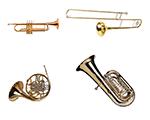
2. a person who decides on the results of a competition (judge)
3. a person who is a professional singer, dancer, actor, etc. (artist)
4. a person or thing that is loved and admired very much (idol)
5. the person who watch, read or listen to the same thing (audience)
6. a music recording that has one song (single)
7. an attempt to find somebody/something, especially by looking carefully for them/it (search)
DẠYKÈMQUYNHƠNOFFICIAL
8
8. to dance, sing or play music in order to interest or please people (perform)
9. an occasion when a video is watched online (view)
2. PRESENTATION/ NEW LESSON ( 12’- 15’)
Aims: To help students use key language more aappropriately before they read - To introduce the topic of the reading and get Ss involved in the lesson.
* Content: vocabulary
* Outcome: use key language more aappropriately before they read
* Organisation:
Teacher’s Student’s activities Content
Vocabulary
* Teacher asks Ss to look at the explanation and the photos to guess the meaning of new words.
** Ss say the Vietnamese meaning of the word.
1. reality (n): using real people (not actors) in real situations, presented as entertainment
DẠYKÈMQUYNHƠNOFFICIAL
9
T R U M P E J U D G A R T I S T I D O A U D I E N C E S I N S E A R C H P E R F O R M V E I W
*** Other Ss correct if the previous answers are incorrect.
**** Teacher shows the Vietnamese meaning, says the words aloud and asks Ss to repeat them.

2. stage (n): a period or state that something/ somebody passes through while developing or making progress
3. semi-final (n): one of the two games or parts of a sports competition that are held to decide who will compete in the last part (the final)

4. play a role in (idiom): be involved in or have an effect on


Ex: Deciding to travel instead of going straight to college after high school played a major role in my life
5. ordinary (adj): not unusual or different in any way
READING
1. competition /kɑːm.pəˈtɪʃ.ən/ (n): cuộc thi
2. identify /aɪˈdentɪfaɪ/ (v): nhận ra
3. stage /steɪdʒ/ (n): giai đoạn
4. semi-final / ˌ semi ˈfaɪnl/ (n.phr): bán kết
5. eliminate /ɪˈlɪmɪneɪt/ (v): loại = remove /
rɪˈmuːv/
6. play an important role /pleɪ ən ɪmˈpɔːtənt
rəʊl/ (v.phr): đóng vai trò quan trọng
DẠYKÈMQUYNHƠNOFFICIAL
10
TASK 1: WORK IN PAIRS. LOOK AT THE PICTURES AND DISCUSS THE FOLLOWING QUESTIONS. (Ex.1, p.31)
* Teacher:
- asks Ss to work in pairs to look at the pictures and discuss the questions.
- focuses their attention on the logos and the names of the shows.
** Ss do as instructed.
*** Some pairs of Ss share the answers with the whole class.
**** Teacher gives comments and leads in.
7. argument /ˈɑːɡjumənt/ (n): tranh luận
8. vote /vout/ (v): bình chọn
9. be not in favour of /biː nɒt ɪn ˈfeɪvər
ɒv/ (v.phr): không ủng hộ
10. develop /dɪˈveləp/ (v): phát triển
TASK 1: WORK IN PAIRS. LOOK AT THE PICTURES AND DISCUSS THE FOLLOWING QUESTIONS. (Ex.1, p.31) What are these shows? What do you know about them?
Suggested answers:
- American Idol: a famous TV music show.
- The X Factor: a television singing competition originated in the United Kingdom. Competitors go through weeks of auditions before judges until the winner is decided by a public vote. The prize is usually a recording contract. In addition to giving comments on the contestants’ performance, the judges help them choose the songs and style of their songs. The format of the X Factor has been adopted in many countries around the world.
3. PRACTICE ( 15’) :
Aim: - To help Ss practise guessing the meanings of words in context.
- To help Ss practise reading for specific information.
* Content: Read a text about a famous music show. match the highlighted words and phrases in the text to the meanings

* Outcome: Students’s Answers
* Organisation:
DẠYKÈMQUYNHƠNOFFICIAL
11
Teacher’s Student’s activities Content
TASK 2: READ A TEXT ABOUT A FAMOUS MUSIC SHOW. MATCH THE HIGHLIGHTED WORDS AND PHRASES IN THE TEXT TO THE MEANINGS BELOW. (Ex.2, p.31)
* Teacher:
- asks Ss to read the whole text once to get an overall idea.
- has Ss read it again, paying attention to the context of each highlighted word / phrase and looking for clues that they can use to guess the meaning, e.g. 1. there were many movies and TV series -> programmes on TV.
** Ss discuss the clues and do the matching in groups.
**** Teacher checks the answers as a class.
TASK 3: READ THE TEXT AGAIN AND CHOOSE THE BEST ANSWERS. (Ex.3, p.32)
* Teacher:
- asks Ss to read the questions and underline the key words in each of them.
- checks the key words Ss have underlined, e.g. 1. What, American Idol; 2. Which, statements, correct; 3. Who, wins; 4. Which, statements, judges, NOT mentioned; 5. What, inferred, competition, Viet Nam.
- asks Ss to read the questions and try to answer them before reviewing the options.
** Ss read the answer options and eliminate the wrong ones, then they search the text to find evidences to support the right answers.
*** Ss work in pairs or groups to compare answers.
**** Teacher checks the answers as a class, and asks Ss to give reasons for their answers.
Key: 1. B 2. A 3. A 4. C 5. C
Extra questions:
Question 6: When was American Idol shown for the first time on television?
A. twenty-four years ago
B. in 2002
C. in 2007
TASK 2: READ A TEXT ABOUT A FAMOUS MUSIC SHOW. MATCH THE HIGHLIGHTED WORDS AND PHRASES IN THE TEXT TO THE MEANINGS BELOW. (Ex.2, p.31)
Key: 1. b 2. a 3. d 4. c
TASK 3: READ THE TEXT AGAIN AND CHOOSE THE BEST ANSWERS. (Ex.3, p.32)
Key: 1. B 2. A 3. A 4. C 5. C
1. What is American Idol?
A. A game show on TV
B. A TV singing competition
C. A live dancing competition
2. Which of the following statements is correct?
A. From the semi-final, singers who can go to the next stage are decided by the audience vote.
B. The judges choose as many singers as they can.
C. People around the world can vote for the songs they like.
3. Who wins American Idol?
A. The singer with the highest number of votes on the final night.
B. The singer with the highest number of votes and highest score from the judges.
C. The singer with the highest score from the judges.
4. Which of the following statements about the judges is NOT mentioned?
A. They give comments after each live
DẠYKÈMQUYNHƠNOFFICIAL
12
Question 7: Who can vote for their preferred singers in American Idol?
A. People who are over thirteen
B. People who live in the US, Puerto Rico or the Virgin Islands
C. People living in the US, Puerto Rico or the Virgin Islands and over thirteen
To make the activity more engaging, T may let Ss to play the game Give or Take while doing this task.
Game rules: Students are divided into 2 teams. Ss from each team take turns to answer the questions. After each correct answer, the teacher asks Give or Take. If they say Take, they will get the points, if they say Give, the points will be given to the other team. The point may be both minus like -3, -5 and positive like + 2, + 6…
performance.
B. They have different views about singers’ performances.
C. They are not in favour of choosing ordinary people.
5. What can be inferred about the competition in Viet Nam?
A. The audience decides who makes it to the final stage.
B. All the singers will be famous.
C. It can help develop participant’s singing careers.
Extra questions:
Question 6: When was American Idol shown for the first time on television?
A. twenty-four years ago
B. in 2002
C. in 2007
Question 7: Who can vote for their preferred singers in American Idol?
A. People who are over thirteen
B. People who live in the US, Puerto Rico or the Virgin Islands
C. People living in the US, Puerto Rico or the Virgin Islands and over thirteen
To make the activity more engaging, T may let Ss to play the game Give or Take while doing this task.
Extension: Make questions
* Teacher:
- divide the class into two teams.
- asks each team to prepare 6 - 8 quiz questions based on the reading text and write them on a piece of paper, e.g. When was American Idol first shown? (January 2002), What kind of people are the participants? (Ordinary people).
- goes round to check and make sure each team knows the correct answer to each of their questions.
** Ss close their books, and Ss from each team take turns to ask other teams their questions.
*** Teacher gives a point for each correct answer
Game rules: Students are divided into 2 teams. Ss from each team take turns to answer the questions. After each correct answer, the teacher asks Give or Take. If they say Take, they will get the points, if they say Give, the points will be given to the other team. The point may be both minus like -3,5 and positive like + 2, +
Extension: Make questions
DẠYKÈMQUYNHƠNOFFICIAL
13
and decides the winner.
4. PRODUCTION/ FURTHER PRACTICE ( 8’)
Aim: To help Ss use the ideas and language in the reading to talk about whether they want to take part in Vietnam Idol and give reasons.
* Content: Discuss whether you want to participate in vietnam idol. give your reasons.
* Outcome: srudents’ talks
* Organisation:
Teacher’s Student’s activities Content
TASK 4: WORK IN PAIRS. DISCUSS WHETHER YOU WANT TO PARTICIPATE IN VIETNAM IDOL. GIVE YOUR REASONS.
* Teacher:
- asks Ss to read the text again and make notes of things they like and things they don’t like about the show.
- tells Ss that there are no right or wrong answers, and encourages them to think of as many reasons as they can to support their opinions, e.g. what benefits it offers to individuals (audiences and participants) and to society.
** Ss work in pairs to decide whether they want to participate in the show in Viet Nam and state their reasons.
**** Teacher invites Ss from different pairs to present a summary of their discussion.
TASK 4: WORK IN PAIRS. DISCUSS WHETHER YOU WANT TO PARTICIPATE IN VIETNAM IDOL. GIVE YOUR REASONS.
there are no right or wrong answers, and encourages them to think of as many reasons as they can to support their opinions, e.g. what benefits it offers to individuals (audiences and participants) and to society.
5. WRAP-UP & HOME WORK (2’)
Wrap-up
Teacher asks: What have you learnt today?
- a text about a famous music show: American Idol Homework:
- Search for more music shows on the Internet, take note the regulations and the prizes and post them on the Facebook/Zalo group of your class
- Prepare for Speaking lesson
DẠYKÈMQUYNHƠNOFFICIAL
14
=========================
Date of planning: …/… / 2022
Date of teaching: …/… / 2022
WEEK: 7
Period 21
UNIT 3: MUSIC LESSON 4: SPEAKING
I. OBJECTIVES: * By the end of this unit, students will be able to gain the following things:
1. Knowledge:
- talk about a music show.
2. Competence:
- be collaborative and supportive in pair work and team work;
- develop presentation skill;
- actively join in class activities;
- be creative;
- be critical in thinking.
3. Qualities:
- be eager to create a new musical show;
- be ready to share their ideas with the whole class;
- be able to self-study.
II. TEACHING AIDS:
- Teacher: Grade 10 text book, laptop, projector / TV/ pictures and cards.....
- Students : Text books, studying equipment….
- Computer connected to the Internet.
- Sach mem.vn
III. PROCEDURE:
Notes: In each activity, each step will be represented as following:
* Deliver the task.
* Implement the task.
* Discuss.
* Give comments or feedback.
Aims:
1. WARM UP & INTRODUCTION ( 3’- 5’)
- To create an active atmosphere in the class before the lesson;
- To lead into the new unit
* Content: To have some warm-up activities to create a friendly and relaxed atmosphere to inspire Ss to warm up to the subject and new lesson.
* Outcome: Lead to the subject and new lesson.
* Organisation : Teacher’s instructions …
Teacher’s Student’s activities Content + Greeting + Asking question:
* Teacher gives the instructions and plays the recording. Video watching: Watch the video and write down the names of the music shows.
DẠYKÈMQUYNHƠNOFFICIAL
15
** Ss watch the video and write down the name the the music shows
*** Ss share their answers with a partner.
**** Teacher checks by having some Ss to call out the answers
Suggested answers: America’s Got Talent, Pop Idol, Vietnam’s Got Talent, Perfect Edition (Cover Star), X Factor
Aims:
2.
* Content: - To pre-teach some vocabulary so that Ss can understand the meaning and use them correctly in main speaking tasks.
- To introduce more ideas for the main speaking tasks and get Ss involved in the lesson

* Outcome: Ss can understand the meaning and use them correctly in main speaking tasks and get Ss involved in the lesson.
* Organisation:
Teacher’s Student’s activities Content
Vocabulary
* Teacher:
- shows the words one by one, plays the recording and has Ss repeat the sound of the words has Ss guess the meaning of the words based on pictures, explanations or examples.

** Ss do as instructed.
**** Teacher confirms the meaning, calls on some individual Ss to make sentences with each word.
DẠYKÈMQUYNHƠNOFFICIAL
16
PRESENTATION/ NEW LESSON ( 12’- 15’)
1. dress up (ph.v): wear clothes that are more formal than those you usually wear
2. runner-up (n): a person or team that finishes second in a race or competition
3. cash (n): money in the form of coins or notes
* Teacher:
- asks Ss to look at notes first and try to guess the type of information they need to fill in and then has Ss call out their guesses, but does not tell them if they are correct or wrong.
- tells Ss to read the TV show description and find the information to complete the note individually in two minutes.
** Ss do as instructed.
*** Ss compare their answers in pairs.
**** Teacher checks answers as a class.
Extension: Brainstorm some popular TV shows or competitions.
* Teacher:
- has Ss call out some popular TV shows or competitions and write their names in English on the board.
- puts Ss into pairs and has each pair choose one of the TV shows or competitions.
** Some pairs take turns to come to the front of the class while the rest of the class ask them Yes / No questions to guess their TV show or competition. They can only answer with `Yes' or ‘No’. Each pair has three minutes to answer.
**** Teacher gives comments and praises Ss for
4. come up with (ph.v): suggest or think of an idea or plan

TASK 1: READ ABOUT A TV MUSIC SHOW AND COMPLETE THE NOTES BELOW.
Key:
1. Name: I know your face
2. People who give their scores: two main judges and a guest artist
3. Number of participants: six
4. What participants have to do: dress up and perform as famous international or local artists in a live show every week
5. How participants win the show:
– 3 participants with the highest scores after 5 weeks go to the final night.
– TV audiences vote and decide on the winner and two runners-up.
6. Prize(s): cash
Extension: Brainstorm some popular TV shows or competitions.

DẠYKÈMQUYNHƠNOFFICIAL
17
having exciting questions.
:
3. PRACTICE ( 15’)
Aim: To help Ss brainstorm ideas for the speaking activity.
* Content:
* Outcome:.
* Organisation :
Teacher’s Student’s activities Content
TASK 2: WORK IN GROUPS. MAKE UP A NEW MUSIC SHOW. USE THE POINTS IN 1 TO ORGANISE YOUR IDEAS.
* Teacher:
- asks Ss to refer back to their notes in 1;
- puts Ss into groups, and asks them to brainstorm ideas for their new show, using the suggested points in 1 and the information they searched on the Internet for the homework in the Reading lesson
- gives Ss 6 minutes so that they can come up with interesting ideas.
- asks Ss to take notes of the decisions they make.
** Ss do as instructed.
**** Teacher walks round the class and offers help if necessary.
TASK 2: WORK IN GROUPS. MAKE UP A NEW MUSIC SHOW. USE THE POINTS IN 1 TO ORGANISE YOUR IDEAS.
1. Name: I've got the rhythm
2. People who give their scores: 3 main judges and a famous local artist
3. Number of participants: 5
4. What participants have to do: take turns to sing a song whose rhythm is changed from the original one
5. How participants win the show: sing correctly and the most beautifully
6. Prize(s): cash and a trip to America
4. PRODUCTION/ FURTHER PRACTICE ( 8’)
Aim: To give Ss the opportunity to present their music shows to the class
* Content:
* Outcome:
* Organisation : Teacher’s Student’s activities Content
TASK 3: PRESENT YOUR SHOW TO THE WHOLE CLASS. USE YOUR IDEAS IN 2 AND THE EXPRESSIONS BELOW. VOTE FOR THE BEST SHOW.
* Teacher:
- has Ss work in the same groups as in 2 in 3 minutes to prepare for their presentation using the ideas in 2.
- reminds them to use the expressions provided in the box and makes sure that each student in the group is responsible for presenting a different aspect of the show.
TASK 3: PRESENT YOUR SHOW TO THE WHOLE CLASS. USE YOUR IDEAS IN 2 AND THE EXPRESSIONS BELOW. VOTE FOR THE BEST SHOW.
Useful expressions:
- We came up with an idea about a TV music show which is …
- Let us give you an example.
- In our show, there will be …
- The participants have to …
- The winner will receive …
We came up with an idea about a TV music show
DẠYKÈMQUYNHƠNOFFICIAL
18
- reminds them to pay attention to body language (smile, make eye contact), speech (speak clearly and not too quickly)
** Some groups talk about their show. The rest of the class listen, ask questions at the end of the presentation, and take notes of the things they like or don’t like about the proposed music show.
*** Teacher:
- asks Ss to vote for the most interesting show.
- gives comments and praise Ss for good effort, interesting ideas and, teamwork.
which is I've got the rhythm. Let us give you an example. In our show, there will be 5 participants, 3 main judges and a famous local artist. The judges and the artist will give their score. The 5 participants have to take turns to sing a song whose rhythm is changed from the original one. The winner is the one that sings correctly and the most beautifully and he/ she will receive a cash prize and a trip to America.
Wrap-up
Teacher asks: What have you learnt today?
- talk about music shows
Homework
- Exercises in the workbook
- Search the Internet for some information about music festivals.
DẠYKÈMQUYNHƠNOFFICIAL
19
5. WRAP-UP & HOME WORK (2’)
=========================
Date of planning: …/… / 2022
Date of teaching: …/… / 2022
WEEK: 8
Period 22
UNIT 3: MUSIC Lesson 5: Listening
I. OBJECTIVES:* By the end of this unit, students will be able to gain the following things:
1. Knowledge:
. Knowledge
- listen for gist and specific information in an interview about a music festival;
- talk about the reasons why they want/ don’t want to go to a music festival.
2. Competence:
- be collaborative and supportive in pair work and team work;
- actively join in class activities;
- develop presentation skills;
- be critical in thinking.
3. Qualities:.
- be more interested in music and music events.
II. TEACHING AIDS:
- Teacher: Grade 10 text book, laptop, projector / TV/ pictures and cards.....
- Students : Text books, studying equipment….
- Computer connected to the Internet.
- Sach mem.vn
III. PROCEDURE:
Notes: In each activity, each step will be represented as following:
* Deliver the task.
* Implement the task.
* Discuss.
* Give comments or feedback.
Aims:
1. WARM UP & INTRODUCTION ( 3’- 5’)
- To create an active atmosphere in the class before the lesson;
- To lead into the new unit
* Content: To have some warm-up activities to create a friendly and relaxed atmosphere to inspire Ss to warm up to the subject and new lesson.
* Outcome: Lead to the subject and new lesson.
* Organisation: Teacher’s instructions …
Teacher’s Student’s activities Content
+ Greeting + Asking question:
DẠYKÈMQUYNHƠNOFFICIAL
* Teacher gives the instructions and plays the recording.
** Ss watch the video and write down the name of the music festivals.
*** Ss share their answers with a partner.
**** Teacher:
- checks by having some Ss to call out the answers.
- asks Ss if they know anything about these music festivals.
Video watching: Watch the video and write down the name of the music festivals.
Suggested answers: Yamaha Revolution Music Festival: an EDM party; Asia Artist Award: honors outstanding achievements and international contributions of Asian artists in television, film and music; Monsoon Music Festival: a program of which amateurs as well as the audience can jam on stage with professional artists from all over the world, Coachella: an annual music and arts festival held at the Empire Polo Club in Indio, California, in the Coachella Valley in the Colorado Desert; genre: Rock, pop, indie, hip hop, electronic dance music, Epizode: a unique music and art festival held in Viet Nam’s biggest and most blissful island - Phu Quoc, bringing the latest electronic music trends to Asia and showcasing the best regional talents in the same time, Tomorrow Land: a Belgian electronic dance music festival held in Boom, Flanders, Belgium since 2005.
2. PRESENTATION/ NEW LESSON ( 12’- 15’)
Aims: To pre-teach the pronunciation and the meaning of some vocabulary so that Ss can understand the content of the listening.
* Content: Vocabulary
* Outcome: Ss can understand the content of the listening.
* Organisation:
Teacher’s Student’s activities Content
Vocabulary
* Teacher:
- shows the words one by one, plays the recording and has Ss repeat the sound of the words.
- has Ss guess the meaning of the words based on pictures, explanations and examples.
Vocabulary
* Teacher:
- shows the words one by one, plays the recording and has Ss repeat the sound of the words.
- has Ss guess the meaning of the words based on pictures, explanations and examples.
1. background (n): sounds that can be heard behind other sounds that are louder
DẠYKÈMQUYNHƠNOFFICIAL
** Ss do as instructed
**** Teacher confirms the meaning, calls on some individual Ss to make sentences with each word.

TASK 1: LOOK AT THE PICTURE AND ANSWER THE FOLLOWING QUESTIONS.


(Ex.1, p.33)
* Teacher asks Ss to work in pairs to look at the
4.
the situation when there are too many people or things in one place

5. in advance
before the time that is expected; before something happens

DẠYKÈMQUYNHƠNOFFICIAL
2. stage (n): a raised area, usually in a theatre, etc. where actors, dancers, etc. perform
3. free of charge (adv): without having to pay
overcrowding (adj):
(idiom):
picture and discuss the questions.
** Ss discuss in pairs.
**** Teacher:
- calls on some pairs to share their answers.
- brainstorms more ideas about the picture in a whole-class discussion.
- asks Ss what they know about this type of event or if they have been to a music festival or an outdoor concert.
TASK 1: LOOK AT THE PICTURE AND ANSWER THE FOLLOWING QUESTIONS. (Ex.1, p.33)
1. What kind of event is it?
2. Where does the event usually take place?
Suggested answers:
1. a music festival / an outdoor concert

2. outdoors: on a farm / at a stadium / a park / a beach
3. PRACTICE ( 15’)
Aim: To help Ss practise listening for gist
- To help Ss practise listening for specific information.
* Content: Listen to an interview about preparations for an international youth music festival, listen again and decide whether the following statements are true (t) or false (f). (ex.3, p.33)
* Outcome: students’ answers
* Organisation:
Teacher’s Student’s activities Content
TASK 2: LISTEN TO AN INTERVIEW ABOUT PREPARATIONS FOR AN INTERNATIONAL YOUTH MUSIC FESTIVAL. TICK THE INFORMATION THAT YOU HEAR IN THE RECORDING. (Ex.2, p.33)
* Teacher:
- asks Ss to look through the list of topics and guess what they are going to hear in the recording.
** Ss do as instructed.
**** Teacher:
- calls on individual Ss to talk about their predictions.
- asks Ss to listen and check if their guesses are correct.
- checks answers as a class and asks Ss to support their answers with clues from the recording, e.g.
TASK 2: LISTEN TO AN INTERVIEW ABOUT PREPARATIONS FOR AN INTERNATIONAL YOUTH MUSIC FESTIVAL. TICK THE INFORMATION THAT YOU HEAR IN THE RECORDING. (Ex.2, p.33)
Key: A, D
DẠYKÈMQUYNHƠNOFFICIAL
:
A: on the beach, country park; D: sold the tickets in advance.
- plays the recording a second time, pausing after the clues in weaker classes.
Key: A, D
TASK 3: LISTEN AGAIN AND DECIDE WHETHER THE FOLLOWING STATEMENTS ARE TRUE (T) OR FALSE (F).
(Ex.3, p.33)
* Teacher:
- ask Ss to read the sentences and underline the key words.
- has Ss identify the True / False statements based on what they have remembered from the first listening in 2.
- plays the recording and encourages Ss to note down key words or phrases.
** Ss do as instructed.
*** Ss work in pairs or groups to compare answers.
**** Teacher:
- checks answers as a class and plays the recording again, pausing at the sentences that contain the clues in weaker classes.
- has Ss correct the false sentences.
TASK 3: LISTEN AGAIN AND DECIDE WHETHER THE FOLLOWING STATEMENTS ARE TRUE (T) OR FALSE
Key: 1. F (first -> second); 2. F (They are still setting up the main stage and there’s still a lot to do.); 3. T; 4. F (They have sold the tickets in advance.); 5. T
4. PRODUCTION/ FURTHER PRACTICE ( 8’)
Aim: To give Ss an opportunity to personalise the language and ideas from the listening in a speaking task.
* Content:
* Outcome:
* Organisation :
Teacher’s Student’s activities Content
* Teacher: - asks some lead-in questions to see whether Ss have taken part in any music festivals, and how much experience they have, e.g. Have you ever taken part in a music festival? How many times have you participated in such events? What did you do there? How did you feel?
- put Ss in groups to discuss the two questions.
- reminds them that they can use the ideas from the warm-up activity and the ideas in their homework
TASK 4: WORK IN GROUPS. DISCUSS THE FOLLOWING QUESTIONS. (Ex.4, p.33)
Do you want to go to a music festival? Why or why not?
Work in groups. Discuss the following questions.
Do you want to go to a music festival? Why or why not?
DẠYKÈMQUYNHƠNOFFICIAL
in the speaking lesson.
** Ss do as instructed
*** Ss share their ideas with the rest of the class.
**** Teacher invites some individuals to share their ideas to the whole class, and give comments.
Although I’m a big fan of music, I don’t want to go to a music festival. As you may know, there are a big number of people going to this kind of event. As a result, social problems like theft and accidents will easily happen. One more important reason is I have a fear of crowds, so I prefer listening to music at home to going to a music festival.
5. WRAP-UP & HOME WORK (2’)
Wrap-up
Teacher asks: What have you learnt today?
- We have listened to an interview about preparations for a music festival.
Homework:
- Exercises in the workbook
- Prepare for Writing lesson
Date of planning: …/… / 2022
Date of teaching: …/… / 2022
WEEK: 8
Period 23
UNIT 3: MUSIC Lesson 6: Writing
I. OBJECTIVES:* By the end of this unit, students will be able to gain the following things:
1. Knowledge:
- use lexical items related to the topic Music;
- write a blog about experiences at a music event.
2. Competence:
- be collaborative and supportive in pair work and team work;
- actively join in class activities;
- be imaginative and creative;
- develop presentation skills.
3. Qualities:
- be inspired to learn more about music and music events;
II. TEACHING AIDS:
- Teacher: Grade 10 text book, laptop, projector / TV/ pictures and cards.....
- Students: Text books, studying equipment….
- Computer connected to the Internet.
- Sach mem.vn
III. PROCEDURE:
DẠYKÈMQUYNHƠNOFFICIAL
=========================
Notes: In each activity, each step will be represented as following:
* Deliver the task.
* Implement the task.
* Discuss.
* Give comments or feedback.
Aims:
1. WARM UP & INTRODUCTION ( 3’- 5’)
- To create an active atmosphere in the class before the lesson;
- To lead into the new unit
* Content: To have some warm-up activities to create a friendly and relaxed atmosphere to inspire Ss to warm up to the subject and new lesson.


* Outcome: Lead to the subject and new lesson.


* Organisation : Teacher’s instructions …
Teacher’s Student’s activities Content
+ Greeting + Asking question:
Game: Guess the mystery words.
* Teacher:
- divides the class into two teams, and explains the game rules.
+ Ss look at the pairs of pictures and guess the mystery words
+ One point for each earliest correct answer.
- shows one or two examples:
Game: Guess the mystery words.
* Teacher:
- divides the class into two teams, and explains the game rules.


+ Ss look at the pairs of pictures and guess the mystery words
+ One point for each earliest correct answer.
- shows one or two examples:
DẠYKÈMQUYNHƠNOFFICIAL
+ queen bee
+ waterfall
+ queen bee
+ waterfall
** Ss do as instructed.
*** Ss in each team think, discuss and guess the words.
**** Teacher confirms the correct words, decides the winner and leads in the lesson.
** Ss do as instructed.


*** Ss in each team think, discuss and guess the words.

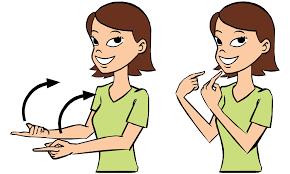


**** Teacher confirms the correct words, decides the winner and leads in the lesson.
Suggested words: come back
music event

DẠYKÈMQUYNHƠNOFFICIAL
blog writing
2. PRESENTATION/ NEW LESSON ( 12’- 15’)
Aims: 1To pre-teach the pronunciation and the meaning of some vocabulary so that Ss can understand the content of the reading.
-To provide an example blog on a music website, which Ss can use as a model for their writing.




-To provide Ss with some useful words and phrases to describe experiences;

- To help Ss develop ideas for their writing in 3.
* Content: task 1,2,3
* Outcome: students’ answers
* Organisation: Teacher’s Student’s activities Content
* Teacher:
- shows the words one by one, plays the recording
1. hit (n): a song that is very popular
DẠYKÈMQUYNHƠNOFFICIAL
experience sharing
music website
and has Ss repeat the sounds of the words. - has Ss guess the meaning of the words based on pictures, explanations and examples.
** Ss do as instructed.
**** Teacher confirms the meaning, calls on some individual Ss to make sentences with each word.
2. take place (phr.v): happen, especially after previously being arranged or planned The music festival will take place on February 5th .

WRITING
1. share /ʃeə(r)/ (v): chia sẻ
2. performance /pəˈfɔːməns/ (n): ca
3. hits /hɪts/ (n): ca khúc hay nhất

4. taste /teɪst/ (v): nếm thử
5. party atmosphere /ˈ pɑːti
ˈætməsfɪə/ (n.phr): không khí tiệc tùng
6. art exhibitions /ɑːt ˌɛksɪˈbɪʃənz/ (n.phr):

triển lãm nghệ thuật
7. watch fireworks /wɒʧ ˈfaɪəwɜːks/ (v.phr):
xem pháo hoa
8. take photos /teɪk ˈfəʊtəʊz/ (v.phr): chụp
ảnh
DẠYKÈMQUYNHƠNOFFICIAL
3. art exhibition (n): a collection of works of art, that are shown to the public
TASK 1: COMPLETE THE NOTES. (Ex.1, p.33)
Ann has just come back from a music event and shared her experience on a music website. Read her blog and complete the notes below.
* Teacher introduces the context of the blog, elicits the meaning of the word blog and why people write blogs and asks Ss if they read blogs.
** Ss read the blog individually and complete the notes in 3 minutes.
*** Ss work in groups to compare their answers.
**** Teacher checks the answers as a class. ( In weaker classes, ask questions,
TASK 1: COMPLETE THE NOTES. (Ex.1, p.33)
Ann has just come back from a music event and shared her experience on a music website. Read her blog and complete the notes below. e.g. Which event did Ann go to? and have individual Ss answer. In stronger classes, invite Ss to formulate and ask the questions.)
Key: Ann’s notes
● Event: International Youth Music Festival
● When: last Saturday
● Where: in a big country park
● Who with: some friends
● Atmosphere: party
● What we did:
– saw favourite idols perform live on stage and listened to their greatest hits
– tasted yummy food from different countries
– made new friends
How we felt: excited
TASK 2: PUT THE WORDS & PHRASES INTO THE APPROPRIATE COLUMNS. (Ex.2, p.34)
Work in groups. Put the words and phrases in the box below into the appropriate columns. Some words and phrases can go into more than one column.
* Teacher asks Ss to look at the words and phrases in the box and elicits the meanings of any words or phrases Ss don’t understand.
** Ss work into groups to put the words and phrases into suitable columns.
**** Teacher:
- calls on some groups to write their answers on the board and has the rest of the class comment on the way they have sorted the words and phrases.
Extention: has Ss play a chain game to practise describing an experience: Put Ss into teams and have each team sit in a circle. One student in each team starts the game by saying what kind of event they went to, e.g. We went to a Pop Music Festival. The next student adds another detail, e.g. The event took place in the country park. This
TASK 2: PUT THE WORDS & PHRASES INTO THE APPROPRIATE COLUMNS. (Ex.2, p.34)
Work in groups. Put the words and phrases in the box below into the appropriate columns. Some words and phrases can go into more than one column.
Key: Locatio n Atmos phere
Activities Feeling beach stadium amazin g friendly relaxed wonder ful fun
watch fireworks play games take photos see art exhibitions play musical instrument s
amazin g excited relaxed wonder ful
DẠYKÈMQUYNHƠNOFFICIAL
continues until someone in the team gets mixed up, repeats information or can’t think of anything to add. The winner is the team that continues their chain for the longest time.
3. PRACTICE ( 15’)
:
Aim- To help Ss practise developing ideas and an outline for their writing.
- To help Ss practise writing a blog about their personal experience at a music event.
* Content: Write blog
* Outcome: Writing a blog about their personal experience at a music event.
* Organisation :
Teacher’s Student’s activities Content
TASK 3: WRITE A BLOG. (Ex.3, p.34)
Imagine you went to a music event. Write a blog (about 120 words) to share your experience. Use the notes in 1 and words and phrases in 2 to help you.
* Teacher:
- has Ss work in groups to make an outline based on Ann’s notes and the words and phrases in 2 . - explains that if they have been to a music event, they can make use of their experiences; if they haven’t, they can write about an event they know about and imagine they have been to it, or make up an event.
- has Ss write a blog, using their group outline. - tells Ss that they can refer to Ann’s blog in 1 as a model and asks them to pay attention to punctuation, structures, word choice, linking words, etc.
** Ss do as instructed.
*** Ss share their answers with their group members.
**** Teacher walks around the class to monitor, make a note of some common mistakes.
3. Imagine you went to a music event. Write a blog (about 120 words) to share your experience. Use the notes in 1 and the words and phrases in 2 to help you.
I had a chance to go to a music event under the MADE tour in Seoul by my Korean idol BIGBANG. It was one of the most wonderful concerts that my friends and I have ever attended. This tour in Seoul was their last one so it was the most impressive and amazing concert ever. They not only performed their big hits but also talked and played games with fans, which made the atmosphere friendly and wonderful.
The concert took place in an indoor stadium, Putra, so we didn’t have to worry about the snow or rain. Besides, Putra was one of the biggest stadiums in Seoul, so there was plenty of space for us to enjoy the music and relax. We all felt excited when going to this event because we could make new friends and enjoy the exciting atmosphere.
4. PRODUCTION/ FURTHER PRACTICE ( 8’)
Aim: To give Ss an opportunity to recognise the common mistakes so that they can avoid in writing
* Content: Peer Correction
* Outcome: students’writing
* Organisation :
DẠYKÈMQUYNHƠNOFFICIAL
Teacher’s Student’s activities Content
Peer Correction
* Teacher: - explains the marking symbols in the following table.
- asks two Ss sitting in different rows to exchange their writing, read their partner’s blog and write the symbols next to their partner’s mistakes like the ones in the table above.

- asks Ss to return their partner’s writing and lets them correct themselves.
- reminds them that they can ask for their partner’s help.
** Ss do as instructed
*** Ss share their ideas with a partner.
**** Teacher goes round to offer help.
Class Correction
* Teacher:
- writes Ss’ common mistakes on the board, asks Ss to check whether they make the same mistakes in their writing.
- calls on some Ss to correct those mistakes as a class.
** Ss do as instructed.
**** Teacher:collects Ss’ writing and provides written feedback in the next lesson.
- in weaker classes, provides some suggested answers if necessary.
Peer Correction
Sample answer:
My sister and I attended the F5 tour at the National Stadium last night. I could sum up the concert in one word, INCREDIBLE. We found our way up to our seats after having a light meal and stood in a queue at the gate of the stadium for 45 minutes. When the curtain was raised to reveal the F5 band, the entire stadium went absolutely crazy. I was thrilled by every of their performances. There was so much emotion in many of their songs, and the way they performed was so terrific. This was such a wonderful experience, a night that I’ll never forget. I’m so grateful to have been able to have that experience.
5. WRAP-UP & HOME WORK (2’)
Wrap-up
Teacher asks: What have you learnt today?
- We have practised writing a blog about experiences at a music event.
Homework:
- Search the Internet for music blogs, choose one that you like most and post it on your class’ Facebook or Zalo group, the blog which gets the most likes will be rewarded.
- prepare for Communication and Culture lesson
Date of planning: …/… / 2022
Date of teaching: …/… / 2022
WEEK: 8
DẠYKÈMQUYNHƠNOFFICIAL
=========================
Period 24 UNIT 3: MUSIC
Lesson 7: Communication and Culture/ CLIL
I. OBJECTIVES:* By the end of this unit, students will be able to gain the following things:
1. Knowledge:
- make and respond to suggestions;
- identify chau van singing and other types of traditional music in Viet Nam.
2. Competence:
- be collaborative and supportive in pair work and team work;
- access and consolidate information from a variety of sources;
- be creative and imaginative in making conversations
- actively join in class activities.
3. Qualities:
- be willing to learn about national folk music;
- be responsible for maintaining national folk music and national culture.
II. TEACHING AIDS:
- Teacher: Grade 10 text book, laptop, projector / TV/ pictures and cards.....
- Students: Text books, studying equipment….
- Computer connected to the Internet.
- Sach mem.vn
III. PROCEDURE:
Notes: In each activity, each step will be represented as following:
* Deliver the task.
* Implement the task.
* Discuss.
* Give comments or feedback.
Aims:
1. WARM UP & INTRODUCTION ( 3’- 5’)
- To create an active atmosphere in the class before the lesson;
- To lead into the new unit
* Content: To have some warm-up activities to create a friendly and relaxed atmosphere to inspire Ss to warm up to the subject and new lesson.
* Outcome: Lead to the subbject and new lesson
* Organisation : Teacher’s instructions …
Teacher’s Student’s activities Content
* Teacher divides the class into two teams and plays the recording.
** Ss watch the video and say the names of some types of traditional music in Viet Nam.
**** Teacher:
- calls the team members who raise their hand first and confirms the correct answers.
- asks Ss if they know anything about these types of
Video watching: Watch the video and say the names of some types of traditional music in Viet Nam.
Suggested answers: Tuong, Cai luong, Cheo, Ca tru, Xam, Quan ho, Chau van
DẠYKÈMQUYNHƠNOFFICIAL
music.
- decides the winner.
2. PRESENTATION/ NEW LESSON ( 12’- 15’)
Aims: - To review expressions for making and responding to suggestions.
- To provide Ss with an example conversation in which people make and respond to suggestions about going to a music show.
-To help Ss practise making and responding to suggestions.
To pre-teach the meaning and pronunciation of some words/phrases, so that Ss can use them in their presentation later and can understand the reading passage.
* Content: everyday english,
* Outcome: students’ answers
* Organisation:
* Teacher:
Teacher’s Student’s activities Content
- has Ss look at the four options A - D and checks if they understand their meanings and use: phrases to make suggestions (How about ..., Shall ...) and respond to suggestions (I’d love to ..., Let’s ...).
- explains the task, asks Ss to read the conversation and find clues for the missing expressions, then has them complete the gaps.
- plays the recording for Ss to listen and complete the conversation between Ann and Mai at the same time.
** Ss do as instructed.
**** Teacher:
- plays the recording again and confirms the correct answers.
- has Ss read the expressions the speakers use to make and respond to suggestions.
- puts Ss into pairs to practise the conversation.
- invites some pairs to role-play the conversation in front of the class.
* Teacher:
- has Ss brainstorms some ideas about what kind of music show they want to go to, where and when it happens and who performs;
e.g. + music shows: a traditional music performance, a pop music show, a jazz music show, a rock music show, an IDM music show…
+ locations: Hanoi opera house, Thang Long
TASK 1: LISTEN AND COMPLETE THE FOLLOWING CONVERSATION WITH THE EXPRESSIONS FROM THE BOX. THEN PRACTISE IT IN PAIRS. (Ex.1, p.34)
TASK 2: WORK IN PAIRS. HAVE SIMILAR CONVERSATION MAKING AND RESPONDING TO SUGGESTIONS ABOUT GOING TO A MUSIC SHOW.
DẠYKÈMQUYNHƠNOFFICIAL
Key: 1. C 2. B 3. A 4. D
art performance centre, Viet Xo palace, Performing arts theatre Ho Chi Minh city, Ho Chi Minh city opera house, …
- asks Ss to work in pairs to make similar conversations about going to a music show, using the expressions for making and responding to suggestions and the ideas above.
- in stronger classes, encourages Ss to use the expressions for declining a suggestion first, then they can make a new suggestion.
** Ss do as instructed and practise their conversations.
**** Teacher:
- invites some pairs to role-play their conversations to the class.
- praises for good effort, clear pronunciation, fluent delivery, and interesting
* Teacher:
- shows the words one by one, plays the recording and has Ss repeat the sounds of the words.
- has Ss guess the meaning of the words based on pictures, explanations and examples.
** Ss do as instructed.
**** Teacher confirms the meaning, calls on some individual Ss to make sentences with each word.
Vocabulary
1. praise (v): say that you approve of and admire

somebody/something
2. chanting (n): the activity of singing a prayer or song to a simple


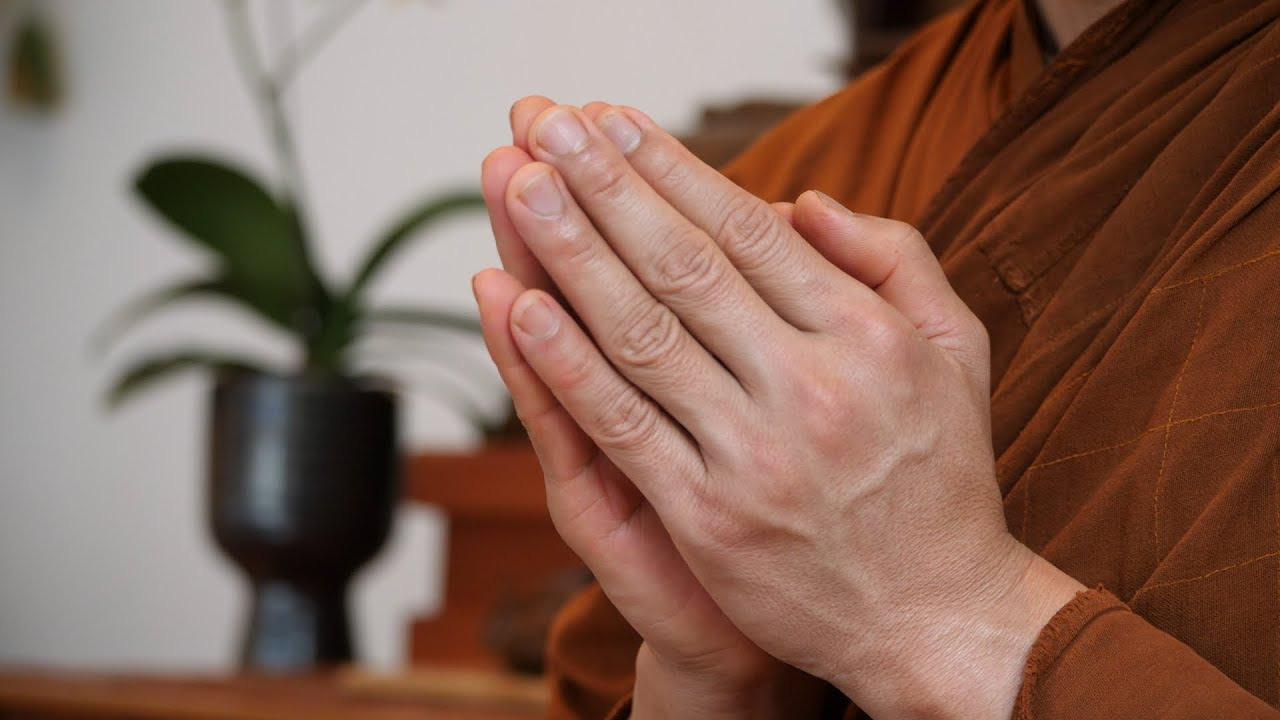
tune
3. psychic (n): a person who claims to have strange mental powers so that they can do things that are not possible according to natural laws, such as predicting the future and speaking to dead people
DẠYKÈMQUYNHƠNOFFICIAL
:
4. saint (n): a person that the Christian Church recognizes as being very holy, because of the way they have lived or died
COMMUNICATION AND CULTURE
1. artists /ˈɑːtɪst/ (n): nghệ sĩ
2. ancient /ˈ eɪnʃənt/ (adj): cổ đại
3. spread /spred/ (v,n): lan truyền
4. praise /preɪz/ (v): tuyên dương
5. worship singing /ˈ wɜːʃɪp ˈ sɪŋɪŋ/ (n.phr): hát thờ
6. psychic /ˈ saɪkɪk/ (n): nhà ngoại cảm
7. moon-shaped lute /muːn-ʃeɪpt luːt/ (n): đàn nguyệt
8. bamboo clapper /bæmˈbuː ˈklæpəz/ (n): đàn tính
9. costumes /ˈkɒstjuːmz/ (n): trang phục
10. depend on /dɪˈpend ɑːn/ (phr.v): phụ thuộc vào

11. be recognised as /biː ˈ rɛkəgnaɪzd æz/ (v.phr): được công nhận
3. PRACTICE ( 15’)
Aim: - To introduce a type of traditional music in Viet Nam;
- To help Ss practise summarising the main points of a passage using a mind map.
* Content: Reading a passage about chau van singing and complete the mind map
* Outcome: summarising the main points of a passage using a mind map
* Organisation: Teacher’s Student’s activities Content
* Teacher:
- asks Ss if they like traditional music and what
TASK 1: READ A PASSAGE ABOUT CHAU VAN SINGING AND COMPLETE THE
DẠYKÈMQUYNHƠNOFFICIAL
types they are familiar with.
- has them look at the picture and describe it, e.g. how many people are performing, what musical instruments the musicians are playing, what they are wearing.
- introduces the type of music they are going to read about in this section.
- asks Ss to read the text and complete the mind map individually.
** Ss do as instructed.
*** Teacher: - draws the mind map on the board and has individual Ss complete the different branches.
- confirms the correct answers.
Extension: Ask Ss to close their books and remove any answers from the board. Divide Ss into two teams and have them quiz each other on what they have learnt about chau van singing. Set some rules for the quiz, e.g. each team has 30 seconds to formulate a question and 30 seconds to answer one. Keep a tally of the number of correct answers for each team. The winner is the team with more correct answers.

* Teacher has Ss read the passage again, locate the words in A in the passage, guess their meaning based on the context and do the matching.
** Ss do as instructed.
*** Ss share their answers with a peer.
**** Teacher invites some individual Ss to give their answers and explanations.
TASK 2: MATCH EACH OF THE FOLLOWING WORDS IN A WITH ITS SUITABLE DEFINITION IN B. A B
1. ancient a. be known by, or be used by more and more people
2. spread b. having the usual qualities or features of a particular type of person, thing or group
3. typical c. very old; having existed for a very long time
4. rank d. a being or spirit who is believed to have power over a particular part of nature or who is believed to represent a particular quality
DẠYKÈMQUYNHƠNOFFICIAL
MIND MAP BELOW. (Ex.1, p.35)
Key
5. gods e. the position that somebody has in a particular organisation, society, etc.
Key: 1. c 2. a 3. b 4. e 5. d
4. PRODUCTION/ FURTHER PRACTICE ( 8’)
Aim: To help Ss practise expressing opinions about a traditional type of music.
* Content: Tell your partner what you find most interesting about chau van singing.
* Outcome: students’talks
* Organisation :
* Teacher:
Teacher’s Student’s activities
- asks Ss to work in pairs and share what they find most interesting about chau van singing.
- suggests that they can talk about chau van’s performance, types, musical instruments, costumes, psychics and its importance.
** Ss do as instructed.
**** Teacher calls on some pairs to share their ideas with the whole class.
Wrap-up
Content
TASK 3: WORK IN PAIRS. TELL YOUR PARTNER WHAT YOU FIND MOST INTERESTING ABOUT CHAU VAN SINGING.
Suggested answer: What I find most fantastic about chau van is that the psychic’s costumes are very colourful and the style of clothes, hats and belts depend on the rank of the gods or saints the performers worship.
5. WRAP-UP & HOME WORK (2’)
Teacher asks: What have you learnt today?
-Making and responding to suggestions;
-Identifying chau van singing.
Homework
- Exercises in the workbook
- Prepare for Looking back and Project lesson
DẠYKÈMQUYNHƠNOFFICIAL
=========================
Date of planning: …/… / 2022
Date of teaching: …/… / 2022
WEEK: 9
Period 25
UNIT 3: MUSIC LESSON 8: LOOKING BACK AND PROJECT
I. OBJECTIVES:
* By the end of this unit, students will be able to gain the following things:
1. Knowledge:
- pronounce two-syllable words with correct stress;
- understand and use words and phrases related to music;
- use conjunctions to make compound sentences correctly;
- use to-infinitives and bare infinitives after some verbs correctly;
- do research on traditional music in Viet Nam or another country and give a group presentation about it.
2. Competence:
- develop communication skills and creativity;
- develop presentation skill;
- develop critical thinking skill;
- be collaborative and supportive in pair work and team work;
- actively join in class activities.
3. Qualities :
- be more creative when doing the project;
- develop self-study skills.
II. TEACHING AIDS:
- Teacher: Grade 10 text book, laptop, projector / TV/ pictures and cards.....
- Students: Text books, studying equipment….
- Computer connected to the Internet.
- Sach mem.vn
III. PROCEDURE:
Notes: In each activity, each step will be represented as following:
* Deliver the task.
* Implement the task.
* Discuss.
* Give comments or feedback.
1. WARM UP & INTRODUCTION ( 3’- 5’)
Aims:
- To create an active atmosphere in the class before the lesson;
- To lead into the new unit
* Content: To have some warm-up activities to create a friendly and relaxed atmosphere to inspire Ss to warm up to the subject and new lesson.
* Outcome: Lead to the new lesson
* Organisation: Teacher’s instructions …
Teacher’s Student’s activities
+ Greeting + Asking question:
* Teacher: - invites ten Ss to form a circle and stand at a center with a ball.
Content
Game: The last man standing Rules: Have ten Ss form a circle and stand at a center with a ball. Ss take turns to speak
DẠYKÈMQUYNHƠNOFFICIAL
1
- explains the game rules to Ss
** Ss do as instructed
**** Teacher praises the Ss with the most words and the most interesting words/ phrases.
out a word related to the topic Music and pass the ball to one student. Let them toss it to another student as they name the word related to the theme. If they repeat a word or can’t say any more words, they need to sit down. The last student standing wins the game.
2. PRESENTATION/ NEW LESSON ( 12’- 15’)
Aims: To help Ss revise stress in two-syllable words. To help Ss revise vocabulary items they have learnt in the unit.
* Content: Ss revise stress in two-syllable words. Ss revise vocabulary items they have learnt in the unit
* Outcome: they use vocabulary and know stress in two-syllable
* Organisation:
Teacher’s Student’s activities Content
* Teacher:
- has Ss do this activity individually, then compare their answers in pairs.
- plays the recording, pausing after each word for Ss to check their answers.
- writes the correct answers on the board if necessary.
- plays the recording again for Ss to repeat the words.
** Ss do as instructed.
*** Ss compare their answers with a partner.
**** Teacher has Ss practise saying the words in pairs and checks their pronunciation.
* Teacher:
- asks Ss to read the paragraph quickly and check if they don’t know any words.
- has Ss do this activity individually and write their answers in their notebooks.
** Ss do as instructed.
**** Teacher calls on individual Ss to write their answers on the board, and checks answers as a class.
3. PRACTICE ( 15’)
PRONUNCIATION
Listen and mark the stressed syllables in the following words. Then read them out
Key + Audio script – Track 24: per'form 'concert 'final 'singer 'famous en'joy
VOCABULARY
Complete the text using the words and phrases in the box.
Key: 1. music 2. fans 3. artists
4. instrument 5. concerts
Aim: To help Ss revise compound sentences. To help Ss revise verbs followed by to-infinitives and bare-infinitives.
* Content: Match the two parts to make complete sentences. There is a mistake in each sentence below. Find the mistake and correct it.
* Outcome: students’s answers
* Organisation:
DẠYKÈMQUYNHƠNOFFICIAL
2
Teacher’s Student’s activities Content
GRAMMAR
GRAMMAR
1. Match the two parts to make complete sentences.
* Teacher asks Ss to read the two parts carefully and find out the clues to do the matching, e.g. He in 2 with his in d; We can in 3 and a…
** Ss do the matching individually.
*** Ss compare their answers with a partner.
**** Teacher checks the answers as a class.
2. There is a mistake in each sentence below. Find the mistake and correct it.
* Teacher:
- asks Ss to read the sentences, then recall verbs that go with to-infinitives or bare infinitives.
- has them underline the mistakes in the sentences and correct them individually.
** Ss do as instructed.
**** Teacher:
- calls on some Ss to read their answers.
- checks the answers as a class.
4. PRODUCTION/ FURTHER PRACTICE ( 8’)
1. Match the two parts to make complete sentences.
Key: 1.c 2. d 3. a 4. b
2. There is a mistake in each sentence below. Find the mistake and correct it
Key:
1. attend -> to attend 2. to go -> go
3. buy -> to buy 4. to sing> sing
Aim: To provide an opportunity for Ss to develop their research and collaboration skills, and to practise giving an oral presentation.
* Content: project
* Outcome: students’s talks
* Organisation:
Teacher’s Student’s activities Content
Project
* Teacher:
- gives Ss a checklist for peer and selfassessment and explains that they will have to tick the appropriate items while listening to their classmates’ presentations and write comments if they have any. (The presenters should complete their self-assessment checklist after completing their presentation).
- goes through the criteria for assessing their talk to make sure Ss are familiar with them.
- invites two or three groups to give their presentations and encourages the rest of the class to ask questions at the end.
** Ss do as instructed.
We did research on a form of traditional music in Viet Nam which is xam singing. It is a type of Vietnamese folk music which was popular in the Northern region of Vietnam but is nowadays considered an endangered form of traditional music in Vietnam. The origin of xam singing was dated from the Tran dynasty in the 14th century. Xam artists often play monochord or two-chord fiddle to accompany the songs themselves, and sometimes they form a band with one singer and others who play traditional instruments such as the drum or
DẠYKÈMQUYNHƠNOFFICIAL
3
*** Ss make questions after each presentation.
**** Teacher: gives praise and feedback after each presentation and gives marks for their presentation as part of their continuous assessment.
- asks Ss to complete the self-assessment table, identifies any difficulties and weak areas and suggests further practice for individual Ss.
clappers. If you search on the Internet, there are many different types of xam singing. However, depending on the rhythm of the drum, xam singing is divided into two styles, xam cho for a rapid rhythm and xam co dao for a slow one. About the costumes of xam performers, they often wear dark clothes, especially brown ones. After getting such information about xam singing, we hope that all of you will try listening to this type of music.
5. WRAP-UP & HOME WORK (2’)
Wrap-up
Teacher asks: What have you learnt today?
- revise how to pronounce stress in two-syllable words correctly;
- revise the use of words/ phrases related to the topic Music;
- revise how to use conjunctions to make compound sentences correctly;
- revise some verbs followed by to-infinitives and bare-infinitives.
Homework
- Exercises in the workbook
- prepare for the next period.
Date of planning: …/… / 2022
Date of teaching: …/… / 2022
WEEK: 9
I. OBJECTIVES:
Period 26
REVIEW 1
* By the end of this unit, students will be able to gain the following things:
1. Knowledge:
1. Knowledge
- Use words related to family life, humans and environment, and music;
- Pronounce the consonant blends /br/, /kr/, /tr/, /gr/, /pr/ correctly;
- Apply the knowledge of grammar points learnt in the previous units to do the task; (to-infinitive, bare infinitive, the present simple, the present continuous, the future with will and be going to)
- Use the passive voice;
- Use the coordinating conjunctions (and, or, but, so).
2. Competence:
- Develop communication skills and cultural awareness;
- Be collaborative and supportive in pair work and teamwork;
- Actively join in class activities.
3. Qualities:.
- Develop self-study skills;
- Raise students’ awareness of the need to keep their neighbourhood green.
DẠYKÈMQUYNHƠNOFFICIAL
4
=========================
II. TEACHING AIDS:
- Teacher: Grade 10 text book, laptop, projector / TV/ pictures and cards.....
- Students : Text books, studying equipment….
- Computer connected to the Internet.
- Sach mem.vn
III. PROCEDURE:
Notes: In each activity, each step will be represented as following:
* Deliver the task.
* Implement the task.
* Discuss.
* Give comments or feedback.
1. WARM UP & INTRODUCTION ( 3’- 5’)
Aims:
- To create an active atmosphere in the class before the lesson;
- To lead into the new unit
* Content: To have some warm-up activities to create a friendly and relaxed atmosphere to inspire Ss to warm up to the subject and new lesson.
* Outcome: Lead to the subject and new lesson.
* Organisation : Teacher’s instructions …
Teacher’s Student’s activities
+ Greeting + Asking question:
* Teacher shows 3 sets of pictures (taken from Project lessons of Unit 1-2-3) and asks students to find a keyword for each set of pictures.
** Students raise hands to answer.
*** Teacher and students discuss the answers.
**** Teacher checks the answers as a class.
Content
GAME: FINDING KEYWORDS
* Teacher shows 3 sets of pictures (taken from Project lessons of Unit 1-2-3) and asks students to find a keyword for each set of pictures.
** Students raise hands to answer.
*** Teacher and students discuss the answers.
**** Teacher checks the answers as a class.
Set 1: Family life/family
Set 2: Humans and the environment/ go green/ green lifestyles/ living green
DẠYKÈMQUYNHƠNOFFICIAL
5
2. PRESENTATION/
NEW
LESSON ( 12’- 15’)
Aims: To check if students can identify consonant blends and provide further pronunciation practice.


DẠYKÈMQUYNHƠNOFFICIAL
6
Set 3: Traditional music/music
To check if students remember collocations they have learnt in the previous units.
* Content: prononunciation, vocabulary
* Outcome: students can identify consonant blends and provide further pronunciation practice. students remember collocations they have learnt in the previous units.
* Organisation:
Teacher’s Student’s activities
* Teacher writes /br/, /gr/, /kr/, /pr/ and /tr/ on the board.
- Teacher writes one word containing the consonant blend below each of them.
- Teacher asks students to listen and write down the words containing the sound blends.
** Students do the task by writing the words in suitable column.
*** Teacher can invite some pairs of students to read aloud.
**** Teacher checks students’ pronunciation and give feedback.
Content
Pronunciation
TASK 1: LISTEN AND WRITE THE WORDS IN THE CORRECT COLUMNS. THEN PRACTISE SAYING THE WORDS. (p. 38)
Key:
* Teacher tells students to read the given parts of the sentences carefully and make sure they understand their meanings.
** Students do this exercise individually by
Vocabulary
TASK 1: MATCH THE TWO PARTS TO MAKE COMPLETE SENTENCES. (p. 38)
DẠYKÈMQUYNHƠNOFFICIAL
7
/ b r / / g r / / k r / /pr/ /t r / b r a i n g r e e n c r a s h prac tise t r a i n b r e a k f a s t g r o w c r e a t e prot ect t r e a t b r e a d w i n n e r g r e a t c r e a m pro duct t r e e
matching the halves to complete the sentences
Key:
*** Teacher allows students to share their answers before discussing as a class and encourages them to pronounce the sentences correctly.
**** Teacher checks the answers as a class and gives feedback.
TASK 2: COMPLETE THE FOLLOWING SENTENCES USING THE WORDS FROM THE BOX. (p. 38)
* Teacher asks students to work individually to complete the sentences with the given words and phrases.
** Students work individually to complete the task.
*** Teacher allows students to share answers before discussing as a class.
**** Teacher asks students to say the sentences aloud and makes sure they pronounce the words and phrases correctly. Teacher can ask for translation to check their understanding.
3. PRACTICE ( 15’)
5. c
TASK 2: COMPLETE THE FOLLOWING SENTENCES USING THE WORDS FROM THE BOX. (p. 38)
Key:
1. laundry
2. groceries
3. perform
4. audience
5. eco-friendly
Aim: To check if students can use the grammar points learnt in the previous units in sentences. To check if Ss can use the passive voice.
* Content: : Complete the sentences with the correct forms of the verbs in brackets
* Outcome:
* Organisation:
Teacher’s Student’s activities Content
* Teacher asks students to work independently to fill in the blanks with the correct forms of the verbs in brackets.
** Students read the sentences first and underline the clues that help them decide the correct forms of the verbs in brackets.
*** Teacher reminds students to use the correct forms of the verbs as requested in each sentence then allows them to share answers before discussing as a class.
**** Teacher can ask students to read aloud the full sentences and correct their pronunciation if needed.
TASK 1: COMPLETE THE SENTENCES WITH THE CORRECT FORMS OF THE VERBS IN BRACKETS. (p. 39
Key:
1. cleans – is helping
2. to improve – take
3. practise – are practising
4. am going to watch – will win
DẠYKÈMQUYNHƠNOFFICIAL
8
1. e
2. d
3. a
4. b
* Teacher asks students to read the sentences first.
Task 2: Complete the sentences. Make sure they mean the same as the sentences. ( p.39)
** Students do the task individually.
*** Teacher reminds students to pay attention to the passive and active forms of the sentences then allows them to share answers before discussing as a class.
**** Teacher can ask students to read aloud the full sentences and correct their pronunciation if needed.
4. PRODUCTION/ FURTHER PRACTICE ( 8’)
Key:
1. The rubbish in the neighbourhood is collected three times a week.
2. All the electrical devices in the house were turned off.
3. His music videos will be watched online (by millions of people).
Aim: To check if Ss can use coordinating conjunctions (and, or, but, so) to make compound sentences
* Content: Match the two parts to make complete sentences
* Outcome: students’s talks
* Organisation:
Teacher’s Student’s activities
* Teacher asks students to read the two halves given of the sentence
** Students do the task individually.
*** Teacher reminds students to pay attention to the coordinating conjunctions (and, or, but, so) then allows them to share answers before discussing as a class.
**** Teacher can ask students to read aloud the full sentences and correct their pronunciation if needed.
5. WRAP-UP & HOME WORK (2’)
WRAP-UP
Content
TASK 3: MATCH THE TWO PARTS TO MAKE COMPLETE SENTENCES.
Teacher asks students to talk about what they have learnt in the lesson.
- Review on how to pronounce consonant blends, grammar points (to-infinitive, bare infinitive, the present simple, the present continuous, the future with will and be going to) and vocabulary of Unit 1, 2, and 3.
HOMEWORK
Prepare for Review 1 – Skills 1: Listening and speaking
=========================
DẠYKÈMQUYNHƠNOFFICIAL
9
(p. 39)
1. b 2. c 3. d 4. a
Key:
Date of planning: …/… / 2022
Date of teaching: …/… / 2022
WEEK: 9
Period 27
REVIEW 1 (Unit 1+2+3)
Lesson 2: Skills 1_ Listening and speaking
I. OBJECTIVES:* By the end of this unit, students will be able to gain the following things:
1. Knowledge:
- practice listening for general and specific information about music;
- practice talking about favorite singer or musician.
2. Competence:
- Develop communication skills and cultural awareness
- Be collaborative and supportive in pair work and teamwork
- Actively join in class activities
3. Qualities:.
- Develop self-study skills
- Raise students’ awareness of the need to keep their neighbourhood green.
II. TEACHING AIDS:
- Teacher: Grade 10 text book, laptop, projector / TV/ pictures and cards.....
- Students: Text books, studying equipment….
- Computer connected to the Internet.
- Sach mem.vn
III. PROCEDURE:
Notes: In each activity, each step will be represented as following:
* Deliver the task.
* Implement the task.
* Discuss.
* Give comments or feedback.
1. WARM UP & INTRODUCTION ( 3’- 5’)
Aims:
- To create an active atmosphere in the class before the lesson;
- To lead into the new unit
* Content: To have some warm-up activities to create a friendly and relaxed atmosphere to inspire Ss to warm up to the subject and new lesson.
* Outcome: Lead to the subject and new lesson.
* Organisation : Teacher’s instructions …
Teacher’s Student’s activities Content
+ Greeting + Asking question:
* Teacher shows pictures and asks students to name the traditional music in the picture
** Students raise hands to answer.
*** Teacher and students discuss more the answers.
**** Teacher checks the answers as a class.
Name the pictures: Traditional music
DẠYKÈMQUYNHƠNOFFICIAL
10
2. PRESENTATION/ NEW LESSON ( 12’- 15’)
Aims: To help Ss practise listening for main ideas to lead to the listening skill
* Content: Listen and choose the best title for the talk.
* Outcome: students’ answers
* Organisation:
Teacher’s Student’s activities Content
* Teacher focuses Ss’ attention on the three options and asks “What do you think the listening text will be about?” to elicit Elvis Presley and check what Ss know about him.
** Students look at three options, read and underline key words.
*** Teacher plays the recording once for Ss to listen and choose the best answer.
**** Teacher confirms the answers as a class.
3. PRACTICE ( 15’)
LISTENING
Task 1: Listen and choose the best title for the talk. (p. 40)
Answer key:
Aim: To help Ss practise listening for specific information.
* Content: Listen again and fill in each gap in the Quick facts with a number. (p. 40)
* Outcome:students’s answers
* Organisation:
Teacher’s Student’s activities Content
* Teacher asks students to read through the Quick facts first, and elicit what the missing numbers refer to, e.g. year, age, how many awards.
- Teacher plays the recording and have Ss fill in each gap with a number.
** Students listen and do the task individually.
*** Teacher calls on some students to report their answers for the class.
**** Teacher checks the answers and add more information if necessary.
Task 2: Listen again and fill in each gap in the Quick facts with a number. (p. 40)
Answer key:
Audio script – Track 26 + 27:
Elvis Presley was an American singer, musician and actor born in 1935. His single Heartbreak Hotel, released when he was 21, became a number-one hit in the United States. Starting with the film Love Me Tender, Presley also made 31 films. His
DẠYKÈMQUYNHƠNOFFICIAL

11
Xoan singing Chau van singing
Quan ho singing
C
1. 1935 2. 21 3. 3 4. 42
single of the same name sold more than a million 67 copies even before the film was released. During his life, he received many awards, including three Grammys. Presley died of a heart attack at the age of 42. Many years after his death, Presley is still one of the best-selling singers of all time.
4. PRODUCTION/ FURTHER PRACTICE ( 8’)
Aim: To help Ss practise speaking about a favourite singer or musician
* Content: Talk about your favourite singer or musician. Use the expressions below to help you.
* Outcome: students’s talks
* Organisation:
Teacher’s Student’s activities Content
* Teacher asks students to read through the expressions in the box.
** Students work in pairs to exchange their ideas about their favorite singer or musician.
*** Teacher calls on some students to report their answers for the class..
**** Teacher checks the answers and add more information if necessary.
SPEAKING
Task 1: Work in pairs. Talk about your favourite singer or musician. Use the expressions below to help you. (p. 40)
Useful expressions:
- My favourite singer / musician is ...
- His / Her (most famous) single / song / album / work is ...
- His / Her single became a (number 1) hit in ...
- (During his / her life), he / she has received (many / some …) awards, including ...
My favourite singer is Lisa. She is a Thai rapper, singer and dancer based in South Korea. She is also a member of the South Korean girl group Black Pink formed by YG Entertainment. Her first and most famous single is Lalisa. Upon release, the music video for "Lalisa" became the most-viewed video by a soloist in 24 hours with 73.6 million views, breaking the record held by Taylor Swift's "Me!" featuring Brendon Urie. During her life, she and her Black Pink have received many awards, including APAN Music Awards (Best Music Video), Asian Pop Music Awards (Best Album (Overseas)), Melon Music Awards (Best Dance – Female), etc.
DẠYKÈMQUYNHƠNOFFICIAL
12
5. WRAP-UP & HOME WORK (2’)
Teacher asks students to talk about what they have learnt in the lesson
Prepare for Review 1 – Skills 2_ Reading and writing.
DẠYKÈMQUYNHƠNOFFICIAL
13
=========================
Date of planning: …/… / 2022
Date of teaching: …/… / 2022
WEEK: 10
Period 28
REVIEW 1 (Unit 1+2+3)
Lesson 2: Skills 2_ Reading and writing
I. OBJECTIVES:* By the end of this unit, students will be able to gain the following things:
1. Knowledge:
- practice reading for general and specific information about how to live a green life;
- practice writing a short paragraph about ways of living green.
-
2. Competence:
- Develop communication skills and cultural awareness
- Be collaborative and supportive in pair work and teamwork
- Actively join in class activities
- 3. Qualities:
- Develop self-study skills
- Raise students’ awareness of the need to keep their neighbourhood green.
II. TEACHING AIDS:
- Teacher: Grade 10 text book, laptop, projector / TV/ pictures and cards.....
- Students : Text books, studying equipment….
- Computer connected to the Internet.
- Sach mem.vn
III. PROCEDURE:
Notes: In each activity, each step will be represented as following:
* Deliver the task.
* Implement the task.
* Discuss.
* Give comments or feedback.
Aims:
1. WARM UP & INTRODUCTION ( 3’- 5’)
- To create an active atmosphere in the class before the lesson;
- To lead into the new unit
* Content: To have some warm-up activities to create a friendly and relaxed atmosphere to inspire Ss to warm up to the subject and new lesson.
To check the knowledge in the previous lesson and give students more chance to practice speaking
* Outcome: the knowledge in the previous lesson and give students more chance to practice speaking
* Organisation: Teacher’s instructions …
Teacher’s Student’s activities
Content
+ Greeting + Asking question: Talk about your favorite singer or musician
DẠYKÈMQUYNHƠNOFFICIAL
1
* Teacher elicits the requirement of talking about students’ favorite singer or musician
** Students raise hands to answer.
*** Teacher listens to students ‘s answers and takes notes for comments.
**** Teacher provides comments and feedback.
2. PRESENTATION/ NEW LESSON ( 12’- 15’)
Aims: To help Ss practise understanding word meanings in context.
* Content: Read the text below. Then work in pairs to complete the crossword with five words from the text.
* Outcome: understand word meanings in context.
* Organisation:
Teacher’s Student’s activities
* Teacher have students read through the text and the crossword clues. Focus on the crossword grid and remind them that the number of letters should match the number of squares.
** Students work individually to work out the words.
*** Teacher puts them into pairs to compare their answers and asks individual Ss to write the words on the board.
**** Teacher confirms the answers as a class.
READING
Content
Task 1: Read the text below. Then work in pairs to complete the crossword with five words from the text. (p. 40)
Answer key:
1. environment
2. water
3. air
4. energy
5. green
3. PRACTICE ( 15’)
Aim: To help Ss practise reading for specific information.
* Content: Read the text again and give short answers
* Outcome: Answer key
* Organisation:
Teacher’s Student’s activities
Content
DẠYKÈMQUYNHƠNOFFICIAL
2
* Teacher asks students to read through the questions and check understanding of the vocabulary.
** Students read the text again and look for the answers to the questions.
*** Teacher calls on some students to report their answers for the class.
**** Teacher checks the answers and add more information if necessary.
Task 2: Read the text again and give short answers to the following questions. (p. 41)
Answer key:
1. The methods of collecting water (are).
2. Rainwater is collected from a roof and sent to a container.
3. Tiny drops of water are turned into drinking water.
4. PRODUCTION/ FURTHER PRACTICE ( 8’)
Aim: To help Ss practise writing a short paragraph about ways of living green by using vocabulary and information in reading text…
* Content: Think about ways of living a green lifestyle. Complete the paragraph. Use what you have learnt and the ideas below to help you
* Outcome: students’s writing
* Organisation :
Teacher’s Student’s activities Content
* Teacher asks students to think about what they have learnt about different ways of living green.
** Students read through the ideas in the box and work in groups and brainstorm more ideas.
*** Teacher gives Ss enough time to complete the paragraph. Set a time limit depending on the Ss’ ability level.
**** Teacher asks individual Ss to read their paragraphs or collect them to check after class and provide written feedback.
WRITING
Task 1: Think about ways of living a green lifestyle. Complete the paragraph. Use what you have learnt and the ideas below to help you. (p. 41)
Sample answer:
There are many ways you can make your life greener. First, make your area green by planting more trees and plants. Second, make your area clean by organising regular clean-up activities, collecting litter and setting up more recycling bins. Finally, turn off electrical devices when not in use and use energy from the sun, wind and water. Living a green lifestyle is not difficult, but these small changes will make a big difference.
5. WRAP-UP & HOME WORK (2’)
DẠYKÈMQUYNHƠNOFFICIAL
3
-Teacher asks students to talk about what they have learnt in the lesson.
-Prepare for Unit 4_ Getting started
Date of planning: …/… / 2022
Date of teaching: …/… / 2022
WEEK: 10
DẠYKÈMQUYNHƠNOFFICIAL
4
=========================
Date of planning: …/… / 2022
Date of teaching: …/… / 2022Period 29
UNIT 4: FOR A BETTER COMMUNITY
Lesson 1: Getting started – Volunteering in the community
I. OBJECTIVES:* By the end of this unit, students will be able to gain the following things:
1. Knowledge:
- An overview about the topic For a better community
- Vocabulary to talk about volunteering in the community
2. Competence:
- Develop communication skills and awareness of voluntary work
- Be collaborative and supportive in pair work and teamwork
- Actively join in class activities
3. Qualities:.
- Develop a sense of helping the community and awareness of voluntary work
- Be responsible to the community
II. TEACHING AIDS:
- Teacher: Grade 10 text book, laptop, projector / TV/ pictures and cards.....
- Students : Text books, studying equipment….
- Computer connected to the Internet.
- Sach mem.vn
III. PROCEDURE:
Notes: In each activity, each step will be represented as following:
* Deliver the task.
* Implement the task.
* Discuss.
* Give comments or feedback.
1. WARM UP & INTRODUCTION (
Aims:
DẠYKÈMQUYNHƠNOFFICIAL
5
3’- 5’)
- To create an active atmosphere in the class before the lesson;
- To lead into the new unit
* Content: To have some warm-up activities to create a friendly and relaxed atmosphere to inspire Ss to warm up to the subject and new lesson.
* Outcome: Lead to the new lesson
* Organisation : Teacher’s instructions …
Teacher’s Student’s activities
+ Greeting + Asking question:
* T gives instructions
** Ss watch the clip and take notes individually.
*** Ss working in 4 groups, share their words/ phrases about the voluntary activities, then take turns to write the words/ phrases on the board.
**** T checks and corrects if Ss spell or pronounce the words/ phrases incorrectly.
T leads in the lesson: Doing voluntary work to help the community is a way for you to contribute to make our community a better one. There are many activities you can do to help other people and in today’s lesson we will find out more about these activities.
CLIP WATCHING
Content
Link: https://www.youtube.com/watch?v=Ho5bCfKTpo
Suggested answers:
+ Read books for children in orphanages
+ Visit and play games with them or listen to their problems
+ Work at home of sick and old people
+ Volunteer to work in remote or mountainous areas
2. PRESENTATION/ NEW LESSON ( 12’- 15’)
Aims: To help students use key language more appropriately before they read and listen.
* Content: Vocabulary
* Outcome: students use key language more appropriately before they read and listen
* Organisation:
Teacher’s Student’s activities Content
* T asks Ss to look at the explanation and the photos to guess the meanings of new words.
** Ss say the Vietnamese meaning of the word.
1. volunteer (n) /ˌ vɒlən ˈtɪə(r)/: a person who does a job without being paid for it
2. advertisement (n) /ədˈvɜːtɪsmənt/: a notice, picture or film telling people about a product, job or service
VOCABULARY
1. volunteer (n) /ˌ vɒlən ˈtɪə(r)/: a person who does a job without being paid for it
2. advertisement (n) /ədˈvɜːtɪsmənt/: a notice, picture or film telling people about a product, job or service
3. community (n) /kəˈmjuːnəti/: all the people who live in a particular area, country, etc. when talked about as a group
DẠYKÈMQUYNHƠNOFFICIAL
6
3. community (n) /kəˈmjuːnəti/: all the people who live in a particular area, country, etc. when talked about as a group
4. boost (v) /buːst/: to make something increase, or become better or more successful
5. orphanage (n) /ˈɔːfənɪdʒ/: a home for children whose parents are dead
*** Other Ss correct if the previous answers are incorrect.
**** T shows the Vietnamese meaning, says the words aloud and asks Ss to repeat them.
4. boost (v) /buːst/: to make something increase, or become better or more successful
5. orphanage (n) /ˈɔːfənɪdʒ/: a home for children whose parents are dead GETTING STARTED
1. volunteering activities /ˌ vɒlən ˈtɪərɪŋ
ækˈtɪvɪtiz/ (n.phr): hoạt động tình nguyện
2. community development /kəˈmjuːnɪti
dɪˈvɛləpmənt/ (n.phr): trung tâm phát triển
cộng đồng
3. by chance /baɪ - tʃɑːns/ (prep.phr): tình
cờ
4. advertisement /ədˈvɜːtɪsmənt/ (n):
quảng cáo
5. apply for /əˈplaɪ fɔː/ (v.phr): xin việc
6. boost /buːst/ (v): thúc đẩy
7. organise /ˈɔːgənaɪz/ (v): tổ chức
8. get involved /gɛt ɪn ˈ vɒlvd/ (v.phr):
tham gia = join /ʤɔɪn/ = take part in
9. clean up /kli:n ʌp/ (phr.v): dọn dẹp
10. orphanage /ˈɔːfənɪdʒ/ (n): trại trẻ mồ côi
11. fill /fɪl/ (v): điền vào
12. be so excited about something /biː s
3. PRACTICE ( 15’)
Aim: - To get students interested in the topic.
- To get students to learn some vocabulary to be learnt in the unit.
- To practise reading for specific information
- To practise scanning
- To develop student’s knowledge of vocabulary for voluntary activities
To help students revise adjectives ending in the suffixes -ed and -ing; -ful and -less.
- To practise scanning
To help students identify the past simple and past continuous with when and while.
* Content: task 1,2,3,4
* Outcome: correct answers
* Organisation:
Teacher’s Student’s activities
DẠYKÈMQUYNHƠNOFFICIAL
7
kˈ saɪtɪd əˈ
ʊt
với việc gì đó
əʊ ɪ
ba
ˈ sʌmθɪŋ/ (v.phr): hào hứng
Content
* T asks Ss to look at the picture (p.42) and answer the questions:
+ Where are they?
(They are in a park.)
+ Who are they?
(They may be volunteers of the centre.)
+ What are they doing?
(They are cleaning up the park / the playground.)
* T plays the recording twice, has Ss listen to the conversation, read along and underline the voluntary activities in the conversation.
** Ss do the task individually
*** Ss share their answers with a partner.
**** T checks their answers with the whole class.
* T has the Ss read the conversation in pairs.
** Ss read the conversation
*** One pair read aloud.
**** T collects common pronunciation mistakes and gives comments.
* T asks Ss to work individually to read the questions and underline the key words, then share their ideas with a partner who sits next to them.
** Ss do Task 2 individually first.
*** Ss share and discuss with their partners about the key words.
**** T corrects their answers as a class.
* T asks Ss to scan the conversation, locate the key words to find the answer for each the question with the partner who sits behind them.
** Ss do the task in pairs.
**** T divides the class into two big teams, has Ss in each team take turns to choose a number in the game Lucky number to check the answers.
TASK 1: LISTEN AND READ (p.42)
+ Where are they?
(They are in a park.)
+ Who are they?
(They may be volunteers of the centre.)
+ What are they doing?
(They are cleaning up the park / the playground.)
Suggested answers: join a local environmental group to clean up the park, volunteer at an orphanage.
TASK 2: READ THE CONVERSATION AGAIN AND ANSWER THE QUESTIONS.
(p.43)
Key:
1. What was Tam doing when Kim went to her house?
2. What are some regular activities at the centre for community development?
3. How can Kim apply for volunteer work at the centre?
1. She was working as a volunteer at the local centre for community development.
2. Cleaning up the park or volunteering at the orphanage.
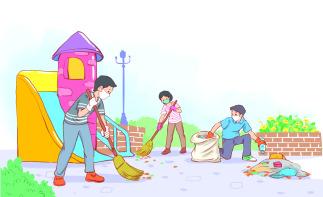

3. She needs to fill in the form, then send it in.
* T has Ss scan the conversation and write down the adjectives ending in these suffixes.
TASK 3: FIND ADJECTIVES WITH THE FOLLOWING SUFFIXES IN THE
DẠYKÈMQUYNHƠNOFFICIAL
8
** Ss work individually.
*** Ss share their answers with a partner.
**** T checks and gives the correct answers with the whole class, has them to say the meaning of the words.
CONVERSATION AND WRITE THEM BELOW. (p.43)
Key:
-ed: excited
-ing: interesting
-ful: useful, successful
-less: endless
* T has Ss read each sentence, try to complete it with an appropriate verb phrase without referring to the conversation.
** Ss do the task individually.
*** Ss share the answers with a peer.
**** T asks the whole class the call out the verb forms first, then call on individual students to read the complete sentences.
TASK 4: FIND A VERB OR VERB PHRASE IN THE CONVERSATION TO COMPLETE EACH SENTENCE. (p.43)
Key:
1. was working
2. saw
4. PRODUCTION/ FURTHER PRACTICE ( 8’)
Aim: To help students practising talking about activities which help protect the environment.
* Content: Talk about activities you are going to do to make your community a better one (for a minute).
* Outcome: students’s talks
* Organisation : Teacher’s
* Teacher:
Student’s activities
- gives Ss clear instructions in order to make sure Ss can do effectively.
- encourages Ss to talk about some activities including following information:
- observes Ss while they are talking, note their language errors.
** Ss do as instructed.
**** Teacher:
- gives Ss feedback.
- chooses some useful or excellent words/ phrases/ expressions/ word choices Ss have used to give suggestions to other students.
- chooses some typical errors and correct as a whole class without nominating the Ss’ names.
Content
SELF-REFLECTION
Talk about activities you are going to do to make your community a better one (for a minute).
+ How many activities are you going to talk about?
+ Where do you do those activities?
+ Who do you do with?
+ How often do you do those activities?
DẠYKÈMQUYNHƠNOFFICIAL
9
5. WRAP-UP & HOME WORK (2’)
WRAP-UP
- Some lexical items about volunteering in the community
- Reading for specific information
- Scanning
HOMEWORK
- Exercises in the workbook
- Prepare for the next lesson
PROJECT PREPARATION
* T asks Ss open their books at page 51, look at the pictures and say what the topic of the Project is (A Volunteer Project).
Teacher:
- Tells Ss about the Project requirements:
+ Ss will have to find information about a volunteer project in the community.
+ Ss give an oral presentation about that volunteer project in the last lesson of the unit. Their presentation should include information related to the guiding questions.
+ Ss can choose different ways to present their findings (PPT presentation, Poster presentation, recording a video about the project).
- Encourages Ss to use photos and / or pictures to illustrate their ideas.
- Explains to Ss how they can get the information, e.g: search the Internet, read newspapers, go to their local community centre and talk to people there.
- Puts Ss into groups and have them choose their group leader. Then ask them to assign tasks (e.g. who will collect information, who will prepare the slides / record the video, who will write the report, and who will present) for each group member, making sure that all group members contribute to the group work.
** Ss do as instructed.
**** T helps Ss set deadlines for each task and supports them throughout the process =========================
WEEK: 10
Period 30
UNIT 4: FOR A BETTER COMMUNITY
Lesson 2: Language
I. OBJECTIVES: * By the end of this unit, students will be able to gain the following things:
1. Knowledge:
1. Knowledge
- Use the lexical items related to the topic For a better community;
DẠYKÈMQUYNHƠNOFFICIAL
10
- Pronounce correctly stress in two-syllable words with the same spelling;
- Use the past simple vs. the past continuous
2. Competence:
- Be collaborative and supportive in pair work and teamwork
- Access and consolidate information from a variety of sources
- Actively join in class activities
3. Qualities:
- Develop a sense of helping the community and awareness of voluntary work
- Be responsible to the community
II. TEACHING AIDS:
- Teacher: Grade 10 text book, laptop, projector / TV/ pictures and cards....
- Students: Text books, studying equipment….
- Computer connected to the Internet.
- Sach mem.vn
III. PROCEDURE:
Notes: In each activity, each step will be represented as following:
* Deliver the task.
* Implement the task.
* Discuss.
* Give comments or feedback.
Aims:
- To create an active atmosphere in the class before the lesson;
- To lead into the new unit
To activate students’ prior knowledge and vocabulary related to the topic.
- To enhance students’ skills of cooperating with teammates.
- To lead into the new unit
* Content: To have some warm-up activities to create a friendly and relaxed atmosphere to inspire Ss to warm up to the subject and new lesson.
* Outcome: lead into the new unit
* Organisation: Teacher’s instructions …
Teacher’s Student’s activities Content
+ Greeting + Asking question:
* T divides Ss into 2 teams. Each team will take turns to name an activity they can do to help the community. The team with more correct answers will be the winner.
** Ss listen to the instructions.
*** Ss work in 2 teams and take turns to give the answers.
**** T checks and corrects if Ss spell or
NAME SOME ACTIVITIES YOU CAN DO TO HELP THE COMMUNITY.
Suggested answer:
+ Read books for children in orphanages
+ Visit and play games with them or listen to their problems
+ Work at home of sick and old people
+ Volunteer to work in remote or mountainous areas
DẠYKÈMQUYNHƠNOFFICIAL
11
1. WARM UP & INTRODUCTION ( 3’- 5’)
pronounce the words/ phrases incorrectly.
* T leads in the new lesson of Language.
2. PRESENTATION/ NEW LESSON ( 12’-
15’)
Aims: To help students recognize and understand the difference of stress in two-syllable words with the same spelling.
To help students practise saying sentences containing two-syllable words with the same spelling but different stress patterns.
To enrich students’ vocabulary.
* Content: Pronunciation and Vocabulary
* Outcome: students recognize and understand the difference of stress in two-syllable words with the same spelling and enrich students’ vocabulary
* Organisation:
Teacher’s Student’s activities
TASK 1: LISTEN TO THE SENTENCES AND CIRCLE THE WORD WITH THE STRESS YOU HEAR (p.43)
* Teacher:
- introduces the difference of stress in two-syllable words with the same spelling.
- asks Ss to give some two-syllable words with the same spelling but different stress they know.
- plays the recording and asks Ss to listen.
** Ss do as instructed.
*** Other Ss correct if the previous answers are incorrect.
**** T checks as a class.
TASK 2: LISTEN AGAIN AND PRACTISE SAYING THE SENTENCES IN 1. (p.43)
* Teacher:
- ask Ss to listen to each sentence again - tells them to pay attention to the stress on the words in italic.
** Ss listen and repeat.
Content
TASK 1: LISTEN TO THE SENTENCES AND CIRCLE THE WORD WITH THE STRESS YOU HEAR (p.43)
TASK 2: LISTEN AGAIN AND PRACTISE SAYING THE SENTENCES IN 1. (p.43)
DẠYKÈMQUYNHƠNOFFICIAL
12
: 1. a 2. b 3. a 4. b 5. a 6. b
Key
*** Ss work in pairs and have them practise the sentences.
**** T walks round the class, praising good pronunciation and correcting wrong stress placement.
Vocabulary
TASK 1. MATCH THE WORDS WITH THEIR MEANINGS. (p.44)
* Teacher asks students to match in pairs.
** Ss do the task in pairs.
*** Some pairs share their answers with the whole class.
**** T gives feedback and corrections (if necessary).
Vocabulary
TASK 1. MATCH THE WORDS WITH THEIR MEANINGS. (p.44)
Key:
1. c 2. e 3. a 4. b
5. d
3. PRACTICE (
Aim: To give students practice in using the words in meaningful contexts. To give students practice in using adjectives ending in -ed, -ing, -ful, and -less.
To have students revise the past simple and the past continuous.
- To help students understand the use of the past simple and the past continuous
To give students more practice in using the past simple and the past continuous with when and while
* Content: vocabulary and grammar
* Outcome: correct answers
* Organisation: Teacher’s Student’s activities
Vocabulary
TASK 2: COMPLETE THE FOLLOWING SENTENCES USING THE CORRECT FORMS OF THE WORDS IN 1. (p.44)
* T asks Ss to work independently and put a suitable word or phrase in each blank.
** Ss work independently and put a suitable word or phrase in each blank.
Content
Vocabulary
TASK 2: COMPLETE THE FOLLOWING SENTENCES USING THE CORRECT FORMS OF THE WORDS IN 1. (p.44)
Key:
1. generous 2. remote 3. donate 4. benefit 5. volunteers
DẠYKÈMQUYNHƠNOFFICIAL
13
15’)
*** Ss share their answers before discussing as a class.
**** T asks some Ss to share the answers and gives feedback.
TASK 3: CHOOSE THE CORRECT WORD TO COMPLETE EACH OF THE FOLLOWING SENTENCES. (p.44)
* T tells Ss to look at each sentence and choose the adjective that best fits the context.
** Ss work independently to do the task.
*** Ss compare the answers in pairs.
**** T confirms the correct answers. T asks Ss to give reasons why they have chosen a particular adjective for each sentence, e.g. In the first sentence, the phrase record the donations requires an adjective with a positive meaning. That is why careful is the right choice here.
Grammar
TASK 1: CHOOSE THE CORRECT VERB FORM IN EACH OF THE FOLLOWING SENTENCES. (p.44)
* T has Ss read the sentences individually once, asks them to pay attention to the conjunctions when and while.
** Ss work in pairs to compare their answers.
*** Some Ss share their answers with the whole class.
**** Teacher gives feedback and corrections (if necessary).
* T lets Ss recall the form of the present simple and the present continuous and elicits the rules of using these two verb forms from Ss.
TASK 3: CHOOSE THE CORRECT WORD TO COMPLETE EACH OF THE FOLLOWING SENTENCES. (p.44)
Key:
1. careful
2. interested
3. exciting
4. hopeless
Grammar
TASK 1: CHOOSE THE CORRECT VERB FORM IN EACH OF THE FOLLOWING SENTENCES. (p.44)
Key:
Did
DẠYKÈMQUYNHƠNOFFICIAL
14
3.
4.
The past simple Positive S + V-ed + … . Negative
+ didn’t + V-inf + … . Interrogative
1. was working 2. told
were helping
realised
S
+ S + V-inf + … ?
Answer
Yes, S + did. No, S + didn’t.
Wh-questions
Wh + did + S + V-inf + … ?
The past simple shows us that an action was in the past, not in the present. The past continuous Positive
S + was/were + V-ing…. Negative
S + wasn’t/weren’t+ V-ing + …
Interrogative
Was/were + S + V-ing + …?
Answer
Yes, S + was/were. No, S + wasn’t/weren’t.
Wh-questions
Wh + was/were + S + V-ing + …?
The past continuous shows us that the action was already in progress at a certain time in the past.
The past continuous can also show that an activity was in progress for some time, not just for a moment.
Past simple vs. past continuous with when and while We use:
● The past continuous for a past action in progress (longer action)
● The past simple for an action which interrupted it (shorter action)
DẠYKÈMQUYNHƠNOFFICIAL
15
TASK 2: COMBINE THE TWO SENTENCES USING WHEN OR WHILE WHERE APPROPRIATE. (p.44)
* T has Ss read the sentences individually once, asks them to pay attention to the conjunctions when and while.
** Ss work individually to compare their answers.
*** 2 students to write their answers on the board.
**** T gives feedback and corrections (if necessary).
Example:
I was reading an article when she called. While I was reading an article, she called
TASK 2: COMBINE THE TWO SENTENCES USING WHEN OR WHILE WHERE APPROPRIATE. (p.44)
Key:
1. While they were cleaning the streets, it started to rain. / They were cleaning the streets when it started to rain.
2. While I was watching TV, I saw the floods and landslides in the area. / I was watching TV when I saw the floods and landslides in the area.
3. While Tim was searching for employment opportunities, he found a job advert from a non-governmental organisation. / Tim was searching for employment opportunities when he found a job advert from a non-governmental organisation.
4. They decided to help build a community centre for young people while they were visiting some poor villages. / They were visiting some poor villages when they decided to help build a community centre for young people.
4. PRODUCTION/ FURTHER PRACTICE ( 8’)
Aim: To give students a chance to apply what they have learnt.
* Content: play games
* Outcome: apply what they have learnt.
* Organisation:
Teacher’s Student’s activities Content
* T divides Ss into groups of four, gives each group a piece of paper, and asks them to write sentences including 3 features:
.
** T asks each group to hand in their paper and checks. The group with more correct sentences is the winner.
GAME: WHO IS FASTER?
+ two-syllable words with the same spelling but different stress mentioned in Task 1, Pronunciation
+ when/ while
+ the past simple/ the past continuous e.g. When I was wrapping the present, my mom knocked the door
DẠYKÈMQUYNHƠNOFFICIAL
16
*** T invites the winner to read aloud their sentences.
**** T gives feedback.
* WRAP-UP
- Use the lexical items related to the topic For a better community;
- Pronounce correctly stress in two-syllable words with the same spelling;
- Understand the past simple vs. the past continuous HOMEWORK
- Prepare for the next lesson: Unit 4, Reading
- Exercises in the workbook
Date of planning: …/… / 2022
Date of teaching: …/… / 2022
WEEK: 11
Period 31
UNIT 4: FOR A BETTER COMMUNITY
Lesson 3: Reading
I. OBJECTIVES:* By the end of this unit, students will be able to gain the following things:
1. Knowledge:
- Develop reading skills for specific information about teenagers and voluntary work.
2. Competence:
- Develop communication skills and creativity
- Be collaborative and supportive in pair work and team work
- Develop presentation skills
- Actively join in class activities
3. Qualities:
- Develop a sense of helping the community and awareness of voluntary work
- Develop self-study skills
II. TEACHING AIDS:
- Teacher: Grade 10 text book, laptop, projector / TV/ pictures and cards.....
- Students : Text books, studying equipment….
- Computer connected to the Internet.
- Sach mem.vn
III. PROCEDURE:
Notes: In each activity, each step will be represented as following:
* Deliver the task.
* Implement the task.
DẠYKÈMQUYNHƠNOFFICIAL
17
5. WRAP-UP & HOME WORK (2’)
=========================
* Discuss.
* Give comments or feedback.
1. WARM UP & INTRODUCTION ( 3’- 5’)
Aims:
- To create an active atmosphere in the class before the lesson;
- To lead into the new unit
To introduce the topic of reading.
- To enhance students’ skills of cooperating with teammates.
* Content: To have some warm-up activities to create a friendly and relaxed atmosphere to inspire Ss to warm up to the subject and new lesson.
* Outcome: lead to the subject and new lesson
* Organisation : Teacher’s instructions …
Teacher’s Student’s activities Content
+ Greeting + Asking question:
* T divides class into 2 teams. T prepares 6 numbers which include 5 questions about the present simple, the present continuous and volunteering activites, and 1 lucky number.
** Each team takes turns to choose a number and answer the question behind the number. If the team answers the question correctly, they will get 1 point. If the team chooses the lucky number, they get 1 point without answering the question.
*** Ss do as instructed.
**** T gives further explanation (if needed).
GAME: LUCKY NUMBER
Suggested questions:
1. When do we use the past simple?
2. When do we use the past continuous?
3. Name 3 words/phrases used as signals of the past simple.
4. Give the correct form of the verbs in brackets:
While I (listen) _______to music, my sister (knock) _______the door.
5. Name 2 volunteering activities.
2. PRESENTATION/ NEW LESSON ( 12’- 15’)
Aims: - To lead in the reading skills.
- To provide students with some lexical items before reading the text.
* Content: Complete the mind map with popular volunteering activities for teenagers
* Outcome: students know some lexical items before reading the text.
* Organisation:
Teacher’s Student’s activities Content
DẠYKÈMQUYNHƠNOFFICIAL
18
TASK 1: COMPLETE THE MIND MAP WITH POPULAR VOLUNTEERING ACTIVITIES FOR TEENAGERS. (p.46)
* Teacher:
- asks Ss to work in pairs
- gives each pair a sheet of paper
- ask them to draw the mind map and complete it with volunteering activities suitable for teenagers.
- encourages Ss to use the pictures as suggested ideas.
- tells Ss that there are no right or wrong answers and they can make the guesses freely.
** Ss listen to the instructions and do the task individually.
*** Some Ss show their mind map on the paper and share the answers with the whole class.
**** T gives feedback.
* T provides Ss with the meaning and pronunciation of some new words.
** Ss listen and repeat the words.
*** Ss practice the words in pairs and two students read the words out loud in front of the class.
**** T corrects (if necessary)
1. donation (n) /dəʊˈneɪʃn/: sự quyên góp, ủng hộ
2. deliver (v) /dɪˈlɪvə(r)/: phân phát
3. hardship (n) /ˈhɑːdʃɪp/: sự gian khổ
TASK 1: COMPLETE THE MIND MAP WITH POPULAR VOLUNTEERING ACTIVITIES FOR TEENAGERS. (p.46)
Suggested answers:
Helping at a charity event where people can donate items or money
Helping old people (e.g. cook meals, shop for food)
Helping old people with technology (e.g. how to send emails, use the Internet, or install apps)
Helping out at an animal shelter
VOCABULARY LANGUAGE
1. keep a record of /kiːp ə ˈrɛkɔːd
ɒv/ (v.phr): lưu giữ hồ sơ
2. watch something live /wɒʧ ˈ sʌmθɪŋ
lɪv/ (v.phr): xem trực tiếp
3. increase /ˈɪŋkriːs/ (n): sự tăng trưởng
4. visitor /ˈ vɪzɪtə(r)/ (n): du khách
5. export /ˈekspɔːt/ (v): xuất khẩu
6. donate /dəʊˈneɪt/ (v): quyên góp = raise money for charity /reɪz ˈ mʌni fɔː ˈʧærɪti/
7. generous /ˈdʒenərəs/ (adj): hào phóng
8. charity /ˈtʃærəti/ (n): từ thiện
9. be located in /biː ləʊˈkeɪtɪd ɪn/ (v.phr):
nằm ở
10. opportunity /ˌɒpəˈtjuːnəti/ (n): cơ hội
11. civics class /ˈ sɪvɪks klɑːs/ (n.phr): lớp
học môn công dân
12. remote areas /rɪˈməʊt ˈ eərɪəz/ (n.phr):
vùng sâu vùng xa
13. landslides /ˈlændslaɪdz/ (n): lở đất
14. be searching for /biː ˈ sɜːʧɪŋ
fɔː/ (v.phr): đang tìm kiếm = be looking for
15. job advert /ʤɒb ədˈvɜːt/ (n.phr): quảng
cáo việc làm
3. PRACTICE ( 15’)
Aim:
To help students practise reading for main ideas.
To help students practise guessing the meaning of words from context. To help students practise reading for specific information
DẠYKÈMQUYNHƠNOFFICIAL
19
* Content: Read the text and choose the main idea, match the highlighted words in the text with their meanings, decide whether the following statements are true (t) or false (f).
* Outcome: keys* Organisation:
Teacher’s Student’s activities Content
* T elicits from Ss strategies they can use to read texts for main ideas, e.g. paying attention to the topic sentence in each paragraph, highlighting key information, or searching for conclusions.
** T asks Ss to read the whole text once and choose the main idea. In weaker classes, T has Ss read through the three options first and checks understanding.
*** Ss work in pairs to compare their answers.
**** T checks answers as a class. In stronger classes, T asks Ss to explain why the other options do not summarise the main idea.
TASK 3: MATCH THE HIGHLIGHTED WORDS IN THE TEXT WITH THEIR MEANINGS. (p.46)
* T has Ss read the text again paying attention to the context of each highlighted word, and looking for clues that they can use to guess the meaning, e.g. The first word ‘various’ in this context must be an adjective to modify ‘volunteering activity’. Among the given options, ‘several different’ is the best match for this word.
** Ss work in groups to discuss the clues and compare answers.
*** Some Ss share the answers. **** T checks answers as a class.
TASK 4: DECIDE WHETHER THE FOLLOWING STATEMENTS ARE TRUE (T) OR FALSE (F). (p.46)
* T asks Ss to read the questions and underline the key words in each of them. e.g.
1. Volunteer Club, set up, long after, school, opened;
TASK 2: READ THE TEXT AND CHOOSE THE MAIN IDEA. (p.46)
e.g. A: This is not mentioned in the text.
B: Helping teens gain work experience is not the aim of the club.
Key: C
TASK 3: MATCH THE HIGHLIGHTED WORDS IN THE TEXT WITH THEIR MEANINGS. (p.46)
TASK 4: DECIDE WHETHER THE FOLLOWING STATEMENTS ARE TRUE (T) OR FALSE (F). (p.46)
Key:
1. F (shortly after)
2. T
3. F (to raise money for the local orphanage and homeless old people)
DẠYKÈMQUYNHƠNOFFICIAL
20
: 1. c 2. d 3. a 4. e 5. b
Key
2. All students, join, different, activities;
3. Money, selling handmade items, build, local centre, orphans, homeless old people;
4. Club members, help, cook, free meals, poor families;
5. Students, volunteer, orphanage, community centre.
- T reminds Ss that the statements may include paraphrased or opposite information so they should look for synonyms or antonyms in the text.
** T tells Ss to read through the text looking for the key words they underlined in the statements or words with the same or similar meaning, e.g. was set up (was formed), first opened (was set up), or words with the opposite meaning, e.g. long after (shortly after).
*** Ss work in pairs to compare answers.
**** T checks answers. In stronger classes, T asks them to give reasons for their answers.
4. T
5. F (deliver free meals)
4. PRODUCTION/ FURTHER PRACTICE ( 8’)
Aim: - To help students improve next time.
- Check students’ understanding about the reading passage.
-To help some students enhance presentation skills
* Content: DISCUSS THE QUESTION
* Outcome: students’s talks
* Organisation:
Teacher’s Student’s activities
* T lets Ss work in pairs and discuss the question:
If you were a member of the Volunteer Club, what could you do to help?
** T calls some Ss to present their answers in front of the whole class.
*** Ss give comments for their friends and vote for the most interesting and informative presentation.
**** T gives feedback and comments.
Content
TASK 5: DISCUSS THE QUESTION (p.46)
If I were a member of the Volunteer Club, I would organise afterschool games for the children at the orphanage. Because I want to help them not only study better but also have a lot of fun after hark-working days.
DẠYKÈMQUYNHƠNOFFICIAL
21
WRAP-UP
- Some lexical items about volunteering in the community
- Reading for general and specific information about teenagers and voluntary work.
HOMEWORK
- Prepare for the next lesson: Unit 4: Speaking
- Exercises in the workbook
Date of planning: …/… / 2022
Date of teaching: …/… / 2022
WEEK: 11
=========================
Period 32
UNIT 4: FOR A BETTER COMMUNITY
Lesson 4: Speaking
I. OBJECTIVES:* By the end of this unit, students will be able to gain the following things:
1. Knowledge:
- Talk about the benefits of volunteering activities
2. Competence:
- Develop communication skills and creativity
- Be collaborative and supportive in pair work and team work
- Develop presentation skills
- Actively join in class activities
3. Qualities:
- Develop a sense of helping the community and awareness of voluntary work
- Develop self-study skills
II. TEACHING AIDS:
- Teacher: Grade 10 text book, laptop, projector / TV/ pictures and cards....
- Students: Text books, studying equipment….
- Computer connected to the Internet.
- Sach mem.vn
III. PROCEDURE:
Notes: In each activity, each step will be represented as following:
* Deliver the task.
* Implement the task.
* Discuss.
* Give comments or feedback.
Aims:
1. WARM UP & INTRODUCTION ( 3’- 5’)
- To create an active atmosphere in the class before the lesson;
DẠYKÈMQUYNHƠNOFFICIAL
22
5. WRAP-UP & HOME WORK (2’)
- To lead into the new unit
- To introduce the topic of reading.
- To enhance students’ skills of cooperating with teammates.
* Content: To have some warm-up activities to create a friendly and relaxed atmosphere to inspire Ss to warm up to the subject and new lesson
* Outcome: lead to the subject and new lesson
* Organisation : Teacher’s instructions …
Teacher’s Student’s activities Content
+ Greeting + Asking question:
* T divides class into 2 teams. T prepares about 5 jumbled words related to the topic.
** The teams raise hands to answer. The team that has the higher number of correct answers and is the faster will be the winner.
*** Ss do as instructed.
**** T gives further explanation (if needed).
GAME: JUMBLED WORDS
Suggested questions:
1. anitondo (donation)
2. revloetun (volunteer)
3. dnuf (fund)
4. temero (remote)
5. tbosot (boost)
2. PRESENTATION/ NEW LESSON ( 12’- 15’)
Aims: To introduce more ideas for the main speaking task and get students involved in the lesson.
* Content: look at the following benefits of volunteering activities. choose the three most important benefits
* Outcome: speaking task and get students involved in the lesson.
* Organisation:
Teacher’s Student’s activities Content
TASK 1: LOOK AT THE FOLLOWING BENEFITS OF VOLUNTEERING ACTIVITIES. CHOOSE THE THREE MOST IMPORTANT BENEFITS. (p.46)
* T asks Ss to read the list of benefits individually. T checks comprehension and explains any phrases Ss may find hard.
** Ss choose the three most important benefits.
*** Some Ss share the answers with the whole class.
TASK 1: LOOK AT THE FOLLOWING BENEFITS OF VOLUNTEERING ACTIVITIES. CHOOSE THE THREE MOST IMPORTANT BENEFITS. (p.46)
e.g. coming into contact, essential life skills, management skills, appreciate, be positive, a sense of purpose in life.
DẠYKÈMQUYNHƠNOFFICIAL
23
**** T gives feedback and checks if Ss have come up with any new benefits and write best ideas on the board.
TASK 2: COMPLETE THE DIAGRAM WITH EXAMPLES AND DETAILS THAT EXPLAIN THE BENEFITS OF VOLUNTEERING ACTIVITIES. (p.46)


* T asks Ss to study examples in the diagram and see how each benefit of volunteering activities is explained with examples and details.
** Ss work in pairs to complete their diagrams.
*** Some Ss share the answer with the whole class.**** T walks round the class and offer help. T makes sure Ss have completed at least the first two benefits before moving on to the next activity.
TASK 2: COMPLETE THE DIAGRAM WITH EXAMPLES AND DETAILS THAT EXPLAIN THE BENEFITS OF VOLUNTEERING ACTIVITIES.
(p.46)Answers:
3. PRACTICE ( 15’)
Aim: To help students enhance presentation skills
* Content: Presentation about the benefits of volunteering activities
* Outcome: students’ talks
* Organisation:
Teacher’s Student’s activities Content
TASK 3: GIVE A PRESENTATION ABOUT THE BENEFITS OF VOLUNTEERING ACTIVITIES. (p.46)
* Teacher:
- Explains the task and focuses Ss’ attention on the expressions.
TASK 3: GIVE A PRESENTATION ABOUT THE BENEFITS OF VOLUNTEERING ACTIVITIES. (p.46)
e.g. We use the expressions on top to order points and the expressions on the bottom to give examples.
DẠYKÈMQUYNHƠNOFFICIAL
24
- Elicits how we use them in presentations and reports, ** Ss work in groups and decide how they will present the information in their diagrams, who is going to introduce and end the presentation, and how to divide the different points among group members.
*** Ss practise their presentations in a time limit of 8 - 10 minutes while teacher walks round the class to monitor Ss’ preparation and makes sure that shy Ss also have the opportunity to contribute.
*** T invites some groups of Ss to give their presentations in front of the whole class. When Ss finish their presentations, T lets them reflect on their performance.
e.g. Say what they think they did well and how they can improve on the content or delivery.
**** Teacher:
- asks other Ss to give further comments.
- praises for good effort, highlights the presenters’ strong points and makes suggestions for better organisation and presentation of their ideas.
Functions Useful expressions
First of all, …
Order points and expressions
Second, …
Third, …
Finally, …
For example, …
Giving examples
For instance, …
…such as…
4. PRODUCTION/ FURTHER PRACTICE ( 8’)
Aim: To help students enhance presentation skills
* Content: Presentation about the benefits of volunteering activities
* Outcome: students’ talks
* Organisation:
Teacher’s Student’s activities Content
*** T invites some groups of Ss to give their presentations in front of the whole class. When Ss finish their presentations, T lets them reflect on their performance.
e.g. Say what they think they did well and how they can improve on the content or delivery.
**** Teacher:
- asks other Ss to give further comments.
- praises for good effort, highlights the
Hello everyone. Now I'm going to present the benefits of volunteering activities. First of all, doing volunteering gives us a chance of coming into contact with other teenagers with similar interests. In a club, we can share common interests and values, which strengthens our friendship. Besides, making more friends makes us more confident. Second, volunteering activities help us improve essential life skills such as time
DẠYKÈMQUYNHƠNOFFICIAL
25
presenters’ strong points and makes suggestions for better organization and presentation of their ideas.
management skills, communication skills, teamwork skills. For example, we learn how to make a plan and manage time effectively; communicate with others and work in a group. Finally, a volunteer can gain a lot of life experiences. After volunteering activities, we learn how to deal with problems and situations by observing each other. Thus, we realize our strengths and weaknesses, which helps us decide our career path and orientation.
5. WRAP-UP & HOME WORK (2’)
WRAP-UP
- Some lexical items about volunteering in the community
- Reading for general and specific information about teenagers and voluntary work.
HOMEWORK
- Prepare for the next lesson, Listening
- Exercises in the workbook
Date of planning: …/… / 2022
Date of teaching: …/… / 2022
WEEK: 11
Period 33
UNIT 4: FOR A BETTER COMMUNITY
Lesson 5: Listening
I. OBJECTIVES:*By the end of this unit, students will be able to gain the following things:
1. Knowledge:
- Use the lexical items related to the topic For a better community
- Listen for specific information about volunteering activities
2. Competence:
- Develop communication skills and creativity
- Be collaborative and supportive in pair work and team work
- Actively join in class activities
3. Qualities:
- Develop a sense of helping the community and awareness of voluntary work
- Develop self-study skills
II. TEACHING AIDS:
- Teacher: Grade 10 text book, laptop, projector / TV/ pictures and cards.....
DẠYKÈMQUYNHƠNOFFICIAL
26
=========================





